












So many great recipes in all the years of A Taste of the Kawarthas lifestyle magazine!
We decided to amalgamate them into one book so you will have them at your finger tips!

But then, we decided to show you all the amazing Chefs and wineries we have featured.But wait! Then we figured, let’s take this a step further and add all the wineries and wine columns we have featured!
I hope you enjoy creating these incredible recipes!
Thank you for sending us your well wishes on the Seventeen Awards ATOTK received in 2025! We are proud and humbled by the love! It’s a nice pat on the back and keeps us trying harder all the time!
If you have a recipe with photos you would like us to add, send us an email.
Karen Irvine - Editor, Videographer, Photographer & Social Media Diva
Email - atasteofthekawarthas@gmail.com
Facebook - A Taste of the Kawarthas Magazine


Website - www.atasteofthekawarthas.com
Instagram - @atasteofthekawarthas
Publisher - Slither Productions Editor - Karen Irvine


Creative Director - Jay Cooper Advertising Sales - (705) 772-8074 Email - atasteofthekawarthas@gmail.com
© 2025 by A Taste of the Kawarthas Magazine (ATOTK) is a free publication distributed locally an is supported by our advertisers. A Taste of the Kawarthas Magazine or Slither Productions do not necessarily endorse the views expressed in the articles and advertisements, nor are we responsible for the products and services advertised. All rights reserved. Although some parts of this publication may be reproduced and reprinted, we require that prior permission be obtained in writing.






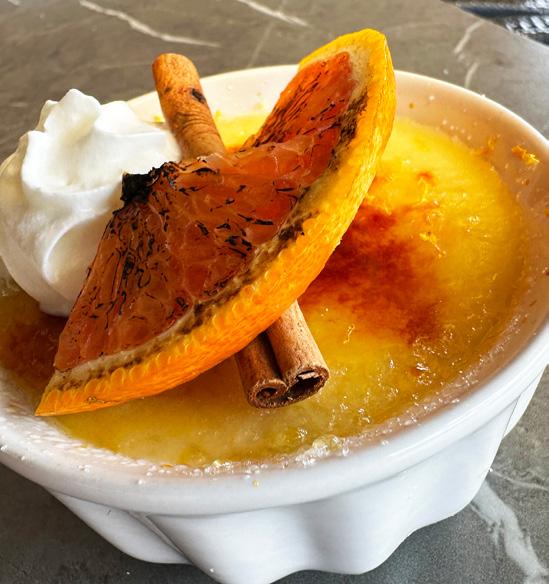
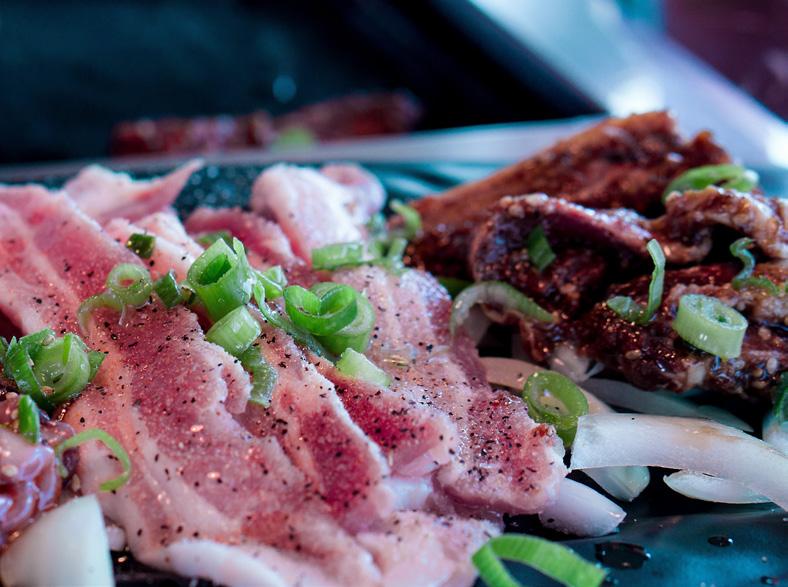
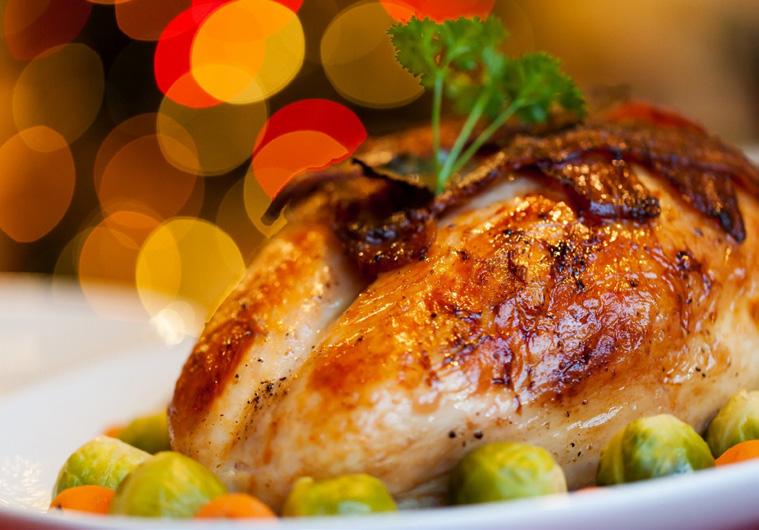
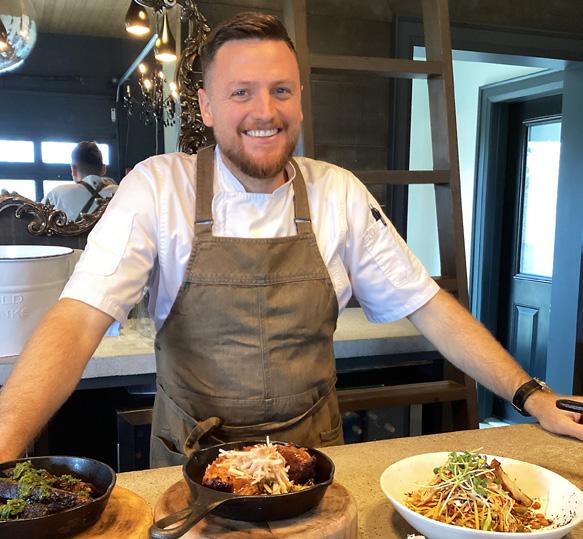
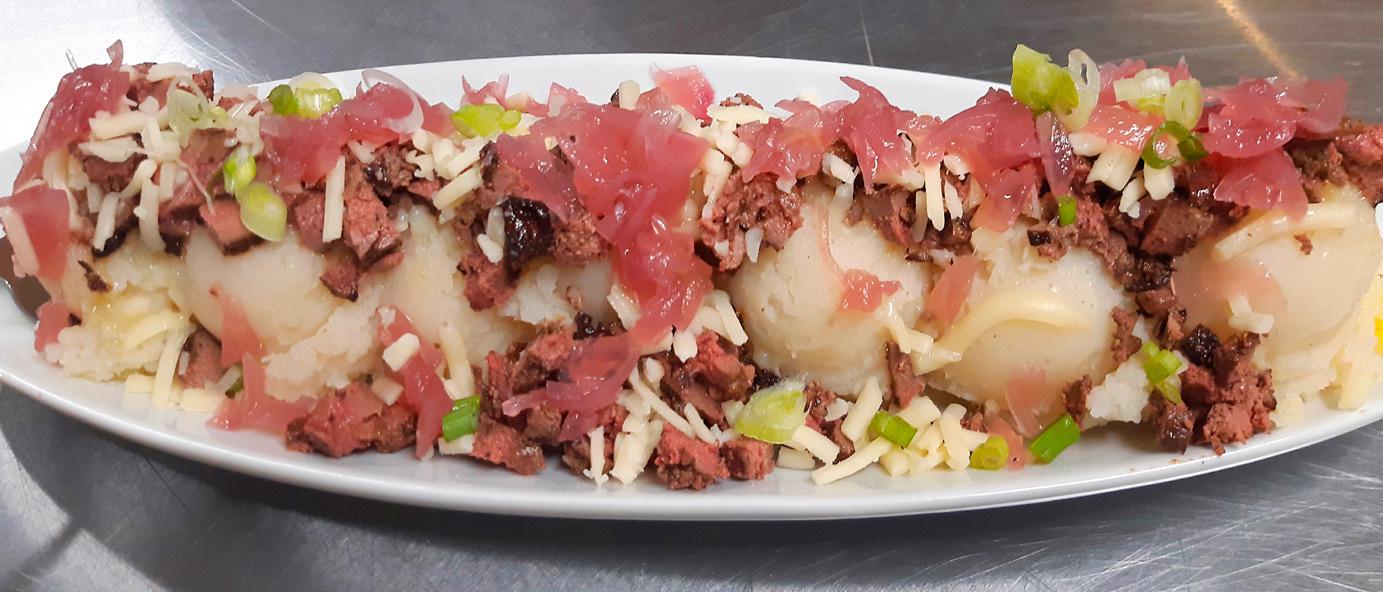
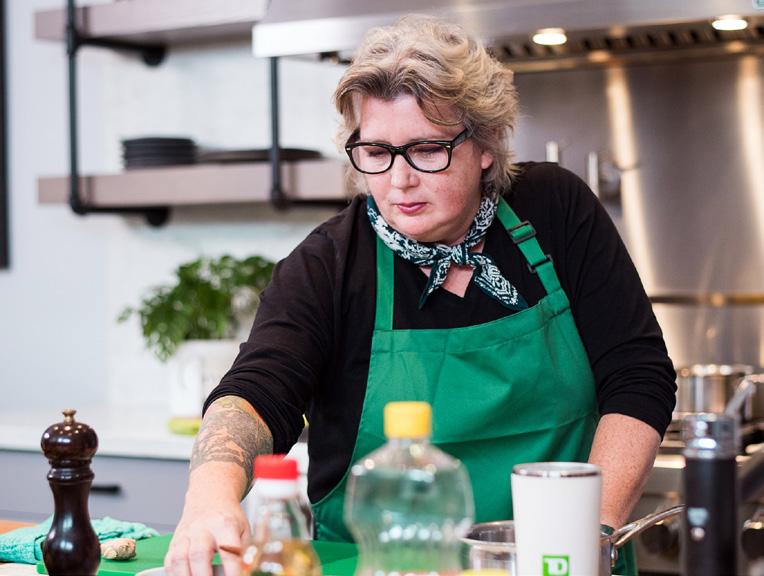
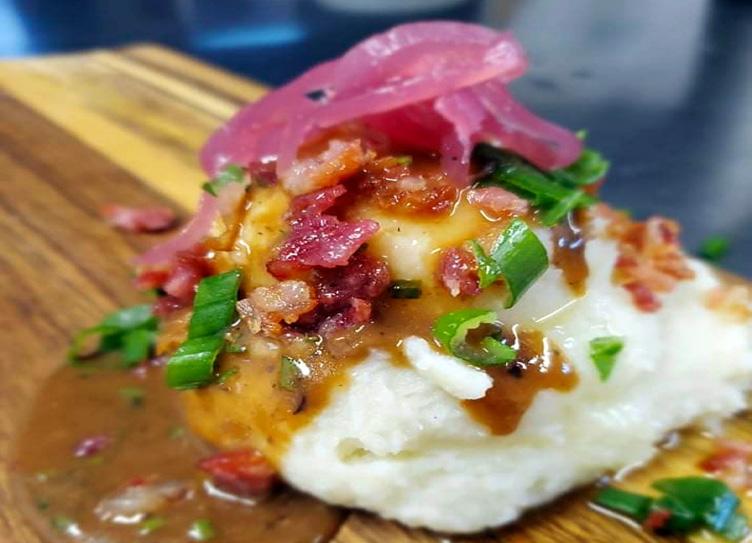

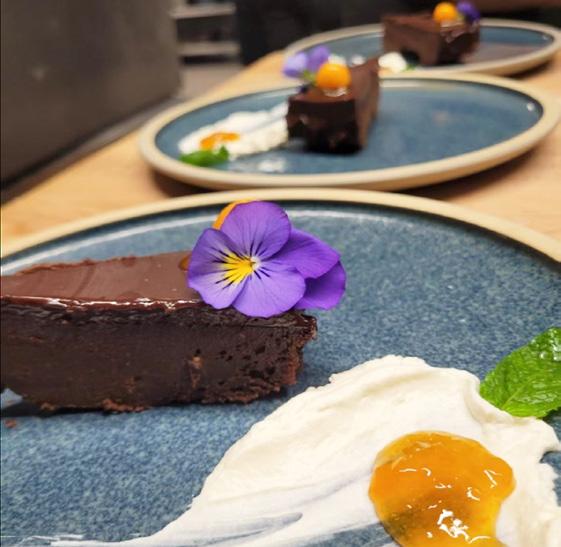
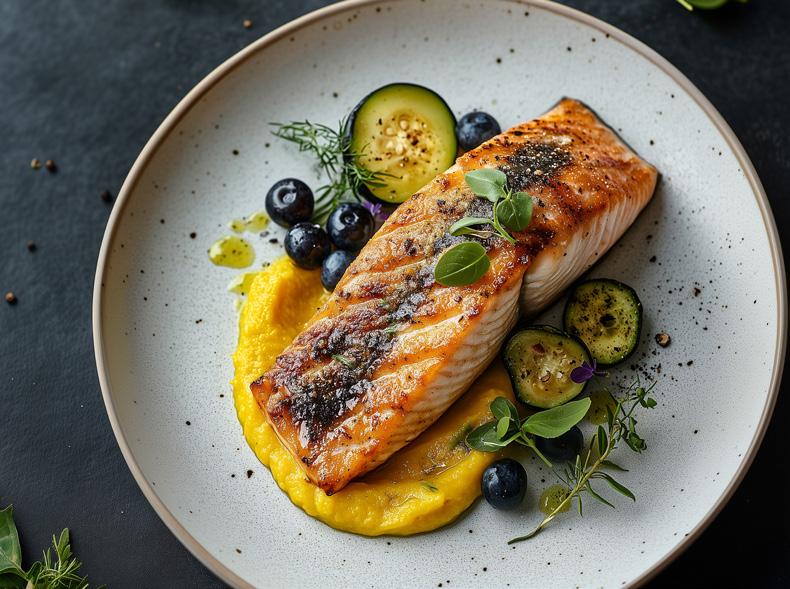

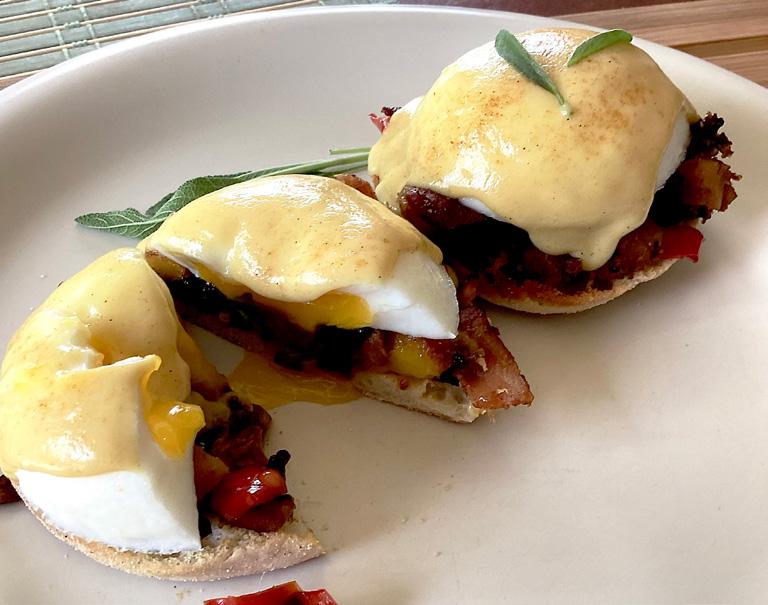
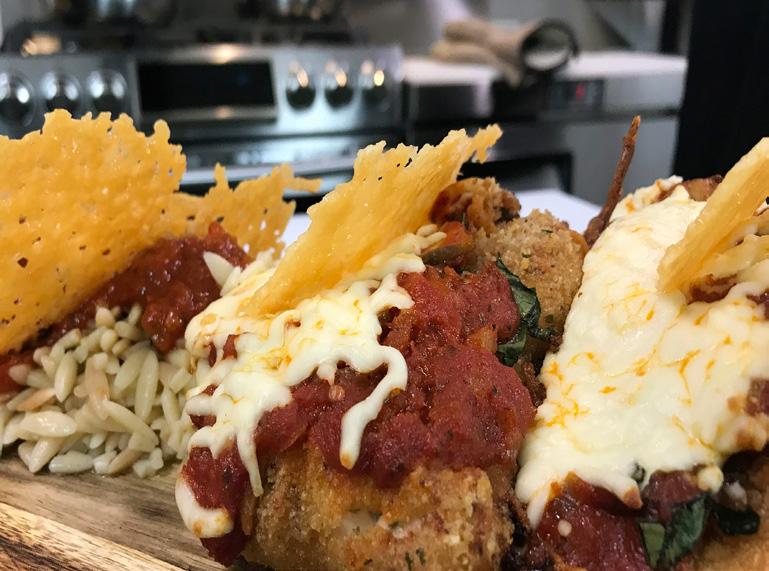

Gnocchi with Bacon, Cremimi Mushrooms and Leeks in White Wine
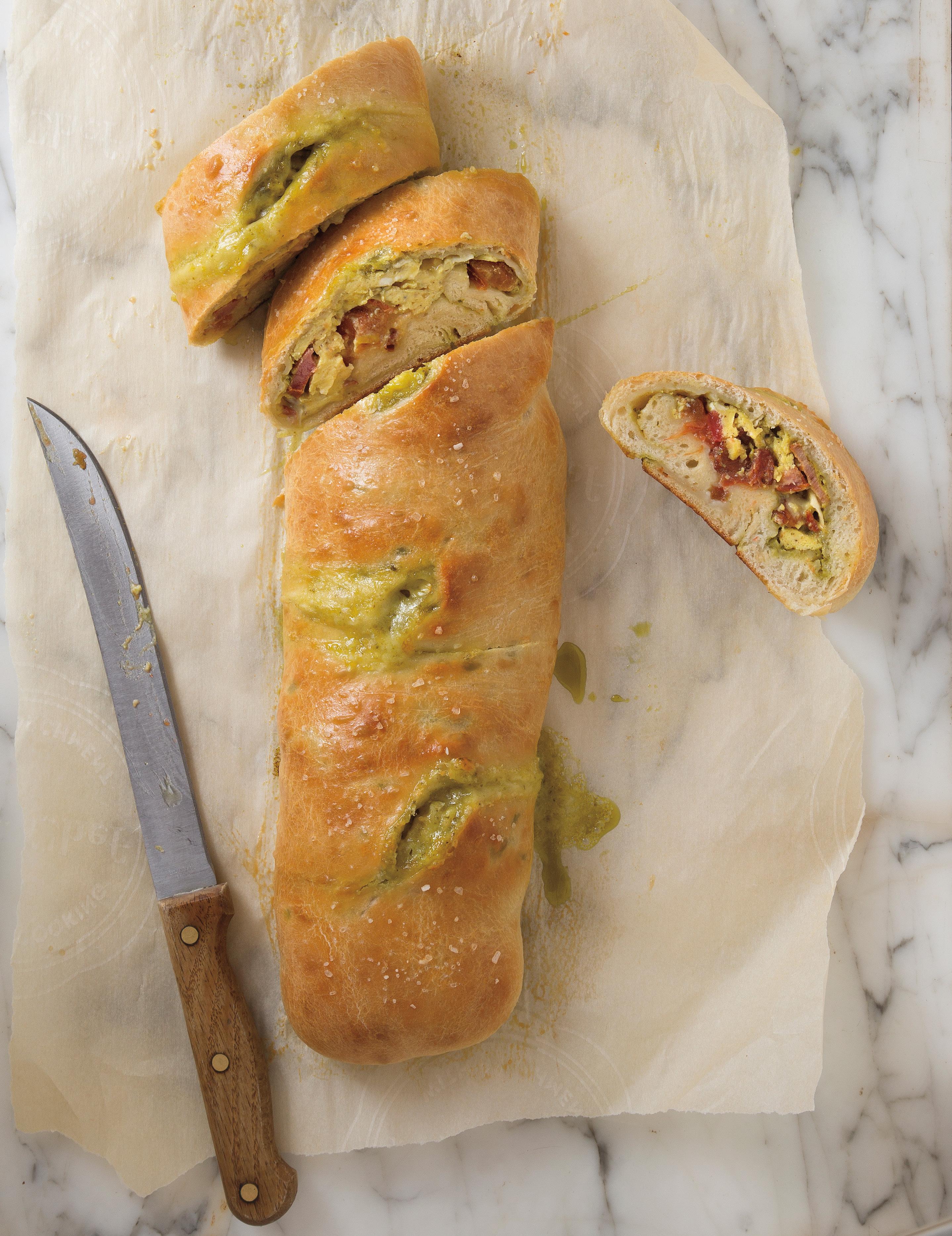
Spaghettini with Grilled Jerk Chicken & Black-Eyed Peas in Coconut Cream Sauce
Grilled Korean-Style Galbi Marinade
Leak & Spinach Stuffed Turkey Loaf and Orange Cranberry Sauce
Short Ribs
Ass Cajun Bacon Casserole
Goddess Flatbread with Roasted Asparagus & Red Onion
Mashed Cauliflower and Mediterranean Swiss Chard
and Black Bean Salad with Smoked Chipotle Vinaigrette
Bacon Risotto with Roasted Winter Vegetables
Sun-Dried Tomato & Dill Pesto Fettuccini with Asparagus & Grape Tomatoes
Fennel, Red Onion & Garlic Galette
Clauiflower & Parsnip Soup with Onion Bhajia

Smashing Pumpkins Pepita Brittle It’s Synonomous with the Kawarthas
Aphrodite Ganach Tart
& Dark Eggy Iced Dream
Creme Brulee
Rasi Cookies
is Nuckin’ Futz
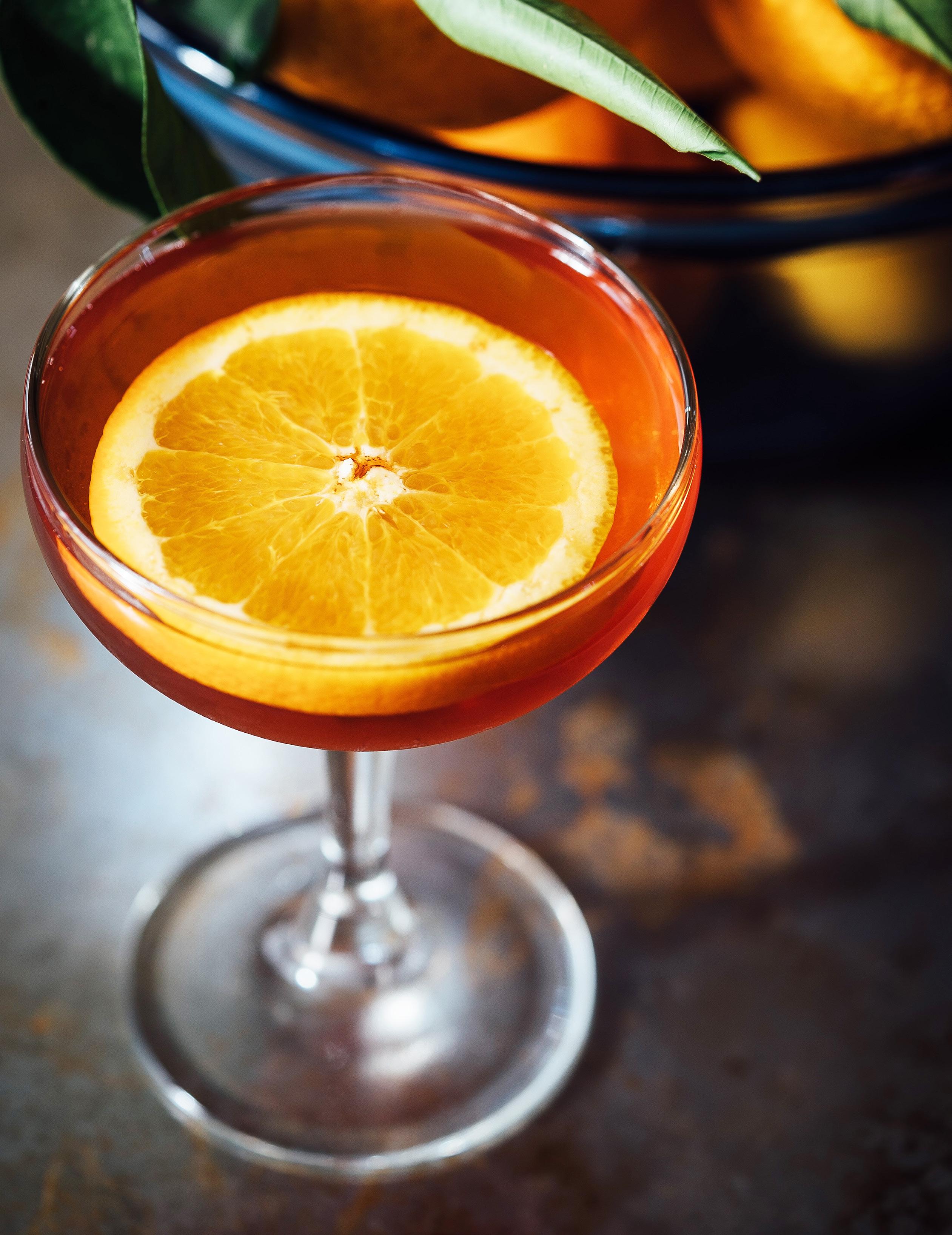
210

212
Josh Keepfer
Glenn Ford 214
Tracey Ormond
216
Matt Chi
WINERIES
220
Kawartha Country Wines
222
Rolling Grape Winery
224
Potter Settlement Winery
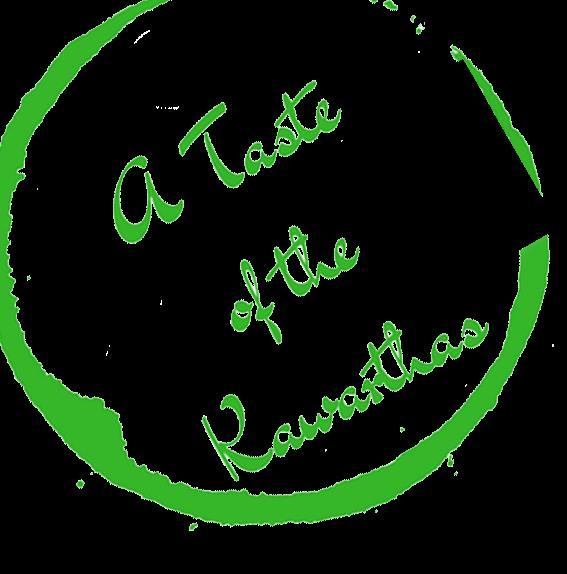
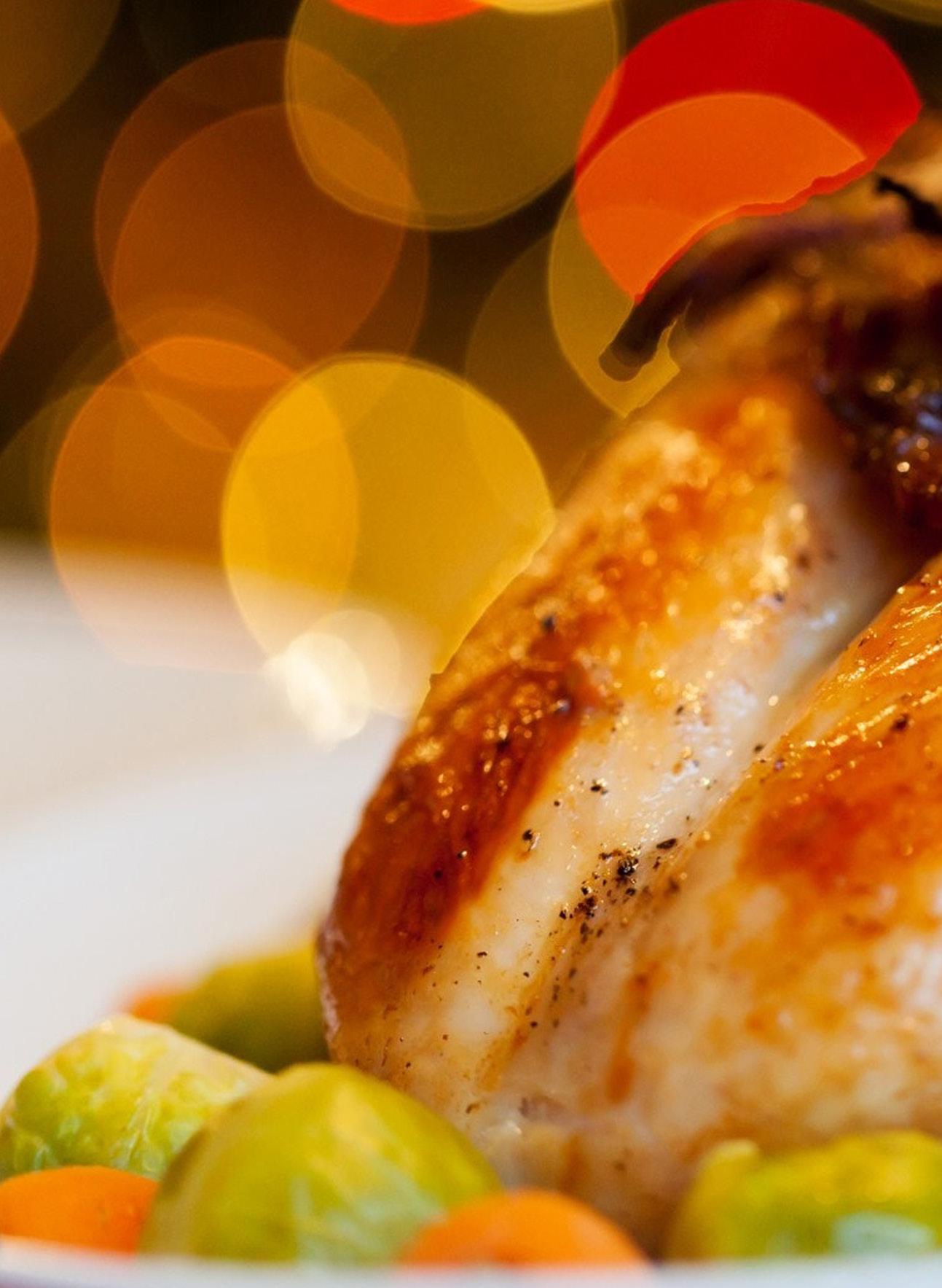

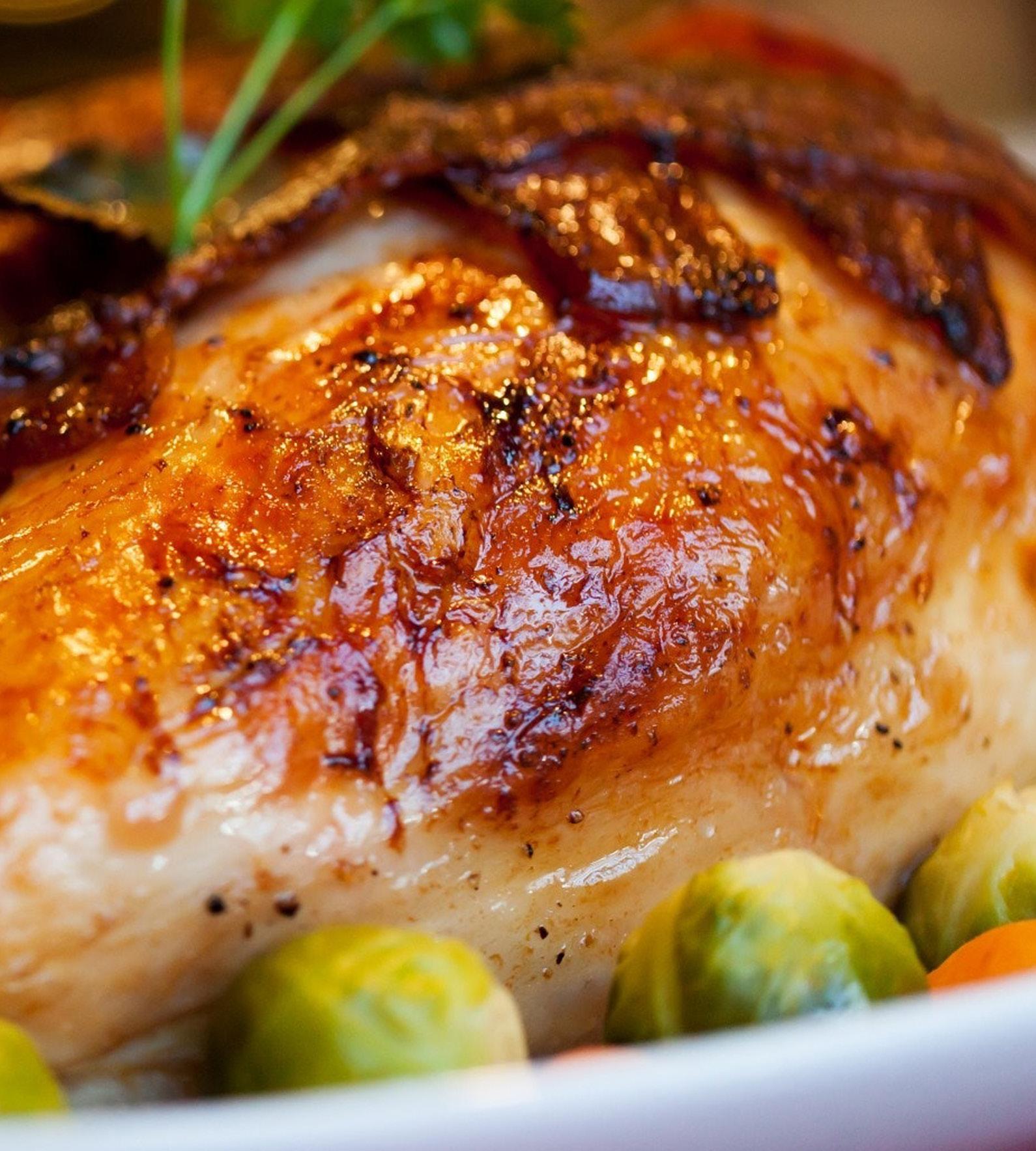

By Chef Brian Henry Food Editor
O ver my career I have had the privilege of cooking for countless celebrities. Many people gush at this notion and wonder what it was like to cook for them and what they ate. For the most part, I can readily state that they take comfort in wholesome home-style meals which is why I wasn’t surprised when Serena Ryder said that her favourite Christmas Dinner foods were Creamy Mashed Cauliflower, Whole Roasted Chicken and Swiss Chard which can be easily made using the following recipe
Ingredients:
1 head cauliflower cut into bite-size florets
4 cloves garlic, peeled 1/3 cup buttermilk
Method:
4 tsp. cooking oil, divided 1 tsp. butter
Salt and fresh cracked pepper
Chives
1. Place cauliflower and garlic in a steamer basket over boiling water, cover and steam until tender.
2. Place the cooked cauliflower and garlic in a food processor.
3. Add buttermilk, 2 tsp. cooking oil, butter, salt and pepper; pulse mixture a bit and then process until smooth.
4. Transfer to a serving bowl. Drizzle with the remaining cooking oil and garnish with fresh cut chives.
Mediterranean Swiss Chard
Ingredients:
2 tbsp. cooking oil
3 cloves garlic, coarsely chopped
¼ cup pine nuts
1 bunch Swiss chard, separate the stems from the leaves and cut both into 1-inch pieces
Method:
¼ cup raisins
¼ cup of water or unsalted vegetable stock
Salt and pepper
½ lemon cut into wedges
1. In a large sauté pan heat the cooking oil over medium high heat.
2. Lightly brown the garlic and pine nuts in the oil being careful not to scorch either. Quickly remove the garlic and pine nuts from the pan and set aside.
3. Add the chard stems and raisins to the pan with the stock and gently simmer until evaporated.
4. Add the chard leaves to the pan and quickly toss them so they begin to wilt.
5. Return the garlic and pine nuts to the pan and season with salt and pepper.
6. Serve immediately with lemon wedges to be squeezed over the chard.
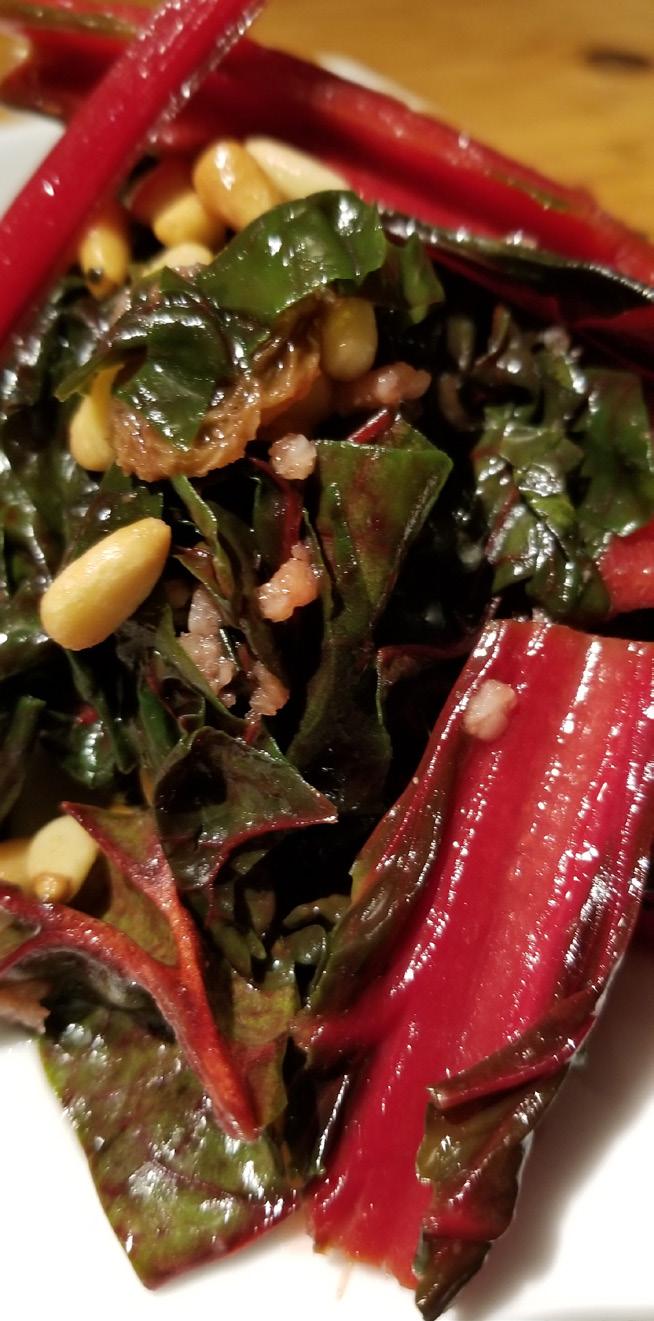
Roasted Chicken
Ingredients:
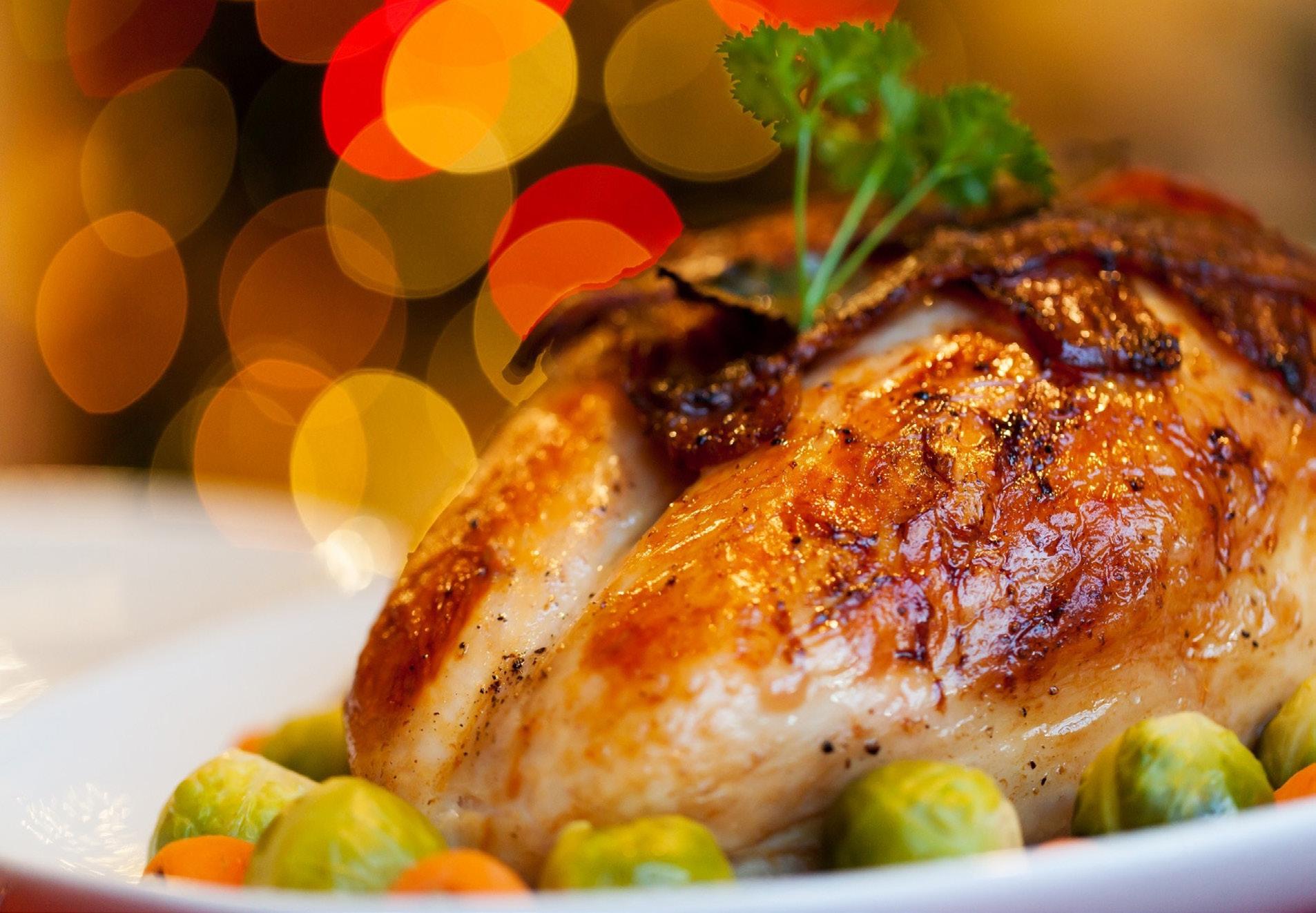
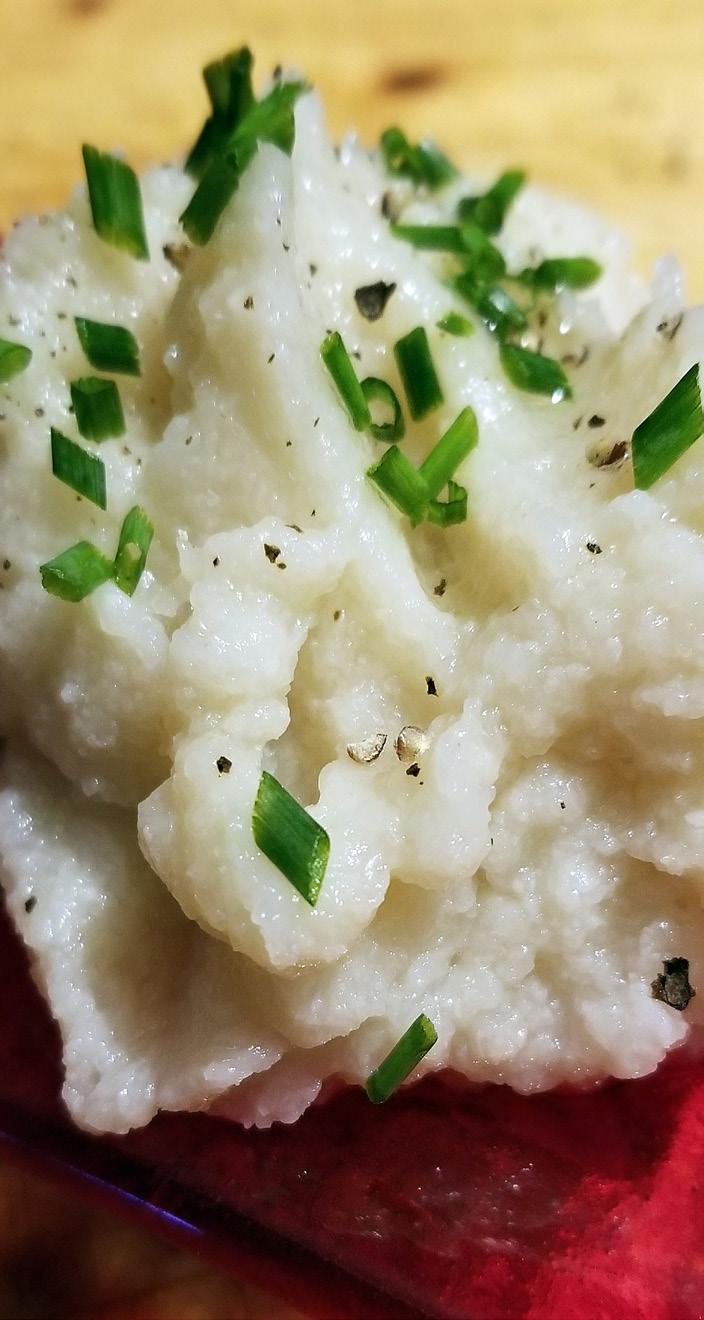
1 whole chicken, giblets removed
Salt and fresh cracked pepper
1 tbsp. onion powder
1/2 cup butter, divided
1 stalk celery
1 small cooking onion, peeled and cut in half
Method:
Place chicken in a roasting pan, and season generously inside and out with salt, pepper and onion powder.
Place half the butter in the chicken cavity.
Break the remaining butter into pieces and place under the skin of the chicken over the breast meat.
Cut the celery into 3 or 4 pieces, and place in the chicken cavity along with the onion.
Bake uncovered in a preheated oven at 350 °F for about 60-75 minutes and a minimum internal temperature of 180 °F has been reached.
Remove from heat, and baste with melted margarine and drippings.
Cover with aluminum foil, and allow it to rest for 20 minutes before serving.

Every culture has its traditional ways of barbecuing and grilling meat.

By Chef Brian Henry Food Editor
The Korean words (pronounced Galbi-gui) translates to grilled ribs. As tongues are lazy the world over it usually is shortened to Galbi. For the xenoglossophobists it is simply Korean barbecue a misnomer as Galbi is grilled; by cooking meat quickly over direct, high heat, while barbecuing is a low and slow cooking method using indirect heat and smoke.
Galbi largely defines an assortment of grilled meats in Korean cuisine made with marinated beef or pork short ribs that have been thinly sliced across the bones to allow the marinade to penetrate the meat quickly and further allows for rapid cooking. The secret to great tasting Galbi is to understand the balance of its sweet and savory flavors. Most North American Galbi is sweeter than what you would be served in Korea as it is more appealing to our palates.
The grilling technique for Galbi is the exact opposite of how you would grill a steak or burger as it requires you to be very hands on, constantly turning and moving the meat about the grill allowing the marinade to create a nice even glaze on the meat’s surface without burning the sugars.
Turn your kitchen into a Korean Grill house by making Galbi at home using thinly sliced beef sirloin, tenderloin, pork belly or chicken but I find that the flavours of galbi are best represented when done with beef short ribs that are cooked over a charcoal-based fire. Galbi goes well with many side dishes but is best served with spicy Korean coleslaw and kimchi. Leftover Galbi can be used in a bowl of Bibimbap.
3 pounds beef short ribs or other meat
1/2 cup of lemon juice
1/2 cup lime juice
1/4 cup dark brown sugar
3/4 cup soy sauce
3/4 cup water
¼ cup shao hsing cooking wine or dry sherry
3 tbsp. white vinegar
2 tbsp. white sugar
1 tsp. black pepper
2 tbsp. sesame oil
1/4 cup minced garlic
1/8 cup minced ginger
1/2 large onion, minced
1. In a stainless bowl combine the lemon and lime juice with the meat. Work it over a bit by massaging the juice into the meat using your hands for a few minutes and let it rest for 15 -20 minutes. Transfer meat, laying it out onto a flat surface. Distribute the brown sugar evenly on the meat by sprinkling it on each piece. Allow the meat to sit for 30 minutes.
2. Meanwhile whisk together soy sauce, water, wine, and vinegar in a large, non-metallic bowl. Whisk in, white sugar, pepper, sesame oil, garlic, and onion until the sugar has dissolved. Marinate the meat overnight if you can or at least for a couple of hours. Preheat your grill to high and grill the meat, keeping it moving and not resting too long on one side.
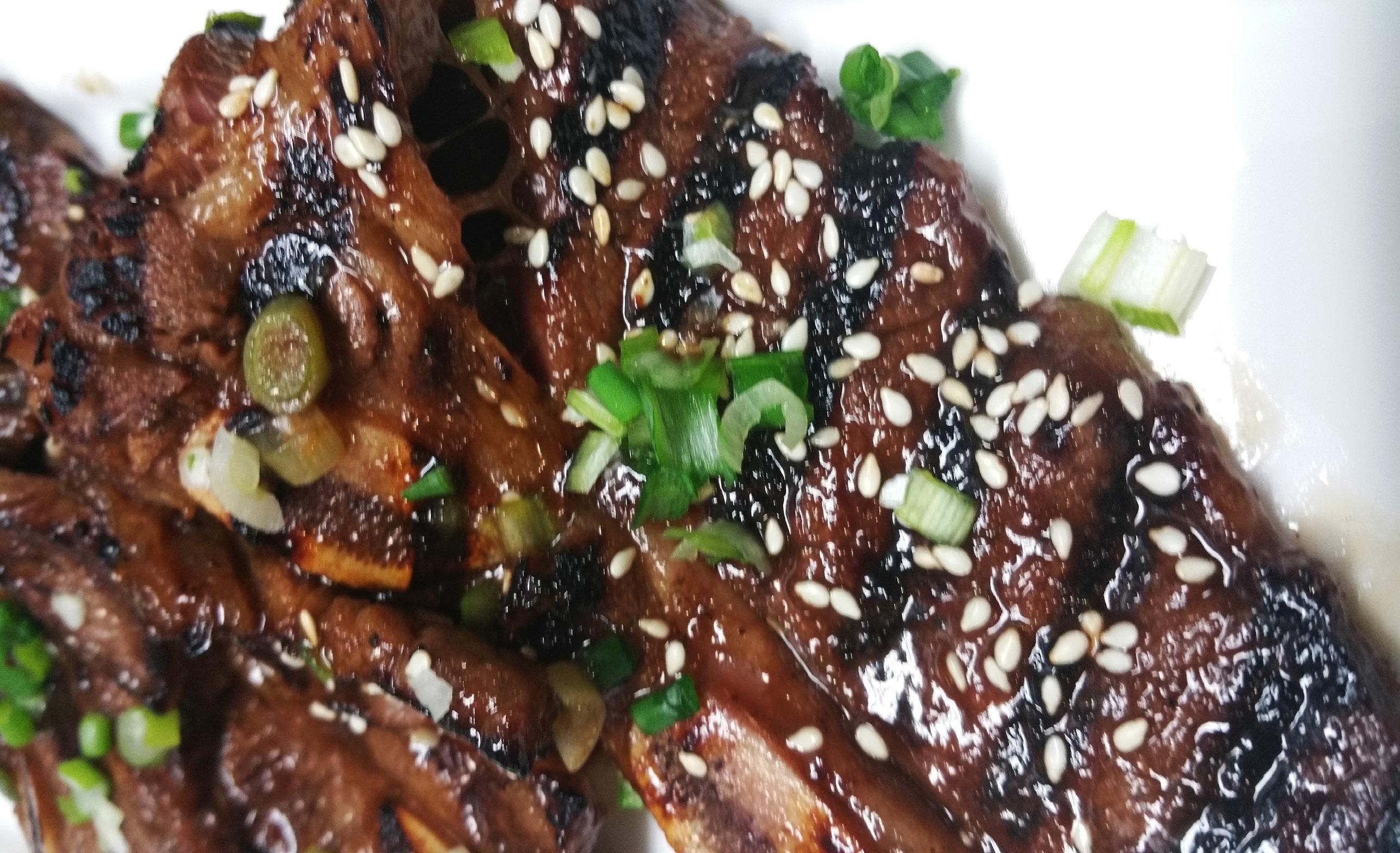
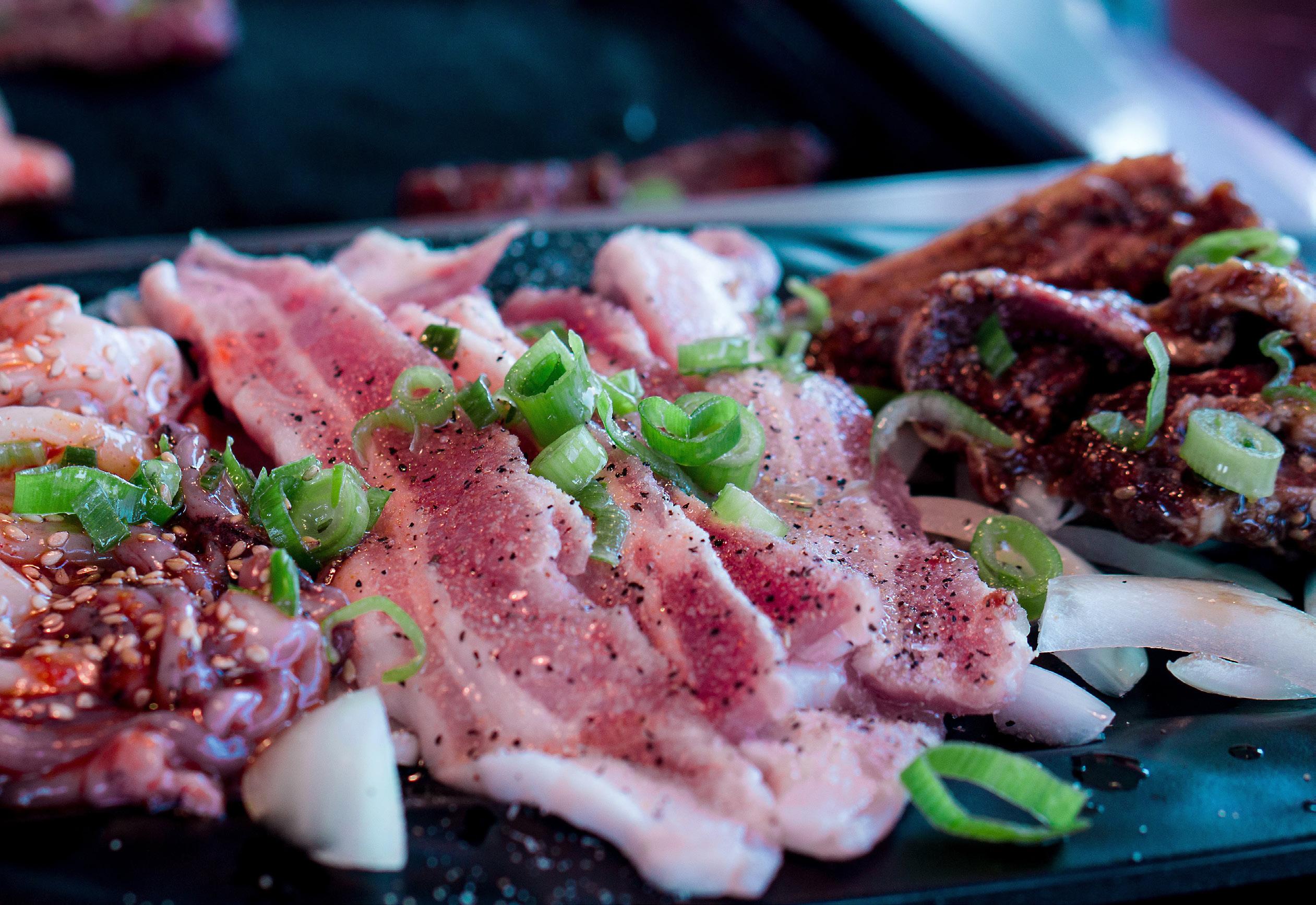

IBy Chef Brian Henry Food Editor
feel like we are all coming out of an extended two year Covid induced hibernation which I can’t really sugar coat ‘coz I’m not Willy Wonka and feel like I’ve just come down off of a two year acid trip that had me running blindly through a Rob Zombie house of horrors that has left me stripped, shorn and raw.
If Covid has taught us anything, it’s best to keep it simple, work with what you have and appreciate life’s indulgences like coffee, chocolate and red wine. These three ingredients inspired me to create the Angle Iron Steak Spice and when proportionately combined with a few other seasonings makes for a decadent tasting steak with that balls out reveals Montreal Steak spice for what it is… expensive flavored salt.
I’m aware that we should be eating less meat and more plant based foods and proteins, but until I find ones that taste and feel like steak I will continue to occasionally indulge in red meat without judgment, just more moderation.
The following recipe makes for a simple but spectacular meal and can easily be adapted to steaks on the barbeque and forgo some of the work. To make this recipe extra debauched serve the meat with a bit of melted butter drizzled over it and remember to indulge once in a while. You will need to quaff bold red wine or dark beer while feasting on this one.
2 -3 lb Beef Tenderloin, center cut
2-4 oz Angle Iron Steak Spice* https://thespiceco.square.site/
3-4 oz clarified butter, melted
1 cup dry red wine
2 cups good quality beef or veal stock
½ tsp Kick Ass Cajun Seasoning*
*Spices from The Spice Company https://thespiceco.square.site/

1. Pre-heat oven to 425 °f on a roast or bake setting, with no convection fan. Pat tenderloin dry with paper towel before vigorously and evenly rubbing the Angle Iron Steak Spice into the tenderloin.
2. Pre-heat a large, well-seasoned, cast iron skillet or heavy bottomed frying pan over med-high heat. Make sure the pan is good and hot before adding the clarified butter and quickly sear the tenderloin on all sides by turning it in the butter, pressing firmly; to produce a solid brown sear on its outside. Transfer tenderloin to a rack lined roasting pan. Place in the oven for 15 min per lb of meat and allow for 15 minutes of resting for medium rare roast.
3. For the sauce, simmer the wine in a sauce pan until it is almost all evaporated. Add the Cajun seasoning and beef stock and continue simmering until reduced by half. Stir in any juices from the roasting pan into sauce. Strain any juices from the beef into the sauce in the saucepan.
4. The finished tenderloin can be served in thin slices or cut into thicker steak-like cuts.
5. Serve with sliced tomatoes from the garden and roasted sweet potatoes.
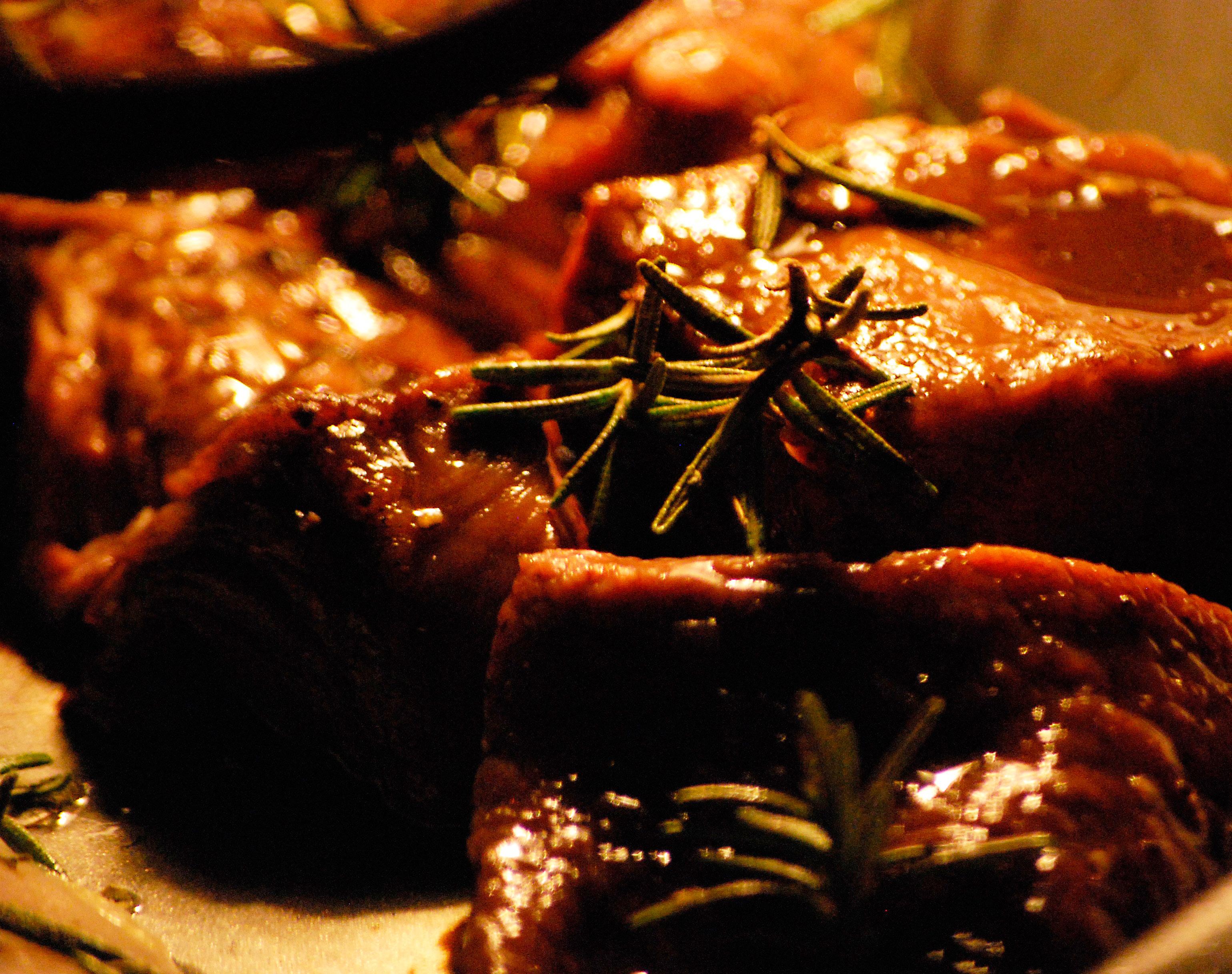
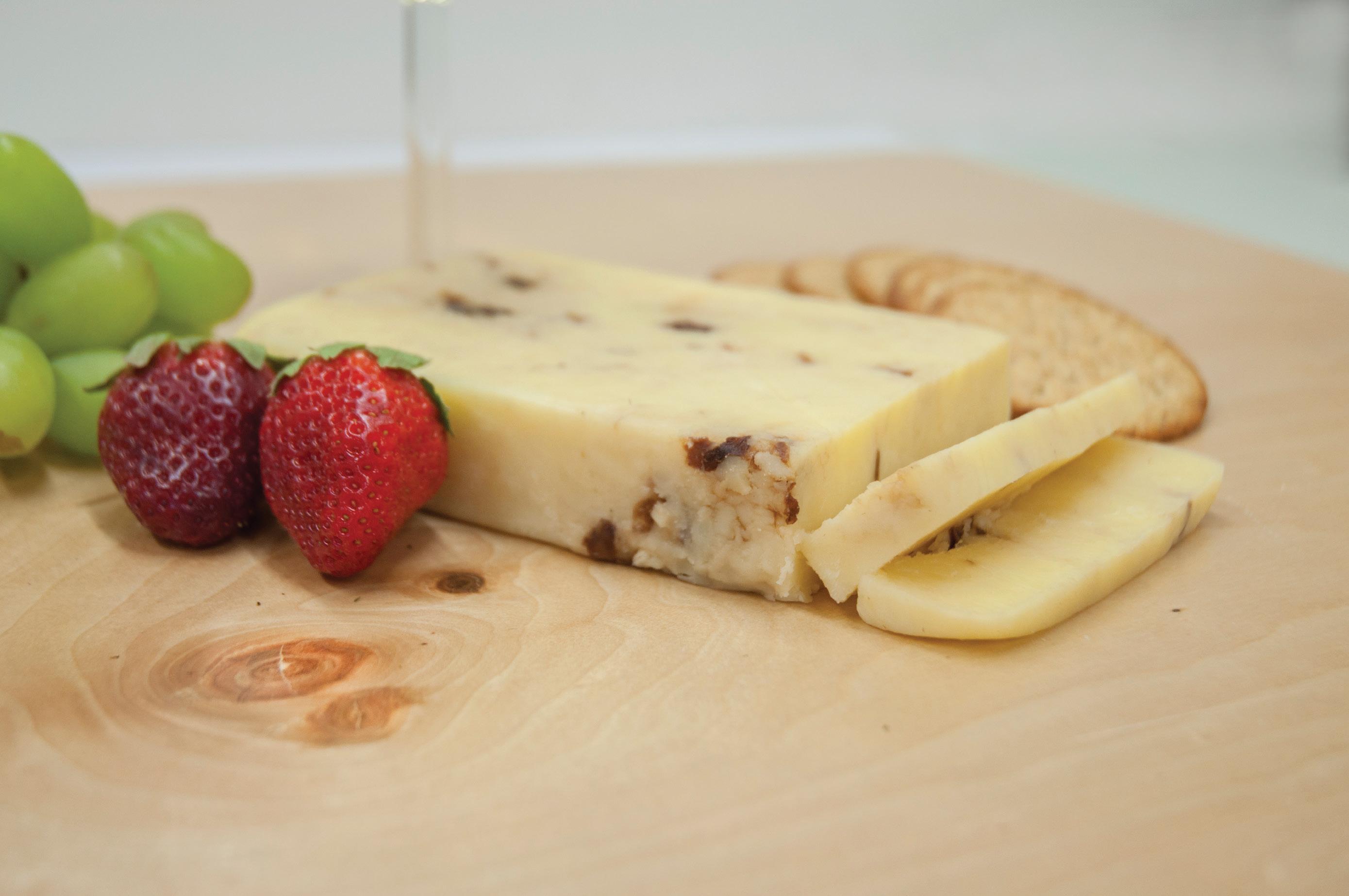


EBy Chef Brian Henry
Editor
ver since the discovery of fire we have been cooking meat over it. The English word “Barbecue” comes from the Spanish “Barbacoa” which arrived in Central America when Cortés showed up and wiped out the Aztec’s. Spanish conquistadors witnessed the fierce Island Carib people dine on their captives, primarily the peaceful Arawak, which were cooked a la barbacoa. Barbecue traveled north of the Caribbean and Central America to Texas where it evolved into what we know as barbecue today.
Canadian barbecue influences come from the Pacific Northwest where Indigenous peoples would split open a freshly caught salmon and bind it to a piece of cedar driftwood before cooking it over a fire. They also used fire to heat stone slabs of granite for cooking fish and seafood on.
Vegetarians are probably reeling reading this, which is why if you want step up your barbecue game fruits need to start making it onto the grill. Grilling lemons or oranges that have been sliced in half give them a more complex flavour and will yield twice as much juice when squeezed. Flame grilled pineapple sees the sugars caramelize on the surface giving it a depth of flavour that compliments all varieties of meat. The secret to grilling fruits is to give then a light brushing of oil before exposing them to the fire, as it protects them and doesn’t allow them to dry out. As summer progresses, you must try grilling peaches and apricots which can be served with salads or warm over ice cream. Better yet, they can be used to make grilling sauces or marinades.
Barbecuing cherries would be a bit of a challenge, but they are perfect to use for making barbecue sauce. The following recipe for Cherry Barbecue sauce will see you level up on your barbecue game. It is mildly smoky, with the perfect balance between acidity and sweetness making it a go to sauce for ribs and chicken. But it is delicate enough to brush on your barbecued peaches before spooning them over ice cream fresh from the grill.
1 lb fresh Bing or Rainier cherries
2 tbsp Cooking oil
3 cloves Garlic, peeled
¼ cup Yellow onion, diced
1 cup Brown sugar
½ cup Chili sauce
½ cup Tamari soy sauce
.
¼ cup tomato paste
½ cup apple cider vinegar
2 tbsp Worcestershire sauce
1 tbsp chili powder
1 tbsp ssmoked paprika powder
½ tsp cayenne
1 tsp chipotle chili powder
1. Pit the cherries, cut them in half and set aside.
2. In a large saucepan over medium-low heat, sweat the onion and garlic in the cooking oil until they begin to brown.
3. Stir in all of the remaining ingredients and simmer over medium-low heat for 35-45 minutes.
4. Using an immersion blender, puree the sauce until smooth.
5. Season sauce to taste with salt and pepper, if desired you may choose to spice it up with a few drops of your favorite hot sauce.

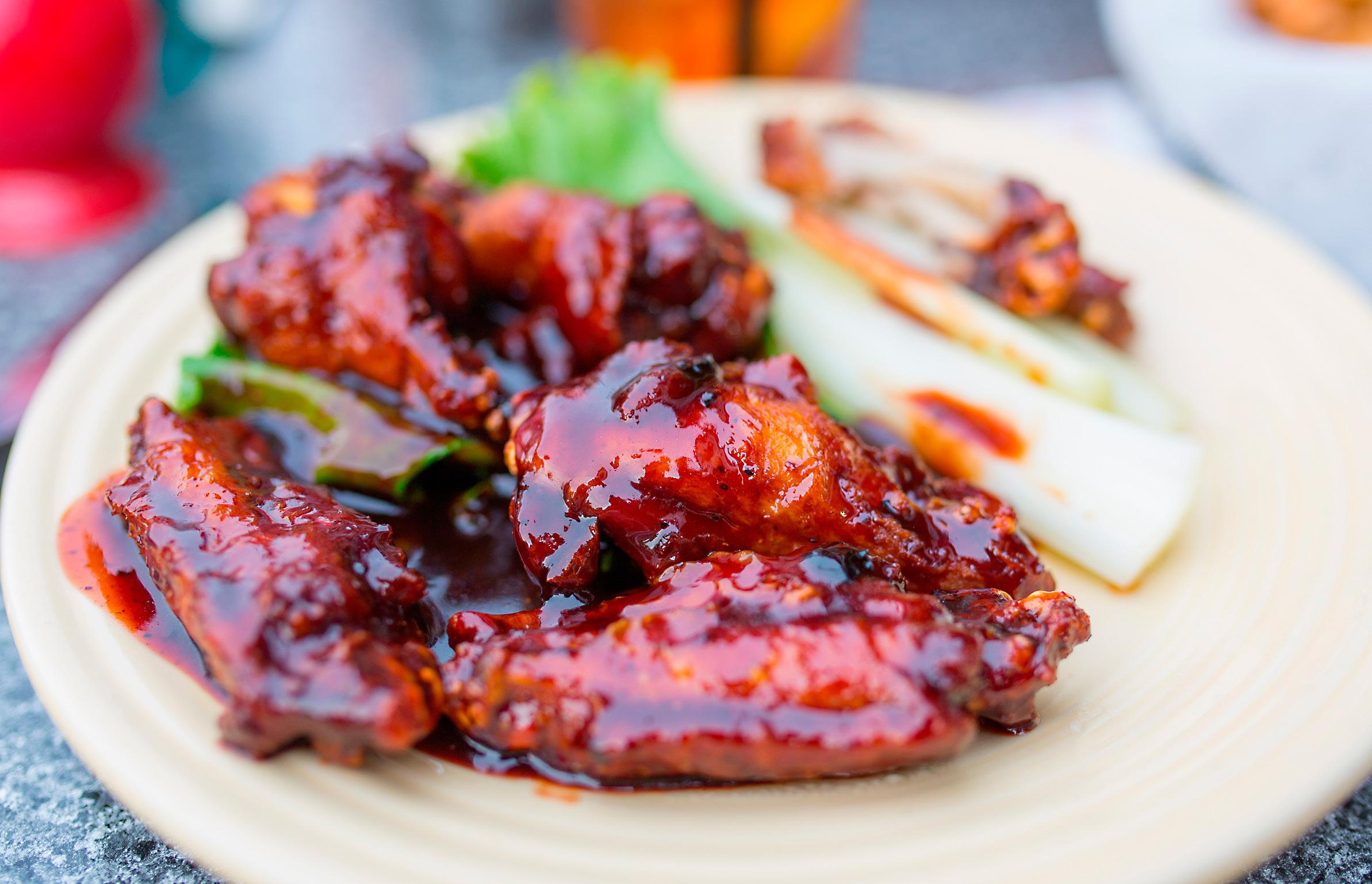

SBy Chef Brian Henry Food Editor
moking is a flavourful way to dry and preserve foods that has been used since prehistoric times. The smoking process involves holding our foods for long periods of time at warm temperatures.
This can become problematic as it greatly increases the risk of food poisoning due to time and temperature abuse promoting the growth of bacteria, which is why the first rule of smoking is not to smoke any meat, poultry, or seafood that has not first been cured in brine.
Brine is simply a solution of salt, sugar and other curing ingredients dissolved in water. Foods will then be submerged in the brine for 10-12 hours. The brining process forces water into the muscle tissues of the meat by the processes known as diffusion and osmosis. This additional moisture causes the muscle tissues to swell and hold more water. This excess water in the muscle tissues will make the meat more moist and tender. Any spices, herbs or other flavorings you add to the brine solution will get taken deep into the meat with the water.
The meat is then removed from the brine and rinsed off to remove the excess salt and allowed to dry, uncovered for a few hours in a refrigerator before smoking. This will allow for a sticky film to develop on the meats surface called pellicle. It is important that the pellicle is allowed to develop on the surface because it acts like Velcro for the smoke to adhere to the surface of the food.
When you smoke foods it is best to keep the temperature as low as possible. I like to keep my smoker around 90° C / 190°F. If you see a white substance forming on the surface of the meat you have exceeded the temperature and over cooked the meat, at which point it will no longer take any more smoke.
Place chicken in the brine, cover, and refrigerate two hours for skinless breasts, 4 hours for bone-in pieces, and 8 hours for whole chickens. Drain the brine and discard. Quickly rinse the chicken with cold water and pat the chicken dry before cooking. One gallon of brine is enough for 6 pounds of whole chicken or bone-in chicken pieces, and up to 10 pounds of skinless, boneless chicken breasts.
Fire up your smoker using mild woods like cherry or apple and allow the temperature to reach 90° C / 190°F. Place chicken on the smoker racks. Let chicken smoke/cook until it reaches a minimum internal temperature of 74°C /165°F for pieces or 82°C /180°F for whole bird. Remove chicken from the smoker and serve immediately.
1 litre Water
100g Salt
30g Brown sugar
2 Bay leaves
5g Black peppercorns
2g Coriander seed
1g Allspice berries
1g Dry mustard
Prepare the brine by combining all ingredients and simmering until all the salt and sugar is dissolved. Let cool.
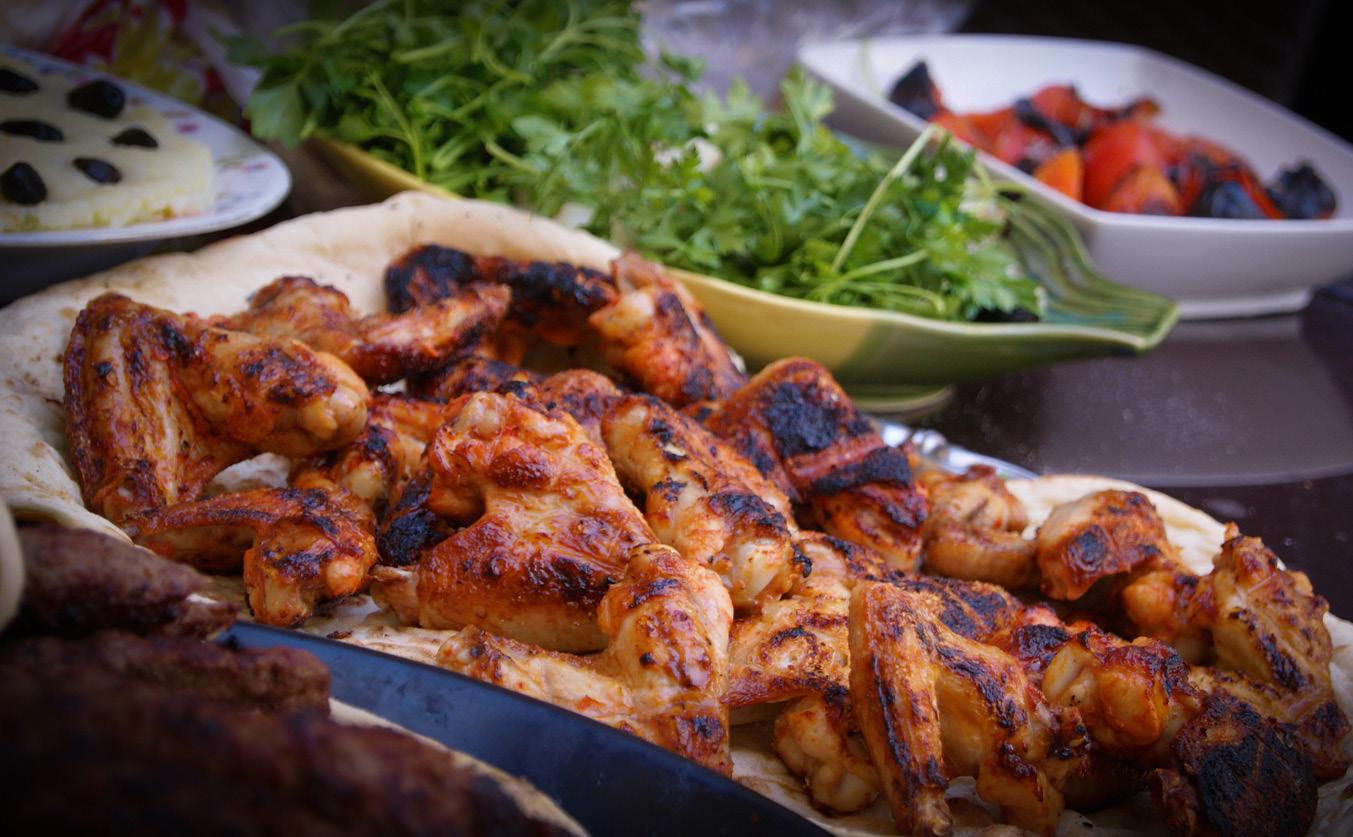
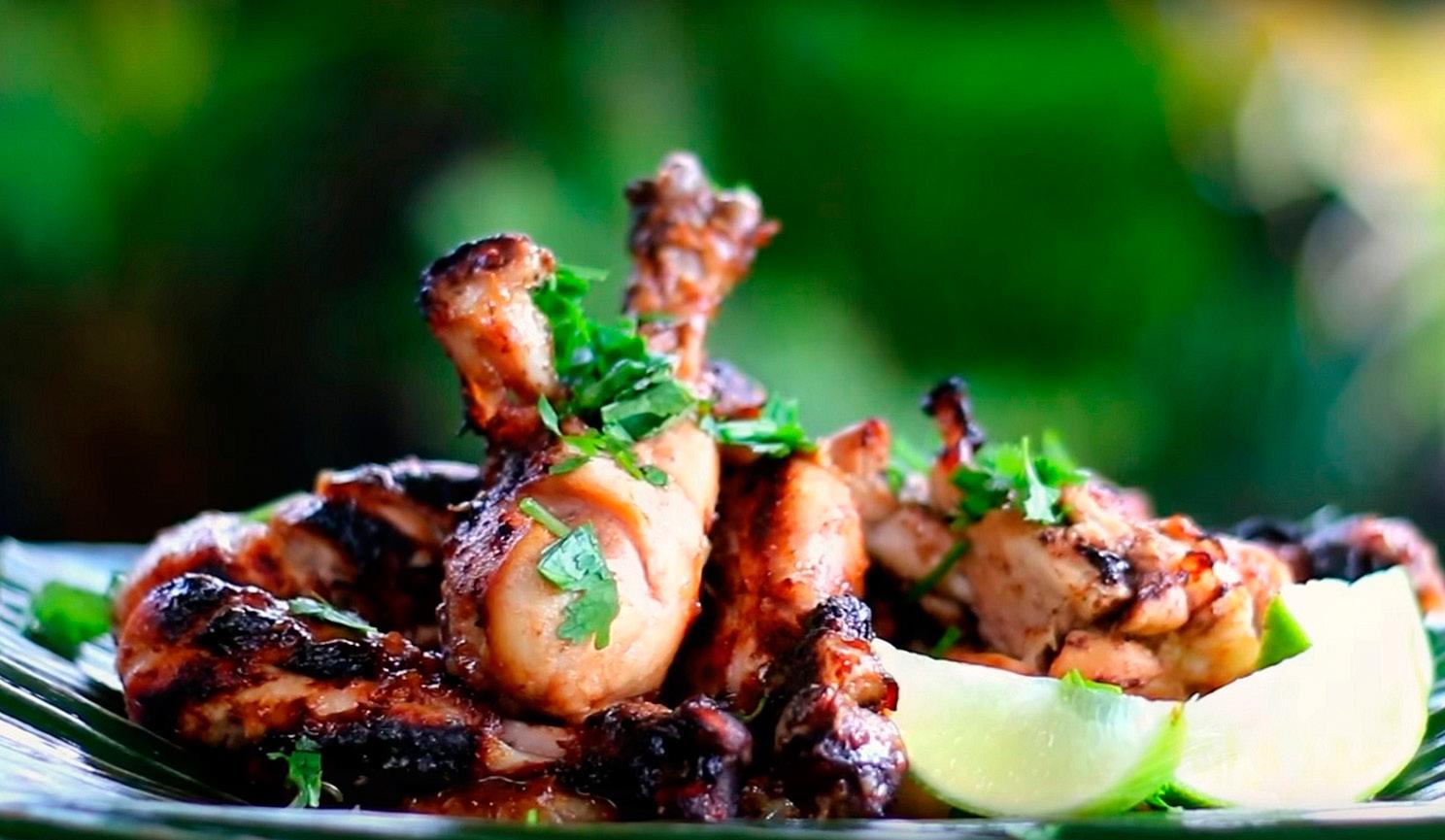

ABy Chef Brian Henry Food Editor
fter the inconvenient adjustment to saving daylight, our eating habits begin to shift as we enter the darker months. We retreat into our homes in search of familiar creature comforts which often are only satiated by food.
It is also a time for us to dust off the slow cookers and dig out the Dutch ovens as we delve into heartier meals. The longer slow cooking processes of comfort foods build anticipation for the next meal as their aromas. We are genetically wired to seek out more calorie-dense foods as food historically speaking was often scarce at best in winter and we sometimes need to put some meat on our bones for the cold weather ahead of us.
Bones are full of minerals, mainly calcium, phosphorus and magnesium. Connective tissue like tendons, ligaments, and cartilage is still attached to them which contain glucosamine. Bones are porous and transfer heat slowly which in turn slows down cooking times. The benefit to this is that meats will not cook as fast allowing the proteins to denature and relax which guarantees tender meat that is juicy and flavorful.
The following recipe for southern fried chicken is a bone in comfort food that is easy to prepare and is best served with mashed potatoes, slaw, gravy some fresh baked rolls to ensure that your plate is clean when you’re done.
1 whole chicken 2 -3 pounds
3 eggs
½ cup butter milk
2 cups all-purpose flour
METHOD:
2 tsp. baking powder
1/2 tsp. garlic powder
1/4tsp. powdered ginger
A pinch of both salt and pepper
Vegetable oil or peanut oil, for frying
1. Using a knife break the chicken down into smaller cuts and pat the pieces dry with paper towel to remove any moisture.
2. Preheat your deep fryer to 350 °f and your oven to 200 °f.
3. In a medium size bowl, whisk together the eggs and buttermilk and set aside. In a separate bowl sift together the flour, baking powder, garlic and ginger powders with salt and pepper.
4. Dip the chicken pieces one at a time into the egg mixture, then evenly coat them in the flour mixture and gently submerge them into your preheated fryer. Make sure each piece of chicken has plenty of space to cook in the fryer without touching anything. If necessary fry the chicken in small batches and transfer the cooked pieces using tongs or a slotted spoon onto a baking tray line with a roasting rack in your preheated oven.
5. Fry the chicken until brown and crisp, about 10-12 minutes depending on the size of the pieces. More importantly, you will need to ensure the chicken is cooked to a proper internal temperature of 74 °C / 165°F. This is best checked with a food thermometer.
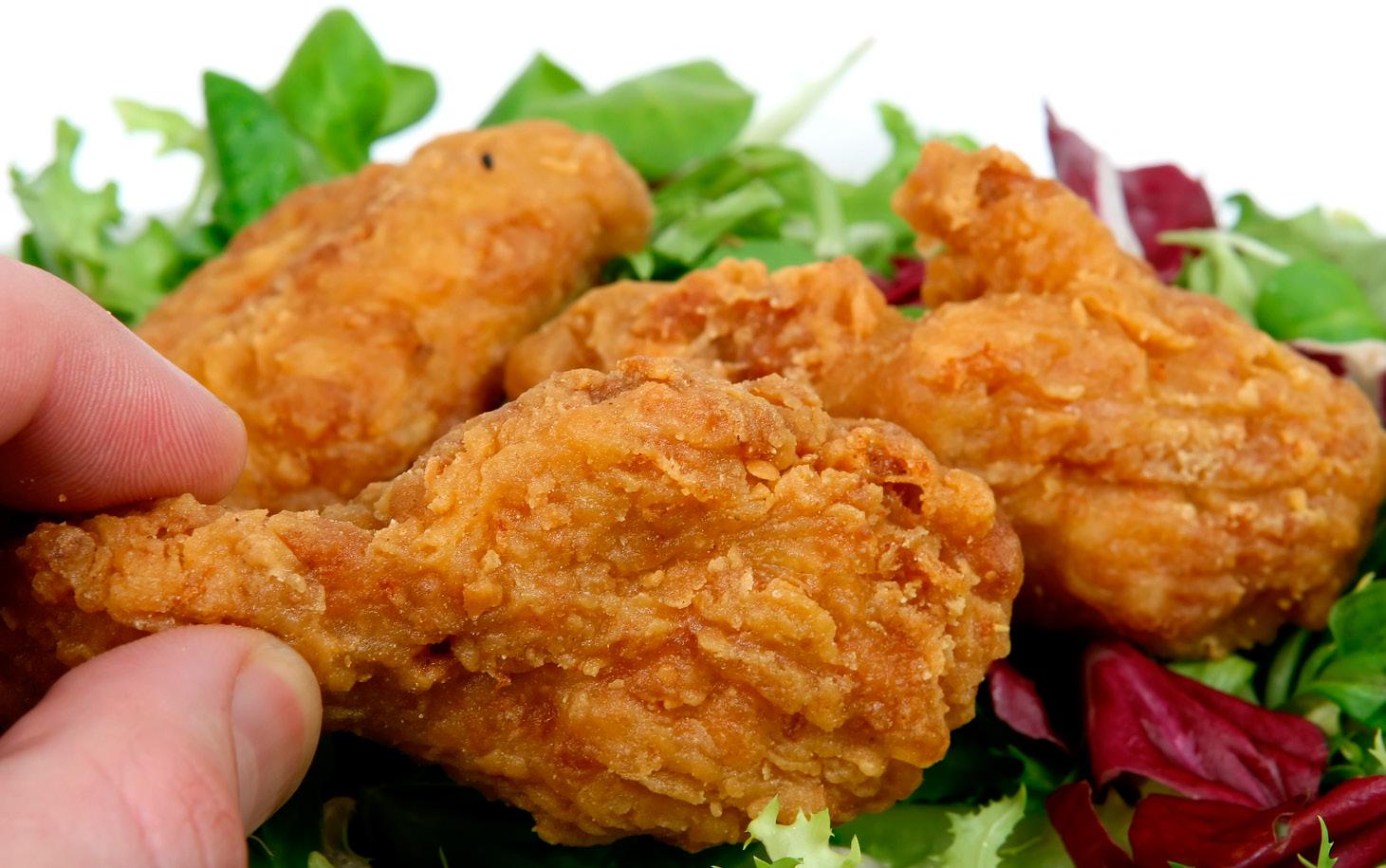
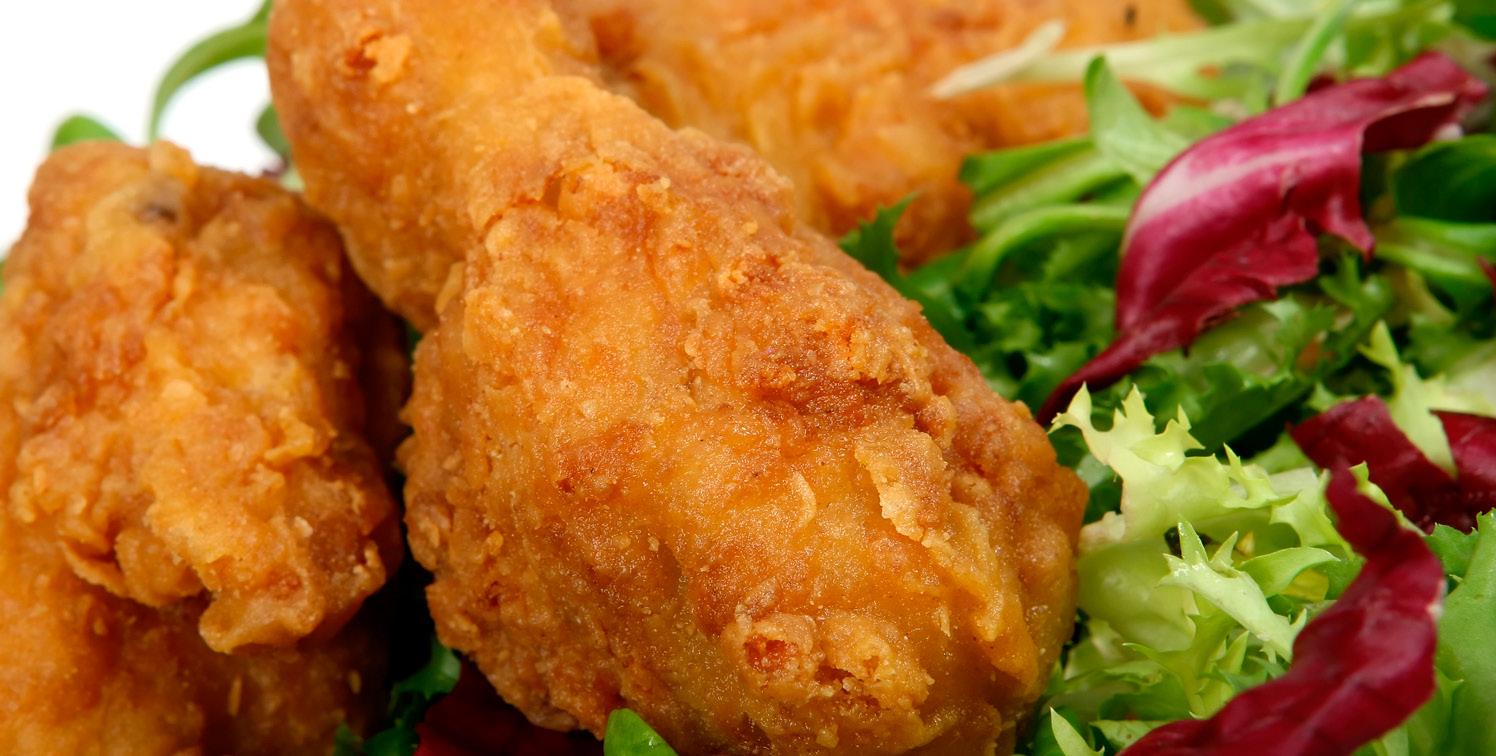

OBy Chef Brian Henry Food Editor
ffal rhymes with awful and the irony is that offal is the culinary term used to describe the glandular organs and entrails of animals. Liver, heart, spleen and tripe are various forms of offal and their mention often leads to the loss
Animal livers are rich in iron, copper, B vitamins and vitamin A. They can be baked, boiled, broiled or fried. Often pieces of liver are combined with a variety of meats in a mixed grill.
Liver haters might become liver lovers if they first soak liver in milk or diluted cider vinegar for an hour to help soften the membranes and remove impurities. Do not over work or handle the liver while cooking and never over cook it as medium-rare to medium is a preferred doneness.
I served the following liver recipe thinly sliced over Mashed Potatoes with Candied Pickled Onions and truffle oil for added moisture and a variety of textures at the A Taste of Kawarthas writers’ team building event. I didn’t tell anyone what it was until after they tried it and most agreed that if they had known it was liver they would have passed on this course but they discovered that they do like liver - when it is properly cooked.
2 pounds sliced beef liver
1 1/2 cups milk, or as needed
1/4 cup clarified butter
Flour as needed
Salt and pepper to taste
Candied red onions
Truffle Oil
Mashed Potatoes

METHOD:
Gently rinse liver slices under cold water, and place in a medium bowl. Pour in enough milk to cover. Let stand for an hour or two. Melt butter in a large skillet over medium heat. Season the flour with salt and pepper, and put it in a shallow dish. Drain milk from liver, and dredge liver in the flour. When the butter has melted, turn the heat up to medium-high, and place the coated liver slices in the pan. Cook until nice and brown on the bottom. Turn, and cook on the other side until browned. Reduce heat to medium and cook to desired doneness. Serve over mashed potatoes, topped with candied onions and drizzle with truffle oil.
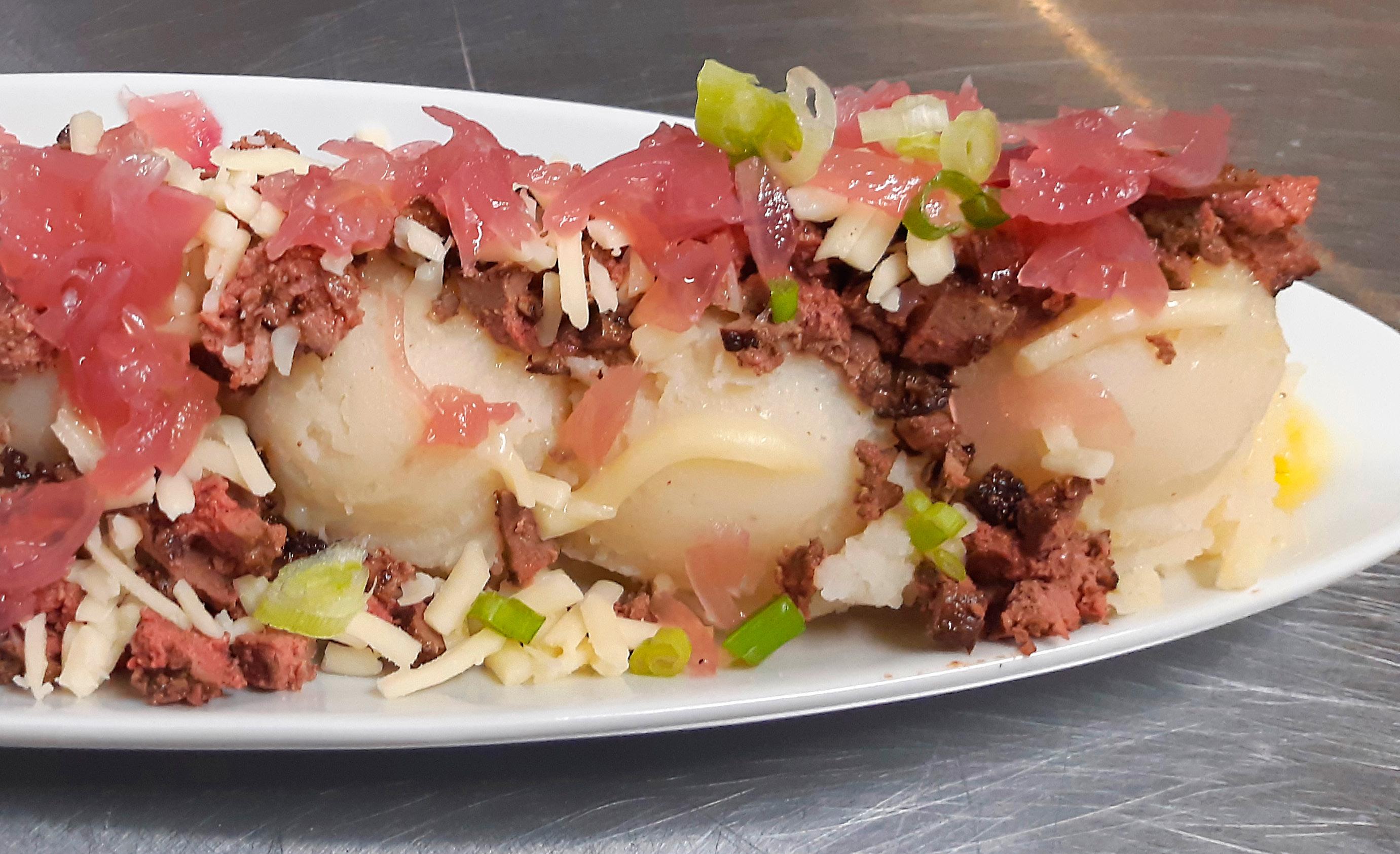

3 Racks short ribs
3 Litres distilled water
3 Tbsp Prague Powder #1
1-1/2 C kosher salt
8 CLOVES garlic (crushed)
1-1/2 C brown sugar
4 Tbsp course black pepper
3 Tsp paprika
2 Tsp garlic powder
2 Tsp onion powder
2 Tbsp ground coriander
2 Tbsp mustard powder
METHOD:
1. Cut off the ribs fat cap.
2. Add all cure ingredients together. Whisk until broken up.
3. Put ribs into the cure for 2-3 days.
4. Rub with dry ingredients and smoke at 200° F for 3 hours OR cook at 275° F in the oven for 2-1/2 hours.
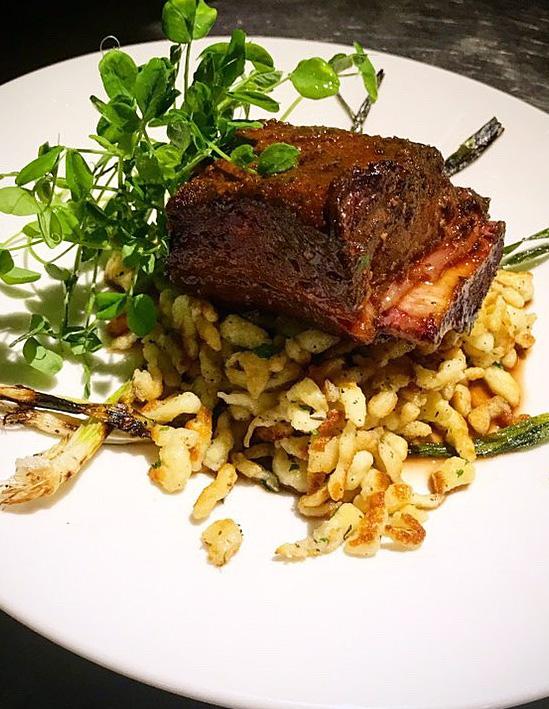

Atrue taste of summer in the Kawarthas, this dish combines local lake trout smoked over fruitwood, creamy corn purée made from peak-season Ontario corn, fire-charred zucchini, and a burst of acidity from pickled wild blueberries. Served in cast iron with herbs from the vineyard garden, it’s a perfect match for our Vidal or Sparkling Rosé.
Serves 2 | Prep Time: 20 min | Cook Time: 25 min
INGREDIENTS:
For the Smoked Trout
2 fillets local lake trout (skin on, deboned)
Olive oil, salt & cracked pepper
Fruitwood chips (apple or cherry)
Corn Purée
2 ears of fresh Ontario corn, shucked
1 tbsp unsalted butter
2 tbsp cream
Salt to taste
Charred Zucchini
1 small zucchini, sliced lengthwise
Olive oil & flaky salt
DIRECTIONS:
1. Smoke the Trout:
Pickled Wild Blueberries
¼ cup wild blueberries
¼ cup apple cider vinegar
1 tbsp honey
Pinch of salt
Fresh mint and lemon thyme leaves
Edible flowers (nasturtiums or borage)
Drizzle of cold-pressed canola or basil oil
Rub trout with olive oil, salt, and pepper. Smoke over apple or cherry wood at ~225°F for 20–25 minutes, or until just flaky. Keep warm.
2. Make the Pickled Blueberries:
In a small pan, bring vinegar, honey, and salt to a simmer. Pour over blueberries in a bowl and let sit for at least 15 minutes.
3. Corn Purée:
Boil corn kernels until tender (5–7 min). Blend with butter and cream until silky smooth. Season with salt. Keep warm.
4. Char the Zucchini:
Brush slices with olive oil and grill until charred on both sides, about 2–3 minutes per side.
5. Plate:
Spoon corn purée onto a warmed cast iron plate or rustic board. Layer with grilled zucchini. Place smoked trout on top. Dot with pickled blueberries, scatter herbs, and drizzle with basil oil. Garnish with edible flowers.
Wine Pairing:
Pair with Cheeky Duck Sparkling Vidal — its crisp acidity lifts the sweet corn & smoked trout beautifully.

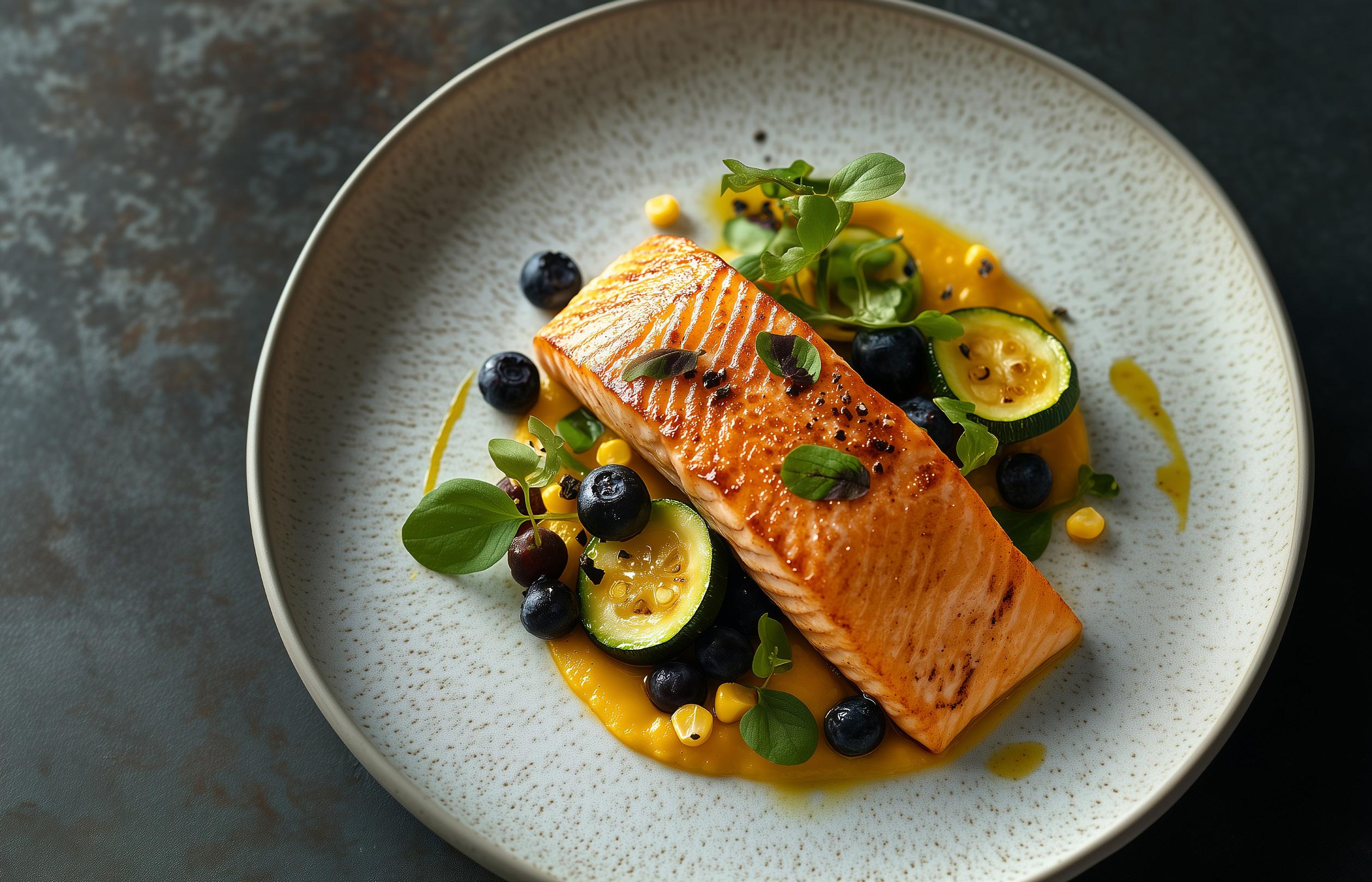

by Diane Rogers
This recipe is a favourite with my family. It’s delicious and can be served with rice and green beans. Or have a salad on the side. Ready in 55 minutes and serves 6 people.
2 tsp. oil
6 small boneless skinless chicken breasts (about 1-1/2 lb.)
½ C Russian Salad Dressing (Kraft has one)
½ C apricot jam
½ pkg dry onion soup mix (about 3 Tbsp.)
1. Preheat oven to 350°F.
2. Heat oil in large skillet on medium-high heat.
3. Add chicken; cook 4 min. on each side or until browned. Remove chicken from skillet, place in 3L baking dish.
4. Mix dressing, jam and soup mix in small bowl and pour over chicken. Bake 45 min. or until chicken is cooked through.


By Chef Brian Henry
W hen Diane Rogers of Doo Doo’s Bakery joined me in the kitchen to do A Taste of the Kawarthas cooking show, I asked her what her go to favourite recipe was; without hesitation Diane said Chicken Parmesan.
Naturally I asked her to share her recipe for the show, she didn’t have one, she doesn’t make it, and doesn’t really care to make it. You must understand that chefs, cooks and bakers do not cook the same at home as they do at work. In fact, the last thing most of us want to do at home is cook, especially on our day off if we get one, because we just spent the last week or two cooking for hundreds if not thousands of other people. It was for this reason or maybe that Diane just wanted someone else to cook a decent meal for her that we cooked up a version of Chicken Parmesan which kind of goes like this…
2 Chicken breasts
1 cup of flour seasoned with a bit of salt, pepper
2 eggs, whisked for egg wash
Cooking oil
Grated parmesan
Fresh basil
METHOD:
1. On a firm surface, cover chicken breasts with plastic and pound them out with a smooth surfaced meat mallet so that they are of an even thickness to ensure even cooking. Next dredge chicken in flour, dusting off the excess, then dip in the egg wash before placing chicken into the parmesan cheese.
2. Ensure the chicken is well coated by pressing it into the cheese. Once all chicken is prepped, heat a large non-stick pan over medium heat, with enough oil to lightly coat the pan’s bottom. Cook the chicken 3-4 minutes per side until it reaches an internal temperature of 75°c.
3. Pour half the marinara sauce in a casserole dish. Arrange chicken pieces over the sauce in a single layer.
4. Spoon remaining marinara sauce over the chicken and top with mozzarella and more parmesan cheese or add feta or smoked Gouda. Bake in a casserole dish at 425˚F for 15 minutes until cheese is melted and sauce is bubbling. Top with freshly chopped basil and serve with your favourite pasta.

INGREDIENTS:
3 ¼ cups sliced button mushrooms
1-¼ cups diced onions
1-2 tbsp. Italian Scallion
2 bay leaves
2 tablespoons of minced garlic
¼ cup cooking oil
Blacks Distillery Vodka
METHOD:
1. Sautee all the items in cooking oil. Add ¼ cup of flour to form roux. Next stir in a cup of water, 1 small tin tomato paste, 2 med sized tins of diced tomatoes and ½ cup vodka. Let simmer for 20-minutes then remove from heat and let it cool.
2. Stir in 1 bunch of coarsely chopped parsley and 1 ½ cups of green onion cut into 1 inch pieces.

T
By Chef Brian Henry
he festive season of over indulgence is upon us once again. Kiss your diet and workout routines goodbye and bring on the fat and carb loaded foods, the home baked goodies and all of the vices that give us those hallucinations of sugared plums dancing in our heads while we sleep it off with a long winters nap.
Speaking with Monika Schnarre it was no surprise to hear that she likes to eat clean and healthy foods. Seriously just look at her; what did you expect from her? When pressed further about food and the holidays she did divulge that when it comes to traditional dinners she does enjoy Turkey with German Trimmings that includes Stuffing with Bratwurst, German dumplings called Knödel and sautéed mushrooms.
You might have to forgo the skinny jeans and break out your eating pants if you use the following recipes for Monika’s holiday feast favourites.
1 pound German Bratwurst
¾ cup butter, melted
¾ cup diced onion
1 ½ cups diced celery
8-10 slices of bread, cubed
1 tbsp. poultry seasoning
Salt and pepper
1. Pierce the sausages with a fork a few times before cooking them so they don’t blow up and allow for the juices to flow out freely into the pan. Preheat a large skillet or fry pan over medium heat. Add the sausages and gently cook them until they are nice and evenly browned. Transfer the sausage from the pan to a paper towel lined plate to drain and cool down.
2. Using the same pan add the butter, onion and celery to the sausage drippings and cook mixture until the onions are soft and tender but not browned, stirring frequently.
3. Next, stir in about 1/3 of the cubed bread so that it soaks up all of the juices in the pan and remove from heat. Meanwhile chop the cooled sausage into bite size pieces and place them in a large bowl with the remaining ingredients. Add the cooked onion mixture to the bowl of ingredients. It is best to mix this together with your hands while gently squeezing it to extract and blend all of the flavours. Taste mixture and season with salt and pepper Mind yourself as it could be hot.
4. Once mixed the stuffing is ready to be cooked either as a stuffing or as dressing. If cooking as a dressing, bake it in a covered casserole dish at 350 °F for 25-30 minutes.
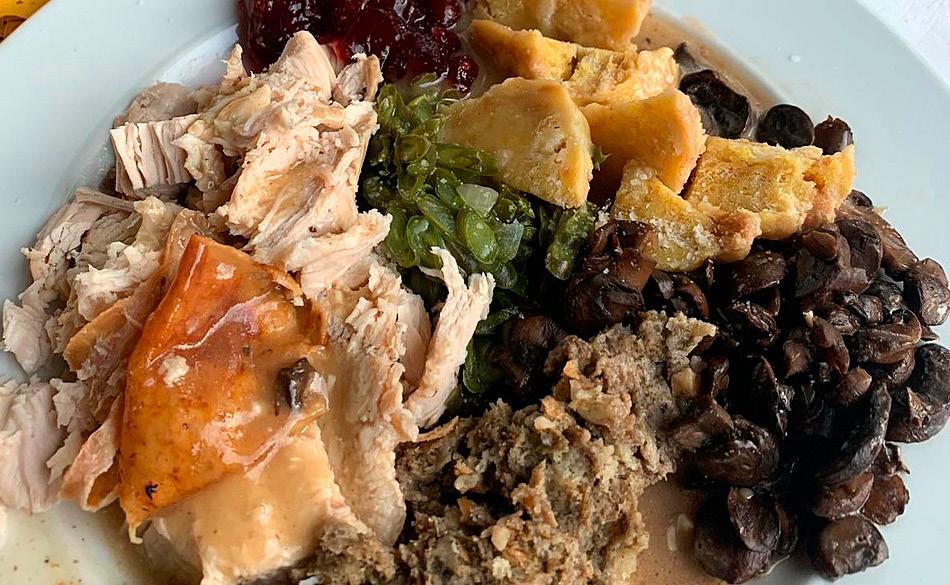
12 oz stale or dried white crusty bread
1 cup hot milk
1 tbsp. butter
3/4 cup minced yellow onion
2 eggs , whisked
3 tbsp. finely chopped fresh parsley
½ tsp. salt
1/4 tsp. freshly ground black pepper
1/8 tsp. freshly ground nutmeg
1. Chop the bread into small cubes and place them in a large bowl. Pour the hot milk over the bread, cover and let sit for 20-30 minutes or until softened.
2. Sautee the onions in the butter until soft and transparent before adding them to the milk soaked bread along with the eggs, parsley, salt, pepper and nutmeg. Knead the mixture together with your hands until evenly incorporated, until it’s soft with a chunky-smooth consistency.
3. Wet your hands to prevent the dough from sticking to you while forming the Knödel by taking the dough and forming it like making a good solid snowball. Over medium-high heat, bring a large pot of lightly salted water or chicken stock to a simmer. Using a slotted spoon, carefully place the Knödel in the water and let them poach for 15-20 minutes. Do not let the water boil or your Knödel will disintegrate into a goopy mess. Once cooked, use the slotted spoon to transfer the Knödel to a serving bowl and eat immediately.

By Chef Brian Henry Food Editor
G et your Mojo On! No doubt that after the extended lockdowns these past few months and the collective punch in the gut or kick in the nuts many of us are feeling we need to get our mojo back.
Start by stepping away from the sourdough. That was so Lockdown 1.0. It’s time to use some of the skills you learned with the Lockdown 2.0 trend of Meal Kits that created more waste than our discarded PPE in the following recipe for Mojo Pork. Get outdoors and fire up your barbecue and try this dish that is full of tropical flavours combined with just the right amount of spice and is best paired with a rustic avocado salad. It’s a great way to get your summer groove on!
PORK INGREDIENTS:
2 lb pork shoulder
2 tbsp. Mexican Kitchen Cartel (The Spice Co)
2 garlic cloves, minced
1 cup orange juice
1/4 cup minced green onions
1/2 cup lime juice
2 tbsp. Cooking oil
MOJO INGREDIENTS:
2 tbsp. bread crumbs
3 garlic cloves
1 – 2 tsp. red pepper flakes
1 tsp cumin seeds
1 tsp sweet paprika
Pinch of salt and pepper
4 tsp malt vinegar
1/4 cup canola oil
METHOD:
Trim the pork of any excess fat and cut it into cubes about an inch in size. Thread the cubes onto skewers and lay them in a shallow plastic container. In a bowl, whisk together all of the remaining ingredients and pour them over the pork skewers. Cover with plastic wrap and let the skewers marinate overnight in the fridge.
METHOD:
Combine all of the ingredients except the oil in a food processor and pulse them into a paste, adding the oil a little bit at a time until you achieve a consistency which will be thick yet viscous. Place mojo in a serving dish, cover and refrigerate overnight.
Cook the skewers over medium-high heat for about 3-5 minutes, until cooked but still juicy. The skewers can be pan-fried or roasted in the oven but are best when grilled over wood or charcoal. Serve the cooked skewers with the mojo for dipping. Season to taste with salt and pepper. Serve with a rustic avocado salad.

1 sweet potato, cubed
2 avocados, chopped
2 tomatoes, seeded
1/4 cup chopped cilantro
2 garlic cloves, minced
1/4 cup olive oil
Salt & pepper to taste
METHOD:
Place the cubed sweet potatoes in a sauce pan. Cover with water and boil until soft but not mushy. Place in a medium bowl and add remaining ingredients and toss. Serve immediately.

By Carol Turner @carolturner9319
T his is an easy recipe to prepare; great for entertaining or weeknight suppers. Feel free to substitute a different cheese for the Gruyere, or try a different pesto. Sometimes I add finely chopped nuts to the bread crumbs for added flavour and texture.
Serves 2 (recipe can be doubled)
CHICKEN:
2 large boneless skinless chicken breast halves
4 teaspoons garlic scape pesto (or pesto of your choice)
1/3 cup grated Gruyere cheese
Flour for dredging, seasoned with salt and pepper
1 egg, lightly beaten with one teaspoon water
1/2 cup seasoned bread crumbs
Vegetable oil
1 tablespoon butter or olive oil
1 finely chopped shallot
2 teaspoons garlic scape pesto (slightly drained)
1/2 teaspoon Dijon mustard
1/4 cup chicken stock
1/2 cup heavy cream (35%)
1/2 fresh lemon, cut in half (optional)
1. Place chicken between 2 sheets of waxed paper and pound with a mallet to 1/4 inch thickness. Season with salt and pepper.
2. Place flour, beaten egg and bread crumbs in 3 separate bowls.
3. Spread each breast with 2 teaspoons pesto then sprinkle over 2 tablespoons Gruyere cheese. Starting at short end tightly roll breasts to enclose filling securing with a toothpick if necessary.
4. Dredge chicken lightly in flour then dip into beaten egg and finally roll in bread crumbs to evenly coat. Refrigerate 20 minutes.
5. Pour vegetable oil to 1/8 inch in a heavy skillet, heat over medium heat, add rolls and cook until lightly browned on all sides, about 6 minutes. Transfer, seam side down, to an ovenproof baking dish.
6. Bake in a preheated oven at 350 degrees for 20-25 minutes uncovered.
7. Meanwhile, prepare sauce. Heat butter or oil over medium heat. Add shallots and cook for 4 minutes without browning. Add pesto, mustard and chicken stock and cook until heated through. Add cream, bring to a boil and reduce heat and simmer briefly until slightly thickened. Season with salt and pepper. Slice chicken on diagonal and serve over a pool of sauce. Garnish with fresh herbs and a lemon wedge (I squeeze the juice over the entire dish before eating for a bright pop of flavour!)
Serve with rice or potato and seasonal vegetables.
Carol lives in the Kawarthas and is motivated and inspired to cook – from our incredible restaurants, bakeries, butchers and specialty food shops to our farmer’s markets and comprehensive supermarkets. She loves to create recipes using seasonal ingredients and local products and has everything she needs at her doorstep. Follow Carol on Instagram @carolturner9319
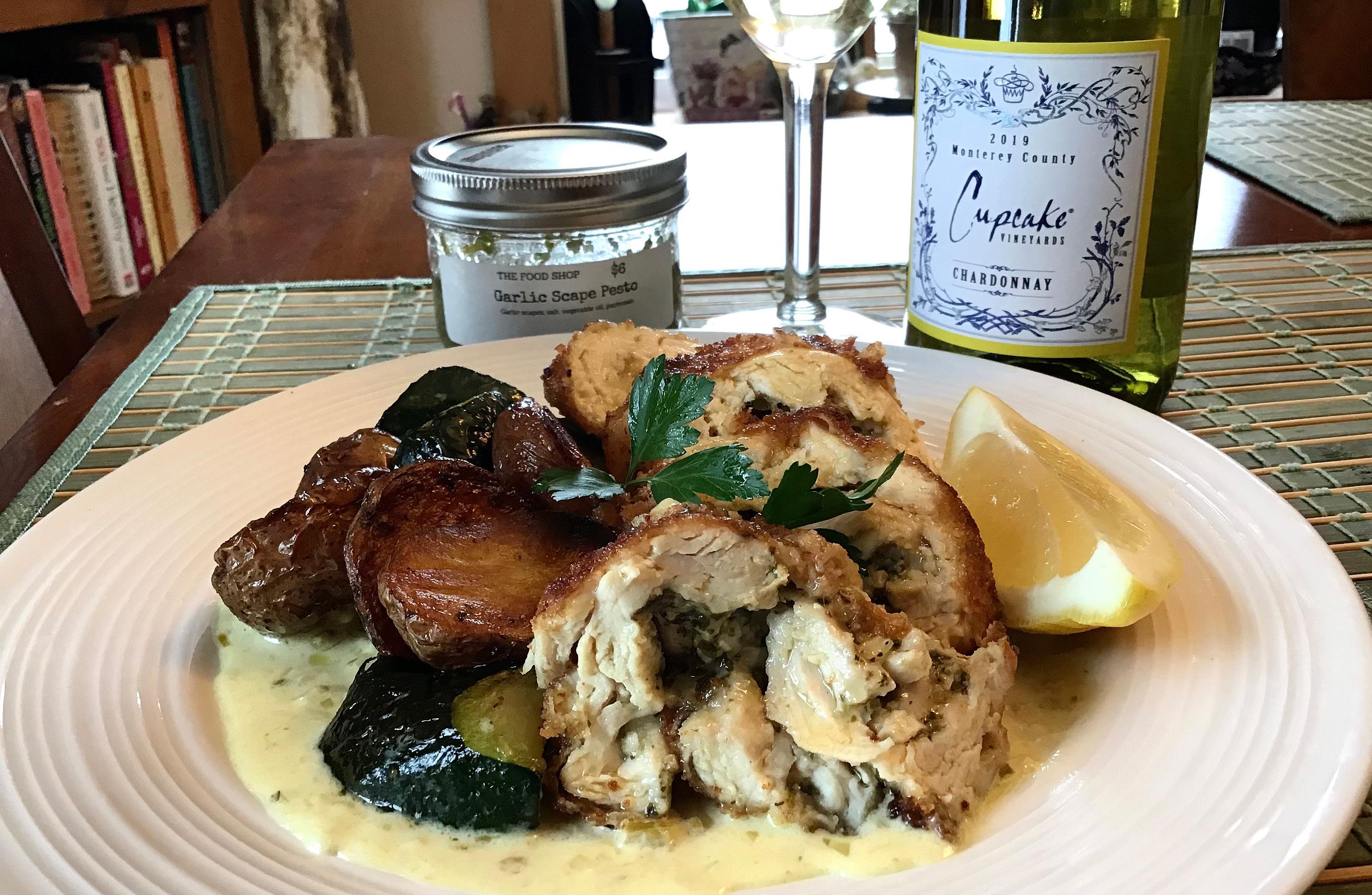

A local favourite for fresh, authentic ingredients, Greek cuisine & more. Scan for our menu! TASTE THE KAWARTHAS!




TBy Signe Langford Signe’s
he first dinner a boy ever cooked for me was an omelette; um . . . it was a night of other momentous firsts. I have a thing for omelettes. Omelette soufflé à la confiture is sweet and light, like our memories of youth. And although “confiture” means jam or preserve, any sweet fruit spread or purée will work.
1/4 cup (60 mL) homemade or excellent-quality
store-bought lingonberry jam, at room temperature
1/3 cup (80 mL) mascarpone, at room temperature
1 Tbsp (15 mL) freshly squeezed lemon juice
3 free-run eggs, separated
2 Tbsp (30 mL) super-fine vanilla sugar, divided
Pinch fine sea salt
2 Tbsp (30 mL) butter, divided
2 tsp (10 mL) icing sugar for garnish (optional)


1. In a medium bowl, add the jam, mascarpone and lemon juice and stir well to fully combine. Set aside.
2. Place egg yolks and 1 tablespoon (15 mL) of the vanilla sugar in a medium bowl and whisk until pale, creamy and beginning to thicken.
3. Place egg whites in a large bowl that has been wiped out with a drop of lemon juice and a clean kitchen towel. Add the remaining tablespoon (15 mL) sugar and a pinch of salt, and using electric beaters or a stand mixer with the whisk attachment, beat the whites until stiff peaks form.
4. Using a rubber spatula, gently fold the whites into the yolks until well combined, being careful not to collapse the whites.
5. Place a 10- to 12-inch (25- to 30- cm) skillet over medium heat. Add 1 tablespoon (15 mL) of the butter, melt and swirl around the skillet. Pour in the egg mixture and spread out to the edges, patting it down a bit. Cook for about 2 to 3 minutes, or until the eggs look just set. Do not let the omelette brown.
6. Using either an offset spatula or egg flipper, slide around the edges and underneath to make sure there are no stuck bits. When you’re sure the omelette is loose, set a plate on top of the skillet and flip it over; the omelette should drop onto the plate. Wait a second and listen for the soft “plunk”!
7. Return the skillet to the heat and add the remaining butter; melt and swirl the butter, then slip the omelette back into the skillet. Continue to cook for about 2 to 3 minutes, or until the egg looks just set.
8. While the second side is cooking, spoon the jam-mascarpone filling over one half of the omelette. Tip the skillet, and with the help of a spatula, slip the omelette onto a serving platter, then fold the omelette in half. It won’t be perfect—it shouldn’t be perfect—the filling should be peeking out suggestively! Or, and this is my preferred way, skip this last stressful step and eat right out of the pan, tête-à-tête style.
9. Dust with icing sugar if you care to and serve immediately.

By Carol Turner @carolturner9319
Missing your annual trip to the Caribbean and craving fresh and spicy island food? Bring the taste of the tropics to your table with this easy Jerk Chicken recipe where the chicken is coating with Reggae Rub from The Spice Co then served with a crisp, creamy banana salsa. Serves 4.
CHICKEN:
2 large boneless skinless chicken breasts split horizontally
3 tbsp Reggae Rub Seasoning (The Spice Co.)
1 tbsp vegetable oil
SALSA:
2 cups sliced banana (or diced fresh pineapple if preferred)
1/4 cup chopped orange pepper
1/4 cup chopped red pepper
1 Jalapeno chili finely chopped
1 tbsp finely chopped red onion
1 1/2 tbsp packed brown sugar
3 tbsp lime juice
Salt and Pepper to taste
RICE:
1 tbsp butter
1 cup Basmati rice
1 cup water
2/3 cup shaken coconut milk
GARNISH:
1 tbsp chopped green onion
1 tbsp toasted flaked coconut (optional)
1. Coat chicken breasts with vegetable oil and Reggae Rub then refrigerate until ready to cook. (remove from fridge 15 minutes before cooking).
2. Stir together all ingredients for salsa and refrigerate (reserve banana until just before serving).
3. Rinse rice under cold water until water runs clear then set aside to drain. Sauté butter in large pot with lid until melted and add rice. Cook until rice is well coated in butter (2-3 minutes) then add water and coconut milk. Bring to a boil, stir, then reduce heat and cover. Cook for 15-18 minutes over very low heat. Remove and let sit for 5 minutes then fluff with fork. Cover until ready to serve.
4. Meanwhile, pan fry or grill chicken until just cooked through, 4-5 minutes per side.
5. For serving, place chicken breast over a mound of coconut rice then top with salsa and sprinkle with garnishes if using. Delicious with Rum Punch or a cold Red Stripe!



By Signe Langford
I ’m not a fussbudget about pizza dough; if you want to make it from scratch, be my guest. If not, do what I often do: grab a ball of ready-made from the bakery. It’s the stuff inside that makes or breaks this dish, and breakfast shouldn’t be too hard on a sleepyhead. Likewise, unless you insist on making your own pesto, use your favourite store-bought brand.
7 free-run eggs, divided sea salt and freshly ground pepper to taste 1 cup (250 ml) coarsely chopped slab bacon or ham flour for dusting dough for 1 pizza, at room temperature
1⁄4 cup (60 ml) basil pesto, or to taste
4 oz (110 g) brie, sliced or coarsely chopped, or to taste
1 cup (250 ml) coarsely chopped & drained tomato (about 1 large)
1 tsp (5 ml) extra-virgin olive oil
1. Preheat oven to 375F (190C) and line a baking sheet with parchment paper; set aside.
2. Break 6 of the eggs into a medium bowl, season with salt and pepper, and whisk until fully blended; set aside.
3. In a skillet over medium-high heat, fry bacon until crisp. Drain off some of the fat if there’s a lot, turn heat down to low and return skillet to heat. Add the eggs from the bowl, mix with the bacon and cook for about 3 minutes, or until set but not dry; remove from heat and set aside.
4. Lightly dust the counter and rolling pin with flour and roll out pizza dough into a rectangle of about 10 × 14 inches (25 × 36 cm).
5. Spread the pesto over one half of the pizza, right up to about 2 inches (5 cm) from the edges.
6. Evenly distribute the slices of brie on top of the pesto, then evenly distribute the eggs and bacon on top of the brie. Sprinkle the chopped tomato evenly over the eggs.
7. In a small bowl or cup, use a fork to beat the remaining egg with the olive oil. Using a pastry brush, brush the edges of the empty side of the pizza dough and fold over the filling; press down and pinch to make a nice, tight seal. At this point, you can either leave the dough in a half-moon shape and transfer directly to the baking sheet, or roll into a log and place on the baking sheet with the seam side down.
8. Brush the rest of the egg-and-oil wash over the top and sides of the stromboli. Use a sharp- tipped knife to slash a few steam vents. Bake for about 25 minutes or until golden and bub- bly with deliciousness oozing from the vents, which is how I think the dish got its name. It must have reminded the cook who invented it of the famous Stromboli volcano!
9. If you can stand it, allow the stromboli to rest for a few minutes before cutting into slices for serving; the interior is lava-hot!

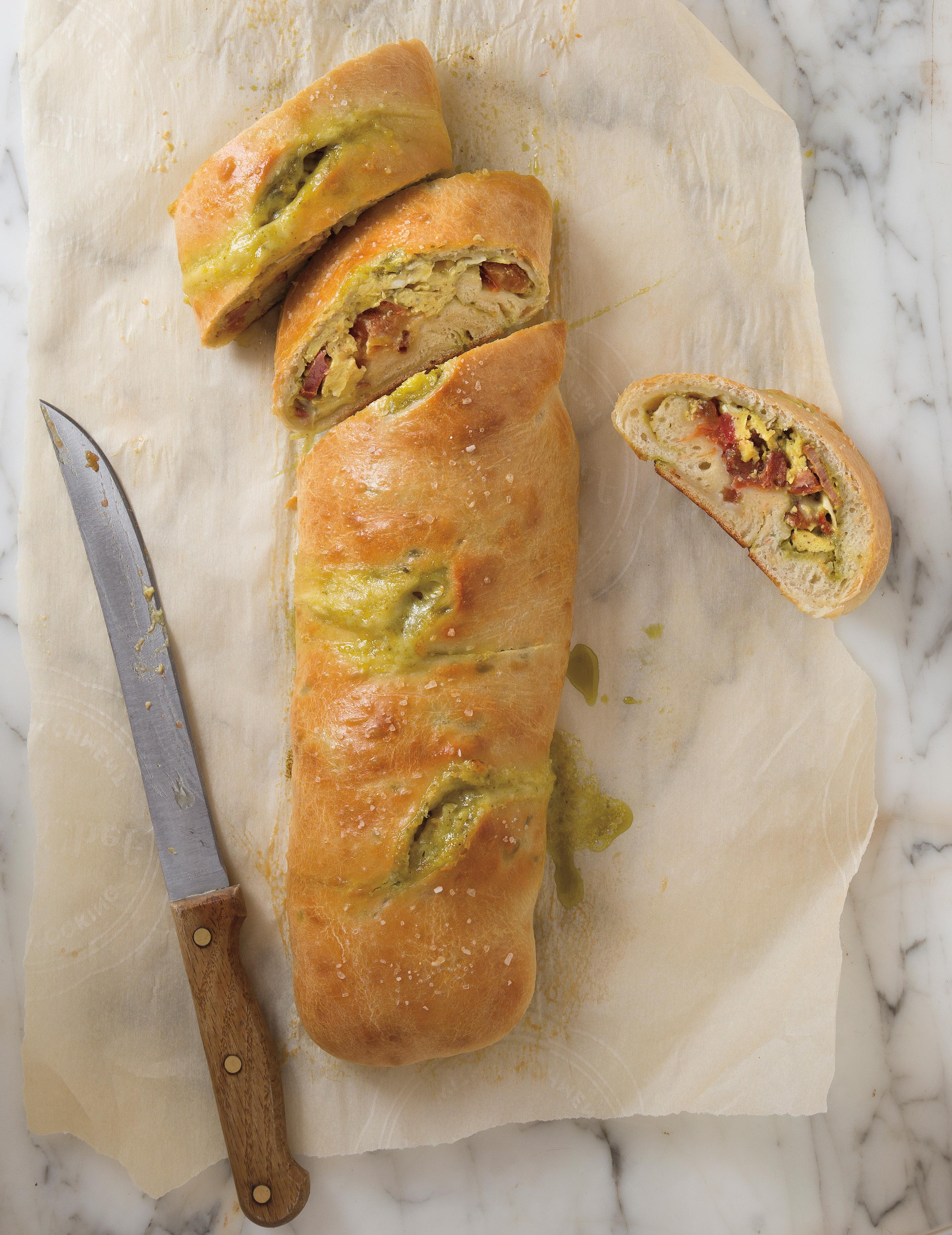

TBy Chef Brian Henry Food Editor
henever the seasons change so do our eating habits and as summer shadows grow longer it won’t be long until everything smells and tastes like pumpkin pie spice. As the outdoors begin to cool down its time to heat things up in the kitchen with braises, roasts and stews.
Now before you get too cozy in your plaid and flannels I’m going to take you out of your comfort zone by introducing you to my favourite braise – Curry Goat. Mere mention of goat meat can cause reflux in some while others succumb to images of He-Goats at the Witches’ Sabbath. A bit of useless knowledge to impress your dinner guests with is that goat meat is the most consumed red meat in the world and goats were domesticated over 12,000 years ago right after dogs.
Goat meat has a reputation for being tough in texture with a strong, gamey flavour but breeding, feeding and harvesting practices have changed greatly over the years and today’s menus see goat meat being served in a variety of ways which include braising, stewing, grilling, roasting and consumed raw similar to beef in tartar and Carpaccio.
3 lb. Goat Meat cut into bite sized pieces
2 tbsp. cider vinegar
6 whole allspice berries
½ tsp. thyme leaves
1 ½ cups diced yellow onion
2 cloves Garlic minced
1 Scotch Bonnet pepper, seeded and minced (optional)
2-3 tbsp. Curry in a Hurry (from The Spice Co.)
2 tbsp. Canola oil
2 cups potato cut into bite size pieces
Salt and pepper to taste
1. In a non-reactive metal bowl combine together the vinegar with the allspice, thyme, onion, garlic, and Scotch bonnet pepper. Toss the goat meat in the vinegar mixture and let it marinate, covered in the refrigerator for 2-4 hours.
2. In a deep saucepan or large cast iron skillet heat the oil with the Curry in a Hurry over med-high heat, stirring frequently until it becomes fragrant. Add the goat meat to the pan. Stir the meat while its cooking until it begins to brown. 3-5 minutes.
3. Reduce the heat to medium- low setting and stir in 3 cups of water. Cover the pot and let it simmer for 30 minutes. Add the potatoes and let the mixture simmer for another 20-30 minutes until both the meat and potatoes soften. Serve immediately with fresh bread. Serves 6-8 people.



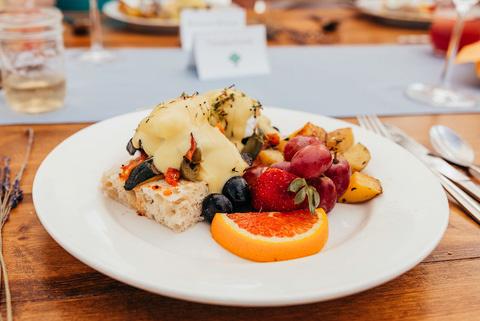


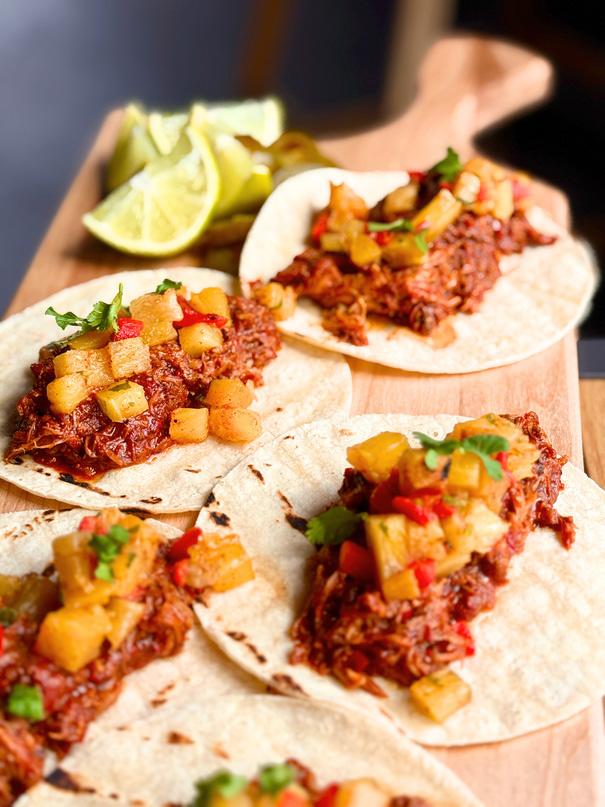





By Chef Brian Henry
I have prepared thousands of turkey dinners over my career. By the time my Thanksgiving dinner was served this year I was repulsed by turkey, by the time Christmas dinner arrives I’ll begin to develop a twitch in my left eye. The smell of turkey bones being simmered down into mud colored stock to create an entire week’s worth of turkey noodle-a la king-lasagna-soup is bordering on postal-worker retaliation a la chef.
Many of us look forward to getting together with family over the holidays. Once the elation ha s worn off and we settle into our surroundings the fights will begin. My family seems to do battle over the rules of board games with Monopoly being the most heated and contentious of all. I often wonder why Monopoly was never released in a contact sport edition.
Food is another hot topic which, if nothing more the question of white or dark meat, is an opener for at least one person to deliver a long-winded opinion on the topic. My favourite way to prepare turkey is to soak it in brine before cooking it no matter what final cooking process you choose; roasting, smoking, deep frying or barbecuing. The brining process forces water into the muscle tissues of the meat through diffusion and osmosis causing the muscle tissues to swell and hold more water. Any spices, herbs or other flavourings you add to the brine solution will get taken deep into the meat with the water.
Thaw out your turkey in the fridge.To avoid cross-contamination place turkey in a drip tray on the bottom shelf to thaw.
Turkey requires 4½ hrs/lb or (10 hours/kg) to thaw under refrigerated conditions. The average turkey weighs in at 15 pounds. Let me do the math for you, an average sized turkey will need 67 hours to thaw or 2.8 days.
Always wash your hands thoroughly before and after handling poultry, or any raw meat.
Thoroughly wash all utensils, cutting boards, counters and dish cloths that have been in direct contact with raw poultry and its juices.
1. Mix together one gallon of water
3 /4 cup kosher salt, do not use iodized table salt
1/2 cup of white sugar
1/4 cup brown sugar
2 sliced cooking onions
6-8 cloves of crushed garlic
2-4 tbsp. of herbs and or spices like rosemary, thyme sage.
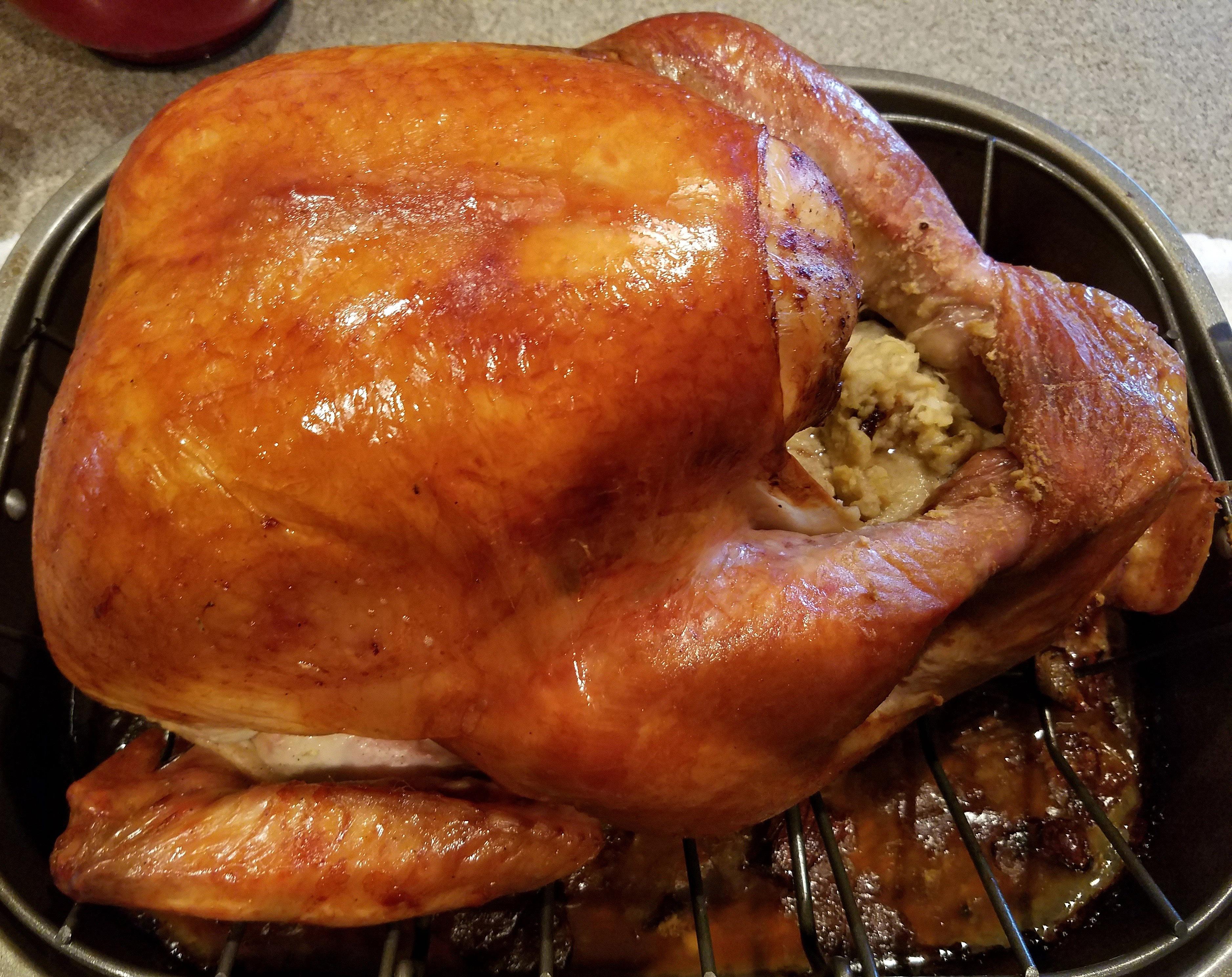
2. And any other flavours you might want. DO NOT use an acid like wine, apple juice, beer, orange juice as these will have an adverse effect on poultry.
3. Let the turkey soak, refrigerated, submerged in the brine, for 12-18 hours.
4. Remove turkey from the brine solution. Discard brine solution.
5. Rinse the turkey off under cold running water and pat dry.
6. Proceed to cook your turkey at 300°f for 3-4 hours or until the internal temperature of the thickest part of the thigh reaches 85°C/185°f or higher. If you can, remove the turkey when it has an internal temperature of 175°f. Take this temperature in the thigh. Let it rest loosely covered with foil or a clean kitchen towel so that the internal temperature will cause carry over cooking to raise the temp to the 185°f range.
7. Prepare your stuffing separately in its own container in the oven, as a stuffed bird takes longer to cook and can have uneven internal temperatures which can cause food poisoning.

ABy
rmadillo eggs, a culinary delight with a misleading name, are a far cry from actual armadillo offspring. These savory treats are more akin to Scotch eggs, featuring a seasoned sausage exterior encasing a molten core of cheese curd and jalapeno.
4 Italian sausages (purchased locally)
2 large jalapenos
Cheese curd (we use Empire Cheese)
Rib Rub (we use Sandy Flat Sugar Bush)
BBQ Sauce
1. Remove the sausage from the casings and mix into 2 equal balls.
2. Cut the top off the jalapenos at the stem end.
3. Use the handle of a spoon to core out the jalapeno and remove the membrane and seeds.
4. Stuff the jalapeno with small pieces of cheese curd.
5. Press each jalapeno into the sausage balls. Form the sausage balls into an egg shape with the jalapeno in the centre. Ensure the jalapeno is covered by equal sausage.
6. Sprinkle each egg with rib rub or your favorite BBQ seasoning.
7. Place the eggs on the grill or smoker at 275 degrees F.
8. Cook until the sausage reaches an internal temperature of 165 degrees F.
9. Add BBQ sauce toward the end and serve.
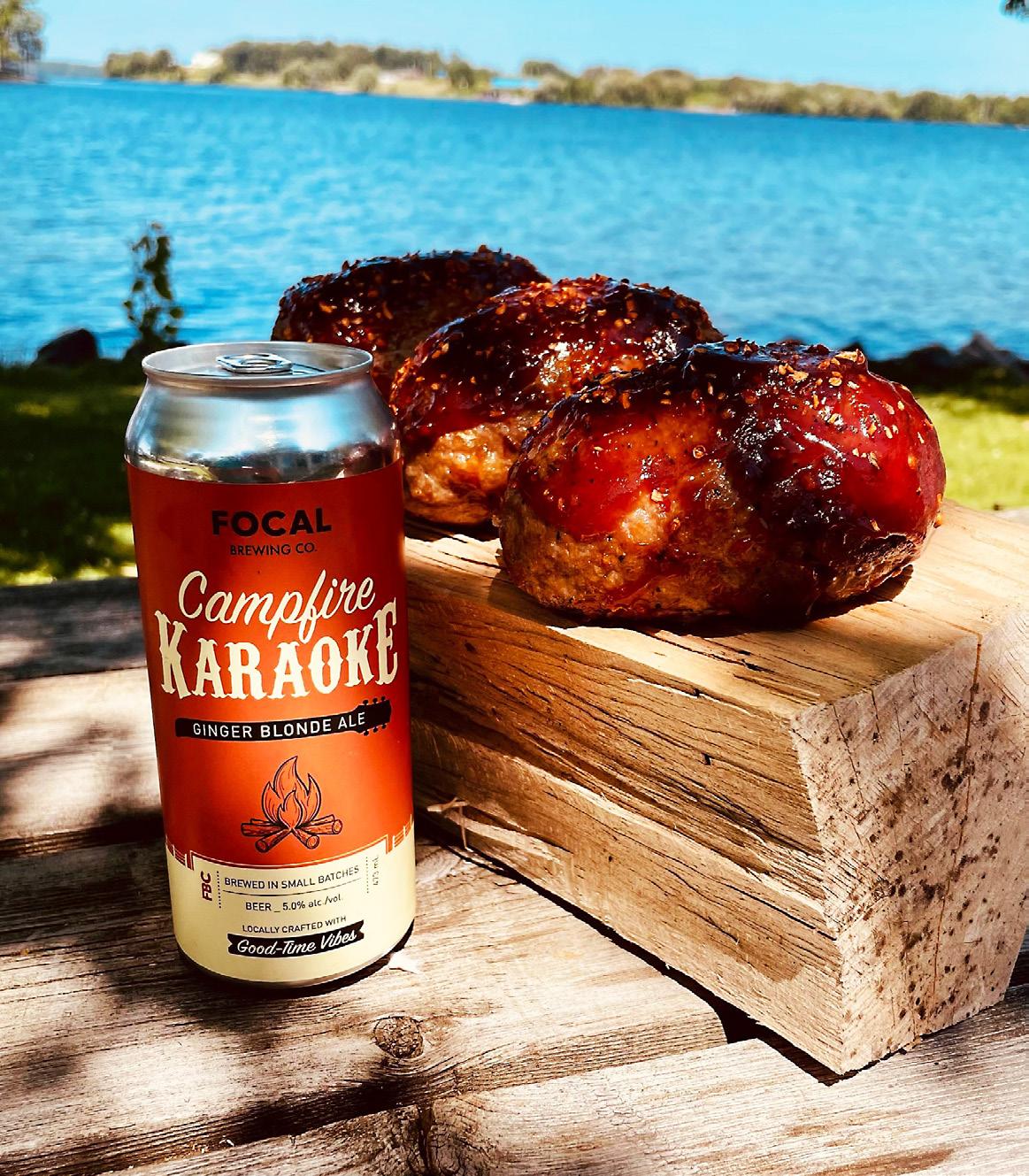



By Carol Turner @carolturner9319
Elegant enough for entertaining but easy to prepare for weeknight dinners, this family favourite has been on rotation in our household for over 30 years. Walnuts or almonds can be substituted for the pecans. Serves 4.
2 large leeks (white and light green parts only) washed well, split lengthwise and cut in 2 inch pieces
3 tablespoons unsalted butter
Salt and Pepper
3 tablespoons 35% cream plus 2/3 cup for sauce
1 tablespoon white wine (or water)
4 large boneless, skinless chicken breasts
2 teaspoons olive oil
1/4 cup chicken stock
1/2 cup chopped pecans, toasted
1. Melt butter over medium-low heat, add leeks and sauté until beginning to soften (do not brown) Roughly 15 minutes.
2. Add 3 tablespoons cream, wine, 1/4 teaspoon salt and 1/4 teaspoon pepper. Lower heat and continue to cook until leeks are soft and liquid has evaporated, stirring frequently. Roughly 5 minutes.
3. Remove from heat, cover and refrigerate at least 1 hour or overnight.
4. Preheat oven to 400 degrees F.
5. Pound each chicken breast to 1/4 inch thickness and season generously with salt and pepper.
6. Spread one rounded tablespoon of leek mixture on each breast, roll up tightly (jelly roll fashion) and secure with string or toothpicks. Reserve extra leek mixture for sauce.
7. Brush chicken lightly with oil and arrange seam side down in an ovenproof skillet. Bake until lightly brown and just firm when pressed (25 minutes).
8. Transfer chicken to platter, remove string or toothpicks and cover with foil. Do not wash skillet.
9. Add 2/3 cup cream, chicken stock and remainder of leek mixture to skillet and simmer until reduced to 2/3 cup.
10. Stir in toasted pecans, taste sauce and season with additional salt and pepper if necessary.

For more delicious recipes, follow Carol Turner on Instagram @carolturner9319





HBy Chef Brian Henry
Editor
osting backyard barbecues is a great way to bring people together outdoors in the summer. Hosting these gatherings can also break the bank with today’s out of control food prices. If you cook like a buffet chef you won’t have to sacrifice flavor or refinance the house. This means setting up a food line that goes from the cheapest items to the most expensive so that guests load their plates with the less expensive goods leaving less room for higher priced items. Also forgo the massive plates, step it down a size and maybe you will enjoy some leftovers by generating less waste at the same time.
Premium cuts of protein are the most expensive part of any meal, so forgo the expensive cuts and utilize sirloin, ground beef cut with ground pork, brisket, or flank steak or steer away from red meats and go with bone in cuts of chicken like legs or thighs. When grilling meats you might want to try cooking whole cuts and cutting the meat into strips, giving people the option to eat as much or as little as they want.
Load up your barbecue buffet with grilled vegetables like thick-cut cauliflower oiled and dusted with some Curry in a Hurry, or eggplant steaks with grilled tomatoes, zucchini, and peppers seasoned with our Italian Scallion seasoning. A hearty potato salad seasoned with a bit of our Kick Ass Cajun seasoning will help fill up your guests. Also drop the buns from your shopping list as people tend to take a larger helping of ingredients to fill a bun for a sandwich, but they can’t fit that much into a small sized tortilla.
Chimichurri is an all-time favorite and what makes Argentine barbecue stand apart from all other barbecue styles is that it’s inexpensive to make and can be refrigerated for a few days.
This Argentinian condiment is a simple concoction made from parsley, oregano, and garlic infused into oil and vinegar. Some versions add hot pepper, cilantro, basil or onion. The amount of each ingredient varies depending on personal taste.
The origins of Chimichurri are as varied as the recipes to make it which is strong enough to be served with beef but delicate enough to be savored with vegetables or simply enjoyed by dipping some bread in it.
INGREDIENTS:
1 bunch flat leaf parsley
6 cloves garlic, minced
½ cup canola oil
1⁄4 cup red wine vinegar
1 tsp. lemon juice
METHOD:
1 tablespoon diced red onion
1 teaspoon dried oregano
¼ - ½ tsp. cayenne or chipotle pepper (optional)
1 tsp. fresh cracked black pepper
1⁄2 teaspoon salt
Roughly chop all the ingredients and combine in a bowl. You can chop it all by hand for a chunky final result or pulse it in a blender but do not make it a puree. Let it sit for a few hours in the fridge before serving.
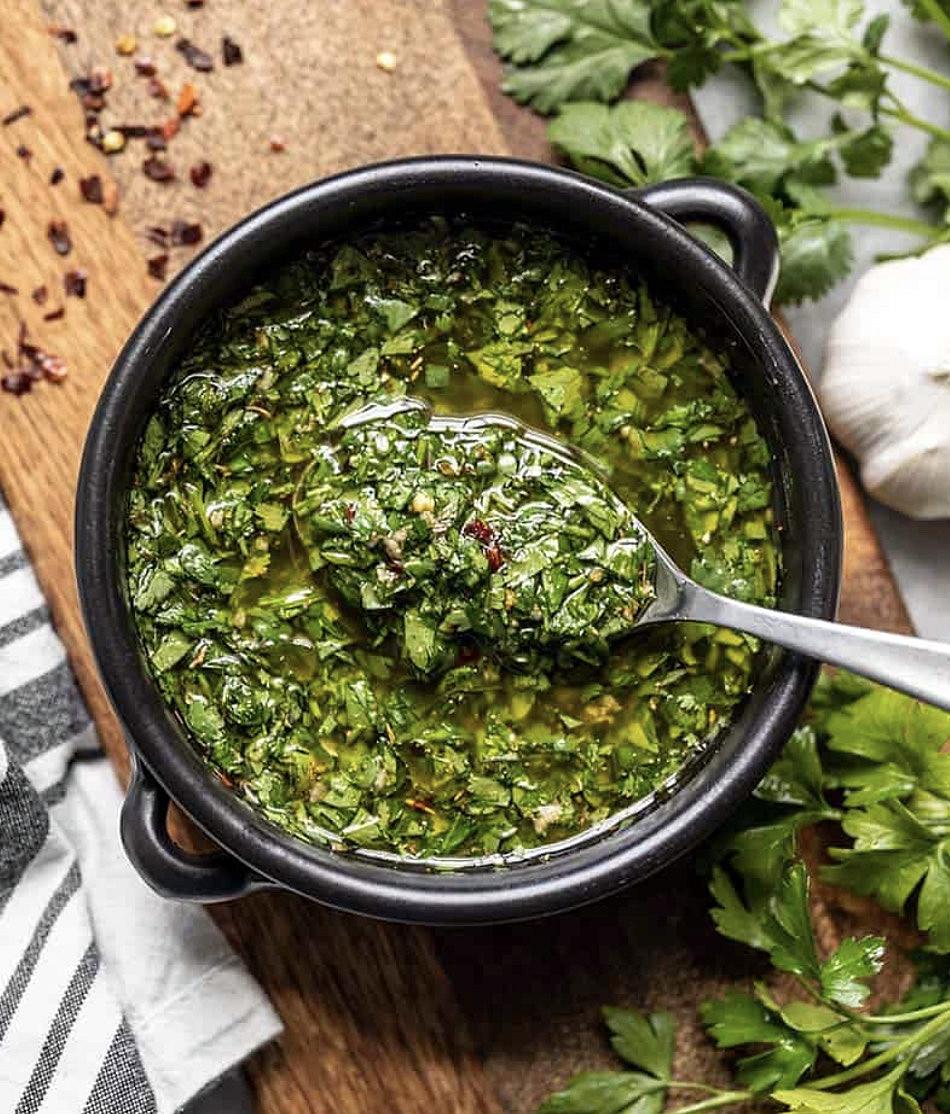


TBy Carol Turner @carolturner9319
he advantages to cooking pizza on the grill are it not only keeps your oven off and your kitchen cool on hot summer days but produces the crispiest most flavourful pizza ever! This vegetarian pizza recipe utilizes fresh summer produce but feel free to use any meat, vegetables and cheese you prefer. Just remember to keep your toppings light as the perfectly grilled crust is the star of the show. Serves 4.
1 pizza dough at room temperature (freshly prepared or store bought) divided into 4 portions
1 package Boursin cheese (basil & chive or garlic & fine herbs) at room temperature
2 cups grated Mozzarella cheese
1 red onion sliced in 1/4 inch rounds, grilled
2 medium zucchini sliced diagonally in 1/4 inch pieces, grilled
1 medium eggplant sliced in 1/4 inch rounds, grilled (optional)
3 fresh Heirloom tomatoes thinly sliced (or tomatoes from your garden!)
5 oz plain goat cheese, crumbled handful of fresh herbs of your choice (I use basil, parsley and oregano)
1. Heat grill to 425 F (medium-high heat) then lightly oil or spray with Pam Grilling. If possible set up for two-zone grilling (direct and indirect heat)
2. Stretch or roll dough into desired size (I like oblong) and thickness on a floured work surface then place on floured baking sheets.
3. Brush lightly with olive oil.
4. Place pizza dough, one or two at a time, on hottest part of the grill and cook until bottom is lightly browned (2-3 minutes) Flip and cook the other side for roughly 45 seconds.
5. Transfer to baking sheet with less cooked side up and let cool slightly.
6. Spread 1/4 package of Boursin cheese over each pizza leaving a 1/2 inch border.
7. Sprinkle 1/2 cup grated Mozzarella cheese over Boursin then top with grilled vegetables and thinly sliced tomatoes.
8. Return pizzas to cooler part of grill and cook until the cheese has melted and the bottoms are crisp and golden brown, about 3-5 minutes.
9. Removed from grill and top with crumbled goat cheese and fresh herbs.
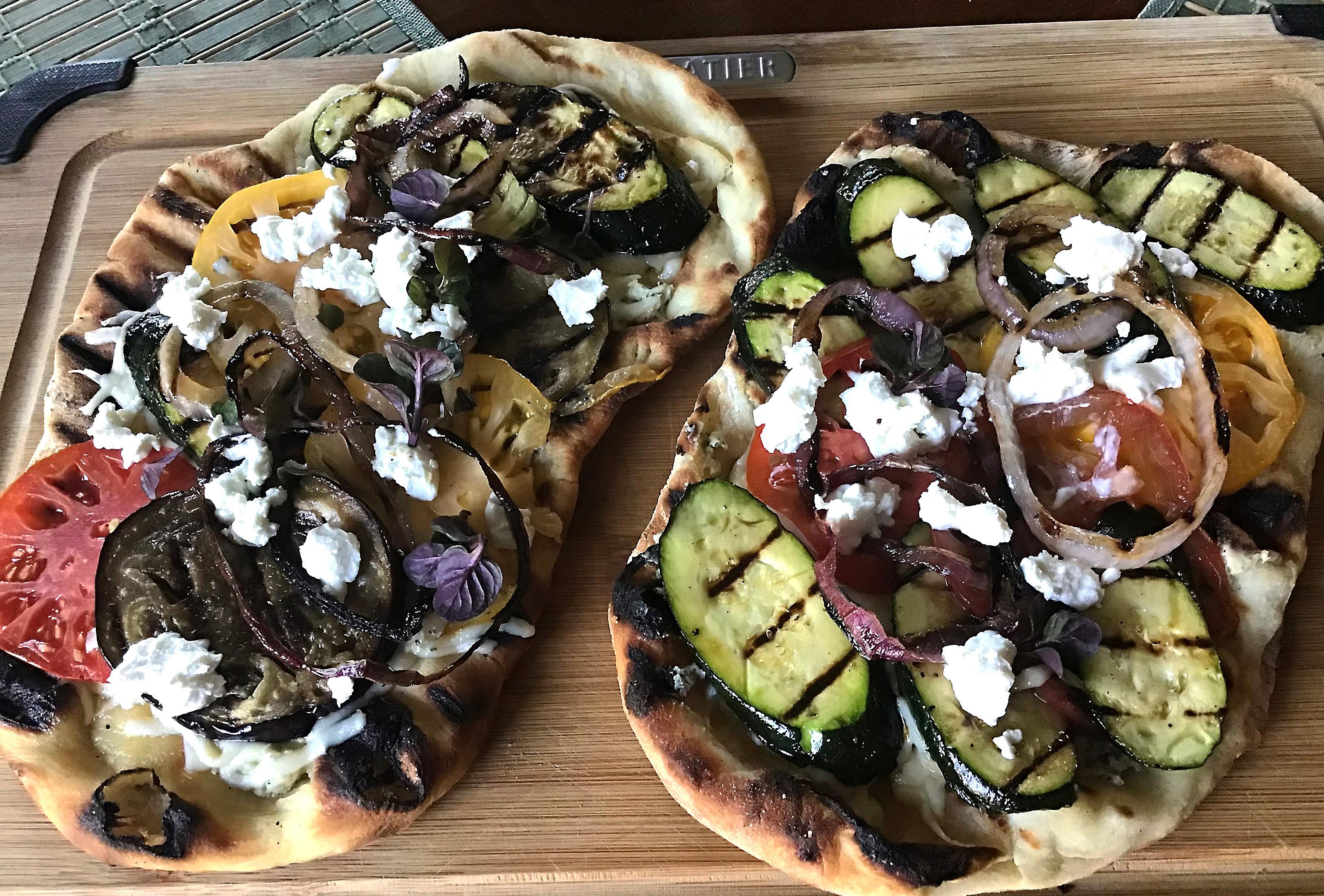


N
By Carol Turner @carolturner9319
othing says spring like the first BBQ of the season! Tender grilled lamb loin, generously seasoned with (The Spice Co.) Plate O’S Greek Seasoning, paired with a colourful vegetable salad makes for a fast and flavourful meal. Serve with your favourite red or white wine (or beverage of choice!). Serves 4.
2 Lbs trimmed lamb loin chops
2 TBSP Olive Oil (plus 1/4 Cup for basting while on the grill)
3 TBSP (The Spice Co.) Plate O’s Greek Seasoning *
4 ripe tomatoes, chopped
1 English cucumber, chopped
1 Yellow pepper, chopped
1 Small red onion, chopped
2 Ripe avocados, chopped just before serving
1/3 C Kalamata olives (pitted or whole)
1/3 C cubed Feta cheese
3 TBSP red wine vinegar
1/2 clove garlic, finely chopped
1/4 TSP lemon zest
1 TSP honey
1 TSP dried oregano
1/4 TSP Dijon mustard
1/4 TSP each, salt and pepper
Fresh oregano and lemon slices
1. Brush lamb chops with olive oil and season with Plate O’s Appetitive Greek Seasoning (The Spice Co). Refrigerate until ready to grill. Remove from refrigerator 30 minutes before grilling to bring to room temperature.
2. Combine all salad ingredients except avocado and feta cheese. Refrigerate.
3. Prepare vinaigrette by whisking all ingredients except olive oil in a large bowl. While continuing to whisk, slowly add olive oil until emulsified. Taste and adjust seasonings if necessary. Set aside.
4. Set grill to high direct heat and lightly oil grate. Grill chops until medium-rare, roughly 3-4 minutes per side. Baste with olive oil once or twice. Remove from heat and let rest 5 minutes.
5. While lamb is resting - add vinaigrette, chopped avocado and feta to salad and gently toss.
6. Serve lamb and salad on individual plates and garnish with fresh oregano and lemon slices.
*Plate O’s Greek Seasoning can be purchased at www.thespiceco.ca
Follow Carol on Instagram @carolturner9319
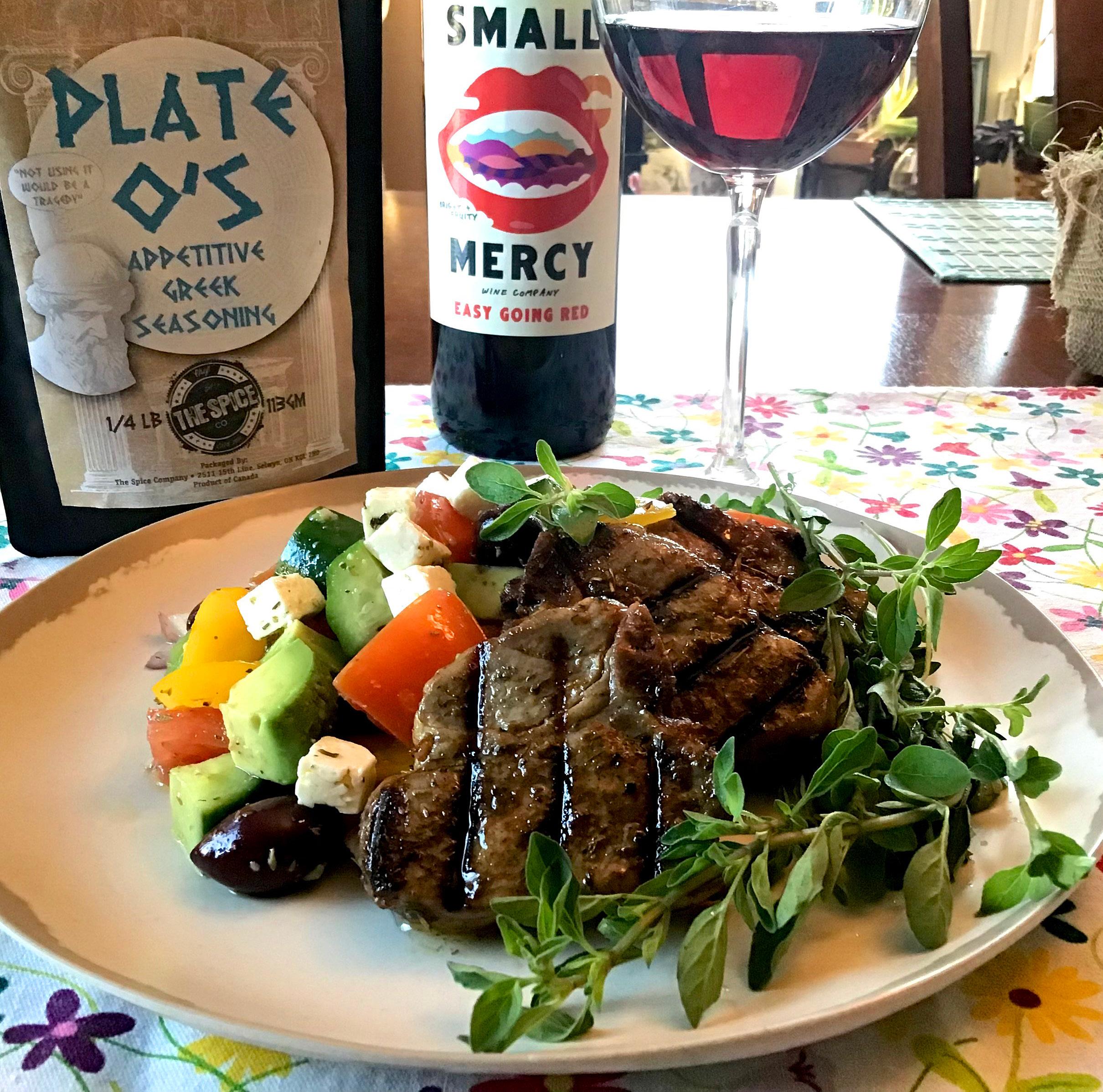


ABy Chef Brian Henry
Editor
s the seasons change so does our attitudes and behaviors. Cooler weather will see many digging out crock pots, Instapots and other kitchen gadgets du jour but that does not mean that our outdoor kitchens are closed.
Autumn is the season of spices, with many going down the pumpkin spice rabbit hole. Aromatic spices are very soothing with their warm rich scents and which are easily added into your fall grilling and barbecuing. Seasonal menus can include grilled pumpkin, sweet potatoes or try using pumpkin beer as a marinade.
The following recipe can be cooked on a gas grill but is best prepared in a wood or charcoal fired barbeque allowing you to cook S’mores over the coals for dessert.
1 whole chicken
1 cooking onion cut in half
1 lemon cut in half
1 bulb of garlic, top sliced off
1 – 2 tbsp. Curry in a Hurry (The Spice Co.)
¼ cup butter, softened kosher salt
freshly cracked black pepper
2 cups chicken stock
METHOD:
The night before cooking the chicken, remove any giblets and the neck and pat the chicken dry with paper towels. Place the chicken in a large glass bowl or baking dish before setting it in the fridge overnight, uncovered as it will dry out the chicken skin so that it cooks up extra crispy. Just make sure that the raw chicken is placed so that no other foods will come in contact with it as to avoid cross-contamination. The bottom shelf of your fridge is best for this.
Get your charcoal or wood lit so that you can get your coals well set and your barbecue up to 450°f and maintain this temperature for cooking. While your fire is sorting itself out, remove the chicken from the fridge and place it, breast side up, in a wire rack lined roast pan. The roasting pan will be pretty black after cooking so use a designated barbecue pan or a recyclable foil pan.
Stuff the carcass with the onion, lemon and garlic.Tie the legs loosely together with kitchen twine and tuck the wings under the chicken so that they do not burn.

Stir together butter and Curry in a Hurry. Liberally rub the chicken all over with the curry butter. Lightly season the chicken with salt, pepper and a bit of curry powder. Pour chicken stock in the bottom of the roasting pan.
Place the roasting pan in the barbecue and cook the chicken for 1 -1 1/2 hours with the lid closed, checking the bird every 20 minutes. Baste chicken with the juices in the bottom of the pan. Halfway through cook time, rotate the roasting pan and add more stock to the bottom of the pan if needed.
After one hour, check the internal temperature of the chicken in the thigh. It should reach 180 degrees F.
Once the chicken is cooked, let it rest for 15 minutes before slicing. Use the pan juices as a sauce or thicken them for gravy.

ABy Chef Brian Henry Food Editor
side from everything being served up with pumpkin spice, autumn is my favourite time of year. The cooler days, longer shadows, the cavalcade of colours and of course the sound of gunfire in the distance.
As a kid I never understood why my father would travel to northern Ontario every year to go deer hunting. Besides the time spent “in camp” with his buddies, I just never figured out why anyone would expend so much energy on bringing home venison and forcing others to eat it. I feared having to choke down dinner when venison was served, all covered with an unpalatable pile of fried onions to cover up its gamey flavour and cooked beyond recognition in an attempt to make it tender or ground up into sausage with bacon to compensate for venison’s exceptionally lean characteristics.
Now that I have an understanding of foods, I appreciate venison and how to properly prepare it. Of all the big game meats, the most extreme variation in flavour occurs in venison. Depending on the species, age, how and where the animal is harvested from all influence its flavour. Deer that graze in farmers fields on corn and apples tend to have a more mellow flavour opposed to those that grow up eating twigs, bark and cedar as they tend to taste like twigs, bark and cedar. Hunters give away venison like gardeners hand out zucchini. If you have a hunter friend ask them for some ground venison and give it a try in the following recipe.
2 cups Napa cabbage shredded
1tsp salt
1 lb ground venison, or pork
4 green onions minced
2 cloves garlic minced
1 egg beaten
1tbsp ginger grated
1 tbsp soy sauce
1 tsp sesame oil
¼ tsp pepper
In a medium sized bowl toss together the cabbage with the salt. Allow the cabbage to rest for 20 minutes. Squeeze the excess liquid out of the cabbage, allowing it to remain moist but not wet. In a large bowl combine the cabbage with remaining ingredients. Mix the ingredients together by hand. This yields enough filling for 5 dozen dumplings.

DUMPLINGS:
2 packages of Chinese dumpling wrappers
¼ cup cornstarch
1 cup of water
DIRECTIONS:
Lightly dust a baking sheet with the cornstarch. Using your finger, wet the edge of the wrapper with water. Place 2 tsp. of the filling in the centre, fold the wrapper over and pinch the edges together. Pleat the edge by pinching the wrapper a few times around its edge. Stand the finished dumplings on the dusted baking sheet. Cover with a tea towel.
Dumplings can be stored covered in the refrigerator for up to six hours. You may choose to freeze the dumplings uncovered on a tray, once frozen transfer them to an airtight container and store frozen for up to three months.
The dumplings may be cooked fresh or from frozen by steaming, boiling or frying. My preference is to fry them. Pre-heat a cast iron or non-stick pan over medium-high heat. Add 3 tbsp of vegetable oil and fill the pan with dumplings but do not allow them to touch. After 2-3 minutes of frying, pour ½ cup of water into pan and cover with a tight fitting lid. Cook covered until dry and all splattering ceases. Remove lid and fry until bottoms are golden brown. Serve with rice vinegar, soy and chilli sauces for dipping.

TBy Carol Turner @carolturner9319
his fall inspired Eggs Benedict is a nice change from the traditional version and can be modified using any fall vegetables you have on hand. It can easily be made vegetarian by omitting the bacon. Serves 4.
8 large eggs
4 toasted English muffins
1 package Hollandaise Sauce, prepared as directed (or your favourite homemade Hollandaise Sauce)
3/4 teaspoon Pumpkin Pie Spice
7 slices chopped side bacon
1 tablespoon olive oil
1/2 red or yellow bell pepper, diced
1 small red onion, chopped
3 cups Acorn or Butternut Squash, peeled and diced in 1/2 in cubes (or pumpkin if you prefer)
1 teaspoon maple syrup
pinch each of ground cinnamon and red chili flakes (optional)
1/4 teaspoon sea salt
1/2 teaspoon finely chopped fresh sage
Sage leaves for garnish


1. Sauté chopped bacon in a large skillet until cooked to your liking then remove from pan and place on absorbent paper towel to drain. Measure out 1 tablespoon bacon fat and reserve. Discard remaining fat and wipe skillet clean.
2. Combine reserved bacon fat and olive oil in pan and cook over medium heat.
3. Add squash, red onion and bell pepper and sauté until vegetables are tender and slightly browned, stirring occasionally. Add maple syrup, sea salt, cinnamon and chili flakes and heat through. Stir in chopped sage and reserved bacon. Remove and keep warm.
4. Bring a large pot of water to a gentle simmer and add a splash of white vinegar. Gently slide 4 eggs into the water and poach for 3-4 minutes (3 for a runny yolk) until whites are cooked.
5. Prepare Hollandaise sauce and add Pumpkin Pie spice, allowing the spice blend to cook in the sauce for a couple of minutes. Keep warm.
6. To serve, place two toasted English Muffin halves on each plate and top with a generous spoonful of bacon/vegetable hash. Place poached eggs on top of the vegetables then drizzle with spiced Hollandaise.
7. Garnish with fresh sage leaves.
8. Repeat process for 2nd two servings.

TBy Chef Connie Powers Rude Awaking TV
walk through the Bobcaygeon Farmer’s Market and a trip to Three Forks Farm reminds us that fall is here and brings a glorious harvest of food. Elicia and Jarrod Chinnick are busy preparing for the October 7th Farm Fest. They will join 9 other farms opening to the public to celebrate fall harvest. To attend the 2023 Farm Fest, go to www.kawarthafarmfest.com.
For the Filling
2 tbsp unsalted butter
1 medium diced onion
1 bulb diced fennel
1/2 tsp kosher salt
1/2 tsp black pepper
1 apple peeled and diced
4 cloves minced garlic
1 tbsp minced rosemary
2 tsp thyme leaves
1/4 cup white wine
8 oz frozen kale
2 tsp lemon zest
1 tsp lemon juice
For the Pork
3-4 lb center cut pork roast
1 tsp kosher salt
1/2 tsp black pepper
2 tbsp neutral oil
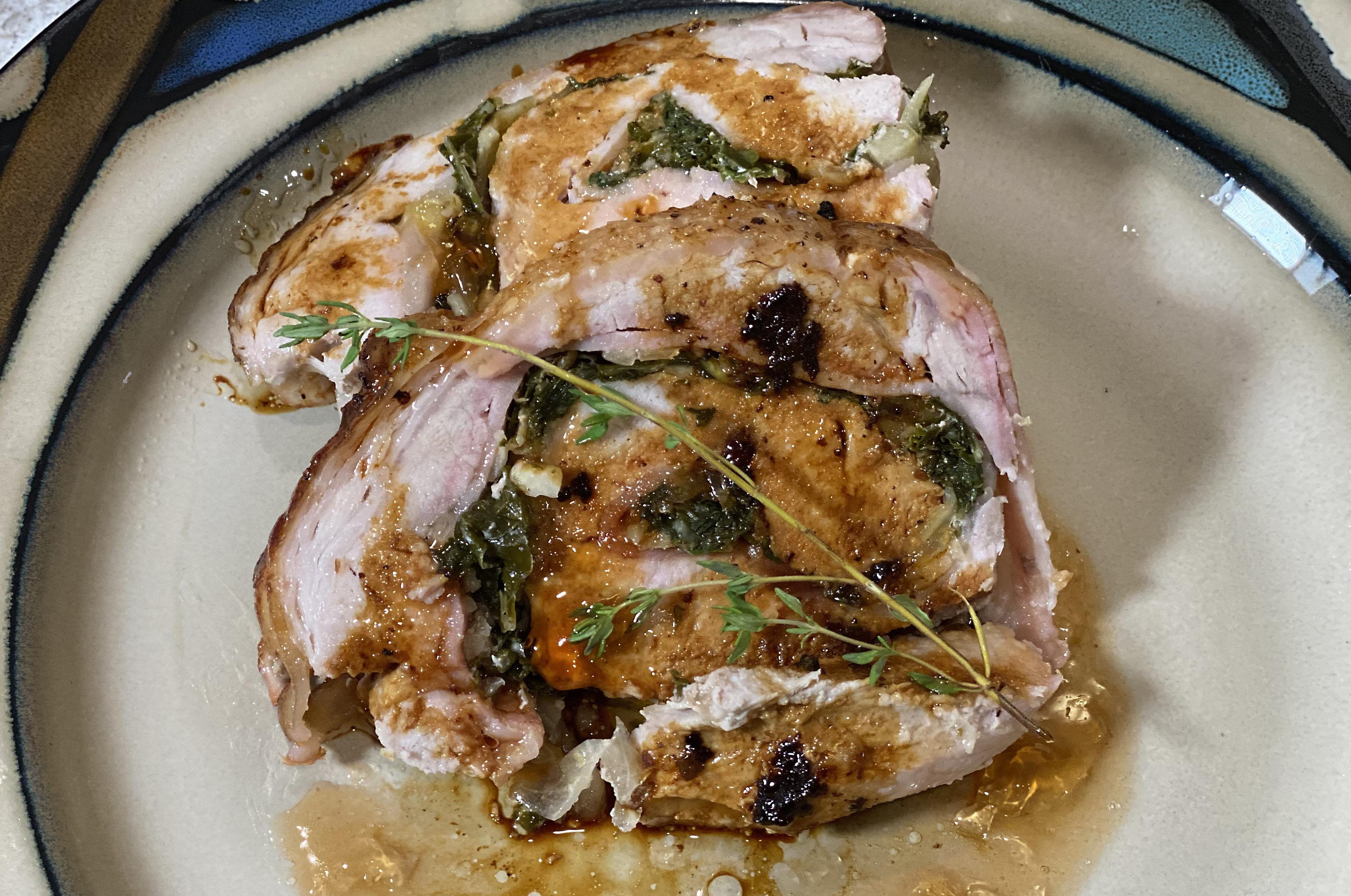
1. Melt butter in a large skillet over medium heat.
2. Add the onion, fennel, salt and pepper. Saute until onion is translucent.
3. Add the garlic, apple, rosemary and thyme. Saute until apple has softened.
4. Pour in the white wine. Bring the wine to a simmer and cook until wine has mostly evaporated.
5. Add the frozen kale and cook until the kale is soft and liquid has cooked off.
1. Preheat oven to 375° F.
2. Butterfly the pork loin. Place the loin vertically on the counter with flat side down. Make a center cut in the middle without cutting through the loin. Leave a 1/2 inch uncut portion so the loin halves hold together. Open the loin like a book. On each side, place the knife at the center and cut each half in half again, opening each like a book. cover with plastic wrap and use a meat pounder to pound the meat to an even layer.
3. Sprinkle the salt and pepper over the butterflied meat. Spread the filling on top.
4. Starting with the short side, roll the meat up like a spiral. Tie each piece with butcher’s twine to create an even roulade.
5. Wipe the skillet out and heat the neutral oil over medium heat. Add the roulade and sear until browned on all sides.
6. Roast the roulade in the preheated oven until it reaches 140°F.
7. Remove the roulade from the oven and let rest for 10-15 minutes to finish cooking.









WBy Chef Brian Henry Food Editor
hen it comes to barbequing pork ribs people are commonly confused with the choice between back ribs and side ribs. Both rib cuts are delicious but contain higher concentrations of connective tissue which can be broken down by using marinades, rubs and extended slow cooking over low heat to create the desired fall off the bone consistency of ribs. Knowing the differences between back and side ribs will help in understanding how to successfully prepare them.
Back ribs, also known as baby back ribs, are cut from the loin closest to the shoulder. They are the bones that remain when the loin meat is removed. Back rib bones are much narrower and rounder than side ribs with meat between and on top of the bones. A rack of back ribs narrows from 6 to 3 inches due to the natural tapering of a pig’s rib cage.
Back ribs are celebrated for their higher meat to bone ratio, lower fat content and overall tenderness compared to the side ribs. These more desired qualities are the reason that back ribs are more expensive than side ribs.
Side ribs, also known as spare ribs, extend down the sides of the animal over the belly and have had the breast bone removed. They are in close proximity to where we get bacon from, and which makes side ribs fattier. Side ribs are heavy, flat, wide bones that are generally 8 to 10 inches in length. Spare ribs contain more bone and fat than meat which is why side ribs are cheaper to purchase than back ribs.
Both back and side ribs will require you to remove its pleura, the thin, translucent membrane that lines the inside of the rib cage. This membrane will prevent flavouring from rubs or marinades from penetrating the meat and will be tough and chewy if not removed prior to cooking. This membrane is easily removed by using a blunt knife like a dinner knife to detach a flap of it from one of the rack of ribs. Grab onto the flap and gently but firmly pull the flap while holding down the rack to rip the pleura away from the ribs in one pull.


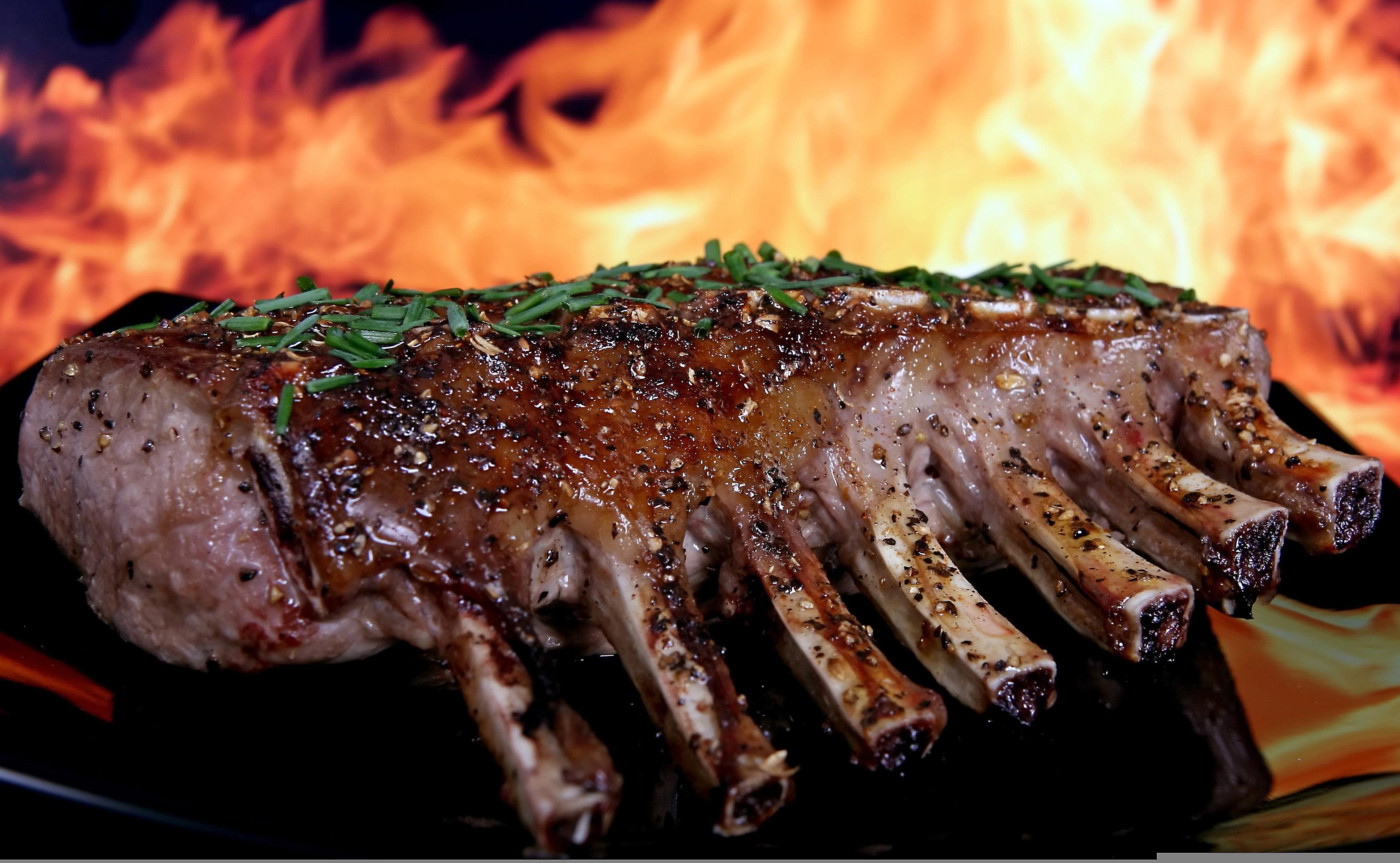
Four pounds of back ribs, pleura removed
Two cups of your favourite grilling sauce
1. Preheat your barbecue to between 225°F- 250°F.
2. Shut down one half of your barbeque and place ribs on the side you shut down so that the ribs are cooked by indirect heat.
3. Close the barbeque lid and keep it closed to maintain a constant temperature between 225°F- 250°F.
4. Turn your ribs every 20 minutes.
5. After an hour baste your ribs every 20 minutes when you flip your ribs over for one more hour for a total cooking time of 2 hours. This process will turn your racks into beautiful mahogany coloured slabs of goodness that will feed four.
6. If you are using a sweet grilling sauce you should only baste the ribs during the last half hour of cooking as the sugar in the sauce will burn.

IBy Chef Brian Henry Food Editor A Taste of the Kawarthas magazine
f the recent south of the border political rhetoric has left a shitty taste in your mouth, the best way to wash it away is with a Caesar - not the salad, but the National Canadian Drink. Hell, make mine a double. Aperitif’s aside, how about some Canadian beef for dinner. You may think I have imbibed a few too many Caesar’s but what would happen if you mixed a Caeser with a roast of beef? Sometimes being Canadian sees us having a bevy or two and doing stupid shit. So why not take this recipe for a rip, bud? The great thing about Canada is that it is great! Canadians are even better, which is why we don’t have to do anything to make it great again. We keep it great by buying Canadian and supporting Canadians. It’s a simple concept and even simpler to do.
I can’t take credit for the Beef & Caesar idea. Greg Traynor (Traynor Farms) shared this with me. Traynor Farms is a sustainable farming business located in Keene, Ontario. There is a Farm Market located on his farm, where you will find his hormone-free beef and seasonal fresh vegetables - all produced on his farm while supporting other local producers with chicken pork and lamb available. Canada, get your pride on with The Great Canadian Caesar BBQ Prime Rib!
2 kg Prime Rib Roast, tied (we use Traynor Farms beef www.traynorfarms.ca)
2 medium onions, diced
4 cloves garlic, minced
2 bay leaves
½ cup Canadian vodka
1. Make a brine by combing the onion, garlic, bay leaves, vodka, Worcestershire, lemon juice and Clamato in a large stainless-steel pot or plastic container. Lay roast in the brine and cover container. Keep refrigerated over night. Turn roast over a few times during brining to ensure even brining.
2. Remove roast from brine and pat dry with paper towels. Place in a large stainless mixing bowl and generously rub all sides of the roast with your favourite Caeser rimmer spice mix. Let the roast stand at room temperature, for an hour or 2.
3. To maximize tenderness and reduce shrinking grill the roast, fat side up, in a pre-heated BBQ at 250-275F over indirect heat. When the roast reaches an internal temperature of 110F, about 2 hours, you then turn the BBQ up to reach a temp of about 400F and continue cooking the roast until it reaches an internal temperature of 135F.
4. Once the roast reaches 135F, pull it off the grill, put it on a plate and loosely cover with aluminum foil and let it rest for 30 minutes while you get the rest of dinner finished.
5. Don’t skip this part! Let the roast rest - if you don’t and cut the prime rib right away, the roast will literally bleed out all of its tasty juiciness. Serve with horseradish mashed potato & vegetables. Feeds 6-8

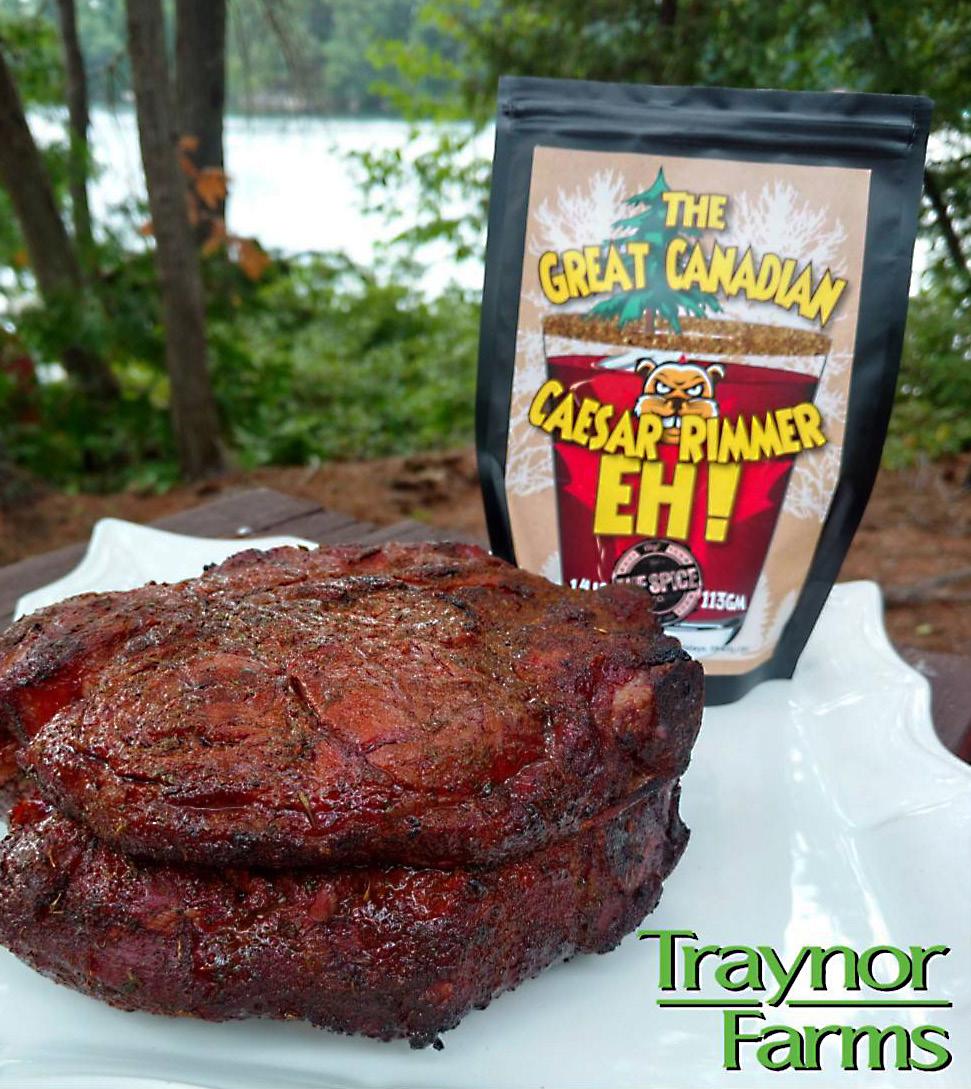


M
By Chef Brian Henry Food Editor
y uncle Mike was a provincial meat inspector and butcher on the kill floor of abattoirs throughout Renfrew County. He was notorious for his witty euphemisms and colloquial language. For example, whenever he saw someone eating a hot dog, he would spew venom at them and say they were eating lips and assholes. Hot dog history began in the 12th century when a German butcher began selling sausages in elongated buns in Frankfurt, Germany which is why “Frank” and “Frankfurter” became the original name for hot dogs. This inspired Austrian butchers to sell “Franks” in Vienna, which is known as “Wien” in German and morphed into the “Wiener”. When the Wiener and Frank came to North America they were often sold at sporting events as “Dachshund Sausages” which got shortened to “Hot Dog”.
Today wieners for the most part contain pork and are at best bland until smothered with your favorite toppings. Franks contain beef and are more strongly seasoned with a more desirable texture. Flavor and texture of Wieners and Franks can be influenced by how they are cooked which can be boiled, grilled, fried, or steamed.
Proper hot dog preparation dictates that one must dress the dog - not the bun by first applying all wet condiments like mustard and then pile the chunky or coarser toppings like onions or sauerkraut.
Sum mer is here, the days are hot and long. If you wish you can make your own hot dogs from scratch using the following recipe or visit one of our local butcher shops and use some of theirs.
1 lb. lean pork, cubed
3/4 lb. lean beef, cubed
1/4 lb. pork fat, cubed
1/4 cup very finely minced onion
1 small clove garlic, finely chopped
1 tsp. sweet paprika
1 tsp. freshly fine ground white pepper
1 egg white
1 1/2 tsp. sugar
1 tsp. salt, or to taste
2 tbsp. water
Puree the onion, garlic, and paprika with the pepper, egg white, sugar, salt and water in a food processor and set aside. Separately grind the pork, beef and fat cubes using a coarse blade. Mix them together and grind them on a fine blade. Stir the seasonings into the meat. Refrigerate the mixture for one hour, and then grind it again. Prepare the casing by cutting 4 - 5 feet of casing and rinse it out with cool running water to remove the salt. Soak the casing for 45 minutes in a bowl of water and 2 tbsp. white vinegar. After soaking, rinse the casing again with cool running water.
Stuff the casings and twist them off into 6 inch lengths.
Parboil the links in simmering water for 15 – 20 minutes before immediately transferring them to an ice water bath.
Once cooled, remove hot dogs from water, dry them and refrigerate until you are ready to grill them up.
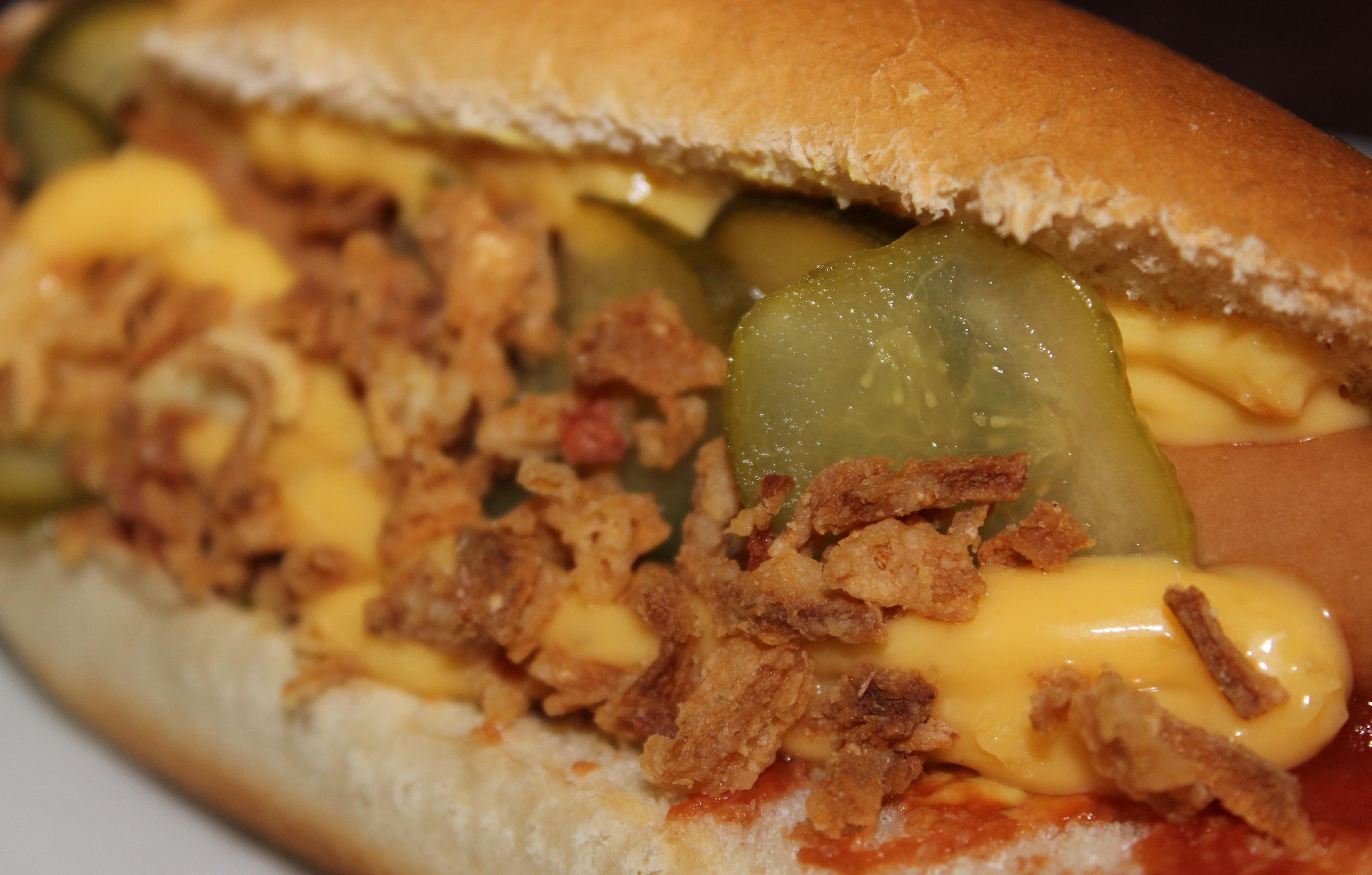


By Carol Turner @carolturner9319
For a change from burgers and hotdogs, you may want to try this rich grilled chicken pasta dish. Bold flavours of Jamaican jerk seasoning and creamy coconut milk come together with fresh veggies and pasta for a uniquely satisfying dish. Try with a cold Red Stripe or your favourite Caribbean inspired cocktail or mocktail! Makes 4 generous servings.
Chicken:
2 boneless skinless chicken breasts
2 tablespoons Jerk Seasoning (I use Spice Co. Reggae Rub)
2 tablespoons olive oil
Sauce:
1 tablespoon butter
1 tablespoon olive oil
1 medium red onion, sliced
1 green pepper, sliced
1 400 ml tin full-fat coconut milk (I prefer Aroy-d brand)
1 cup chicken stock
2 teaspoons jerk seasoning (or to taste)
3/4 cup Black-Eyed Peas
375 g spaghettini
For garnish:
2 green onions, sliced
1/4 cup sweetened toasted coconut fresh thyme
2 limes, halved
Parmesan cheese, sea salt & black pepper
1. Mix together chicken breasts, olive oil and jerk spice & refrigerate minimum 4 hours, preferably overnight or use jerk marinated chicken breasts found at local butcher shops.
2. Remove chicken from refrigerator 30 minutes before preparing. Heat grill and cook chicken breasts, both sides, until cooked through and temperature registers 165 F. Do not overcook! Let chicken rest.
3. Prepare Sauce - Heat butter & olive oil over med/high heat then add red onion and green pepper. Increase heat and stir fry until beginning to soften, roughly 4 minutes. Reduce heat to medium & add jerk spice. Continue to cook, stirring constantly until spice is incorporated into vegetables.
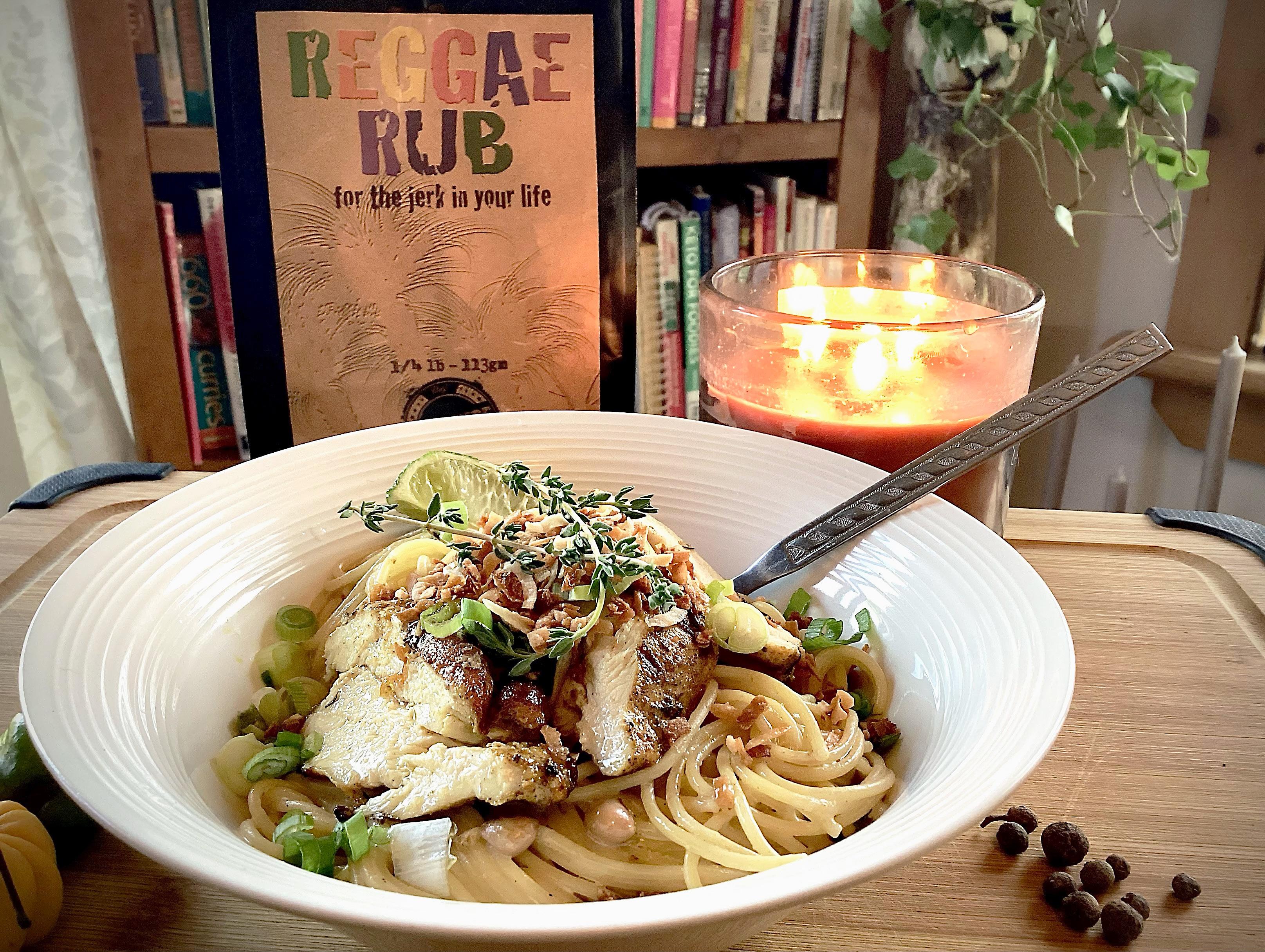
4. Add coconut milk, chicken stock & bring to a gentle boil. Reduce heat and simmer until slightly reduced. Add Black-Eyed Peas and heat through. Taste and season with salt & pepper.
5. Cook spaghettini until al dente, strain & add to sauce. (reserve 1C pasta water to loosen sauce if necessary) Continue to cook until sauce has thickened slightly.
6. Thinly slice chicken breasts and set aside.
7. To serve - divide spaghettini onto 4 plates and top with sliced chicken breasts. Garnish with green onion, toasted coconut, a sprig of fresh thyme and half a lime (lime juice adds a nice burst of freshness to this dish!).
5. Place in preheated oven and bake for 10 minutes until heated through.
6. Sprinkle with Parmesan cheese, sea salt and black pepper if desired. Top with a sprig of fresh tarragon.

Every culture has its traditional ways of barbecuing and grilling meat.

By Chef Brian Henry Food Editor A Taste of the Kawarthas magazine
The Korean words (pronounced Galbi-gui) translates to grilled ribs. As tongues are lazy the world over it usually is shortened to Galbi. For the xenoglossophobists it is simply Korean barbecue a misnomer as Galbi is grilled; by cooking meat quickly over direct, high heat, while barbecuing is a low and slow cooking method using indirect heat and smoke.
Galbi largely defines an assortment of grilled meats in Korean cuisine made with marinated beef or pork short ribs that have been thinly sliced across the bones to allow the marinade to penetrate the meat quickly and further allows for rapid cooking. The secret to great tasting Galbi is to understand the balance of its sweet and savory flavors. Most North American Galbi is sweeter than what you would be served in Korea as it is more appealing to our palates.
The grilling technique for Galbi is the exact opposite of how you would grill a steak or burger as it requires you to be very hands on, constantly turning and moving the meat about the grill allowing the marinade to create a nice even glaze on the meat’s surface without burning the sugars.
Turn your kitchen into a Korean Grill house by making Galbi at home using thinly sliced beef sirloin, tenderloin, pork belly or chicken but I find that the flavours of galbi are best represented when done with beef short ribs that are cooked over a charcoal-based fire. Galbi goes well with many side dishes but is best served with spicy Korean coleslaw and kimchi. Leftover Galbi can be used in a bowl of Bibimbap.
3 pounds beef short ribs or other meat
1/2 cup of lemon juice
1/2 cup lime juice
1/4 cup dark brown sugar
3/4 cup soy sauce
3/4 cup water
¼ cup shao hsing cooking wine or dry sherry
3 tbsp. white vinegar
2 tbsp. white sugar
1 tsp. black pepper
2 tbsp. sesame oil
1/4 cup minced garlic
1/8 cup minced ginger
1/2 large onion, minced
1. In a stainless bowl combine the lemon and lime juice with the meat. Work it over a bit by massaging the juice into the meat using your hands for a few minutes and let it rest for 15 -20 minutes. Transfer meat, laying it out onto a flat surface.
2. Distribute the brown sugar evenly on the meat by sprinkling it on each piece. Allow the meat to sit for 30 minutes.
3. Meanwhile whisk together soy sauce, water, wine, and vinegar in a large, non-metallic bowl. Whisk in, white sugar, pepper, sesame oil, garlic, and onion until the sugar has dissolved. Marinate the meat overnight if you can or at least for a couple of hours.
Preheat your grill to high and grill the meat, keeping it moving and not resting too long on one side.




HBy Carol Turner @carolturner9319
omemade meatloaf is classic winter comfort food - this turkey version is no exception. Sour cream keeps the turkey moist. Sage & orange zest add fresh bright flavour to this easy to prepare weeknight dinner. For a quicker prep, omit the leek and spinach stuffing. Leftovers make for great turkey loaf sandwiches! Serves 8.
3 tablespoons Olive Oil
2 leeks, white part only, cut in half lengthwise and thinly sliced (rinse well!)
8 oz package of washed spinach (stems removed) roughly chopped
1/2 cup bread crumbs
1/4 teaspoon salt, 1/4 teaspoon pepper
1 egg, lightly beaten
2 lbs ground turkey
3/4 cup sour cream (light or full fat) I use 14%
2 eggs
1/2 cup chopped onion
1/2 cup chopped celery
3/4 cup bread crumbs
2 teaspoons orange zest (from one large orange)
1 teaspoon poultry seasoning
2 teaspoons fresh sage, chopped
3/4 teaspoon salt
1 tin whole cranberry sauce
1/2 tin frozen pure orange juice concentrate, thawed
1. Heat olive oil over medium heat in a large sauté pan then add leeks. Cook until softened but not browned. (roughly 12 minutes) Add spinach, salt and pepper and cook until spinach is wilted but still bright green. Remove from heat, transfer to a bowl and let cool.
2. Add beaten egg and bread crumbs. Mix well then set aside. Preheat oven to 350 degrees F.
3. In a large bowl gently combine ground turkey, sour cream, onion, celery, poultry seasoning, sage, breadcrumbs, eggs, orange zest, salt and pepper. (be sure ingredients are well combined but use a gentle hand)
4. Place turkey mixture between 2 sheets of waxed paper and roll into 18 x 8 inch rectangle.
5. Remove top sheet then spread leek and spinach mixture evenly over turkey leaving a 1/2 inch border. (it will be a thin layer)
6. Roll up turkey from short end and transfer to a greased 9 x5 inch loaf pan then place on a cookie sheet.
7. Bake for 1 1/4-1 1/2 hours until internal temperature reads 165 F.
8. Remove from heat, carefully drain any accumulated liquid and cover lightly with foil. Let rest for 15-20 minutes on top of the stove.
9. Meanwhile, combine cranberry sauce and orange juice concentrate in a small saucepan and cook over medium heat until mixture is hot but not boiling.
10. Slice turkey loaf and top with a generous quantity of orange cranberry sauce. Serve with mashed potato and your favourite vegetable. Garnish with fresh sage leaves if desired. Serve hot or cold.



WBy Chef Connie Powers Rude Awaking TV
hen you get a rancher, a butcher, and a chef in the same kitchen, you’re sure to find some awesome eats. Chris Cleary from Cleary Cattle Ranch located in Peterborough, joined me on a blustery Sunday to create a braised short rib on a bed of garlic mashed. The result was delectable.
2 lbs short ribs cut into large pieces
1 tbsp olive oil
1 small yellow onion, chopped
1 large leek, rinced and sliced
2 medium carrots, peeled & chopped
1 cup red wine
1 cup beef stock
Fresh thyme sprigs
2 bay leaves
Kosher salt
Ground black pepper
Minced chives
Mashed potatoes
1. Preheat oven to 350° F. Pat the beef dry with paper towel and season on all sides with salt & pepper.
2. In a large Dutch oven, heat oil at medium-high until shimmering.
3. Brown meat on all sides until golden, 3-4 minutes per side.
4. Transfer to plate.
5. Reduce heat to medium-low and add onions, leeks, and garlic.
6. Sauté until onions and leeks are just tender, about 5 min.
7. Add wine & stock and bring to simmer. Season with salt and pepper.
8. Return the meat to the pan and add carrots, thyme, and bay leaves.
9. Do not fully immerse in liquid! Cover and transfer to oven for 2 ½ hours. Remove lid and cook for 30 – 45 minutes.
10. Remove from oven and skim off and discard top layer of fat.
11. Cover and rest the beef in the juices for at least 45 minutes.


CBy Chef Brian Henry Food Editor A Taste of the Kawarthas magazine
ook Until Bubbly - The singular most feared menu item that I have personally avoided stems from my childhood.
I remember sitting down at the dinner table and spending the next three hours staring down plates of food in utter disgust waiting for my bedtime so as I could be forcibly excused from the table in mutual surrender to the parental battle cry – “you can’t leave the table until you have cleaned up your plate”. I even made-up songs as I sat there pronouncing casserole with a silent “C”. “It’s a casserole not a finger bowl, give me patience, give me strength, to make it to the toilet bowl”. This was at a time when casseroles were celebrating a renaissance and were often made using cans of soup, macaroni and tuna. All recipe instructions ended with the same “Cook until Bubbly”.
The word casserole is a singular word with an endless list of possibilities as to what could exactly end up on your dinner plate and is appropriately described as a cooking vessel or a deep dish pan used for cooking foods in the oven, typically used for preparing one-pot or pan style meals that are either created from fresh ingredients or perfect for managing leftovers like those from the recent holidays feasts and gatherings.
Shepherd’s Pie, lasagna, cassoulet, paella, and pot pies fall into the casserole category which was a. Casserole’s also fall into the comfort food category which are easy to prepare crowd pleasers.
The following recipe for Cheesy Beer and Bacon Casserole makes for a hearty meal or side dish, it is like scalloped potatoes but with some variations. It calls for beer which can be replaced with water, milk, or chicken stock.
2 lb. white potatoes
1 lb. smoked bacon
6 oz. shredded Applewood smoked cheddar cheese
1 bunch green onions, chopped fine
6 large eggs
1 tsp. Kick Ass Cajun Seasoning (The Spice Co)
¼ c. real maple syrup
1/2 c. light beer
1/2 c. whole milk
Butter to grease baking dish
Season with salt and pepper to taste

In a large pot cover the potatoes with cold water and bring to a boil over high heat. Reduce the temperature to allow the potatoes to simmer until tender, about 20 minutes. Drain potatoes and let rest until cool enough to handle.
Cut each potato into quarters, wedges, lengthwise and set aside.
In a large skillet over medium-high heat, cook bacon until semi-crisp, then transfer it to a paper towel lined plate to drain.
In a mixing bowl whisk together the eggs, milk, beer and maple syrup then reserve.
To assemble the casserole, butter the pan or dish. Next layout the potato wedges to cover the bottom, crumble the bacon over the potatoes, and top with the green onions. Carefully pour the beer mixture over the potatoes and bacon.
Top this with the grated cheese and bake in a preheated 350 °f oven and cook until bubbly and the top is golden, about 50 minutes. Let the casserole rest for 15-minutes before serving.

By Carol Turner @carolturner9319
This hearty and comforting dish showcases earthy cremini mushrooms and savoury bacon combined with a creamy rich leek and onion cream sauce. Gnocchi is often a forgotten starch that is both filling and inexpensive. Feel free to substitute your favourite blend of wild mushrooms for the cremini and substitute any pasta shape for the gnocchi if you prefer! Serves 4.
11 lb gnocchi, homemade or store-bought
3 strips bacon, finely chopped
1 tablespoon olive oil
½ medium Spanish onion, thinly sliced
1 small leek, cut in half lengthwise and thinly sliced
1 teaspoon chopped garlic
½ lb sliced cremini mushrooms
½ teaspoon fresh sage, minced, plus whole leaves for garnish
1/3 cup white wine
1 ½ cups chicken stock
¼ cup whipping cream
¼ cup grated Parmesan cheese, plus extra for serving
2 cups tightly packed baby spinach, washed and roughly chopped
1 tablespoon lemon juice
1/8th teaspoon black pepper (or to taste)
½ teaspoon fine sea salt (or to taste)
1. Sauté bacon in a large skillet over medium heat, stirring occasionally, until bacon is crisp and fat has rendered. Remove bacon with slotted spoon and reserve.
2. Remove excess bacon fat from pan, leaving 1 teaspoon in skillet. Add one tablespoon of olive oil.
3. Add Spanish onion, cremini mushrooms and leeks to pan and cook over medium heat, stirring occasionally, until mushrooms are cooked through and onions are translucent. (I like my mushrooms well cooked so this can take up to 20 minutes)
4. Add garlic, salt and pepper and cook another minute until garlic is fragrant.
5. Add wine and cook to slightly reduce, 1-2 minutes.
6. Add stock and cream then bring to a boil. Reduce heat immediately and simmer for 10 minutes until sauce is reduced but still fluid.
7. Add reserved bacon, parmesan cheese, chopped sage, spinach and lemon juice. Cook until spinach is slightly wilted but still bright green.
8. Meanwhile, cook gnocchi in salted water according to package directions. (this will only take a few minutes so have your sauce prepared) Reserve ½ a cup of pasta water.
9. Drain cooked gnocchi and add to sauté pan. Mix well and add reserved pasta water if necessary.
10. Divide gnocchi into four bowls and garnish with extra Parmesan cheese and whole sage leaves.
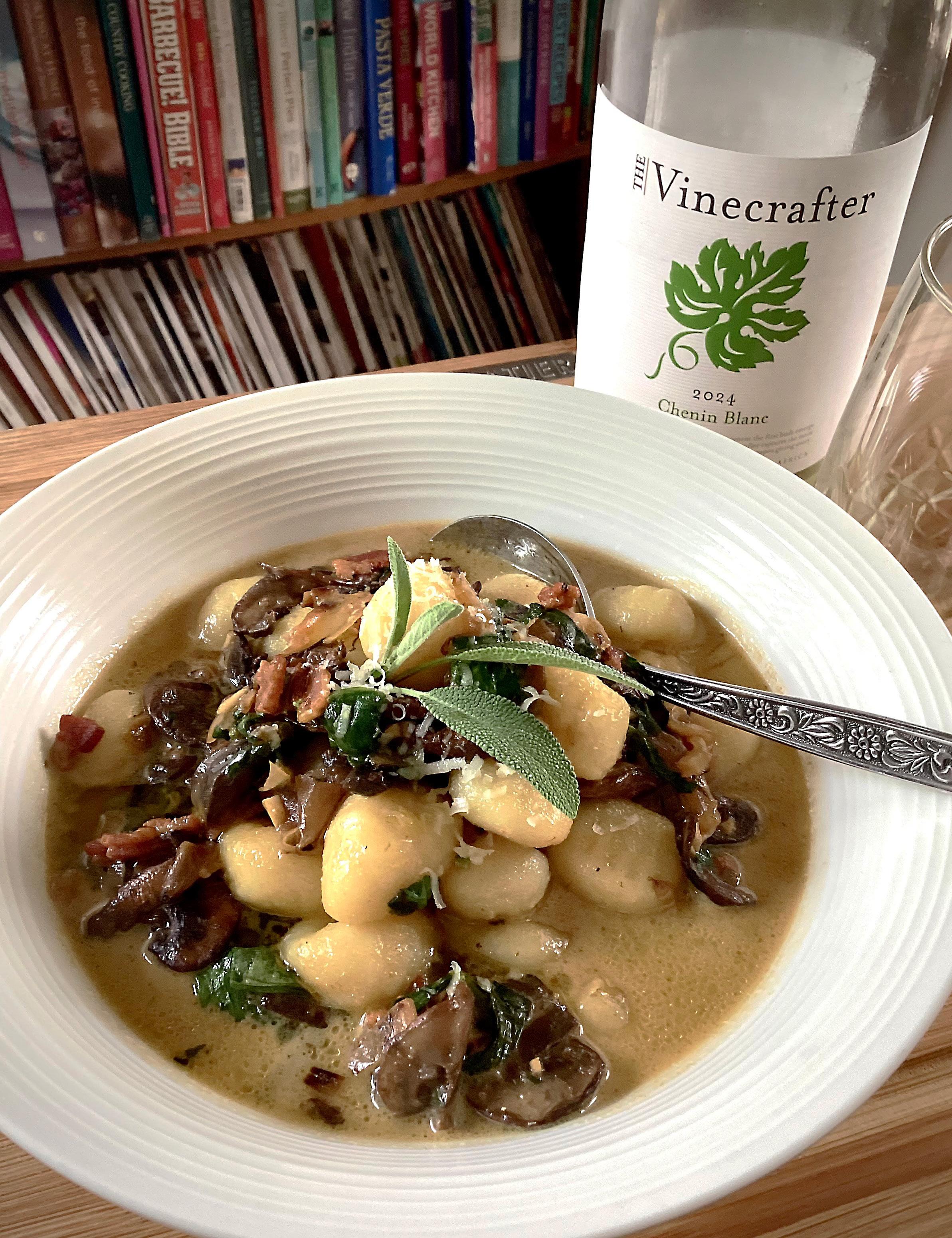




TBy Carol Turner @carolturner9319
hese autumn-inspired risotto balls are a tasty alternative to the popular mozzarella-stuffed risotto balls with Marinara sauce we all know and love. I serve them for lunch or dinner alongside a fresh garden salad but they can be prepared in a smaller size and served as an appetizer or cocktail bite. Leftovers can easily be reheated or pack them for your next fall picnic! Makes 32 pieces
1 medium leek, washed well, halved lengthwise and thinly sliced
1 large shallot, finely chopped
2 tablespoons butter
1 ¼ cups Arborio rice
¼ cup white wine
4 ½ cups chicken or vegetable stock, kept at a simmer
¼ cup Parmesan cheese, finely grated
1 cup aged Cheddar cheese, grated
1/2 cup chopped honey ham (deli meat is fine)
1 large Honey Crisp apple, peeled and roughly chopped
1 teaspoon Apple Spice blend (I use Kawartha Spice Co.) or a mixture of cinnamon, nutmeg, cardamom and ginger
¼ teaspoon dried thyme
1 cup Panko breadcrumbs
Salt and pepper to taste
½ cup vegetable oil
1 ½ cups apple jelly (I use Dora brand) for serving
1. Melt butter in a large pot over medium heat then add leeks and shallots. Sauté until softened but not browned, stirring frequently, roughly 7 minutes.
2. Add Apple Spice and dried thyme. Stir well.
3. Add white wine and continue cooking until most of the wine has evaporated.
4. Add rice and stir until well combined with leeks and shallots.
5. Add warm stock, one ladleful at a time, and continually stir until liquid is absorbed. Continue with the remaining stock until rice is tender but still slightly firm to the bite. Don’t overcook!
6. Lower heat and add Parmesan and Cheddar cheese. Stir well and continue to cook until cheese is melted. Stir in ham, taste, then add fresh black pepper and salt to taste.
7. Remove from heat and let cool completely. I usually prepare a day ahead but it’s not necessary if you cool in the fridge, stirring occasionally to reduce heat quickly.
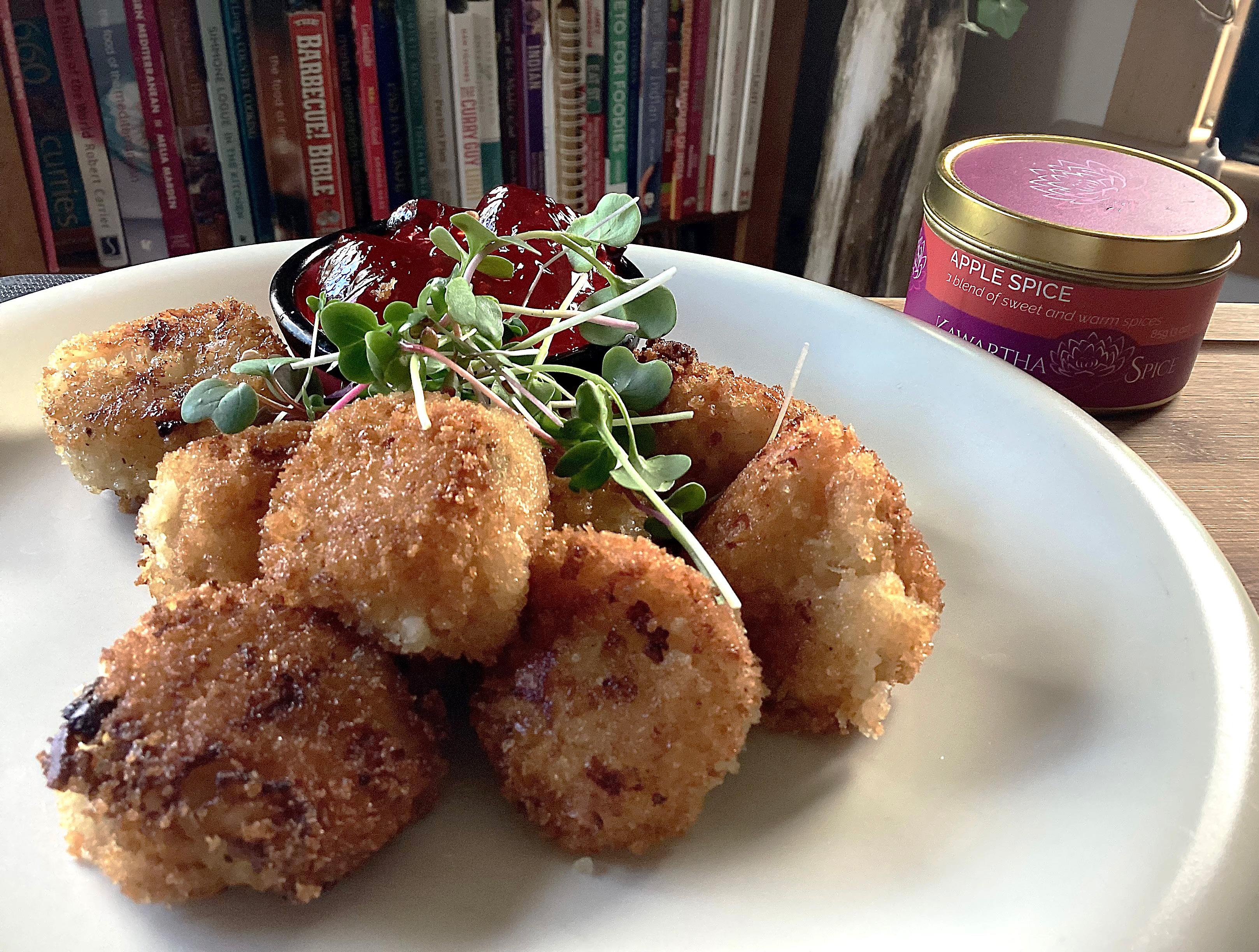
8. Just before you roll the risotto into balls add chopped apple and distribute evenly, either with clean hands or two forks.
9. Roll the risotto into balls, roughly 1 ¼ inches round then coat in Panko crumbs (no need for flour/ egg wash as the mixture will be sticky).
10. Continue rolling until all rice mixture is used. You should have 32 balls but more if prepared smaller for a cocktail bite. Chill for 15 minutes.
11. Heat vegetable oil over medium-high heat and fry balls in batches until golden brown and heated through. You can keep those you have fried warm in a 200 F. oven until ready to serve.
12. Serve warm or at room temperature with apple jelly for dipping.

TBy Carol Turner @carolturner9319
he bold and herbaceous flavours of Green Goddess dressing come together with rich ricotta cheese in this easy to prepare brunch, lunch or appetizer recipe (Try on toasted baguette slices or tossed with your favourite pasta too!) Makes 1 flatbread
2/3 cup flat leaf parsley, roughly chopped
1/2 cup watercress or arugula, stems removed
2 tablespoons chopped fresh tarragon
2 tablespoons chopped green onion
1 clove garlic, minced
2 anchovies, chopped
2 tablespoons fresh lemon juice
3/4 cup full fat ricotta cheese
1/4 cup finely grated Parmesan cheese
1/2 teaspoon salt
1/4 teaspoon black pepper
1 teaspoon olive oil
1 President’s Choice original flatbread
1 lb asparagus, tough ends removed
1/2 medium red onion sliced tarragon sprigs for garnish
1. Place oven rack on middle shelf and preheat to 450 degrees.
2. Toss sliced red onion with a generous drizzle of olive oil, salt and pepper and place in a roasting pan. Bake for 5 minutes, stirring occasionally.
3. Add asparagus and gently stir to coat with oil. Bake for an additional 10 minutes.
4. Remove from oven and let cool slightly. Slice asparagus into one inch pieces. Reduce oven temperature to 425 degrees.
5. Combine first 12 ingredients in a food processor and pulse until well combined. Adjust seasonings to taste.
6. Spread flatbread with Green Goddess mixture leaving a 1/2 inch border then top with asparagus and red onion.
7. Place in preheated oven and bake for 10 minutes until heated through.
8. Sprinkle with additional Parmesan cheese, sea salt and black pepper if desired and top with a sprig of fresh tarragon.
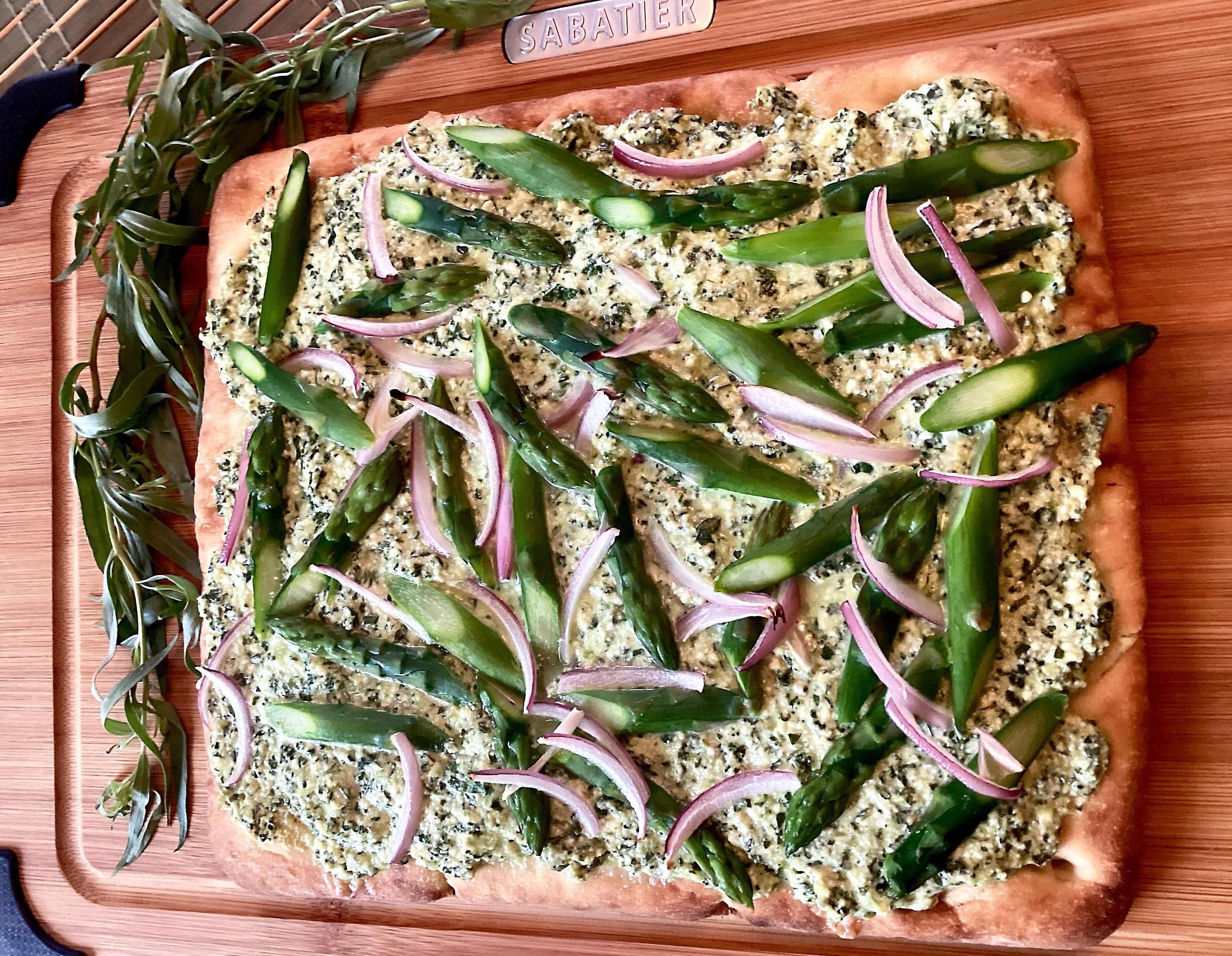


Oby Danielle French South Pond Home www.southpondfarms.ca
@howyouplaythegame Podcast
ne of my husband’s favorite snacks is a simple yet delicious treat I used to make as a wedding appetizer back at the farm. Every now and then I’ll make it when the kids come by for Sunday night dinner. As we inch closer to spring, it’s nice to start thinking about hosting again and welcoming friends and neighbours in, shaking off the heaviness of winter and embracing the lighter, warmer days ahead. Sadly (or happily), the tractor travels back to the country until next year.
It is firstly, bacon. Salty, hot and sizzling with fat. Inside the warm goat cheese is melting and surrounds the sweetness and slightly exotic taste of a date. When I make these, I always need to make enough for the girls even if they aren’t over for a meal. We all hope for leftovers.
Bacon Date Roll ups are something to have up your sleeve when the time comes. These are easy to prepare and especially easy to keep in the refrigerator until you are ready to use them.
Makes 40 INGREDIENTS:
1 lb bacon regular thickness
Approximately 40 pitted dates
1 lb soft goat cheese
METHOD:
1. Cut the bacon strips in half and that should give you approximately 40 slices (more or less).
2. Take a date and cut a slight strip into the centre and fill with the goat cheese.
3. Wrap a strip of bacon around the date and place a toothpick through (I usually skip that step and just place strip end side down on a baking sheet layered with a piece of parchment paper). If you are not baking right away, put into the refrigerator.
4. Preheat the oven to 425 degrees F.
5. Place the baking sheet into the oven with the roll ups and watch carefully after about 8 minutes. Bacon should be crisp and fully done.
6. Remove the bacon date roll ups from the sheet and onto a small platter for serving.
These are best eaten while they are hot and, Oh so delicious - you will want to reserve some for yourself!


By Chef Brian Henry
O ver my career I have had the privilege of cooking for countless celebrities. Many people gush at this notion and wonder what it was like to cook for them and what they ate. For the most part, I can readily state that they take comfort in wholesome home-style meals which is why I wasn’t surprised when Serena Ryder said that her favourite Christmas Dinner foods were Creamy Mashed Cauliflower, Whole Roasted Chicken and Swiss Chard which can be easily made using the following recipe
Creamy Mashed Cauliflower
Ingredients:
1 head cauliflower cut into bite-size florets
4 cloves garlic, peeled
1/3 cup buttermilk
Method:
4 tsp. cooking oil, divided 1 tsp. butter
Salt and fresh cracked pepper
Chives
1. Place cauliflower and garlic in a steamer basket over boiling water, cover and steam until tender.
2. Place the cooked cauliflower and garlic in a food processor.
3. Add buttermilk, 2 tsp. cooking oil, butter, salt and pepper; pulse mixture a bit and then process until smooth.
4. Transfer to a serving bowl. Drizzle with the remaining cooking oil and garnish with fresh cut chives.
Mediterranean Swiss Chard
Ingredients:
2 tbsp. cooking oil
3 cloves garlic, coarsely chopped
¼ cup pine nuts
1 bunch Swiss chard, separate the stems from the leaves and cut both into 1-inch pieces
Method:
¼ cup raisins
¼ cup of water or unsalted vegetable stock
Salt and pepper
½ lemon cut into wedges
1. In a large sauté pan heat the cooking oil over medium high heat.
2. Lightly brown the garlic and pine nuts in the oil being careful not to scorch either. Quickly remove the garlic and pine nuts from the pan and set aside.
3. Add the chard stems and raisins to the pan with the stock and gently simmer until evaporated.
4. Add the chard leaves to the pan and quickly toss them so they begin to wilt.
5. Return the garlic and pine nuts to the pan and season with salt and pepper.
6. Serve immediately with lemon wedges to be squeezed over the chard.

Roasted Chicken
Ingredients:


1 whole chicken, giblets removed
Salt and fresh cracked pepper
1 tbsp. onion powder
1/2 cup butter, divided
1 stalk celery
1 small cooking onion, peeled and cut in half
Method:
Place chicken in a roasting pan, and season generously inside and out with salt, pepper and onion powder.
Place half the butter in the chicken cavity.
Break the remaining butter into pieces and place under the skin of the chicken over the breast meat.
Cut the celery into 3 or 4 pieces, and place in the chicken cavity along with the onion.
Bake uncovered in a preheated oven at 350 °F for about 60-75 minutes and a minimum internal temperature of 180 °F has been reached.
Remove from heat, and baste with melted margarine and drippings.
Cover with aluminum foil, and allow it to rest for 20 minutes before serving.

HBy Carol Turner @carolturner9319
omemade meat loaf is classic winter comfort food - this turkey version is no exception. Sour cream keeps the turkey moist. Sage & orange zest add fresh bright flavour to this easy to prepare weeknight dinner. For a quicker prep, omit the leek and spinach stuffing. Leftovers make for great turkey loaf sandwiches! Serves 8.
Salad:
1 19 oz tin black beans, drained and rinsed
2 cups fresh or frozen corn, rinsed and thawed if frozen and boiled or grilled if fresh
2 tablespoons chopped red onion
2 tablespoons finely chopped poblano pepper (optional)
Vinaigrette:
5 tablespoons fresh lime juice
1 ½ teaspoons liquid honey
1/2 teaspoon dried oregano
2 canned chipotle peppers in adobo sauce, finely chopped (find these in the Mexican section of your favourite grocery store)
1 ½ teaspoons ground cumin
1/3 cup chopped cilantro
2 chopped avocados (do not prepare ahead)
1/2 cup crumbled cotija or feta cheese
1/2 cup chopped tomato
5 tablespoons avocado oil (vegetable oil can be substituted)
3/4 teaspoon fine sea salt
1/4 teaspoon black pepper
1. Mix black beans, corn, red onion, poblano pepper and cumin in a large bowl and set aside.
2. Make vinaigrette by combining lime juice, honey, chipotle chilies, oregano, salt and pepper in the base of a food processor.
3. Process until smooth then gradually add avocado oil and blend until emulsified.
4. Taste and adjust seasonings if necessary.
5. Refrigerate until ready to use.
6. When ready to assemble add vinaigrette, chopped cilantro and tomato to corn and bean mixture and toss gently to combine.
7. Gently fold in avocado and sprinkle cotija cheese on top.
8. Garnish with sprigs of fresh cilantro.
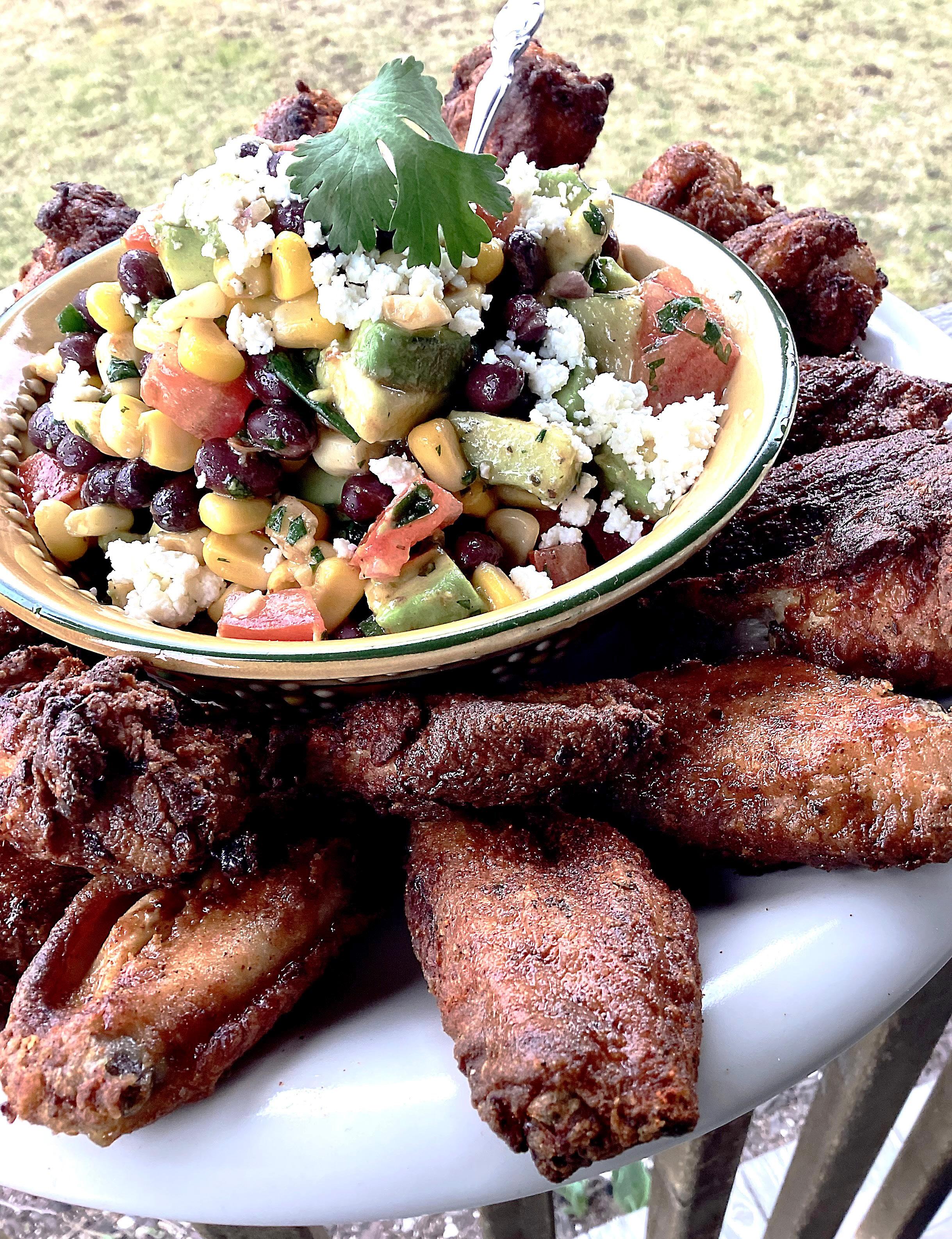

Iby Danielle French South Pond Home
www.southpondfarms.ca @howyouplaythegame Podcast
believe that bread is a fundamental tradition and a cornerstone of good meals. In some form, it is part of every culture - leavened or unleavened, fried or baked, flat or formed into loaves. Made with wholesome grains, bread is an important part of our nutrition. Making this bread for a meal is certainly not a requirement, but I think you’ll find the process deeply satisfying and it will be appreciated by your family or guests.
Focaccia dough is versatile. You can use it to make flat breads and pizza, you can freeze it and you can make it the night before you need it. The dough only gets better the longer it is left to rise (air bubbles enhance the loaf). Julia Child said that when you push the dough down, you should be able to hear it squeak as the air bubbles pop, and that is a good thing.
Top your focaccia bread with anything you like. My favorite is rosemary with a liberal amount of coarse salt. Add thinly sliced onions and a drizzle of olive oil; press olives or cranberries into the dough; or add other herbs like chives or thyme. Consider it a clean palette, and add whatever color you wish. This bread is not a high-rise bread. I cut it into strips and spread with butter or dip in olive oil infused with a few herbs.
INGREDIENTS:
5 3⁄4 cups all-purpose flour
2 tsp quick-rising (instant) yeast
2 tsp kosher salt
1⁄4 cup olive oil
2 1⁄2 cups water (more or less), at room temperature
Topping: 3 tbsp olive oil
1 tbsp dried rosemary or 3 tbsp chopped fresh rosemary Coarse sea salt, to taste
1. In a large bowl, using a wooden spoon, stir together flour, yeast, and salt. Add olive oil and stir into the flour mixture. While stirring, gradually add just enough water to make a loose (or shaggy) dough. Stir well. At this point the dough needs to be mixed enough that you can handle it with your hands. It should not be so wet that you can’t touch it.
2. Turn the dough out onto a lightly floured board and knead until it is smooth and elastic. If it is too moist, you can add flour about a tablespoon at a time until it reaches the right consistency. Ideally, when you pull the dough apart, it should stretch without breaking. This may take up to 10 minutes. (Alternatively, you can combine all the ingredients in the bowl of a stand mixer fitted with the dough hook. Mix on medium speed for 5 minutes, until the dough is smooth and elastic, adding more flour or water as necessary.) Place dough in an oiled bowl, cover with a damp kitchen towel or plastic wrap, and let rest for at least 1 hour or ideally overnight.
The dough should be light and airy, fluffy to the touch, with lots of bubbles. (I prefer letting the dough rest overnight, as it yields a lighter bread, full of holes, once baked.)
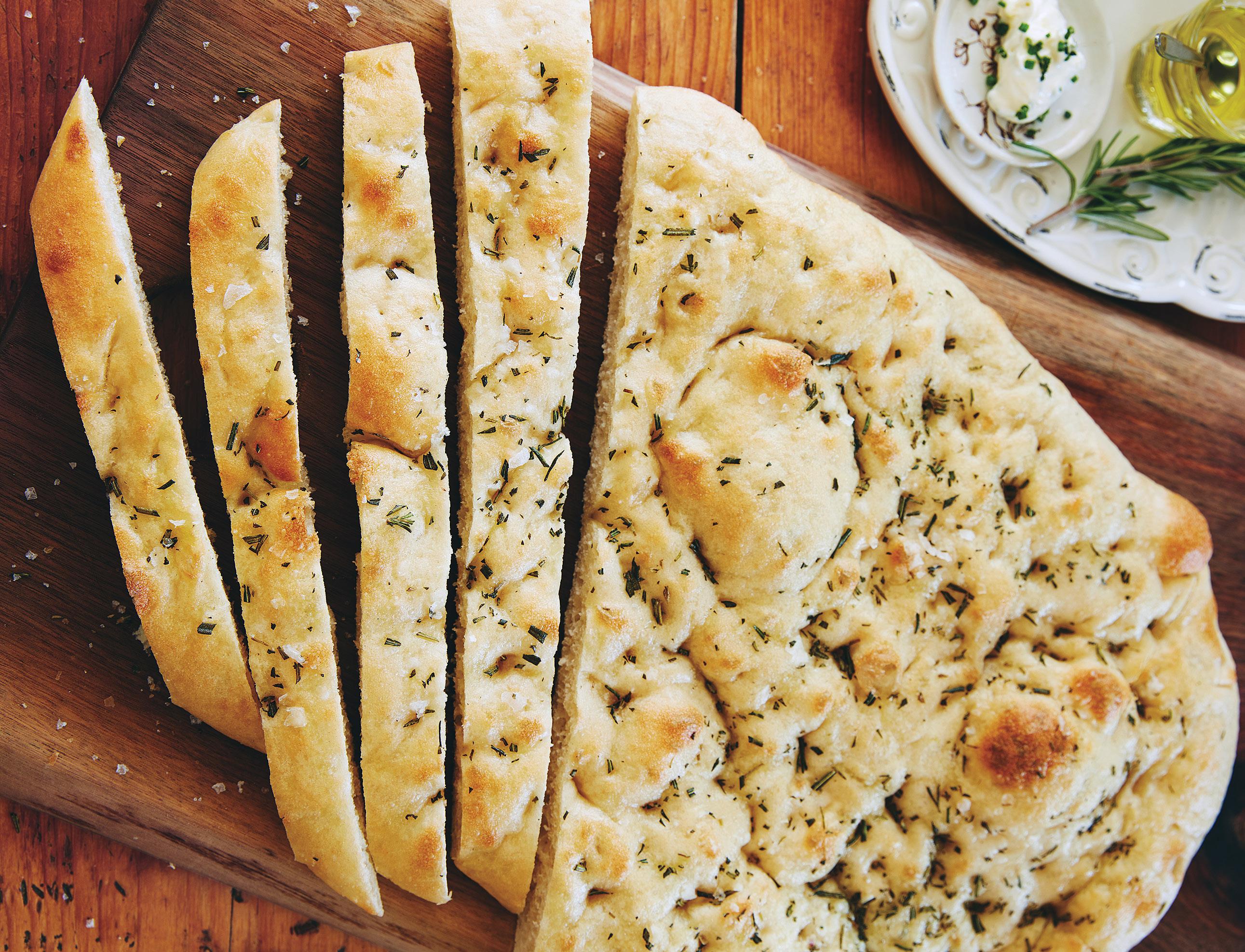
3. When ready to bake, gently knead dough once or twice, being careful not to push all the air out, and flatten the dough gently with your palms, shaping it into a rectangle about 1 inch thick. Transfer dough to a greased or parchment-lined baking sheet. Fold dough in half lengthwise. Cover loosely with plastic wrap or a damp kitchen towel and let rise for about 1 hour or until doubled in size.
1. Preheat the oven to 450°F.
2. Using a sharp knife, score dough crosswise in 2-inch intervals and set aside.
3. In a small bowl, combine oil and rosemary. Using a pastry brush, brush mixture evenly overtop dough.
4. Sprinkle liberally with coarse salt.
5. Bake for 25 to 35 minutes, until brown on top and loaf sounds hollow when you tap it.
6. Transfer focaccia to a wire rack and let cool until you are ready to eat it.

BBy Chef Brian Henry
BQ season is here! With the relentless weather we have experienced, firing up the BBQ is a welcomed change for sure. It’s time to get cooking outdoors again and to do this you should give your barbecue a good cleaning and tune up before firing it up for the season.
Once you have done this and are ready to get cooking, you need to recognize two important things; never leave your barbecue when cooking, and your barbecue has variable temperature control dials; therefore you should not always have your barbecue cranked on high. To do this you need to assemble all of the items that you will need to get the job done. Including a squirt bottle of water to put out any small flare-ups as well as a fire extinguisher for large flare-ups!
Cuts of beef to utilize are striploin, rib eye, tenderloin, or sirloin. About 5-10 minutes prior to cooking the steaks lightly drizzle them with cooking oil and sprinkle with sea salt and pepper. Cook steaks on a hot barbecue. Do not keep flipping them or turning them. You will only need to touch your steaks five times when cooking them. 1) Place steaks on hot barbecue. 2) After the flesh has been seared and marked, give the steak a quarter turn. This ensures the crisscrossed grill marks you get in restaurants. 3) Flip the steak over. 4) Repeat step 2, and finally remove the steaks from the barbecue. This process is the same for chicken; lightly oil the chicken prior to BBQing it as this will ensure that the chicken will not stick to the grill.
For grilling fish, choose firm fleshed fish such as salmon or tuna. Grilling fish reqires everything to get a light coating of oil, your flipper, tongs the heated grill and the fish. This will allow you to cook the fish just like a steak. You also can cook the fish with the skin on it. Lightly oil the skin and cook it skin side down on the BBQ. This technique will allow you to cook your fish without it breaking or flaking apart on the BBQ.
For grilling veggies such as zucchini, eggplant and Portobello’s, lightly marinate the veg in olive oil with balsamic vinegar in a ratio of two-parts vinegar to one-part oil. The vegetables do not need to be soaked in this mixture, just a light drizzled will do.
Cedar planking… Make sure when you purchase your planks that they are untreated. Also, you must soak the planks for at least two to three hours prior to cooking with them. When cedar planking foods, I recommend that you keep a bucket full of water close at hand, as this will allow you to gracefully dunk any burning planks into the water safely to douse any unwanted fires.
1 pineapple peeled and quartered
1 medium red onion peeled and diced
1 red bell pepper seeded and diced
Two mini-wheels of Brie or Camembert 1 cedar plank soaked in water for 2-3 hours
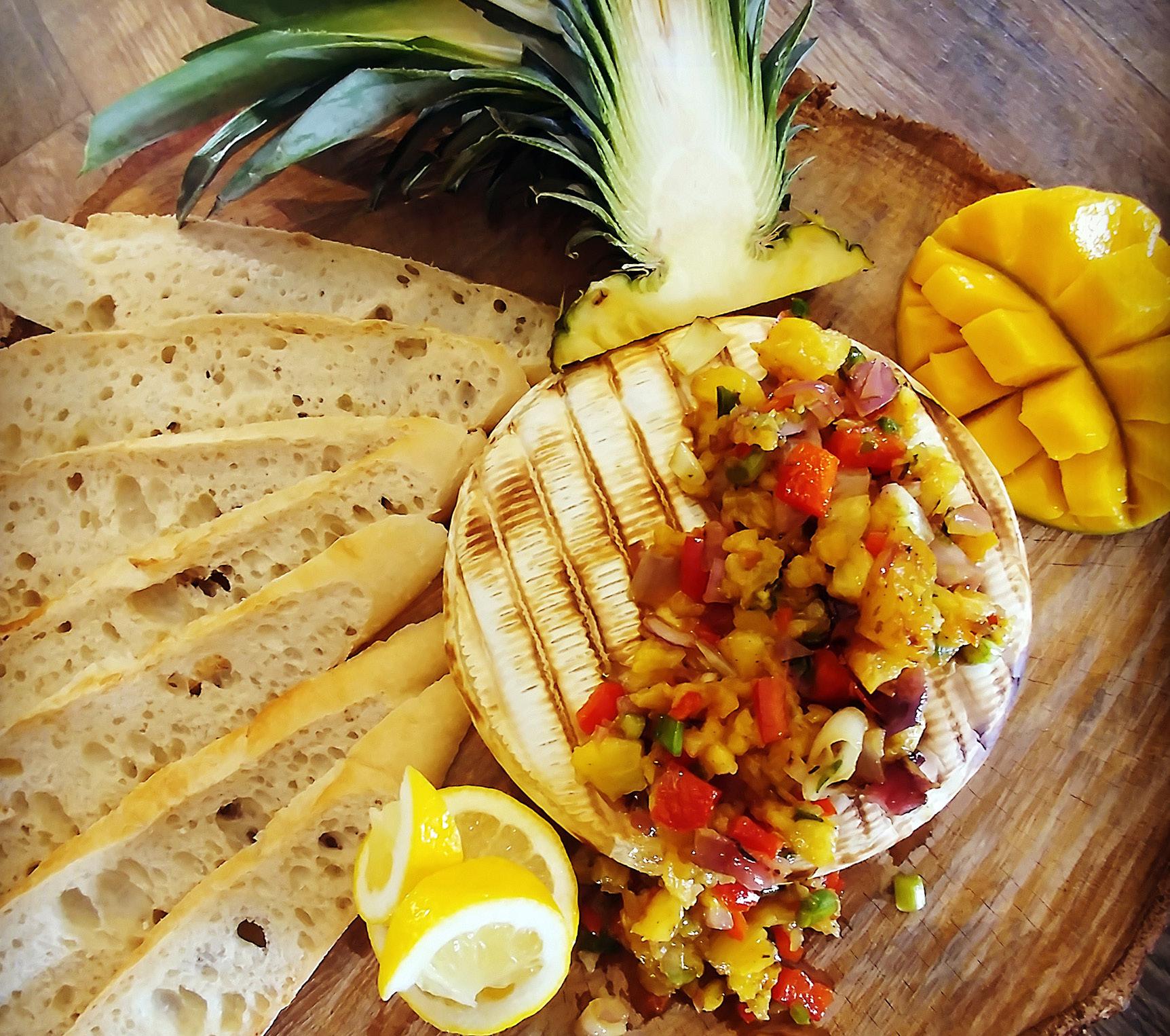
1. Toss pineapple in a little olive oil, enough to lightly coat it.
2. Grill pineapple on barbecue until golden brown.
3. Place cheese onto a pre-soaked cedar plank and cook on the barbecue, with the lid closed, until golden brown.
4. While the cheese is cooking, make the salsa by chopping up the pineapple, red pepper and onion into small pieces and mix together. If you choose, you may want to add chopped basil or cilantro as well.
5. When the cheese is soft and golden, remove it from the barbecue and serve with the salsa over top with baguette or crackers.

By Chef Brian Henry Food Editor
A Taste of the Kawarthas magazine
M ost people’s go-to comfort food says something about where they grew up and provides a feeling of contentment, typically associated with one’s childhood. You can expect most comfort foods to be loaded with carbs, fats, sugar, and salt.
Potatoes do this for me, in particular mashed potatoes, boiled with the skin off, mashed with a ricer and served with gobs of salted butter that melt and form rivers that flow into pools of gravy that picks up bits of horseradish left on the plate accented with the gentle bite of green onions.
Yup, the lowly potato discovered in South America which was eaten mashed by the Inca’s quickly became a dietary mainstay of the poor and downtrodden throughout the world has become a culinary mainstay.
A common request at caterings is a Potato Bar which includes a base of garlic mashed, tater tots, and sweet potato mash. These are then garnished in a self-serve manner from an assortment of condiments. Our most requested condiments are beef gravy, bacon bits, butter, scallions, cheese curd, sour cream, marshmallows, brown sugar, candied pecans, maple syrup, fried onion straws, candied bacon, assorted cheese, bacon bourbon jam, truffle oil, roasted garlic, asparagus, broccoli, and other stuff.
I use a blend of starchy and waxy potatoes in the following recipe which can be served up with whatever your favorite toppings are or try some new ones as mentioned.
2.5 lbs. Yukon Gold potatoes
2.5 lbs. Russet potatoes
2 large cloves garlic, minced
Kosher salt
6 tbsp. butter
1 cup milk
4 ounces cream cheese, room temperature
Salt and pepper to taste

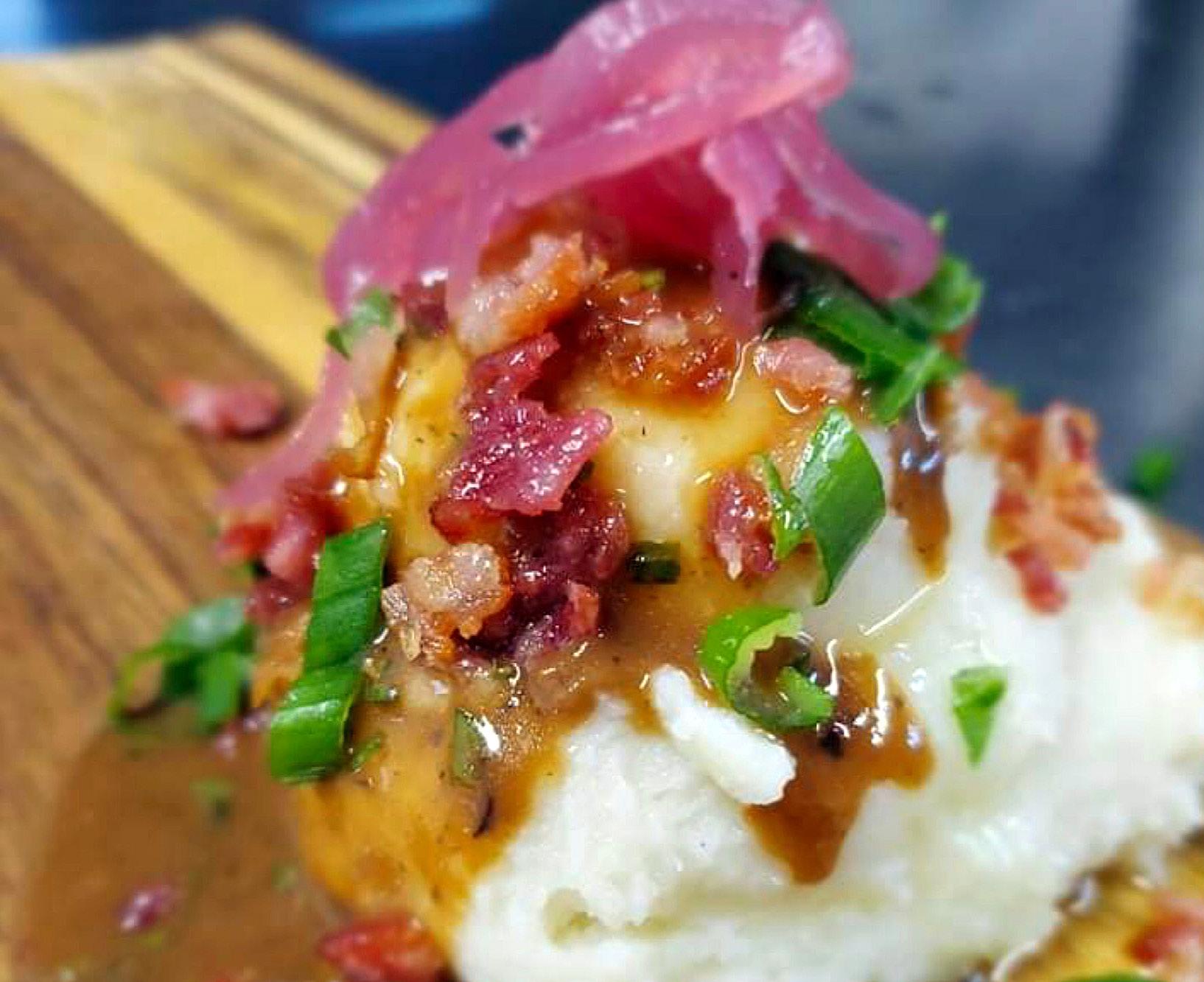
1. Peel or don’t peel your potatoes. Cut the potatoes in half and ensure that they are all relatively the same size so that they cook evenly.
2.Place potatoes in a large stock pot and fill until the potatoes are just covered with cold water. Add about a tablespoon of kosher salt to the water and bring potatoes to a boil over med-high heat. Boil potatoes until you can insert a knife without resistance but the potato is still firmly intact.
3.Carefully drain out all of the water then pan-dry the potatoes returning them to the hot stockpot and placing it back on the still hot burner, which is now turned off to help cook off some of the remaining steam within the potatoes.
4. Separately heat the butter, milk and garlic either in a saucepan or in the microwave until the butter is just melted.
5. Mash the potatoes with your preferred kind of masher to your desired consistency.
6. Pour half of the melted butter mixture over the potatoes and fold it in with a wooden spoon or spatula until potatoes have soaked up the liquid.
7. Repeat with the remaining butter, and then again with the cream cheese, folding in each addition in until just combined to avoid over-mixing and gluey potatoes.
8. Season to taste with salt and pepper.

SBy Carol Turner @carolturner9319
weet roasted winter vegetables pair beautifully with this rich and savoury risotto. Feel free to try other vegetables such as celery root or fennel in this comforting cold weather dish. Any dry white wine will be a nice compliment but I like it served with a chilled Viognier. Serves 4
INGREDIENTS:
1 medium butternut squash, cut into 1 inch cubes
1 medium red onion, cut into eighths
4 parsnips, peeled and cut into 1/2 inch diagonal slices
BACON RISOTTO
4 slices side bacon, chopped in 1/4 inch pieces
1 small yellow onion, finely chopped
1 cup Arborio rice
1/4 cup dry white wine
DIRECTIONS:
Roasted vegetables
6 shallots, peeled and halved
1 large head of garlic, separated and peeled
1/3 cup olive oil
1 tablespoon chopped fresh sage
Salt and Pepper
4 cups chicken stock (kept at a low simmer)
1 1/2 tablespoons butter
1/2 cup Parmesan cheese, grated
1 cup plain goat cheese, crumbled & extra Parmesan cheese
1. Preheat oven (rack in middle) to 400 F then combine all chopped vegetables, EXCEPT garlic, in a large bowl with olive oil, salt and pepper (season generously). Transfer to a large baking sheet in a single layer (use two pans if necessary).
2. Roast the vegetables for 15 minutes then remove pan and add garlic, mixing well. Continue to bake roughly 30 more minutes stirring occasionally to prevent burning. Vegetables should be softened and lightly browned. Remove and stir in chopped sage.
Meanwhile, prepare risotto
1. In a large heavy-bottomed saucepan over medium heat, sauté bacon until lightly browned, approximately 6 minutes. Add onions and cook, stirring, until softened but not browned, approximately 5 more minutes.
2. Add rice and sauté until it is coated and looks glossy. Add wine and cook, stirring, until it is almost completely absorbed. Add about 1 cup of stock to the rice and cook for about 2 minutes, stirring constantly, until the stock is almost completely absorbed. Gradually add more stock, a cup at a time, stirring gently until absorbed by the rice before adding the next cup. After about 15 minutes begin tasting the rice and adding more stock in smaller quantity until the rice is firm yet cooked through. When the risotto is done it will be creamy but still slightly firm to the bite.
3. Stir in butter and Parmesan cheese then taste and add salt and pepper to taste.

Spoon risotto into bowls and top with roasted vegetables and crumbled goat cheese. Serve with additional grated Parmesan cheese and garnish with fresh sage.
For more delicious recipes, follow Carol Turner on Instagram @carolturner9319

F
By Carol Turner @carolturner9319
resh dill and sun-dried tomatoes may seem an unlikely pairing but they complement each other in this bold flavoured pesto. Asparagus and grape tomatoes add a light freshness to this vegetarian pasta dish which can be served warm or at room temperature. Refrigerate leftover pesto for up to 3 days and use in a cold pasta salad, as a stuffing for chicken breasts or as a sandwich spread.
INGREDIENTS: (serves 3-4)
Pesto:
1 cup sliced oil packed sun-dried tomatoes, drained
1 large clove chopped garlic
¼ cup slivered almonds
¼ cup fresh dill, chopped
Vegetables:
1 lb asparagus, ends trimmed, washed and cut in 1½ inch pieces
1 cup grape tomatoes, washed and halved
½ cup Parmesan cheese, grated, plus ¼ cup for serving
¾ teaspoon lemon zest
¼ teaspoon black pepper
¼ teaspoon salt
½ cup olive oil
Pasta:
8 oz dried fettuccini
1. Place first 8 pesto ingredients in food processor and blend until roughly chopped.
2. While the food processor is running, gradually stream in olive oil until all ingredients are incorporated and emulsified, scraping down the sides of the bowl if necessary.
3. Reserve at room temperature as your pasta cooks or store refrigerated in an airtight container.
4. Blanch asparagus in boiling, salted water for 2 ½ minutes until bright green and slightly softened. Using a slotted spoon, transfer asparagus to a bowl of ice water to stop the cooking process. Remove and pat dry.
5. Combine asparagus and grape tomatoes in a bowl.
6. Cook fettuccini in salted water according to package directions. Drain, reserving 1 cup pasta water.
7. Return pasta to cooking pot and add 1/3-1/2 cup pesto, asparagus and grape tomatoes. Gently combine, adding splashes of pasta water to loosen sauce to desired consistency.
8. Season with salt and pepper. Serve with remaining parmesan cheese and a sprig of dill for garnish.
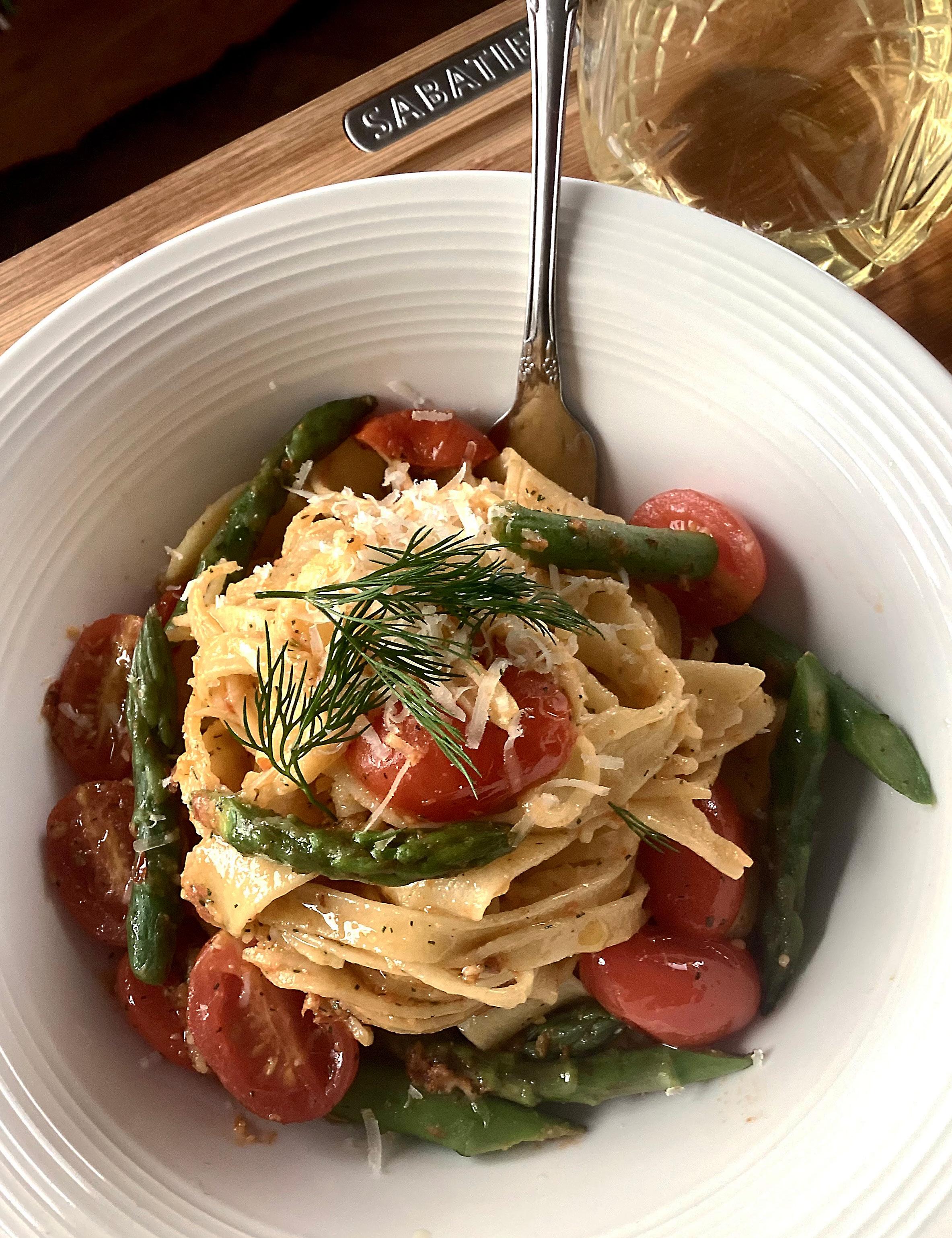

GBy Carol Turner @carolturner9319
alettes are a rustic form of tart distinguished by it’s free form crust that encases a variety of sweet or savoury fillings. This version features a buttery homemade pastry, a layer of garlic cream and a garlic, fennel and red onion filling. Serve for lunch with a crisp green salad or cut in smaller portions to enjoy with a glass of sparkling wine. Don’t look for perfection; it’s the imperfections that set galettes apart!
(serves 4)
Pastry:
1 1/3 cups all purpose flour
1/2 teaspoon fine sea salt
1/4 teaspoon sugar
1/2 cup cold salted butter, chopped
Garlic Cream:
1 cup heavy (whipping) cream
3 large cloves garlic, smashed
Salt and pepper
Vegetable filling and garnish:
1 tablespoon olive oil
1 teaspoon ground fennel
6 tablespoons ice water
1 beaten egg
1/2 medium fennel bulb, thinly sliced (fennel fronds reserved)
1/2 red onion, thinly sliced
1/4 cup parmesan cheese, finely grated
1. In a food processor with the blade attachment pulse together flour, sugar, salt and dried fennel.
2. Cut cold butter into ½ inch cubes and add to food processor. Push the pulse button 10-12 times or until butter becomes pea-sized.
3. Add ice water 1 tablespoon at a time and pulse between each addition. Dough will be ready when it becomes to clump.
4. Form the dough into a disk but don’t over work it. Dust with flour on all sides, cover with plastic wrap and refrigerate for at least 1 hour and up to 3 days. (remove dough from fridge half an hour before proceeding with the recipe)
5. Combine smashed garlic and heavy cream in a small saucepan and bring to a gentle simmer. Continue simmering, stirring frequently until reduced to half a cup (roughly 15 minutes). Strain garlic, roughly chop and reserved. Place garlic cream in a small bowl and cover with plastic wrap, pushing firmly around edges, to prevent film from forming. Refrigerate until cooled completely.
6. Heat olive oil in a large skillet then add sliced red onion and fennel. Cook over medium heat, stirring frequently, until vegetables are tender and slightly browned (roughly 15 minutes). Season with salt and pepper to taste then add reserved chopped garlic. Remove from heat and refrigerate until cooled completely.

8. On a floured sheet of parchment paper roll the dough into a 12 inch circle. It does not need to be perfect! Place parchment paper and dough on a rimmed baking sheet.
9. With a pastry brush spread a thin layer of garlic cream over the dough, leaving a 2 inch border. Top with fennel, red onion and garlic mixture, distributing evenly over garlic cream. Sprinkle parmesan cheese over the vegetables.
10. Fold the edges of the galette up and over the edge of vegetables, pinching the overlapping edges together to form a seal.
11. Refrigerate 15 minutes.
12. Brush edges of dough with beaten egg then bake for 25 minutes until crust is golden brown.
13. Let galette rest for 15 minutes then top with reserved fennel fronds and lemon zest. Cut into quarters and enjoy!


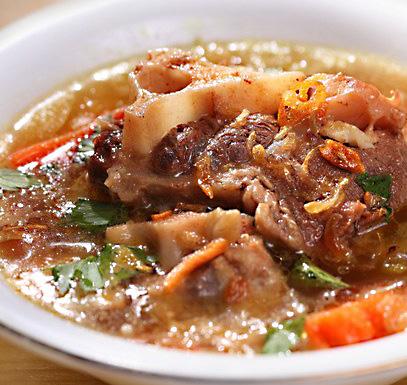
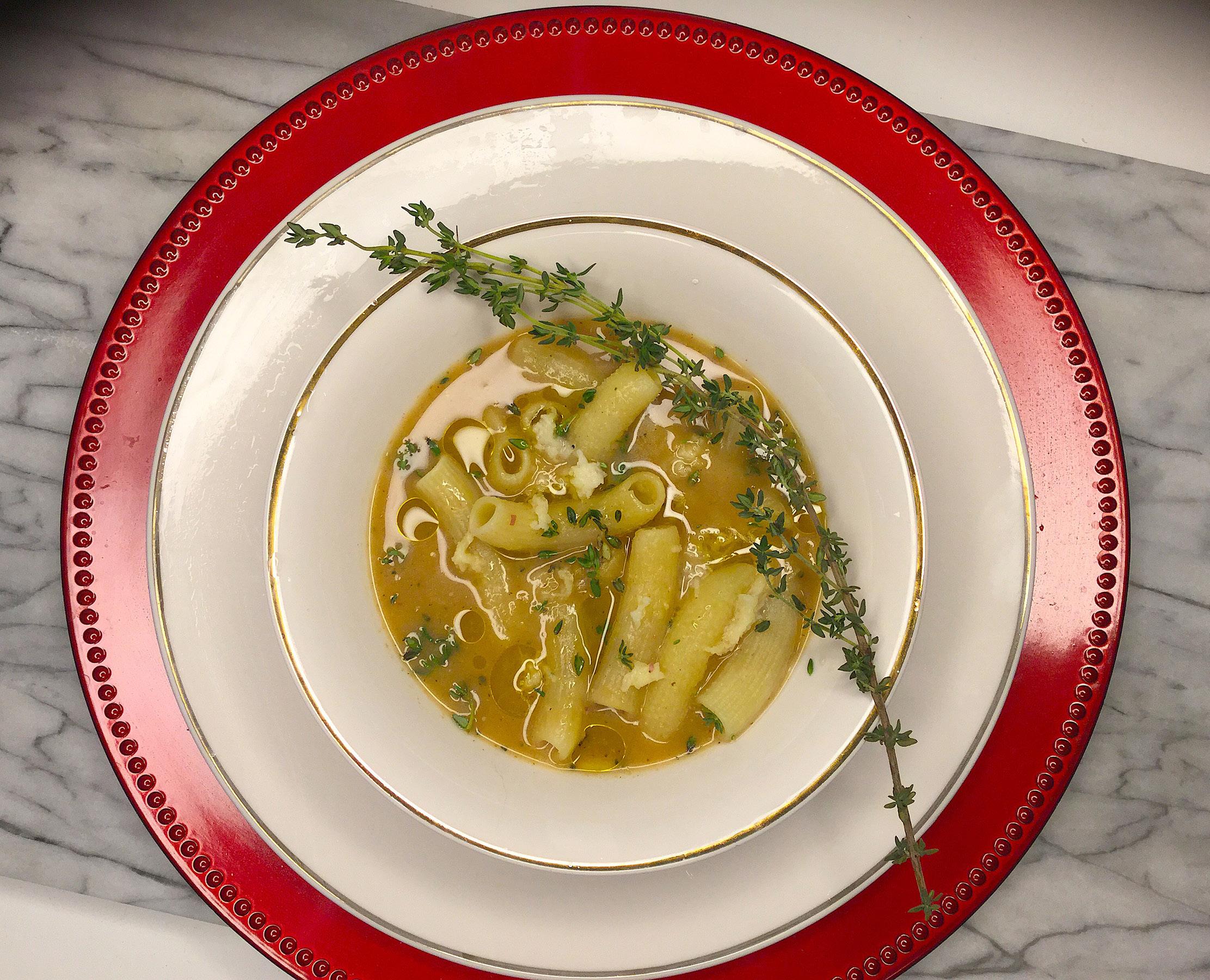
You may find yourself having to accommodate the culinary preferences of family and friends. You may find yourself cooking an entire vegan holiday meal. The vegan lifestyle is growing in popularity. In fact, it is no longer a fad or diet for tree hugging hippies. While following an anti-inflammatory diet, I try to make as many vegan meals as I can to reduce the amount of flesh consumed.
I was intrigued to discover that search data from Google Trends shows a worldwide rise in the interest in veganism from 2004 to 2018. Some of the countries embracing a plant-based diet include Australia, Canada, Austria, Israel, and New Zealand. In the US in the last 3 years, there has also been a 600% increase in people becoming vegans. According to a report done by GlobalData (research firm), only 1% of U.S. consumers claimed to be vegan in 2014. And in 2017, that number rose to 6%.
The holiday vegan meal can begin with a delicious, vegan hot soup to warm the hearts and bodies of your guests. I love 40 Garlic Clove Soup. This soup highlights roasted, fried, and raw garlic! It’s a delicious vegan soup packed with nutrition. Garlic is a well-known natural antibiotic and helps boost the immune system to fight colds. It also has compounds that can reduce blood pressure, lower cholesterol, and it is thought that its antioxidant properties may even help prevent Alzheimer’s Disease and dementia.

By Shari Darling
40 Clove Soup
Serves 4
INGREDIENTS:
40 Cloves Of Garlic, Peeled
1/4 cup Olive Oil, Divided
1 medium sweet onion, Chopped
1 medium potato, peeled, chopped
4 cups vegetable broth
½ teaspoon Dried Thyme
1. Preheat oven to 350 F (280 C).
Sea salt and freshly ground black pepper to taste
2 tablespoons freshly squeezed lemon juice
Olive oil (for garnish)
4 cloves raw garlic, minced (for garnish)
Juice from 4 wedges of fresh lemon (for garnish)
2. In a sauté pan over low heat, heat 2 tablespoons of the oil.
3. Place 30 garlic cloves on a cookie sheet lined with foil.
4. Drizzle with olive oil.
5. Cover with foil, and roast the garlic for 35 to 40 minutes or until soft and brown.
6. Meanwhile, while the garlic is roasting, coarsely chop the remaining garlic cloves and add to the saucepan along with the onions and potatoes.
7. Cook the mixture over medium heat until the vegetables soften and begin to brown, about 5 minutes.
8. Add the broth, thyme, salt and pepper and bring to a boil.
9. Reduce heat to a simmer, and cook until the potatoes are very tender, about 15 to 20 minutes. Let the soup cool to room temperature.
10. Once the garlic has roasted to a light golden brown, put in a food processor or blender.
11. Add soup in batches, blending until smooth.
12. Transfer each batch to a soup pot.
13. Heat soup.
14. Divide between bowls.
15. Garnish each bowl with olive oil, 1 clove of minced raw garlic, and drizzle in lemon juice.

By Chef Brian Henry Food Editor A Taste of the Kawarthas magazine
O ffal rhymes with awful and the irony is that offal is the culinary term used to describe the glandular organs and entrails of animals. Liver, heart, spleen and tripe are various forms of offal and their mention often leads to the loss of one’s appetite.
If eating offal is disturbing to you, I suggest you ease yourself into this by starting at the tail end of things, as tails are categorized as offal but they are actually a muscle. Traditionally oxtails came from oxen which were neutered cattle that were harnessed as beasts of burden and put to work. When their life’s purpose had been filled the oxen were slaughtered and sent to the kitchen.
Oxen were prized for their strongly flavoured meat that can be attributed to their muscles being excessively worked and high concentrations of myoglobin in their bloodstream. Today we call oxen steers and commercially available oxtails are harvested from a variety of cattle including veal calves. As we have forgone the oxcart, cattle are no longer being worked as hard resulting in milder flavoured beef tails.
Oxtails weigh in around three pounds and are mostly bone as the tail is a continuation of the spine. The bones are held together by long bundles of muscle fibres that require them be cooked slowly by a moist heat method like braising. This slow cooking process lets the bones release their gelatin creating a delicious broth with a notable lush texture on the palate.
INGREDIENTS:
1 oxtail (3 pounds) sliced in 1 inch thick rounds
1/2 cup All-purpose flour
3 tbsp Cooking oil
1 ½ cups Spanish onions, peeled and diced
½ cup Carrots, peeled and diced
6 cups Water
2 tbsp Tomato paste
1 Bay leaf
1/2 teaspoon Thyme
3 Cloves
2 sprigs Parsley
½ cup Port or red wine
Salt and Pepper

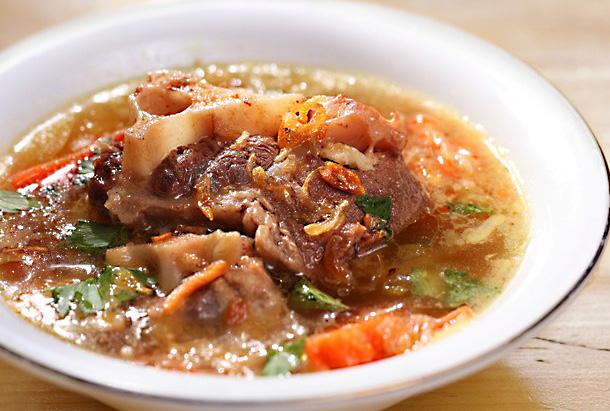
METHOD:
Serves 4 people.
1. Dredge the oxtails in the flour and brown them in the oil in a preheated, heavy bottomed soup pot over medium-high heat. Remove the oxtail from pot and set aside.
2. Lower the temperature to medium and cook the onions and carrots together until the onions are a golden brown.
3. Stir in the water, tomato paste, and the seasonings tied in a sachet.
4. Return the oxtail to the pot and simmer over medium-low heat for about three hours or until meat is fork tender.
5. Skim off any surface fat and remove the sachet.
6. Stir in the port and season with salt and pepper to taste.
7. Serve immediately with fresh baked bread.
8. Optionally you may choose to remove the meat from bones, and cut it into bite-size pieces before serving it in the soup.

By Carol Turner @carolturner9319
As days grow shorter and nights are cooler I crave comfort food. Soups and curries allow me to utilize fresh seasonal produce from our Farmers Market. The Onion Bhajia are optional, but I recommend them as they add great flavour and texture. Serves 5-6.
2 tbsp butter and 1 tablespoon olive oil
1 medium onion, roughly chopped
1 1/2” fresh ginger root, finely chopped
2 garlic cloves, finely chopped
1 medium cauliflower, separated into florets
1 LB parsnips, peeled, trimmed & roughly chopped
1 ripe Bosc pear, peeled, roughly chopped
SOUP
1 large potato, peeled, roughly chopped
2 tbsp ‘Curry in a Hurry’ spice blend (The Spice Co) or your favourite curry blend
6 C chicken or vegetable stock
1/2 tsp salt, or to taste
1/4 tsp black or white pepper
1 pinch sugar (optional)
1. In a large pot heat butter and oil then sauté chopped onion over medium/low heat until softened without browning, roughly 7 minutes.
2. Add curry powder, ginger root, garlic and sugar (if using) stirring for 2 minutes to combine and coat onions.
3. Add all chopped vegetables and pear and sauté 2 minutes.
4. Gently pour in stock. Bring to a boil adding a bit more stock or water to cover (Spoon off any visible foam) Reduce heat to medium/ low then cover and allow to simmer until all vegetables are soft, roughly 25 minutes.
5. Remove from heat and let cool slightly.
6. Puree with hand held emulsion blender until smooth Add salt and pepper if necessary and keep warm.
4 med. cooking onions, peeled, halved & thinly sliced
2 tsp salt
1/2 C chickpea flour (besan) at bulk or specialty stores
1/2 tsp curry powder
1 pinch Asafoetida or garlic powder (optional)
Vegetable oil for deep frying
GARNISH plain yogurt and fresh cilantro

1. Sprinkle thinly sliced onion with salt and work through with your fingers. This allows onions to sweat and soften. Leave for 30 minutes.
2. Meanwhile, heat oil in deep fryer or large pot to 375 F. I recommend using a thermometer to regulate temperature!
3. Drain off all onion juice from bowl and squeeze onions gently with paper towel to remove excess liquid.
4. Sprinkle 1/4 cup chickpea flour over onions and rub lightly with fingers. Add Asafoetida or garlic powder if using. Continue adding flour until onions begin to hold together.
5. Gently lower clumps of onion, by the heaping teaspoon, into hot oil and fry in batches until crisp and golden, 4 to 5 minutes. Remove with a slotted spoon and drain on paper towels. Season with coarse sea salt (optional).
Ladle soup into shallow bowls, top with 3-4 Bhajia then garnish with a drizzle of yogurt and fresh cilantro.
(Soup and Bhajia can be made ahead of time and reheated although the Bhajia will not be quite as crisp)

by Danielle French South Pond Home
www.southpondfarms.ca
@howyouplaythegame Podcast
Nourishment and Well Being. Believe that food does so much more than just nourish our bodies—it supports our health, mood, and overall well-being. Food provides comfort, connects us to others in family dinners or out for dinner. It directly impacts brain chemistry, hormone levels, and energy levels. When bad news comes, a comforting dish might make a difference between a good or bad day.
My recipe is for beef broth because it is a finished product - a broth I enjoy on it’s own. I roast the raw bones for 1 hour. I do not use extra meat but you can add 1 lb of chuck roast or flank steak to the roasting pan. My end result is still very flavourful. After roasting, add the bones and meat to a stock pot with two cut up pieces of celery, 2 carrots cut in quarters, 1 onion also quartered (unpeeled for extra flavour and colour), a bay leaf, parsley and thyme. I cooked this for 4+ hours on a low simmer. The key important tasks for making any meat based stock are :
1. To remove the bones and scrape out the marrow and all the vegetables into a fine mesh strainer and push the ingredients into the strainer getting out as much flavour as possible.
2. To allow the broth to cool completely and skim off the fat.
(Makes approximately 9 cups)
INGREDIENTS:
3 bone marrow bones, 6 pieces (I asked the butcher to cut them in half lengthwise)
2 celery stalks washed
2 carrots - washed not peeled
1 onion - quartered not peeled
1. Preheat the oven to 400 degrees.
1 bayleaf
1 bunch parsley washed, stems left on 4 thyme branches
10 peppercorns
Water
2.Arrange the bones in a roasting pan marrow side up or if using them whole, just on the sheet.
3. Add the vegetables - leaving the herbs for later.
4. Roast for about 45 minutes or until nicely browned. You may wish to turn the bones half way through roasting.
5. Remove the pan from the oven and add the contents to a large stock pot at least 12 quarts. Add the bones to the pot with the fat that has accumulated. Return the roasting pan to the top of your stove and very slowly, add about 1 cup of hot water to loosen the brown bits on the pan with a wooden spoon. Add this mixture also to the stock pot.
6. Add the bay leaf, herbs and cover with water. Bring to a boil and allow to simmer, uncovered for about 4-6 hours or until the liquid is reduced by about 1/3.

7. Remove from the heat and with tongs, remove the bones to the plate. Prepare a fine mesh sieve over a large bowl or pot large enough to handle the liquid with a bit of space on top. Wait until the bones are cool enough to handle and then scrape out the marrow and put into the sieve.
8. Pour the liquid over the sieve into a bowl or pot. With a wooden spoon, push the vegetables and bits of meat into the sieve allowing the soft pieces to come through into the broth.
9. What’s left is the cooking liquid plus the delicious and nutritious bits you have been able to push through the sieve. Pour the mixture back into the stock pot to cool or leave in your other bowl/pot.
10. Allow this mixture to cool completely and then ideally, place in the refrigerator to separate the fat from the stock. This can be overnight. The fat will harden and will be easy to scrape off and discard. You now have your stock and can use it or freeze it. If you drink it plain, you might want to sprinkle a bit of salt in.
Cheers and comfort to you. I think you will feel good, healthy and ready to take on whatever might be coming your way!


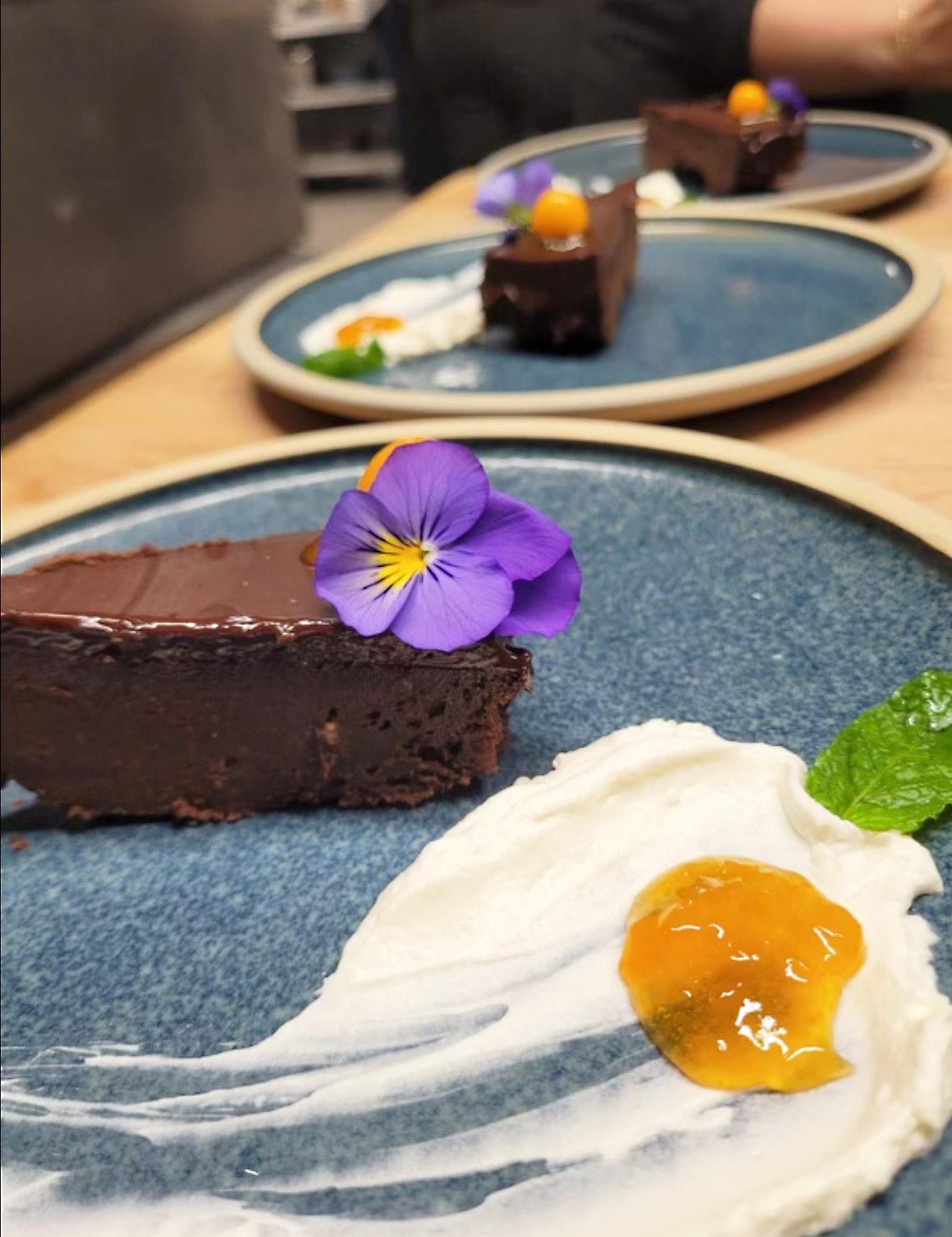

TBy Chef Brian Henry Food Editor
here is nothing more synonymous than the pumpkin when it comes to harvest time in the Kawarthas. Beyond the pumpkins symbolism and decorative purposes most of us know little about this fruit which leaves many reaching for them in canned form when it comes to cooking.
September and October are the best time to cook using fresh pumpkins as they are inexpensive and available in great quantity. To cook with fresh harvested pumpkins I suggest choosing smaller pumpkins as they are easier to handle and have a higher concentration of naturally occurring sugars. A small five pound pumpkin will yield about four pounds of puree which is about enough to bake five pumpkin pies. To prepare your pumpkin for puree one needs to simply give it a good washing off, then remove the top so you can remove the seeds which you should reserve and toast up separately. Next cut the pumpkin into 6 evenly sized wedges and cook them either in a steamer or bake them until the flesh becomes soft. Once cooked let the pumpkin cool down and pull off the skin and discard it. Use the cooked, softened pumpkin in any recipe that calls for canned pumpkin puree.
Pumpkin seeds, known as pepitas, are the small, flat, green, edible seeds. Most pumpkin seeds are covered by a white husk, although some pumpkin varieties produce seeds without them.
Pumpkin seed oil contains fatty acids which help maintain healthy blood vessels and nerves, and are loaded with essential fatty acids that help to maintain healthy blood vessels, nerves and tissues with its high fiber content helping to aid proper digestion. Pumpkins are available throughout our region and can be found in abundance at farm gates or almost everywhere one would find food for sale. It can be fun to go to a pick your own field as well to get your pumpkins.
Be sure to save your seeds for this recipe which is a twist on a classic treat of toasted Pumpkin seeds by turning them into a gourmet confection.
1/2 tsp baking soda
2 tbsp butter, melted
1-1/2 C sugar
3/4 C water
1/4 tsp fine grained sea salt
3/4 C of hulled roasted pumpkin seeds ‘pepitas’
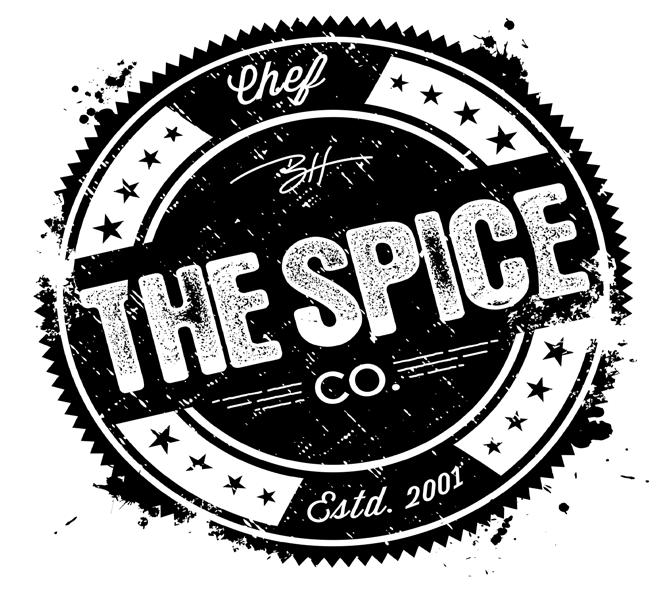

METHOD:
Stir together baking soda and melted butter; set aside. Line a cookie sheet with parchment paper; set aside a second sheet the same size. Butter the parchment on one side.
Combine sugar, water and salt in a medium sized saucepan and bring to a gentle boil. Reduce the heat to medium-low; wash down any sugar crystals on sides of pan with a pastry brush dipped in cold water. Simmer syrup 10 to 12 minutes, until it reaches 240°F. Remove from heat; with a wooden spoon gently stir in the pumpkin seeds.
While stirring, return pan to medium-low heat until the mixture turns a deep amber color and reaches 290°F. Remove from heat; stir in butter-baking soda mixture with wooden spoon.
Pour mixture onto prepared cookie sheet; cover with second parchment sheet. Press the mixture with a rolling pin to 1/4-inch thick. Remove top layer of parchment and allow it to completely cool down. Next crack the brittle and serve the tasty morsels.
Store your pepita brittle between layers of parchment in a sealed container for up to two weeks.

By Chef Brian Henry Food Editor
F or some, romance means sex and what we eat on Valentine’s Day can ruin the mood. Eroticism and foods have long been paired together, even before pairing food with wine.
Numerous foods are considered to be aphrodisiacs, something that increases sexual desires which historically people believed foods that resemble genitalia were the best catalyst for arousing desires. This saw people consuming clams, oysters, bananas, asparagus, eggs, avocados and caviar in pursuit of increased sexual drives. Others choose foods based upon texture, for which I will forgo discussing and leave this to your imagination. Sharing a meal is like a slow seduction, anticipation builds upon seeing a particularly inviting meal. It can cause us to salivate, our eyes widen, and our pulse quickens, just like a sexual response.
Modern day science has been able to determine that it isn’t so much the food but what is in the food that gets us going. Oysters contain zinc and amino acids that trigger production of sex hormones, chili peppers stimulate endorphins which quicken your heart rate and make you sweaty, chocolate increases our dopamine levels, bananas contain bromelain triggering testosterone production, strawberries are loaded with Vitamin C which improves blood flow to all body parts, Pumpkin seeds are high in magnesium which helps raise testosterone levels, watermelon contains similar ingredients as Viagra increasing blood flow and your libido and vanilla for its sensual scent and exotic taste. Trying to combine all of these foods into a meal could see you leaving the table and heading to the bedroom for the nap and nothing else. So I developed the following recipe to include as many sensual ingredients in a manner that is mutually satisfying and falls under #foodporn.
For the Crust:
3/4 cup chocolate cookie crumbs
¾ cup raw pumpkin seeds, chopped fine
1/4 cup butter at room temperature
2 tbsp. Humble Pie, from The Spice Co. naturally
For the Filling:
12 oz. 70% bittersweet dark chocolate chopped
1 tbsp. butter
1 ¾ cups light whipping cream
2 tbsp. ginger peeled and coarsely chopped
1 tsp. pure vanilla extract
METHOD:
For the Crust
1. Combine crumbs, chopped seeds, butter, and sugar in a medium sized bowl and mix until evenly incorporated.
2. Press the crust mixture firmly and evenly into a 9 inch pie or tart pan.
3. Bake in a preheated oven at 375 °f for 10 minutes. Cool on a rack before filling.

1. Place the chocolate and butter into a medium sized bowl.
2. Separately in a medium sized sauce pan.
3. Heat the cream, ginger and Cajun seasoning over low-medium heat, until hot but do not let it boil! Immediately pour the cream mixture through a fine meshed sieve into the bowl of chocolate. Discard the remnants.
4. Allow the cream and chocolate to stand for about 2-3 minutes, and then stir with a wooden spoon until the chocolate is melted and the mixture is smooth and shiny.
5. Pour the chocolate mixture into the cooled crust.
6. Refrigerate for at least four hours before serving.
7. Serve with fresh strawberries, water melon pieces and whipped cream.

By Signe Langford Signe’s Kitchen www.signelangford.com
I adore ice cream but live a life of ice cream deprivation. I have to, because if I didn’t, I’d happily eat the stuff morning, noon and night, seven days a week. I make this brilliant recipe with chocolate almond “milk” - good dark cocoa and my ladies’ eggs to make it super-rich and velvety. I prefer Almond Breeze Chocolate Almond Milk; it works well, doesn’t separate and has a nice amount of chocolatey flavour to start with. As a bonus, this stuff is versatile. When first made and still warm, it makes an amazing hot fudge sauce, and poured into little cups and chilled, it’s the richest chocolate pudding ever.
3 free-run egg yolks
1 free-run egg
21⁄2 cups (600 mL) chocolate almond milk
2 Tbsp (30 mL) butter or coconut butter
1⁄2 cup (120 mL) maple syrup
1⁄4 tsp (1 mL) fine sea salt
1⁄2 cup (120 mL) dark cocoa powder (I like fair trade cocoa)
1. In a large bowl, whisk the egg yolks and egg until well beaten; set aside.
2. In a medium saucepan over medium-low heat, add the almond milk, butter, maple syrup, salt, and sift in the cocoa powder (to eliminate any lumps). Bring to a gentle simmer, stirring often to prevent sticking and burning. Simmer for about 5 minutes, stirring often, then remove from heat.
3. Temper the eggs: add a tiny bit of the hot almond milk to the beaten eggs a few drops at a time, while whisking like mad. If you add the hot almond milk too fast or don’t whisk fast enough, you’ll end up with sweet scrambled eggs. Keep at this until you’ve added about half of the hot almond milk mixture to the eggs.
4. Pour the tempered eggs back into the saucepan with the rest of the almond milk mixture while whisking. Return to low heat and simmer for 5 minutes, stirring constantly, until the custard has thickened a fair bit. Remove from heat. It may seem too liquid, but it will thicken further as it cools.
5. If you want to be sure to remove any small pieces of cooked egg, set a fine sieve over a bowl and pour in the custard. Personally, I never bother (I like to live on the edge!), but some folk would insist! Put the lovely, satiny custard into the fridge to chill for at least 3 hours or up to 24 hours. This is important; you need to start with ice-cold ingredients or your home ice-cream maker might not be able to cope and you’ll have runny ice cream.
6. When custard is cold, add to your machine and follow the manufacturer’s directions. The one I have just takes a few minutes of elbow grease and some patience—no need to scream—for ice cream!
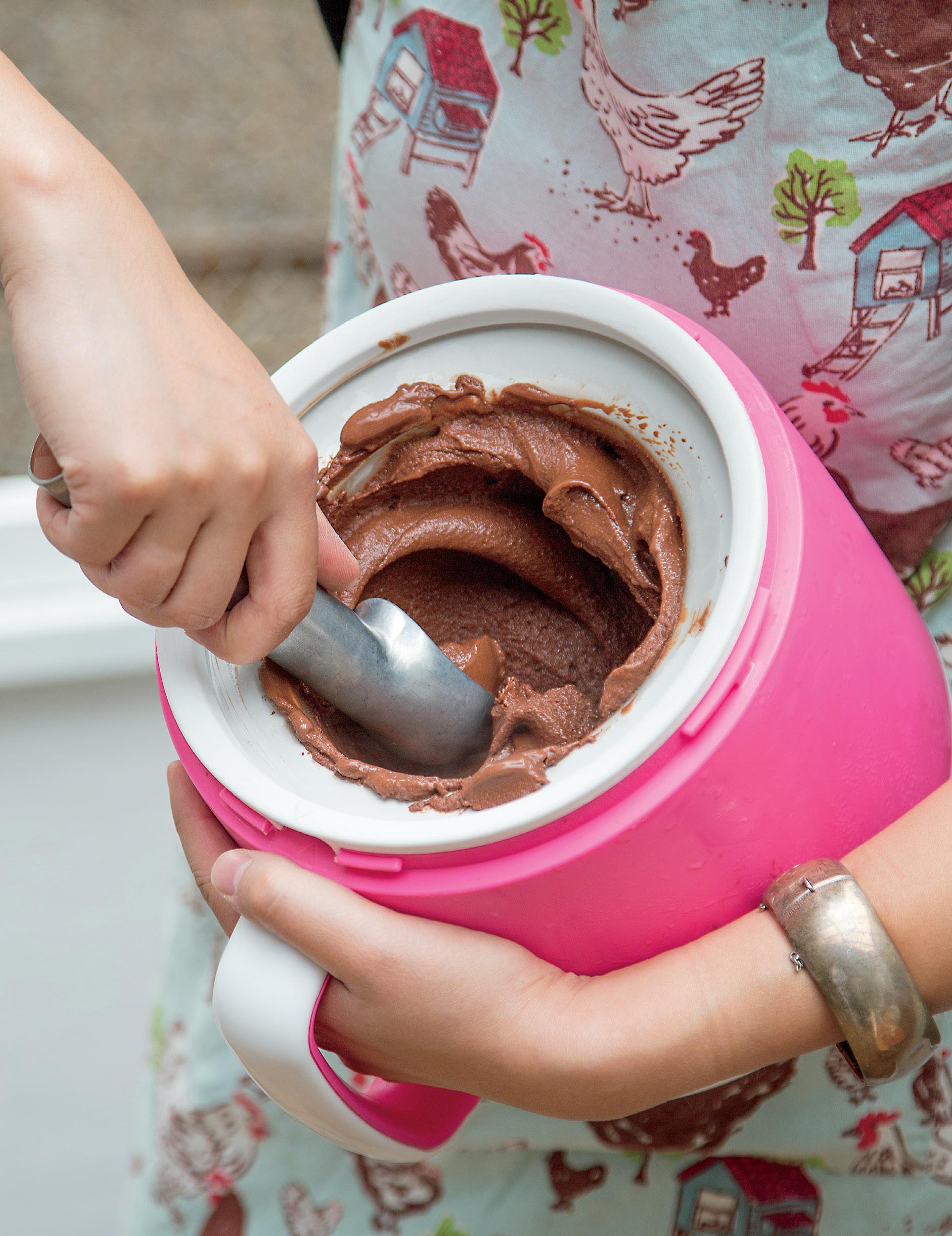

V
By Chef Renato Zeggara The Wellness Chef
www.thewellnesschef.ca @thewellnesschefptbo
ilma’s Rice Pudding is the perfect dessert for your fall picnic. The fragrant smell of orange and cinnamon brings back memories of my mother’s rice pudding. Growing up in Peru, “lonche” was considered an afternoon snack. Served around 5 pm, it could consist of anything from sandwiches to cakes, but it was a tradition for my mother to make rice pudding.
Every time I make this recipe, I’m taken back to late autumn afternoons in Lima, when the temperatures would drop, making the sweetness and aromas of this dish extra comforting. It was my mother’s secret to add orange peel to the traditional recipe. She passed away this spring but I know she would be happy that I am sharing her special recipe with all of you.
In Spanish, the dish is called “Arroz con Leche” which literally translates to “Rice with Milk”. Most LatinAmerican recipes use cinnamon but I find adding the cinnamon stick to the rice while it cooks guarantees more depth in the flavour profile.
Rice is commonly eaten daily, at every meal period, not only in Peru but all over the world. This recipe reminds us that rice can be enjoyed in a sweet dish as well as savory.
1 cup of Rice
3 cups of water
Rind of 1 orange
1 cinnamon stick
1 can condensed milk
METHOD:
½ cup shredded coconut
1/4 cup dried raisins
1 tsp Vanilla extract
1 tsp ground Cinnamon (to sprinkle on top)
1/4 cup chopped walnuts
1. Place Rice in a pot and add 3 cups of water, the orange rinds and the cinnamon stick.
2. Bring to boil, reduce heat to minimum. Cover with a lid and cook for 20 min.
3. Remove from stove and remove the orange rind and cinnamon stick. Let cool, uncovered.
4. Transfer cooked rice to a bowl and add all remaining ingredients.
5. Sprinkle with Cinnamon before serving.


EBy Chef Greg Couillard
Chef Chemong Lodge Instagram @chefgregcouillard
xecutive Chef Greg Couillard (Chemong Lodge) has graciously agreed to share one of his recipes with you! Chocolate Torte! What a decedant, delicious desert to surprise your guests! They have graciously decided to share it with you. The perfect desert to enjoy while sitting in front of the fire with your friends and family. We would love to see photos of your finished recipe! Chocolate Torte is perfect for by the fireside - indoors or out!
1 lb. Chocolate pieces
1 lb. Unsalted butter
8 whole eggs plus 8 egg yolks
TORTE DIRECTIONS:
1. Set oven to 300 degrees on low convect.
1/3 cup ground almond meal
1 tbsp. Vanilla
2. Parchment the spring form pan and spray sides with cooking spray.
3. In microwave melt butter for 5 minutes.
4. Pour over chocolate in a bowl and set over double boiler, whisking until melted.
5. Remove from heat.
GANOCHE INGREDIENTS:
1 lb. Chocolate pieces
2 1/2 lbs semi sweet dark chocolate chips
1 litre 35% whipping cream
2 ounces kahlua plus
GANOCHE DIRECTIONS:
2 ounces jamieson whiskey
2 tbsp. Unsalted butter
1 tbsp. Vanilla
1. In the stainless steel sauce pan heat the cream, vanilla and liquors until just before boiling.
2. Add the chocolate and chips and let sit until melted and whisked smooth adding the butter whilst whisking.
3. When smooth pour approximately 1/2 litre over cooked cake in springform turning and tilting the cake so it is evenly spreads.
4. Chill for another hour until ganache is set!
5. To remove springform, heat with torch and always use a heated knife to cut!
Follow Chef Couillard Instagram @chefgregcouillard


By Sky Hallett,
Olympia Restaurant in Lindsay has graciously shared their recipe for Lemon Creme Brulee with us! From their kitchen to yours! Introducing the Chef behind this recipe, the incredibly talented 20-year-old, Sky Hallett! Sky’s culinary journey began with a year dedicated to perfecting the classic vanilla bean crème brûlée. From there, she has skillfully expanded her repertoire to include delightful variations such as Belgian Chocolate and Earl Grey crème brûlée. Her newest creation, a refreshing Lemon crème brûlée, is a perfect addition for the summer season and has already received rave reviews from Olympia’s clients and customers.
Oven
10-12 RAMEKINS
Hotel Sheet Pan 3/4 C sugar
Pot
Whisk
Thermometer
Ladle
Micro-plane
Bowls
1. Preheat oven to 350ºc
2. Separate yolks from eggs into large bowl.
3. If using vanilla pod, scrape everything out and incorporate into sugar.
4. Add sugar into bowl with yolks.
5. Zest lemon directly into bowl.
6. Mix.
7. In a pot, very gently bring 1L of cream to 70ºc.
10 eggs
1L Heavy cream (35% milk fat)
Zest of 1 large lemon
Vanilla bean (optional)
8. Once temperature is reached, set pot and bowl close together with a wet towel around bottom of bowl to prevent sliding.
9. Using the whisk, start swiftly whisking contents of bowl.
10. Slowly ladle hot cream into eggs continuously whisking.
11. Once you have incorporated about 1 ladle (or 8oz), pour the rest in.
12. Make sure everything is thoroughly combined.
13. Put ramekins on tray, making sure walls are high enough to have water halfway up the outside of ramekin.
14. Transfer custard mix into ramekins until about ¾ full.
15. Put water in tray ½ way up outside of ramekins to prevent the temperature getting too high.
16. Cook 35 minutes until slightly jiggly.
17. Remove Brulee from oven then remove from water bath immediately
18. Leave at room temperature for 1 hour before chilling in fridge.
19. Brulee cream by spreading a teaspoon of sugar on top and torch until bubbly
20. Serve on decorated dessert plate
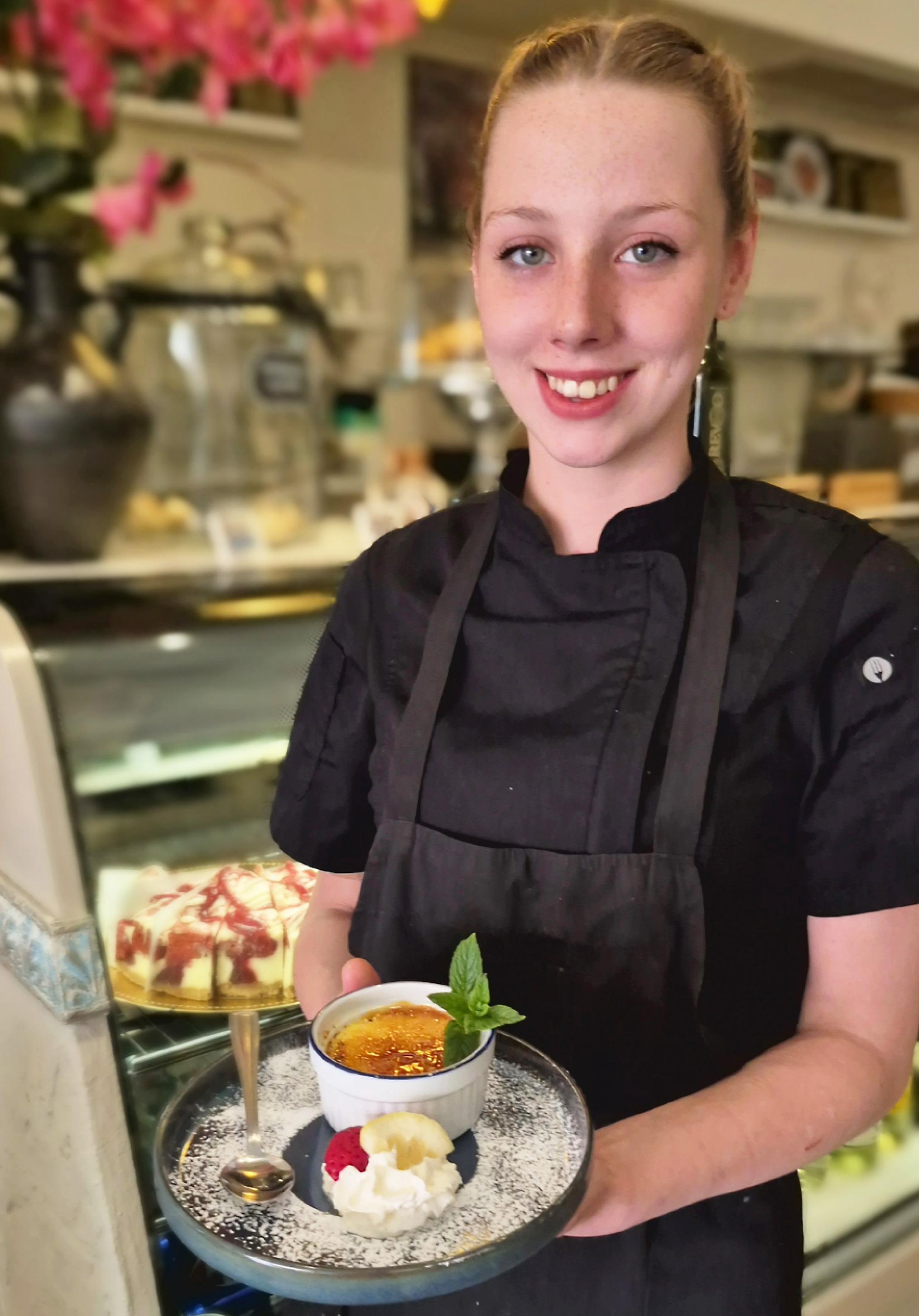

IBy Chef Brian Henry Food Editor A
f you were expecting me to write about how to cook the perfect turkey for Christmas dinner, crisp up your latkes for Hanukkah or up your candied yam game for Kwanza, it’s not happening. December is the most psychotic month of the year for me, not only as a chef but as a father with three of my four kids born this month.
It truly is a festive time of year in our household steeped somewhat in tradition and a world of spontaneous whimsy. Having kids of any age is the greatest way for traditions to be followed but also evolve creating themselves. Elf on the Shelf damn you forever.
My youngest has been counting down the days until Christmas since mid-October and announces how many more days until Christmas every morning as she emerges from her slumber. At bedtime the lights on the tree seem to add to the sparkle in her eyes.
Sharing baked goodies with family and friends is a common tradition at this time of year. Getting people to share their recipes is like asking them to donate a kidney. That said I’m sharing a couple of our family’s favourite recipes for the holidays that my kids request year-round and enjoy sharing with their friends. Have a great holiday season and don’t ask me for a kidney.
¼ cup butter melted
1 cup graham cracker crumbs
1 cup shredded coconut
1 cup chocolate chips
1 can condensed milk
METHOD:
1. Evenly spread the ingredients in a 9” glass baking pan, in order starting with the butter.
2 Bake at 350F for 30-35 minutes
3. Let pan cool down before cutting into bite size squares. Store covered at room temperature up to three days.

8oz butter at room temperature
1 cup brown sugar
1 egg
1tbsp. Vanilla
1 ¾ cup rolled oats
1 cup all-purpose flour
1 tsp. Cinnamon
¼ tsp. salt
½ cup crystalized ginger, chopped fine
½ cup toasted almonds coarsely chopped
½ cup dried cranberries coarsely chopped
¼ cup raisins coarsely chopped
½ cup chocolate chips
1 In eletric mixer cream together the butter and sugar.
2. Add the egg and vanilla to the butter mixture and beat again until smooth.
3. In a separate bowl combine all of the dry ingredients together and mix until evenly incorporated.
4. Add the dry ingredients to the butter mixture and gently combine the two at low speed until they are evenly mixed together but do not over mix.
5. Using a couple of soup spoons or cookie scoop to roughly form an inch and a half size scoop of dough and place them evenly spaced onto a parchment lined baking sheet.
6. Bake the soon to be cookies in a preheated oven at 350f for about 10 minutes, or until golden brown around edges, but still soft in middle. Do not bake longer than 10 minutes.
7. Transfer them to a cookie rack to cool and set. Store in an air-tight container for up to five days.

TBy Signe Langford Signe’s Kitchen www.signelangford.com
he Market in Lent Lane hosts a good old-fashioned pie contest in downtown Port Hope. 20 talented bakers handed over pies, tarts, and galettes to a panel of discerning judges, Yours Truly, among them. The theme was pies with a Canadian vibe using local ingredients. The competition was stiff and tasting 20 pies was tough, but hey, somebody had to do it, right?
There were three top prizes and two honourable mentions- Prettiest Pie and Most Fun. There could be only one First Prize, and that is Claire Holloway Wadhwani for her beautiful, seasonal Strawberry Basil Galette. “The kitchen is my happy place,” says Claire. “I love feeding people, and the joy that comes from gathering around food. I’m generally more of a savoury cook – my father was a pie guy. After he passed away, our tradition to mark his birthday and anniversary of his death by baking his favourite desserts. ”
PASTRY (Makes two galettes or one two-crust pie)
INGREDIENTS:
2 C all purpose flour
1 C cold salted butter – diced
½ tsp salt
6-8 tbsp cold water
1 egg, well-beaten + 1 tbsp milk-reserve for assembly
DIRECTIONS:
1. Add the flour and diced butter to a large bowl.
2. Use fingers to mix, until resembling a course oatmeal texture with some larger pieces of butter remaining.
3. Add cold water a splash at a time, gently mixing into the flour and butter mixture until it comes together into a ball.
4. Wrap in a beeswax wrapper and chill in fridge for at least 30 minutes.
FILLING (adapted from recipe at bakingtherapy.com)
3 C fresh Ontario strawberries – greens trimmed and halved
¼ C sugar
1 tbsp lemon juice
1 tbsp corn starch
1 tbsp basil – finely chopped
DIRECTIONS:
1. Add strawberries to a mixing bowl.
2. Add sugar, lemon juice, corn star and basil, then very gently stir until combined.
3. Chill filling for 15 minutes.

¼ C all purpose flour
1 tbsp sugar
2 tbsp cold salted butter
1 tsp basil – chopped
Mix all ingredients together in a small bowl using fingers to create a crumbly texture.
1. Pre-heat oven to 400F.
2. Onto a sheet of parchment or silicon pad, roll out dough into a large round, approx. ¼ inch thick.
3. Trim around the edges to create a smooth edge.
4. Pile the strawberry mixture in the centre of the round, leaving a 2-inch edge.
5. Carefully fold up the edge of the dough to cover the outer edge of the strawberry mixture.
6. Use a pasty brush to gently brush the egg and milk wash over the entire crust.
7. Sprinkle the top of the strawberries with the streusel.
8. Transfer to baking sheet and bake for 45-55 minutes or until nicely golden brown and bubbly.
9. Chill for at least 30 minutes before serving.

OBy Diane Rogers Doo Doo’s Bakery
ne of my favourite cookies to make during the holiday season is Swedish Tea Cakes. I personally make these delicious treats for my family. As a Baker, I need to be creative and offer unique butter tarts and deserts - especially at Christmas time. I hope you enjoy them as much as we do.
Ready in 40 Minutes
Makes 20 tea cakes
½ C Butter, softened
¼ C Brown Sugar, packed
1 Large Egg Yoke
1 C Flour
½ Tsp Baking Powder
½ Tsp Salt
1 Large Egg White, fork beaten
2/3 C Nuts, finely chopped (your favourite)
6 Tbsp Red Jam (your favourite flavour)
1. Preheat the oven to 325 degrees F
2. Cream butter and brown sugar in a large bowl. Add egg yolk and beat well.
3. Combine flour, baking powder and salt in a small bowl. Add to butter mixture, stirring until stiff dough forms. Roll dough into balls, using 2 Tsp for each.
4. Dip the balls into the egg white, then roll in nuts. Arrange balls, about 2 inches apart, on a greased cookie sheet. Dent each one with your thumb.
5. Bake for 5 minutes, then remove from the oven and press dents again. Bake for 10 to 15 minutes until golden. Let stand on the cookie sheet for 5 minutes before moving to racks.
6. Fill each dent with 1 Tsp of jam – if storing, store without the jam, and just fill the dents before serving. Enjoy!



CBy Chef Matt Chi @cinistac
rema Catalana, a Spanish custard flavoured with citrus and cinnamon and finished with carmelized sugar, is a lighter and easier version of crème brûlée. Make this gluten-free dessert to WOW a crowd at your next dinner party, holiday or special occasion. Makes 3 Ramakins.
5 egg yolks
1 C sugar
2 Tbsp corn starch / 2 Tbsp water
2-1/2 C whole milk
Peel of 1 orange (any citrus)
1/2 Cinnamon Stick (Char)
1. Whisk 5 egg yolks and 1 C sugar.
2. Make 2 tbsp cornstarch equal parts water to make a slurry.
3. Add slurry to egg yolk mixture.
4. Next, in a pot add 2 1/2 C whole milk, mix in citrus peels and charred cinnamon sticks (I use a blow torch).
5 Simmer on low for 3 minutes. Do not boil, remove peels and cinnamon.
6. Temper milk into egg mixture slowly (little by little).
7. Bring back to heat until it forms pudding texture.
8. Run thru skimmer to remove any lumps.
9. Pour into ramakin and chill over night.
10. Top with Sugar, Torch, orange zest.
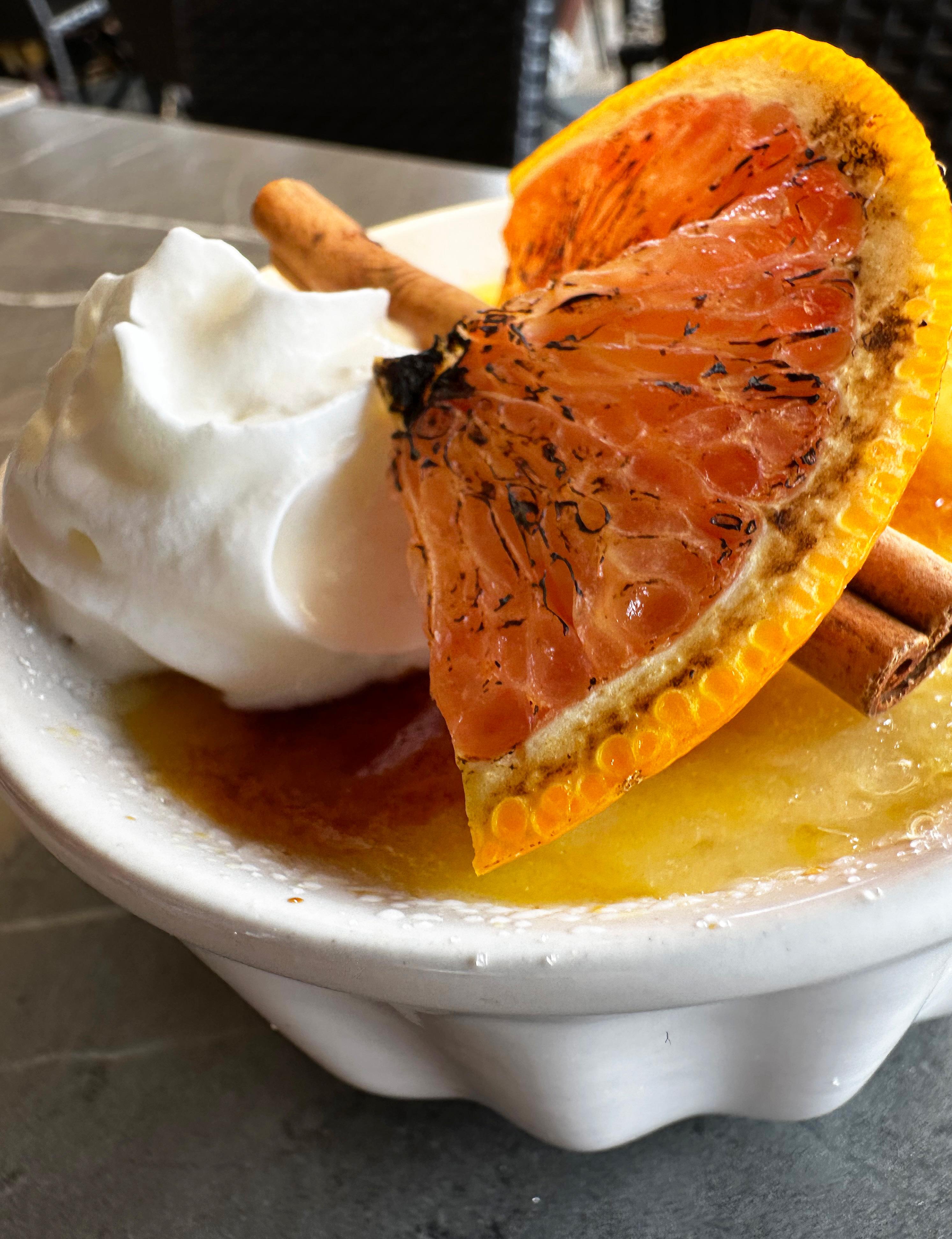



I nstead of slaving and sweating over your oven for hours cooking a turkey this holiday season, you may prefer to prepare another seasonally appropriate protein that your family and friends will enjoy.
Of all protein-based dishes celebrated over the holidays, roast chicken is the most versatile to pair with a wide variety of wines. Red or white, light or full-bodied, wines of many grapes, regions, terroir, and styles will harmonize with roast chicken.
It all depends on the preparation methods and side dishes being served.
Chicken has such a mild flavour. With its delicious juices and crispy skin smothered in full fat gravy, what wine wouldn’t work? Right? The fattiness and saltiness of gravy can even work with Canadian Icewine!
I say, however, that you consider saving your Icewine to serve with your holiday desert.
Pinot Noir is no doubt a safe wine pairing choice for roast chicken. It is a safe choice because the wine occurs as half white and half red. Meant to be slightly chilled and with
bright acidity like a white wine, Pinot Noir is light-bodied, dry, crisp, and complex with layers of flavours like a red wine. This French grape has enough delicacy to complement side dishes like pureed cauliflower or mashed potatoes and all the other trimmings, such as stuffing, carrots, etc. If serving Pinot Noir, refrain from sweet-based dishes like candied carrots. The sweetness will turn Pinot Noir’s refreshing acidity to rancidity.
Ontario’s wine regions are considered cool climatic zones and therefore ideal for producing world class, award winning Pinot Noir. Pinot Noir is the primary grape used in the vinification of Burgundy in Burgundy, France. Ontario’s wine regions are situated between 41-44 degrees latitude (the same Latitude as Burgundy, France). So Ontario’s wine regions possess the same cool climate as Burgundy, the ideal growing conditions for complex, thriving Pinot Noir vines.

by Shari Darling Journalist,
Our regions are located near the great lakes of Ontario, Erie and Huron. In each of the regions, the lakes moderate vineyard temperatures. In the winter the lake’s warm breeze keeps vines from freezing. In the summer the lake’s cool breeze keeps grapes from ripening too quickly. A slow ripening allows the grapes to attain a balance of sugar to acid. Our long cool summers allow the grapes to gain a high acidity level. Cool climate wines, such as Pinot Noir, are considered the best food wines. The reason is that this acidity cleans and refreshes the palate between bites. Said simply, Ontario Pinot Noir vinifies extremely well.
I have always been a big fan of Flack Rock Cellars Pinot Noirs. I once created a dinner around their 2011 Block Series of Pinot Noirs from 20 Mile Bench. The Block Series release was the result of an experiment that came out of trying to get a better picture of how their maturing vineyard developed and what went into their vineyard blend of Pinot Noirs. They did this to focus on different parcels of vineyard that show the nuances of clones in relationship to terroir.
This Block series consisted of 3 Pinot Noirs of different clones (DNA) grown within the same vineyard in the same year. So everything was identical except for the DNA of the vines. This was an incredible experiment, showing how DNA plays an important role in the resulting wine’s tastes, flavours, structure, and even complexity.
This Block series is available for sale from the winery yet again! This series of wine offers the uniqueness and sophistication required for holiday dining.
Here are some notes on this series:
- Colder, windier, north facing slope.
- Latest ripening = retains acidity, normally more intense due to slow ripening.
- Low crop naturally due to wind exposure.
- Clone 667: dark berries, more colour, touch of tannin.
- Heavier clays = slower to develop. Northern-most block; next to escarpment / Bruce Trail.
- Slight south facing slope.
- Clone 115: thicker skinned, more tannin & colour extracted.
- Loamy soils with shallow bed of limestone beneath.
- Very low vigour & naturally low cropping.
- Takes longer to open up & develop due to structure.

When partnering wine to barbecued foods, keep the taste and flavours of the side dish in mind. Wine can complement a whole range of side dishes that can be served with BBQ fish, chicken, pork, or beef.
If preparing barbecue pork ribs done in a spicy dry rub, off set the seasoning with a salad containing some sweetness.
So, the natural sweetness of the grape salad will counter balance the spicy rib dry rub.
Halve about 2 pounds of seedless red and green grapes and place in a bowl. Add a half cup of cream cheese to the grapes and mix together. Toss in about 3/4 cups of toasted walnuts and season with a pinch of salt. The pleasant bitterness from the nuts help to reduce the sweetness of the grapes, thereby making the salad more wine friendly. Remember you want the wine to be sweeter than the salad.
Barbecued pork ribs and a sweet white wine
will also harmonize with a spicy peach and avocado salad and an orange-olive romaine salad with herbed vinaigrette. Woodbridge by Robert Mondavi Moscato, (CSPC 199216), $13.25, is an off dry white with lots of apricot honey aromas and flavours, some sweetness, but with good acidity for balance. The wine will work with the ribs and salad. Be sure to put the wine in the refrigerator for at least 2 hours before serving.
In the summer I absolutely crave barbecued salmon seasoned with lime chili dry rub. BBQ salmon tastes super delicious when paired with avocado fries. Avocado fries are also fatty. This combination can then be paired with a big, fat white wine like barrel fermented and aged Chardonnay. To make these fries, preheat the oven to 400 F. In a bowl combine 2 cups of breadcrumbs with 2 teaspoons of chili powder and a half teaspoon each of sea salt and freshly ground black pepper. Place the mixture in a bowl. In another bowl pour 2/3 cups of buttermilk. And in a third bowl add 2/3 cups of flour.
by
Working with 3 ripe, but firm avocados, cut them each into 6 wedges. Dip each wedge in flour, then in buttermilk and then in breadcrumbs. Set the coated wedges on a cookie sheet sprayed with non stick cooking spray. Repeat the process for all wedges. Bake for about 30 minutes until the wedges are golden brown.
Meanwhile prepare the dipping sauce. In a bowl combine 3/4 cups of mayo with 2 finely chopped chipotles in adobo sauce, 2 teaspoons of fresh lime juice, a half teaspoon of chili powder, and salt and pepper to taste.
Serve the avocado fries with your BBQ salmon and a chilled glass of barrel fermented and aged Chardonnay. I’m a fan of Chateau des Charmes Barrel Fermented Chardonnay VQA, (CSPC 81653). This wine is a steal at $14.95. It showcases aromas and flavours of classic apple and pear with a hint of toast and mineral notes on the back palate. The mouth feel is rich and creamy and able to stand up to your super Omega 3 barbecue dinner.
If making beef burgers with melted brie on the barbie, prepare a roasted red pepper pasta salad. Serve a slightly chilled Merlot as an accompaniment.

S ometimes it’s fun to forgo dinner altogether and put together a plate of favourite local cheeses, along with some olives and toasted almonds to pair with a glass of harmonizing Ontario wine.
Here is a list of combinations you may want to try for yourself:
Celebrity Herb and Garlic Soft Goat Cheese, Lenberg Farms Tania hard pasteurized Sheeps Milk, and Lenberg Farms Lindsay (Bandaged Goat Cheddar).
Sauvignon Blanc’s zesty acidity marries extremely well with all soft goat cheeses, including this herb and garlic version. It is the zesty personality of fresh goat cheese that complements all white wines offering a good backbone of acidity. Other wines with zesty acidity include Pinot Grigio and Pinot Gris.
Tania is a delicious Tuscan-style sheep’s milk cheese from Lenberg Farms and is made with 100% Ontario Sheep’s milk. Aged for six months in temperature and humidity controlled maturation rooms, the cheese develops a semifirm, smooth and slightly crumbly texture while maintaining its creamy, mellow yet somewhat earthy notes and saltiness. This cheese is a local alternative to Pecorino. The zesty acidity in Sauvignon Blanc nicely counter acts the saltiness of Tania. This is in much the same way as brut, acidic Champagne works with salty caviar or salty smoked salmon. Or to offer a less wine savvy example, salt and vinegar chips.
Lindsay bandaged goat cheddar is an award-winning cheese, handcrafted in small batches using premium Ontario goat’s milk. The crafted wheel is carefully wrapped in its bandage to preserve freshness and flavour. After aging in a humidity controlled room for 12 months, Lindsay is ready to enjoy with a glass of zesty Ontario Sauvignon Blanc. This cheese is creamy with a slight goat’s milk tanginess and also some fruity flavours.
Trius Sauvignon Blanc VQA, (CSPC 221804), $15.95, offers classic citrus and gooseberry flavours on the nose and palate. A hint of minerality comes through on the finish. The wine is light and crisp with stinging acidity that partners with the tanginess of soft goat cheeses. The wine’s acidity also offsets the saltiness in cheeses.
Empire Medium Cheddar with Caramelized Onion, Empire Medium Cheddar with Canadian Maple Mustard, and Celebrity Chipotle Soft Unripened Goat Cheese.
Celebrity cheese comes from Mariposa Dairy in Lindsay. The first two cheeses have some sweetness that need to harmonize with sweetness in some white wines. The Chipotle spice and sweetness in the unripened goat cheese is nicely matched to the sweetness
in an off dry white wine. Sandbanks RieslingGewurztraminer VQA, (CSPC 459982), $15.95, offers apple and floral notes on the nose and palate. The palate is medium bodied with some honey sweetness. The wine’s sweetness will partner well with all three cheeses.
SMOOTH CHEESES: Empire Mozzarella with Garlic Empire Mozzarella with Roasted Garlic and Red Pepper Empire 2 year old Cheddar
The mozzarella cheeses have a smooth texture, making them a good choice to pair with Merlot’s smooth texture. The 2 year old Cheddar has some saltiness and bite that is also nicely offset by Merlot’s soft tannin and astringency. JacksonTriggs Reserve Merlot VQA, (CSPC 109959), $14.25, offers classic cherry and cassis aromas and flavours with soft to medium body and soft tannin.
DESSERT CHEESES: Celebrity Cranberry, Cinnamon Goat Cheese, and Celebrity Blueberry and Cinnamon Goat Cheese
Kawartha Country Wines produces a few ‘social’ wines that range in sweetness from 2 to 4 on the sugar code scale. Apple Social and Cranberry Social compliment the flavours in the Celebrity Cranberry Cinnamon goat cheese. Wild Blueberry Social is sweet and smooth with loads of blueberry fruit flavours. It’s ideal with the Blueberry and Cinnamon Goat Cheese. Apple Social and Cranberry Social compliment the flavours in the Celebrity Cranberry Cinnamon goat cheese.

T here are lots of lovely wines to sip this spring with a wide variety of dishes.
For example, Anselmi 2017 San Vincenzo, (CSPC 948158), $17.95, is a crisp, dry white from Veneto, Italy. Vinified from a Garganega blend, this white shows big aromas of peach and pineapple with some herbaceous notes. The palate is full bodied with crisp acidity, ripe pear and herbaceous notes here too, with pleasant bitterness on the back palate. Anselmi San Vincenzo is a nice alternative to Sauvignon Blanc.
My girlfriend, Cathy, prepared a Chevrebased dip, which we enjoyed with crackers and a glass of this crisp white. A stunning pairing, indeed! To the cheese she added diced Kalamata olives, diced sun dried tomatoes, fresh garlic, and fresh basil. Chevre has natural acidity that harmonzed extremely well with the wine’s crisp acidity. Kalamata olives are salt. This saltiness complemented the wine’s pleasant bitterness.
If it is too much work or too hot to barbecue, consider pairing this wine with take out pizza, highlighting Chevre. The tangy Chevre acts as a bridging ingredient, bringing the dish and wine into partnership. Some of its best matches include chicken and artichoke pizza with Chevre and Parmigiano; arugula and Chevre pizza with Parmigiano; zucchini and Chevre and Parmigiano pizza; chicken, pesto, and Chevre pizza; and lastly prosciutto and Chevre pizza. I’ve included the Parmigiano in
by Shari Darling
many of the pizza choices as it is salty. This saltiness actually softens the wine’s natural bitterness.
I served to my girlfriend, Teresa, a glass of 2013 La Pieve Barolo 2013, (CSPC 213132), $39.95. Boy, oh boy, was this an outstanding red! The nose brimmed with flavours of fresh raspberries, currants and earthiness, like wet soil. Wet soil in this context is a good thing! The palate had mid-weight with firm, but not over bearing tannins, dark berry fruit and a long finish. This wine is elegant and bold at the same time.
We enjoyed this wine with baked grain free gnudi tossed with fresh tomatoes, basil, Parmigiano, and smothered in mozzarella. This red has enough weight to stand up to ribs and grilled steak. Stay away from sweet sauces that will corrupt the wine’s lovely tannin. La Pieve Barolo works with any pizza highlighting pepperoni, bacon, chorizo, and Italian sausage.


WBy Bonnie Moore Woodland North
ith increased home time, many are getting creative and relaxing while sharing a cocktail on face time! While not counting calories, we are going to give you an ‘experience’ when it comes to sipping a smile, tipping the sunshine and chillin’ like a villain!
First up is Ocean Dream. Combining a few mixing blunders and a few hangovers, we arrived at a cute little drink that is blue, cool and looking to make you drool! With a sweet mix of coconut, rum and Curacao, this little number will make you sip by the pool with a smile on your face, dreaming dipping your feet in the ocean.
1 oz. canned coconut cream
2 oz. Pineapple juice
2 oz. 18% Cream
1 cup Ice
1 oz. Coconut Rum
1 oz Curacao Blue
Top Rim with Sugar, add a blue paper straw
Dip rim of glass in lemon juice then rim with sugar

A play on summer is Mermaid Rum Punch (my favourite)! With a hint of pineapple and banana, this drink brings a nice way to cool off at the pool, without diving in. My favourite!
In blender combine:
1 banana
4 oz coconut cream
1- 12 oz can of frozen Lemonade
2 oz. Pineapple juice
1 cup ice
4 oz. Curacao Blue Liquer
5 oz. White Rum
Garnish with pineapple, kiwi and gold paper straw.


Gin Rose Petal Cocktail, made with organic rose petals, gin, sparking water and some really neat floral ice cubes, this brings the elegant and romance of everything we want in a drink right to our palm. This last low carb drink made with a splash of rose water and topped with a bit of edible glitter, it just makes the perfect ending to a day while you relax.
4 tsp fresh lemon juice
sparkling water to top up
Pre-made 4 floral ice cubes(organic flowers only)
90 ml of Gin
1 tbsp dried organic Rose Petals
2 tsp of Rose water ( see directions on how to make Rose Water )
1/3 cup Water
Top with Edible Glitter, add a pink paper straw.
By Madison Gallimore
N othing feels better than to indulge in tasty beverages to kick off the holiday season! These drinks will stir your creative juices for something more festive in your cup. This isn’t
The Sleigh Ride will satisfy your chocolate cravings and is perfect for Christmas movie marathons.
4 tbsp chocolate syrup
1 tsp vanilla extract
Whipped cream
1 cup whole milk (easily substituted with oat or almond milk)
2 oz Kahlua
1 oz Peppermint Vodka
1 oz Baileys
Cranberry Christmas is a low sugar cocktail serves as a healthy twist for the holidays.
Cranberries
Lime slices
1/4 cup 100% pure unsweetened cranberry juice
1 cup club soda
1 tsp agave nectar
Last but not least is the Gingerbread Cookie Crunch. With a sweet blend of gingerbread and cinnamon, this cocktail is a perfect mistle-toast to the holiday season.
1 oz gingerbread syrup
¼ cup honey
Gingerbread cookies
3 cinnamon sticks
1 tsp vanilla extract
1 cup whole milk (can substitute for oat or almond milk)
1 oz Kahlua
1 oz Vodka
1 oz Baileys
These easy drink recipes can bring a flavour of fun to the room and look amazing while you serve them.

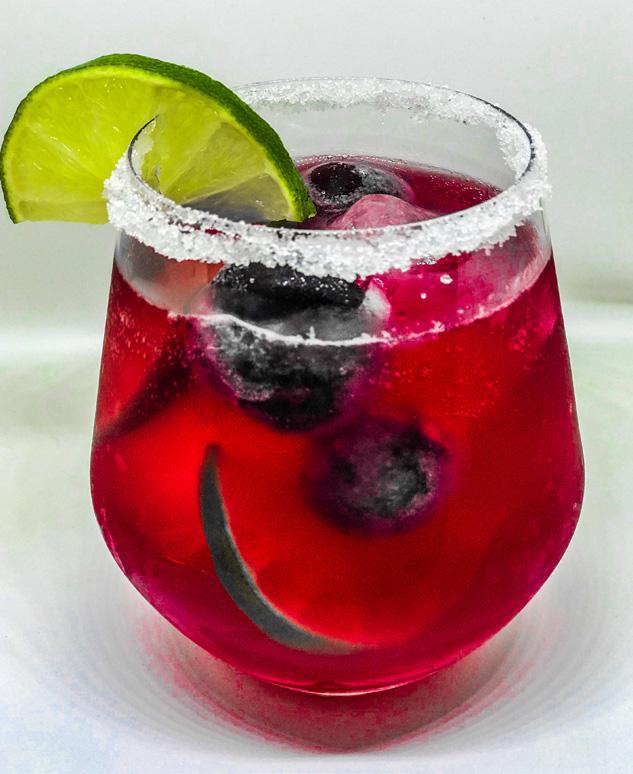
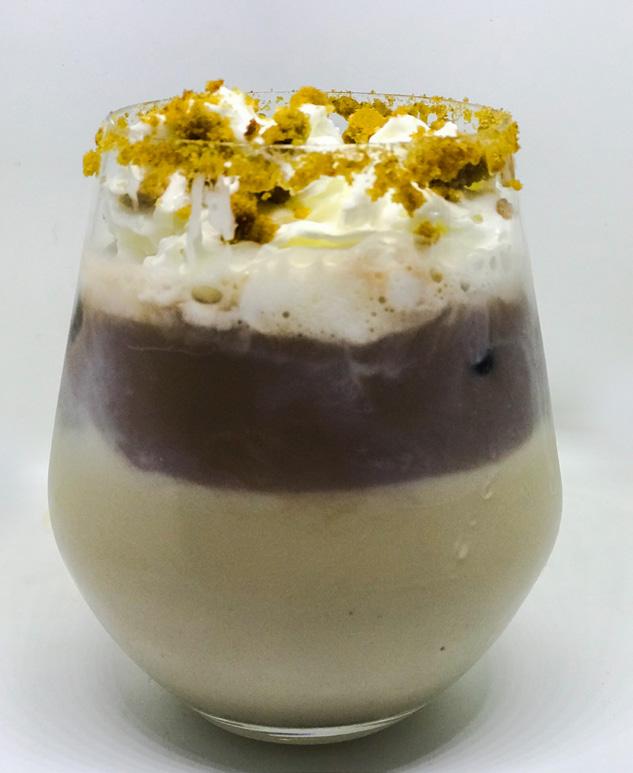
“Don’t
What is a picnic? Well according to Google and every dictionary out there, “it is an outing or occasion that involves taking a packed meal to be eaten outdoors”. Since the beginning of civilization, people have been enjoying the delights of picnics all over the world in every season.
And now the sweet smell of fall permeates the air. There is a crispness in the early morning, and a deeper golden sun setting, so what better time to pack a picnic hamper and head out for a little “couple time.” I know, I know, the men who are reading this are rolling their eyes and I know for a fact my husband is doubled over with laughter saying “Not a chance in H-E double hockey sticks!!”. But wait, this isn’t a picnic for Yogi and Boo Boo, this is a picnic for the discerning adult.
Picture a bottle of chilled wine, a charcuterie board of finely cured meats, cheeses from around the world and gourmet chocolate! If you do not have a picnic hamper a cooler or even a box will do. And I know for a fact all of these ingredients are supplied by the shop owners and advertisers in this wonderful magazine.
picnic hamper. You just need to add a blanket or 2 just in case that slight chill in the air drops to minus 3. It is Ontario after all!
Yes, this still sounds like romance to most guys and the grimaces on some faces have deepened, but look at it this way, your spouse gets a little romance and charm and you get a belly full of fine treats! What’s better than that?

Jennifer Boksman
@needfulthings2021 15 Cambridge Street South Lindsay 705-878-2001
At Needful Things in downtown Lindsay, I have a beautiful array of over 50 wines from around the world. Whether it be red, white, rose or sparkling I’ve got you covered.
Now that there is a chill in the air I lean towards the reds, (red gives me a feeling of warmth and coziness), but there is something to be said about a chilled white wine while sitting by the lake with that
As a kid growing up in this area, picnics were a huge part of my life. Whether it was in town at the locks after school, watching the boats go by in early summer or at home on our very own picnic table this was a highlight of my youth.
As an adult my tastes have grown from hotdogs and ice cream sandwiches to fine meats and cheeses and even finer wines, but it is nostalgia that keeps me dreaming of picnics past.
So pack up the spouse, pack up your kids, pack up the dog, he’d like an outing as well and pack up everyone’s favourite treats and head to the park or to the lakeside or the picnic table just outside your kitchen (where the bathroom is closer). Just do not forget the corkscrew!!!
Until next time, happy Fall season! Chat soon, Jennifer

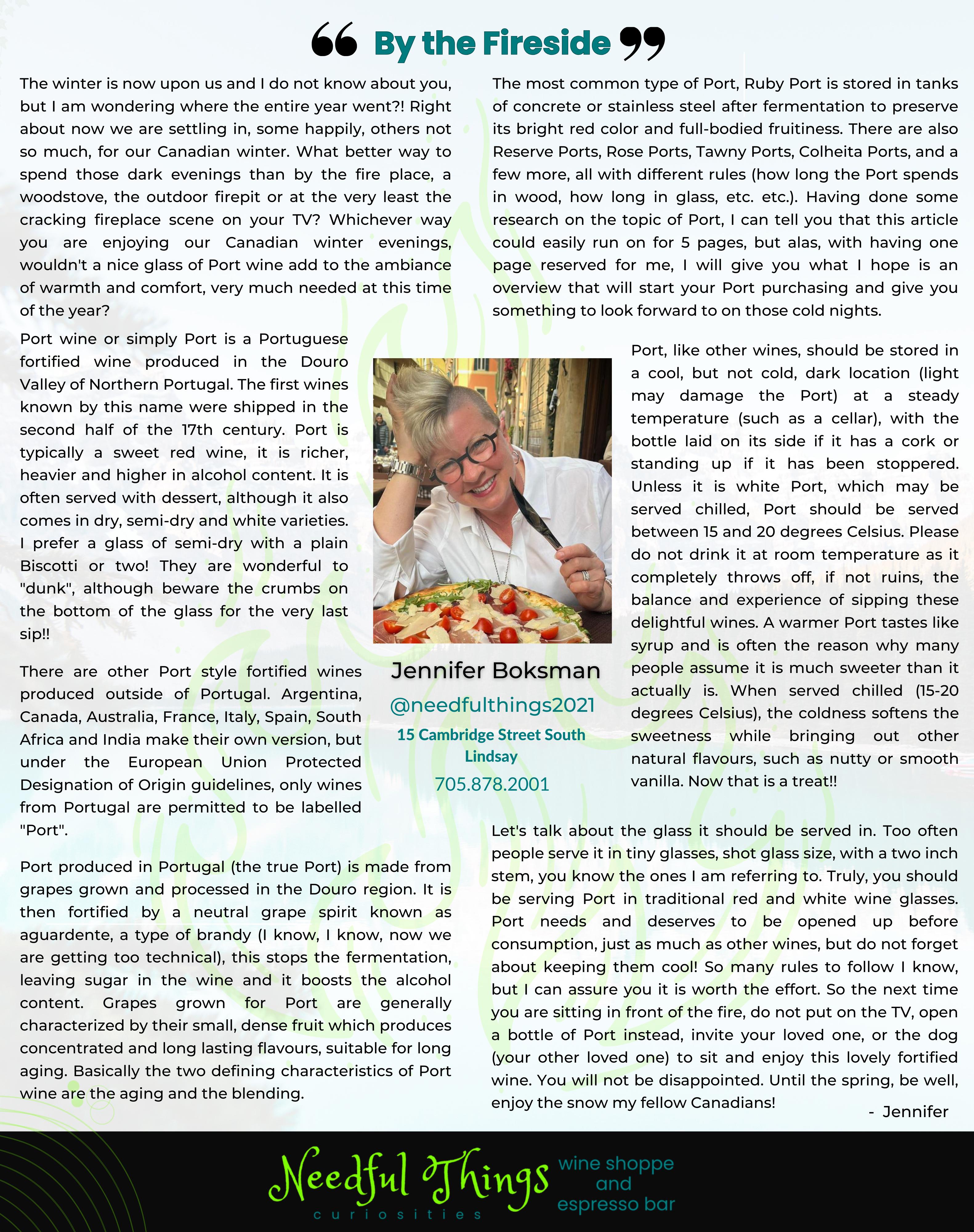
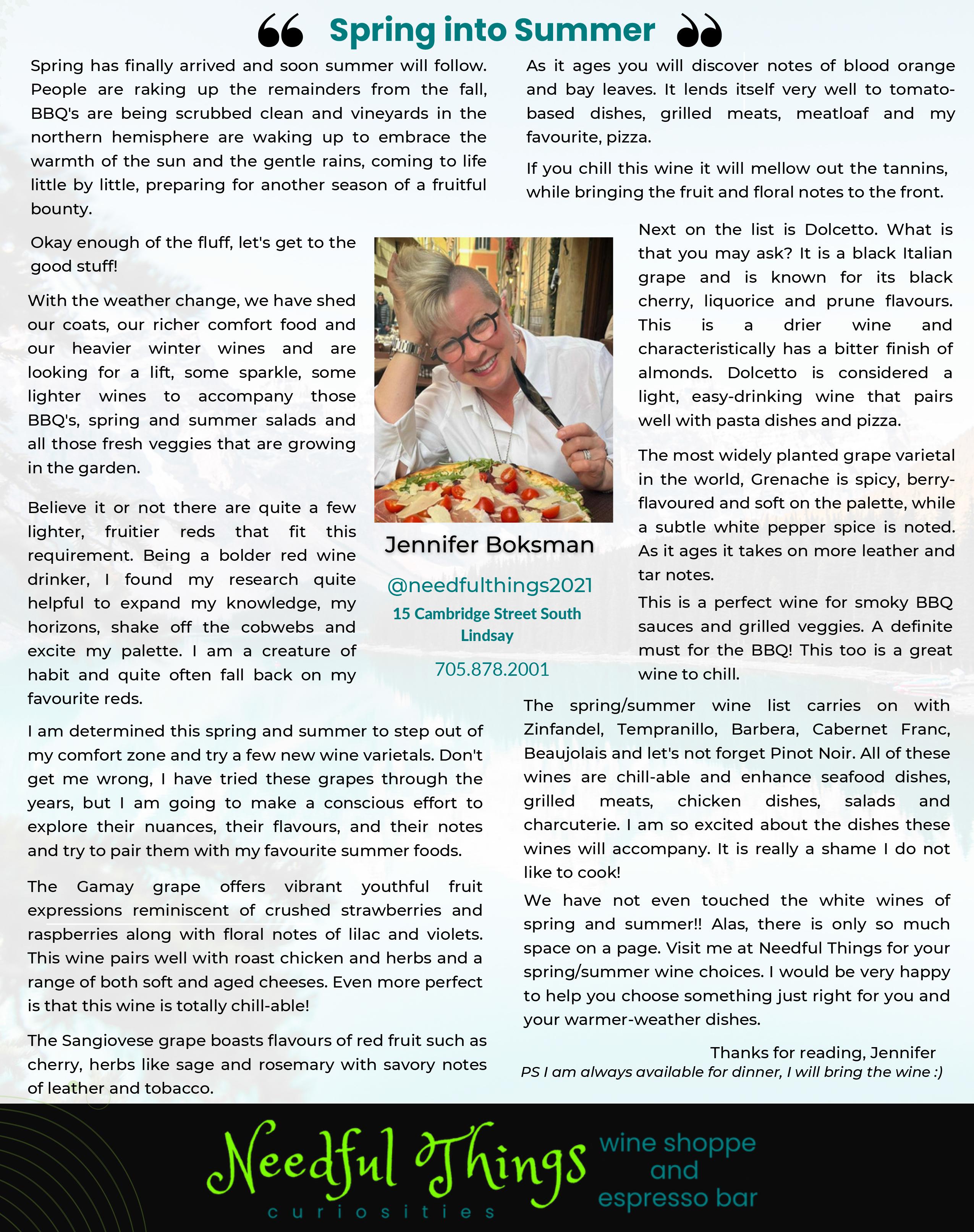

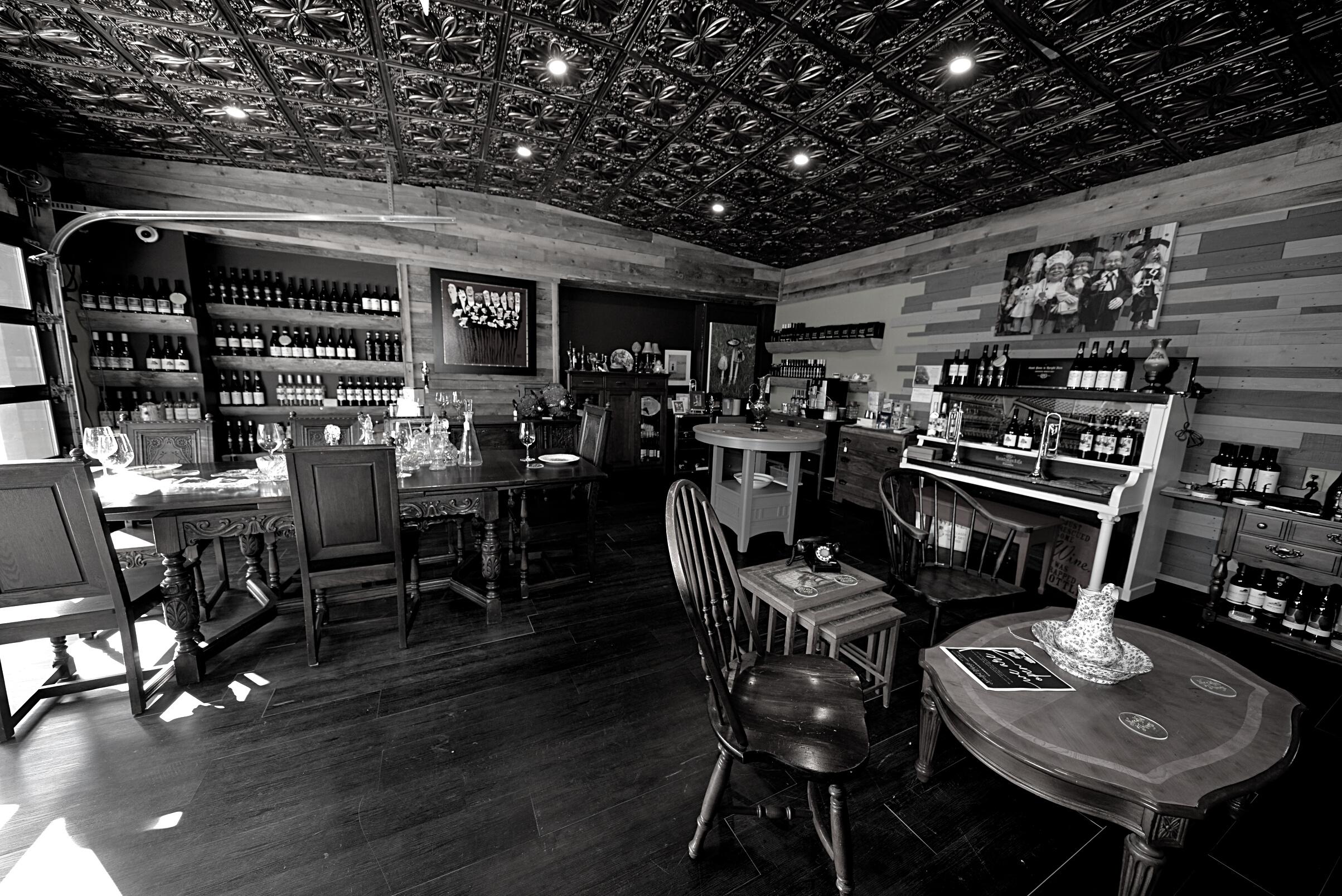
Hi everyone, Jennifer from Needful Things in Lindsay here!
Fall is upon us (not sure where the summer went, but alas it has gone). What does that mean here in the Kawartha Lakes region? Mist rising from the lakes and rivers in the early morning, chipmunks and squirrels running around like mad little creatures trying to seek out and remember where and why they are hiding their winter stash, the smell of leaves as they turn colors in the cool nights and the thought of "what's for dinner?" to take away the chill.
In Ontario, the fall harvest consists of apples, carrots, Brussels sprouts, potatoes, mushrooms, squash, and pumpkins just to name a few For all the great cooks out there that harvest fills your kitchens with pasta and pumpkin brown butter sauce, pork loin braised with mushrooms, delicious chicken pot pies, hearty stews, curried apple and carrot soup, pumpkin soup, pork chops with sage butter and beet puree topped with swiss chard (just to name a few delicious recipes). I am drooling already!
For those of you who know me, you are aware the kitchen is not my territory. I am not a cook, I can cook, but do not like to and therefore avoid it at all costs. Although somehow I always end up on cleaning duty! However, I do love to eat and I do love to pair a lovely wine with those beautiful fall dishes that make you feel warm and cozy inside Add to the feel of that slight chill of fall and the lovely warmth of the fireplace you may be sitting in front of by including the best thing in the whole world a wine that matches the spicy scents of fall with just a hint of the forthcoming crispness that winter will bring.
For that apple and carrot or pumpkin soup a beautiful chardonnay will do the trick For heavier dishes such as stews with beef or game try that amazing Italian Barolo or that spicy Australian Shiraz, even a red Zinfandel from California with its spicy berry and pepper flavors will enhance the dish and have your taste buds dancing with delight! Making a mushroom recipe? A Pinot Noir is a perfect choice. Pork on the menu tonight? A lighterbody Pinot Noir or a Chardonnay from California is your best bet.
If I am on the porch wrapped up in a blanket watching the setting sun, I like to sip on a Merlot with its hints of berry, plum and currant. The fresh air outside brings out a different side to any glass of wine (try it, no matter which wine you are drinking, go outside for a while, smell the wine, sip it tenderly, and after an hour take the glass inside, sit down, sniff its aromas and taste the difference!) Outside is also a great spot for a Shiraz and its spiciness to take over your senses
Our four seasons in Ontario offer a titillating thrill to the senses. Fall in my opinion being the best for your sense of smell Follow your nose (it always knows) into the world of wines and the aromas of fall If you are not sure what wine to choose I am always happy to help
Until next time, enjoy the season!!!

15 Cambridge Street South Lindsay
- Jennifer

Hello readers! With spring fast approaching dreams of outdoor BBQ’s are coming to fruition and with that, the idea of which meat to grill is the big question. Whether it be a BBQ, a Green Egg, an open fire or a fancy smoker, meat has been the centre piece of culinary culture around the world for centuries and wine has always been the preferred accompaniment. A nice glass of wine elevates those meaty dishes.
Hearty, robust meats need a sturdy wine. If you’re having a juicy ribeye or a tender fillet (my personal favorite), opt for a classic Cabernet Sauvignon from Napa or Italy. The tannins in this wine soften the fat of the meat, creating a mouthwatering combination of flavors. The richness of a good Cabernet will complement the savory profile of beef beautifully.
For Sunday dinners with roast beef, consider a medium-bodied Merlot or a Malbec. These wines have a juicy fruit character that complements the roasted flavors of the beef. Having grown up with Sunday dinners (though without wine), I can now attest to how these wines enhance the meal, making it even more enjoyable.
Pork, with its versatility, pairs well with a variety of wines depending on the preparation. If pork chops are on the menu, a Chardonnay with some oak can be a surprising match. The oak enhances the juiciness of the pork, making it richer. If you’re like me and prefer red wine, a Grenache’s fruity profile will be a great choice, balancing the flavors of the pork without overwhelming it.
fully with a buttery Chardonnay or a light red like Pinot Noir. These wines offer balance, complementing the chicken’s flavors without overpowering them. If grilling chicken, choose a Sauvignon Blanc. Its crisp, refreshing acidity cuts through the richness of the grilled chicken, creating a clean and delightful pairing. I particularly love Sauvignon Blanc from New Zealand and Italy, as they bring unique flavor profiles to the table.
For wild game meats, such as venison, consider a Barolo (remember, it’s the King of wines) or a Pinot Noir. These wines pair brilliantly with venison’s rich, gamey flavors. If duck is your choice, try a Cabernet Franc. It offsets the fatty profile of duck with good acidity and fruit, offering a balanced and delicious pairing. Quack! Quack!

Jennifer Boksman @needfulthings2021 15 Cambridge St S Lindsay 705-878-2001
When barbecuing pork, the smoky, sweet flavors require a Zinfandel or a spicy Shiraz. These wines offer fruity depth that complements the savory-sweet nature of BBQ pork, making for a well-rounded pairing.
For lamb, with its distinct flavor, try a Tempranillo. This wine’s earthy and slightly herbal notes complement lamb chops infused with rosemary and garlic. For roast lamb, a Syrah is a great match, bringing peppery and gamey nuances that enhance the richness of the meat.
What about chicken? It’s the most popular meat in households, after all! A roast chicken pairs wonder-
Before we start grilling, roasting, or smoking, a charcuterie board is always a great way to begin. Try serving Prosecco to kick things off. Its acidity and bubbles cleanse the palate, preparing you for the meal to come. Even the men in your family will enjoy it once they stop “poo-pooing” the idea that Prosecco is “for girls!”
Pairing meat and wine is a tradition that will last for generations. With such a vast range of flavors, aromas, and textures in both meats and wines, the possibilities are endless. Trust your taste buds, experiment, and enjoy the experience—food and wine are some of life’s greatest pleasures.
My shop, Needful Things, in downtown Lindsay, carries all the wines mentioned above. I’d be happy to help you pick the perfect wine for your meal.
Enjoy your meat! Chat soon, Jennifer.



Well, it's finally summer, I can tell as the Delphiniums have broken through the hard ground and birds are singing their little hearts out. We have chatted about wine and food, types of wine varietals, red versus white, so let's add a new element to the conversation. Chocolate! Yes, let's chat about chocolate.
It all started in Latin America. The Olmec, one of the earliest civilizations in Latin America, were the first to turn the cacao plant into chocolate They drank their chocolate during rituals and used it as medicine. Centuries later the Mayans praised chocolate as the drink of the gods
Fast forward a few centuries you now find the cacao tree grown by 40-50 million cocoa farmers in more than 50 countries around the world! Who knew?
Wine and chocolate have a lot of similarities believe it or not For one, they are both considered aphrodisiacs and they both contain antioxidants (remember the Olmec and medicine?). They are both derived from fruit and fermented as part of the creation process. Also the terroir is important in the growing of grapes and cocoa The climate, the soil, the terrain influence the fruity, floral, earthy and nutty aromas found in both amazing products
Intensity is also something to match. If you pair a dark-flavoured chocolate with a heavy, full-bodied red wine, the intensity of the red will fill you with delight!
However, pair a strong tasting chocolate with a delicate wine and you will destroy the wine.
A true shame. Remember light flavoured chocolate pairs well light bodied wines and intense flavoured chocloate prefers to stand along with full bodied wines.
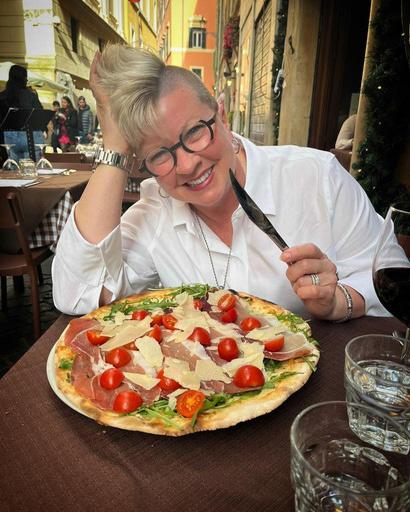

@needfulthings2021
15 Cambridge Street South Lindsay 705.878.2001
So how do wine and chocolate go together? Well, firstly they are 2 of the most amazing things on earth, yes I said that previously, but it bears repeating! Both bring joy to your senses in their own way, so why not pair them together?
But before you pop that cork and tear open that gorgeous box of chocolate there are a few things you should consider so you do not ruin the taste of both your treats.
Most pairings in life involve a balance, however, when it comes to matching chocolate and wine it is best to avoid opposites.
Sweeter chocolate, like white chocolate is much better when served with sweeter wines and bitter, dark chocolate enjoys being paired with dryer wines. Best to choose a wine that is equally or slightly sweeter than the chosen chocolate
Do avoid pairing Champagne with chocolate. Sounds romantic to the ladies, but truthfully the Champagne tends to be too dry and astringent to be paired with chocolate.
Here is a simple and handy reference guide for you.
White Chocolate pairs well with Reisling, Gewurztraminer, Pinot Noir, Beaujolais and Rose Port.
Milk Chocolate pairs well with Petite Syrah, Sherry and Ruby Port
Dark Chocolate, my absolute favourite, pairs well Zinfandel, Shiraz, Grenache, Merlot , Pinot Noir and Cabernet Sauvignon
After many years of experimenting I prefer a dark chocolate with my wines Full bodied reds are my "go to" I am a creature of habit and do not wish to be disappointed when it comes to wine and chocolate. Find which pairing satisfies you the most Since wine and chocolate truly are some of the best things in life it is fun to explore and see what your taste buds like the best.
At my little shoppe, Needful Things, 15 Cambridge Street S. Lindsay I have over 40 wines from around the world and have recently added Centre and Main Chocolate, made by the amazingly talented Chocolatier Angela Rouest of Warkworth, Ontario Come and check us out!
Thank you for reading, have a wonderful summer, hope to see you on my new patio
- Jennifer

At long last, the Canadian summer is upon us. In the Kawartha Lakes that means boating, camping, gardening, bbq’s, waterskiing and lovely nights on the deck. Summer as you are fully aware is the hottest and the brightest of the four temperate seasons. And it is especially important as it is the growing season of food staples, regardless of where you live in the world!
We have talked about wine in many editions of A Taste of the Kawarthas magazine. This time, I thought we should investigate how a beautiful bottle of wine starts ... its’ humble beginnings in a vineyard.
The annual grape cycle starts with the bud break, followed by flowering and fruit set, leading to berry development and ripening. This culminates in harvest followed by dormancy in the fall. To grow grapes successfully, they must be planted in a sunny location with well-draining soil. Grapes typically take 2-3 years to produce fruit after planting. The plants require 6-8 hours of sunlight per day, rich, organic soil, 50-100 square feet per vine if growing vertically, or 8 feet between rows if planted horizontally. They also require a support system, a fencing structure for the vines to grow and climb. A lot of effort, time and money is spent readying a vineyard!
wine, often in oak barrels, before filtering and bottling.
After being bottled, wine is typically stored in a cellar or warehouse to age further. The aging process allows the wine to develop its flavours and aromas. Some wine may be kept for years before being released.

Jennifer Boksman
@needfulthings2021 15 Cambridge St S Lindsay 705-878-2001
A standard 750ml bottle of wine contains 400 to 800 grapes. Who knew?! This number varies on many factors - such as the grape variety, cluster size and winemaking techniques. The age of a wine producing vineyard may vary from 25-30 years old. There are vineyards in Tuscany that are 400 years old and a vineyard in the Loire Valley in France that is thought to have been active as early as the year 1000 AD. That’s old!!
After the grapes are harvested, they undergo several processes, including sorting, destemming, crushing and fermentation. Jeepers! That, too, is a lot of work!! Winemakers then age the
When you consider how hard the grapevine had to work to produce the grapes, as well as the daily working of the vineyard to get the wine into a bottle, and let’s not forget Mother Nature “doing her thing” while the wine is cellared, the process of opening a bottle of wine does require and deserves the pomp and circumstance that is associated with the opening. Starting with the careful selection in the wine shop or the wine list in a restaurant, the uncorking, the breathing of the wine, even the glass, all of these special things, each in its’ own way pays homage to that bottle of wine!! And lastly we drink that glass! A person should stop and look at the wine, sniff the wine, find those aromas and finally taste the wine, give it time to sit on your tongue, savour the moment, because when you think of how far those little grapes travelled to get in your glass, they deserve a little respect and a moment of your time! Enjoy your next glass, like you never have before!!!

Happy summer! Enjoy!
Thanks for reading-Jennifer




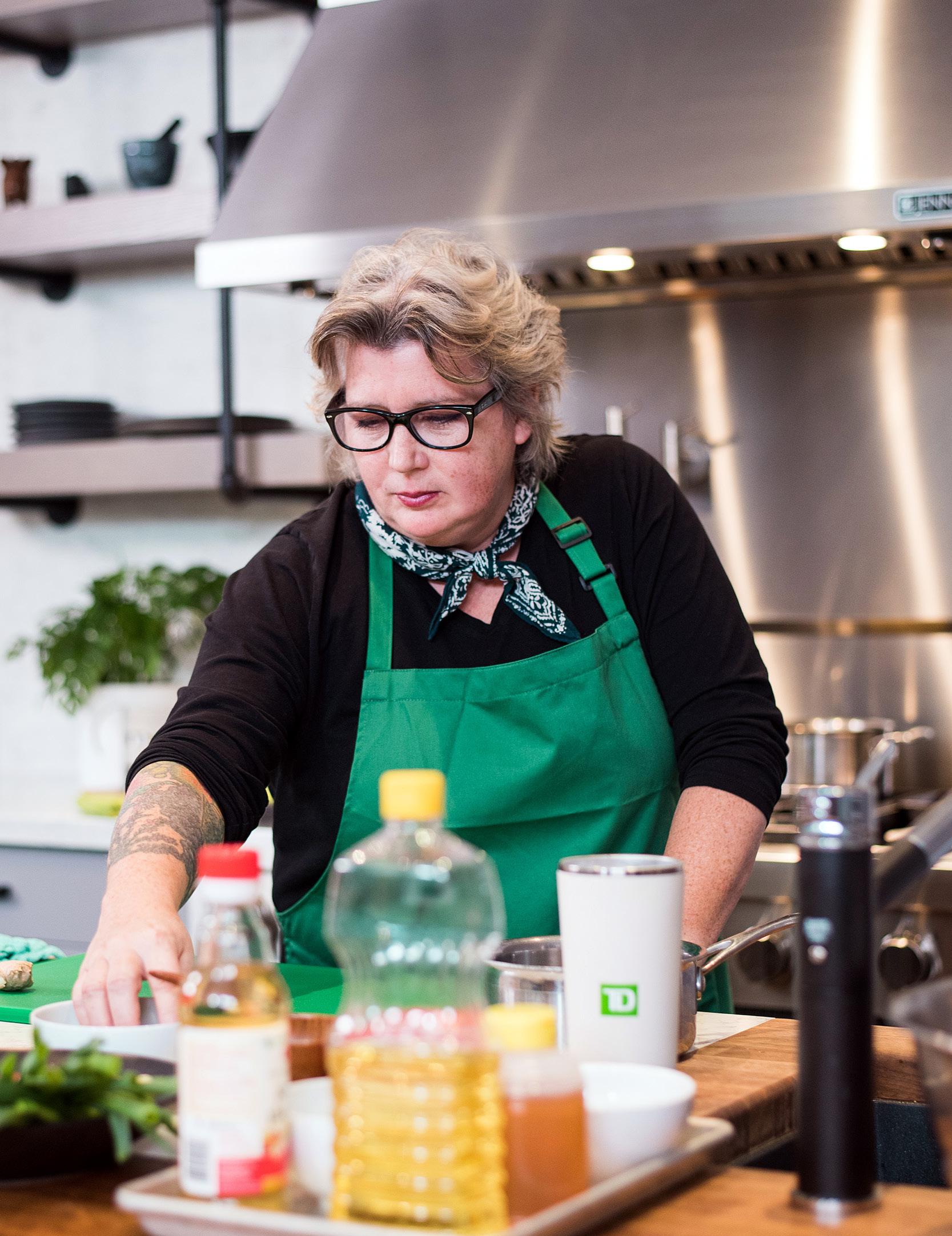

By
I recently was able to connect with Canadian celebrity chef Lynn Crawford, whose culinary journey includes owning restaurants, hosting a menu of shows on the Food Network while being a Best-Selling author and brand ambassador.
Chef Brian (CB) So why did you choose to be a chef?
Chef Lynn (CL): Well I’ve always had a love of cooking. Certainly as a young kid growing up it was very much a part of our lives preparing a family meal together, sitting around the table and sharing our day with one another with heart felt conversation and great delicious recipes. The Crawford’s were and are lovers of food.
CB: Are you a culinary school grad or a chef from the streets that worked their way through kitchens?
CL: I went to George Brown College and attended their culinary program. After completing college I moved to Montreal to cook.
CB: When did things start to take off for you in your career?
CL: Well after Montreal I joined the Four Seasons Hotels and Resorts and that was really the start of my wonderful career. I was with them for 24 years and worked at 5 properties and 7 postings. It was just an amazing time.
CB: I’ve had a few restaurants over the years, never more than one at a time. I learned at a young age that if nothing else it can be can be a punishingly stressful endeavor, but you have two. How does that work?
CL: Well we had Ruby Watchco for 10 years and was recently closed as our lifestyle changed as we moved to the country but I still have one at Pearson International Airport “The Hearth and the Hearth Market”.
CB: This might come off as a bit cheesy but have to ask if there is a chef you admire the most?
CL: There are so many that I admire but I think Alice Waters really laid the foundation of the importance of sustainability and supporting local farmers, growers, fishermen and ranchers.
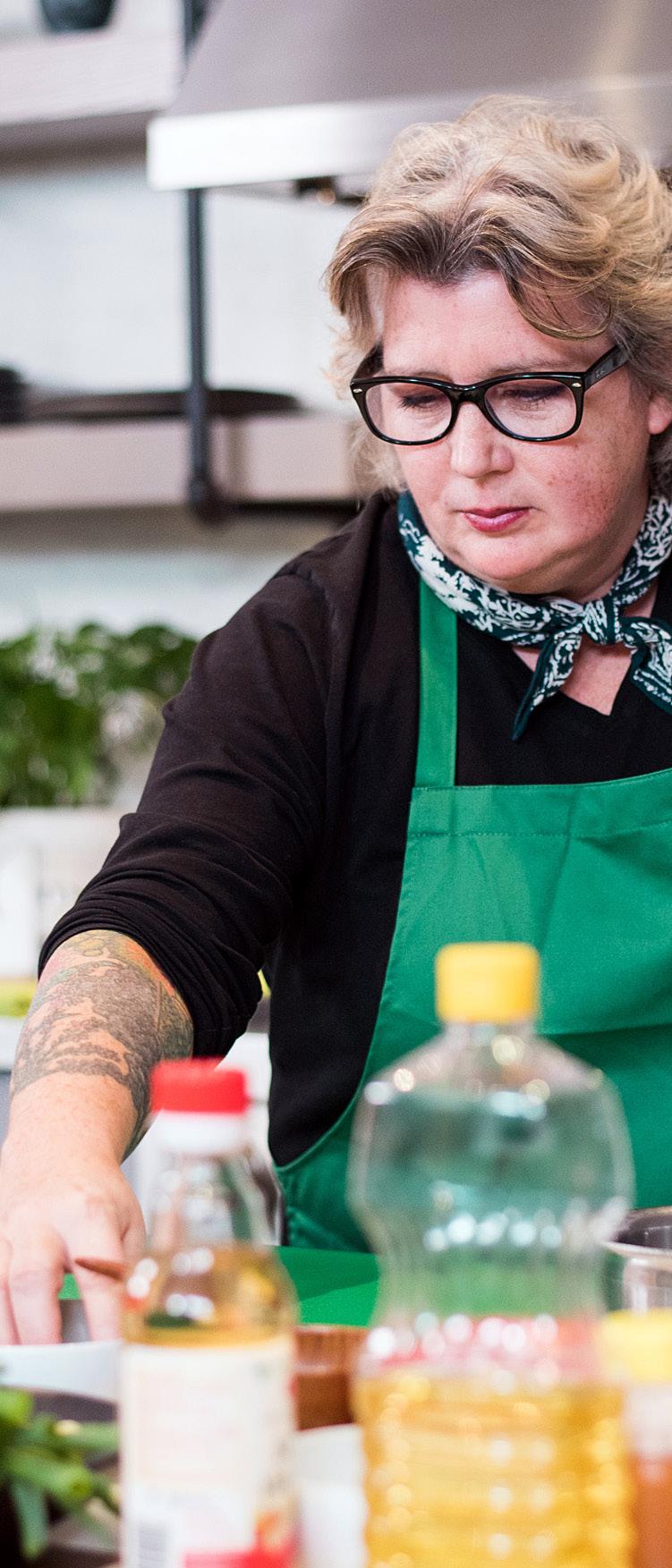
“I want to inspire people to cook well and have fun in the kitchen”

CB: How did you get involved in television shows?
CL: I would say being the Executive Chef at the Four Seasons in Toronto and I was approached by one of the producers of the Christine Cushing Live show. I cooked with her a couple of times on the show and it was amazing and I still hang out with Christine. We just filmed for Wall of Chefs season 2 recently and had a great
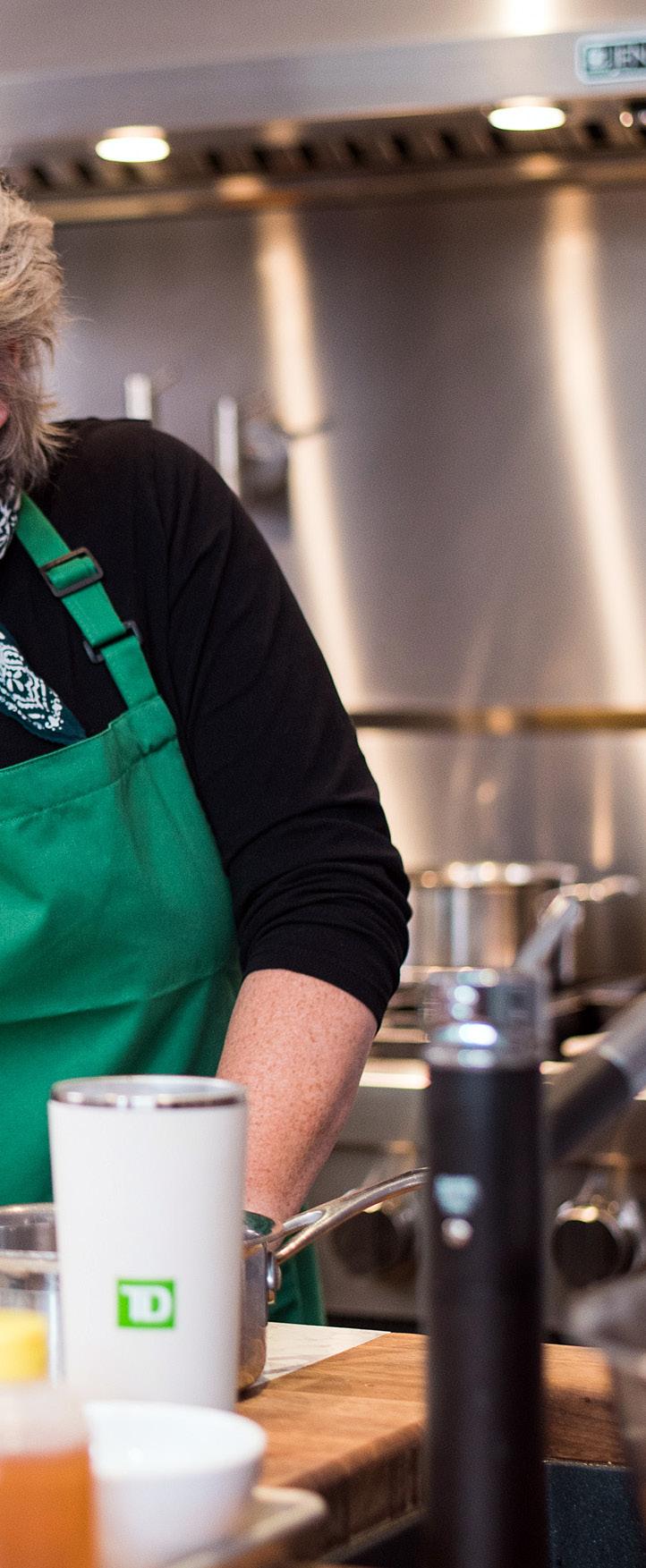
time. She is extremely talented and inspirational. I didn’t go out searching to get on TV, it just sort of presented itself.
I’m extremely grateful for and one of the first ones was Restaurant Makeover. Then Pitchin
CB: Got any favorite foods, cuisines or go to recipes?
CL: I think that would be a similar answer as it’s pretty wide open but I do take requests (laughs).
RESTAURANTS ARE HANGING ON BY THREADS. THEY ARE COLLAPSING, LOSING EVERTHING. IT’S BRUTAL.
In, Top Chef, Top Chef Masters, WalI of Chefs, Iron Chef, Iron Chef Canada, Junior Chef Showdown and Great Canadian Cookbook. I’ve done quite a few and loved to participate in all of them.
CB: So if I came by your home for dinner, what might be on the menu?
CL: Well I think it just depends on where you are and the time of year as I love so many different cuisines (laughs). I love a variety and in our home we could be making a Vietnamese Pho or Jerk Chicken on the bbq or cheese soufflé so it depends on the season and what you feel like eating.
CB: Our profession sees the flavor of the week, trends and fads that come and go, the very nature of which motivates our industry, how do you keep things real and balance it out with a contemporary approach?
CL: Oh I think every fine chef has to keep up on the trends. I’m always reading cookbooks as they are a passion of mine. Visiting and supporting your local restaurants to find what’s out there, as it’s always been a huge inspiration to me with the different cuisines, tastes and flavours of places I visit. There is a wonderful world of food out there you just have to embrace all of it.

CB: It’s no secret that Covid has kicked the shit out of the hospitality industry as well as many others’ businesses. Many are still reeling and on the brink of closure. What effects are you seeing with our industry and the commercial kitchen?
CL: Well my heart goes out to all those in the restaurant and hospitality industry. They have to endure the restrictions, lockdowns and the mental fatigue constantly battling and pivoting and trying to get through the day, the week, the month. It’s been absolutely grueling. For the staff not being able to go to work or be on leave and then start up again then stop again and still can’t have full capacity, yet major sporting events have full capacity, so where is the rationale here? It makes no sense and I don’t get it. I really don’t get it. Hopefully when we get back to some sense of normality there will be more attention and support for our local restaurants to make them whole again. Restaurants are hanging on by a thread, they are collapsing, losing everything from their business to their homes and bank accounts, it’s brutal.
CB: What makes being a chef worthwhile for you ?
CL: When the table is set and there are lots of hungry people, good music, good conversation with friends and family.
CB: What fires you up in the kitchen?
CL: Lack of respect for products and ingredients. Don’t be wasteful.
CB: So Martha Stewart did that thing with Snoop Dog. Any chance we could see you and Drake do something similar?
CL: (Laughs) Well yeah if you could just phone him for me and set that up, that would be fantastic (Laughs).

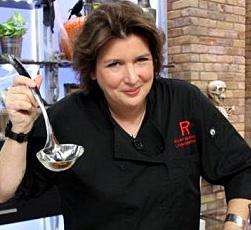
“Hopefully we will get back to some normality & support local restaurants”

CB: I will see what I can do with that for you. I’ve got pots on the stove and something in the oven as I’m sure you do, so what closing thoughts can you leave us with?
CL: I want to inspire people how to cook and cook well and have fun in the kitchen and to enjoy it and navigate yourself through your own home kitchen so that you will be a shining star, is what gives me the most satisfaction. It’s not rocket science (laughs).
Chef Lynn has a new cookbook ‘Hearth & Home’ now available at Indigo. Written with her wife, Lora Kirk, it is filled with their favourite family-style recipes for everyday cooking and casual celebrations at home. It has been chosen as one of the Most Anticipated Canadian Books. To order, go to www.penguinrandomhouse.ca/ books/622760.
FaceBook - Lynn Crawford www.cheflynncrawford.com Instagram @chef_lynn
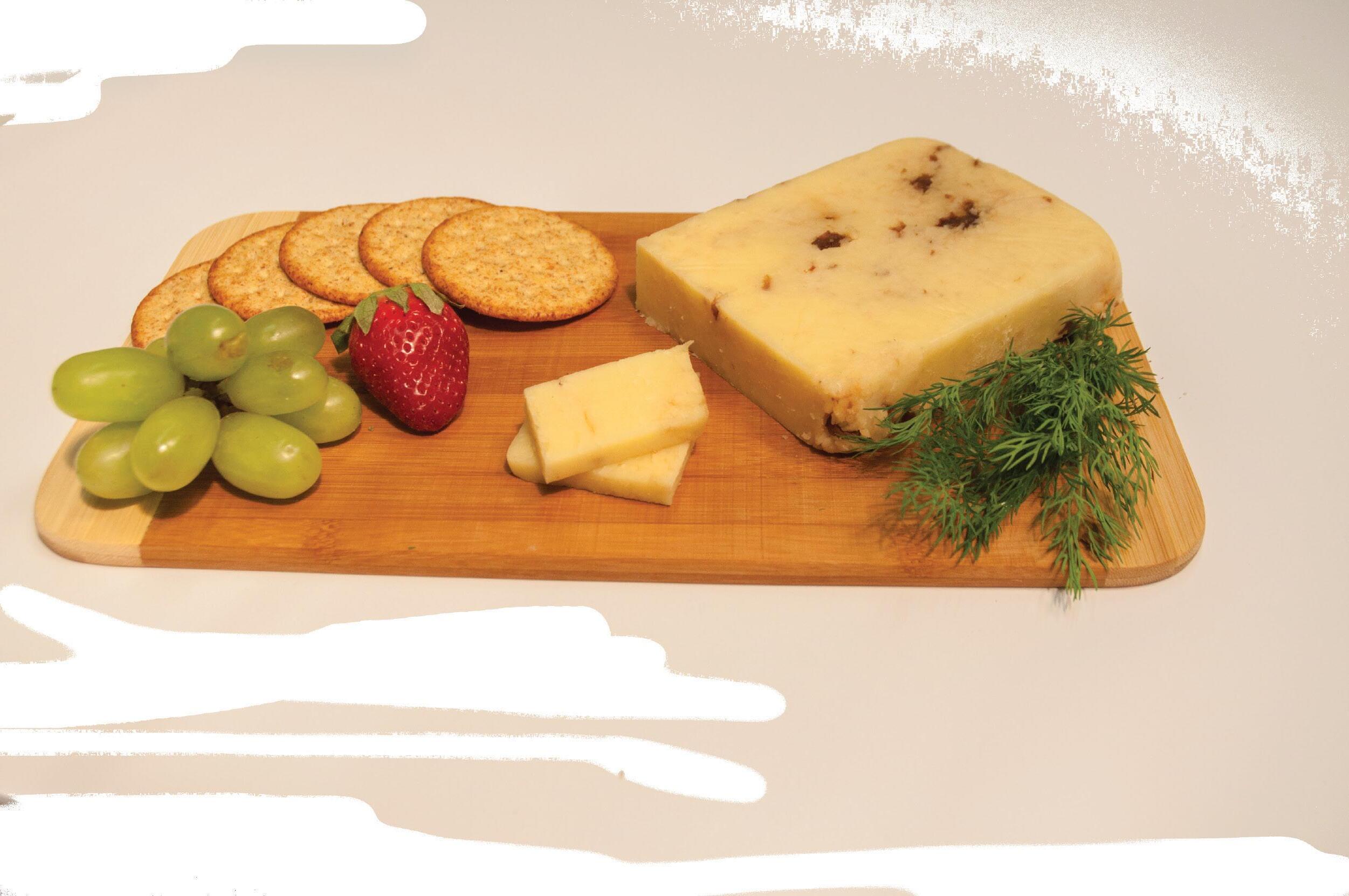
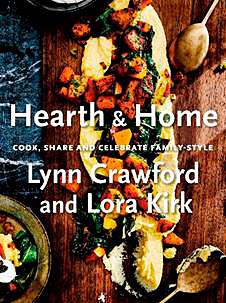


“I
bought a bus and followed The Grateful Dead for a few years selling pizzas.”
I sat down with Chef Brian Henry in Lakefield when he had a minute to chat.
I heard that Brian was a Deadhead and, of course, that intrigued me. A Deadhead is a hard core fan who shadows the band, The Grateful Dead, selling tie-dyes and beads. But in Brian’s case, it was selling pizza.
Brian elaborated, “I had a restaurant, I was in my early 20’s, and it was pretty stressful. I was probably in a little bit over my head for my age at the time, and the stress got to me. So I tagged out on the restaurant, bought a school bus, started traveling around, and before I knew it I was following The Grateful Dead on tour across the States selling pizzas out of a big old schoolbus.” He did this for a few years.
Brian continued, “And then the bus broke down, so I hitchhiked down to Mexico. I was in Tijuana for awhile.”
Ok, so now you get why I am so intrigued by Brian. We continued the interview.
“I traveled further into Baja to Agua Caliente and Santiago, and I spent a lot of time learning proper Mexican cuisine from the villagers. The Village Elder, Oscar, would send his son to get supplies for me. I would get these beautiful wheels of cheese. One day Oscar sent me with his son, and I exchanged items with the cheese maker and he would teach me how to make the cheese. That’s also how I learned to make Mexican cuisine. It was a lot of fun. We were
doing a lot of adobe style cooking using the large clay ovens. It was a great experience. I spent my spare time making leather things and would walk up and down the beaches selling it to tourists. I did that on and off for a year or so.”
Chef Brian has worked in the Caribbean, Bahamas, the Gulf Islands and Turks & Cacos.
Brian and his father got involved in a project getting medical equipment and supplies to a nursing home in Belize. The building was in dire need of a new roof, so they did fund raiser called “Raising the Roof”. They ended up putting such a great roof on, that the facility became a hurricane refuge, and still is to this day.
So what was Brian like as a child? “I was raised by my father, and we ate out quite a bit. So I spent a lot of time in kitchens as a kid. In grade one, I would make breakfast for my father, and I would make him an invoice to get money.”
Brian was being groomed by his father to take over the family jewelry store business, but it wasn’t what Brian wanted to do. While in Grade 5 for a Geography project, Brian presented a 3-course Chinese cuisine lunch for the class. At the age of 13, Brian’s father got him a summer job at Deerhurst Resort working in the kitchen. “Cooking was just happening”, says Chef Brian. “It was always very easy
continued ...

“The party always ends up in the kitchen”


“We were doing a lot of adobe style cooking using the large clay ovens. It was a great experience.”
for me, and I was able to see peoples reactions – how they enjoyed food that I created. Growing up alone with my dad, cooking helped create a sense of family and gathering around the table.”
Brian has lived in Lakefield for the past 16 years. He worked at a couple of resorts seasonally. Elemental Embrace, a private spa was where Chef Brian got noticed. There were a lot of celebrities and media people there, and his career took off. Brian has owned 4 restaurants around the country. He opened his first kitchen in the Kawarthas with the Angle Iron Kitchen Food Truck at Youngs Point, and is opening a new restaurant in Lakefield of the same name after Thanksgiving this year. Chef Brian prefers to call it a kitchen. He says “The party always ends up in the kitchen”, he said, “so there will be lunches in a kitchen, with seating and a place to pick up premade meals on one side. The other side will have another kitchen. It’s a small, quaint little space, and will be the production kitchen where we do our retail product lines for Spice Co. and Fully Baked”. It will be here that Chef Brian will host cooking classes and private cooking sessions. If the space isn’t being used for functions, people will be able to sit and eat there, on commercial grade kitchen tables and their food will be prepared right in front of them. As for the food at this kitchen, menus will change and rotate. He plans to cover different cuisines including culture and
presentation styles. Another use for the space is his catering. Whether it’s pickup, or delivery, or Chef Brian sets up on site for the guests. If you want a private cooking class, Brian will come to you.
In addition to this incredibly busy life, he also does Emergency Food Services work for evacuated Indigenous communities from the Reserves in Northern Canada during disasters – forest fires, floods, social services and emergencies (health epidemics etc). Kapuskasing is the host community and where he sets up. In five years, he has served 1.5 million meals. During this time up north, Brian’s staff are well trained to take over at the restaurant.
Chef Brian is a renowned food writer having written 200 or more publications for Rogers, The Peterborough Examiner, as well as teaching cuisine at Durham College.
Brian is a fourth generation Chef. He has been with his wife for 18 years, and has 4 children. Kira Maya, 22, who cooks and enjoys it. Sequoia River, 21, is an absolutely mad cook, but doesn’t enjoy it so much. Rasi Shai, 8, loves cooking and bakes with Brian and his wife, but she wants to be a vet. His youngest child, Eliza Blue, 6, loves to help out in the kitchen, but prefers to eat and satisfy her sweet tooth.
If I had to use just one word to sum up Chef Brian Henry, it would be ‘fearless’. He has lived his life around the world doing whatever he wants to do, and enjoying life to the fullest.
To Purchase The Spice Co spices, go to www.thespiceco.square.site

J ustin Ladouceur has been cooking professionally since he was 15 years old.
“I’ve always had a passion for fresh food. My mom cooked the freshest meals and did it on a budget. I love people being happy, enjoying their food and walking out with a smile on their face”, he says. Justin has been the Chef at One Fine Food for the past 1-1/2 years. Before that he was at Peterborough Golf and Country Club and also worked at Black Bean Steak House in Port Hope. “I’m from Huntsville and I worked at a lot of resorts and restaurants there.”
Justin moved to Peterborough to attend Fleming College for a Culinary Management Degree. That’s also where he met the love of his life. He says, “The plan is to get a house and then have kids. I can’t wait to cook with a little kid around. I’m super excited.”
I asked Justin where his passion for cooking came from. “My mom is Polish Ukrainian. She always produced gorgeous home cooked food and I work with those kinds of recipes as well. I love using things that my mom taught me, and I think it really comes out in the comfort food that I produce. When I left home my mom gave me a recipe book with all the recipes that she made for me.” Justin continued, “I always had a passion for food and I found a chef who was willing to work with me. You need experience to get a good job and at the same time no one wants to hire someone without experience. I asked Justin why he stays here. “I love
By Karen Irvine
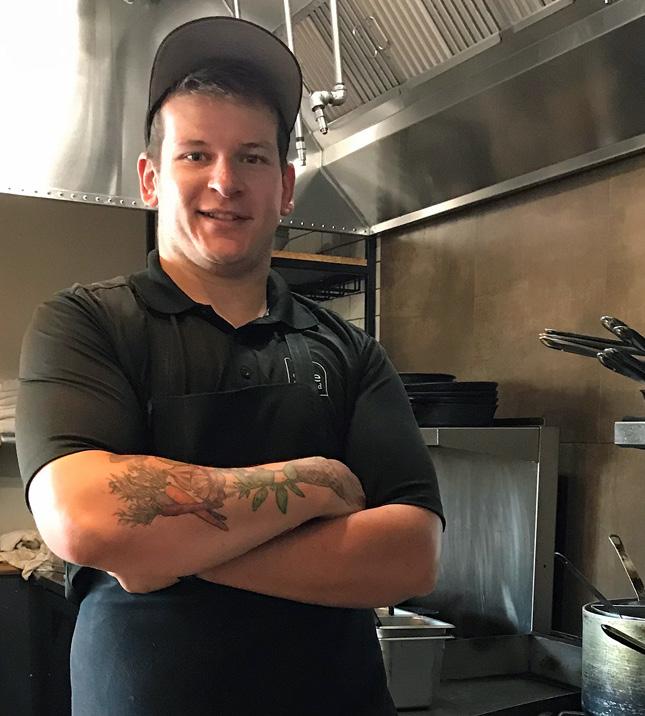

Peterborough. The atmosphere and food scene is amazing. The food in this region is insane. There is so much going on and so many varieties.” Justin feels that the Kawarthas should be a food destination. “You can get the best BBQ you’ve ever had in
“Most restaurants around here have a respect for food and use local grown.”
Keene or Italian, Greek, and Asian Korean Fusion food. It’s amazing. Most restaurants around here have a respect for food and use local grown. I appreciate that. It’s so nice to see restaurants working with local suppliers.”
“Everything we bring in is fresh and as local as possible. You can get milk, cheese, beef, pork, chicken and vegetables within a hundred miles of here. We work a lot with grass fed beef, corn fed chicken, organic foods. We dry age our own beef for 60 to 120 days”, he says.
The Chef culture here is very close knit. “I know a lot of the Chefs around here and it’s because you hear about what they are doing with food. Local Chefs recognize each other. Everybody is
producing great food and anybody substantial is doing it right. I think there’s a respect between Chefs for that.”
Justin is proud of the food he serves and says, Chef Justin works 5-6 days a week. “I love being here and everyone I work with is like family. The service industry is very close knit”, he says.
Follow Justin on Instagram @thatlinecook
FaceBook JustinR.Ladouceur




M eet Andrew Orde, Head Chef at Electric City Bread Co. Andrew is more than just a Chef. He’s an interesting, colourful, tattooed guy who has traveled the world learning his craft. He’s back in Peterborough, and we are lucky to have him in this culinary city.
Why a Chef? “It more or less found me. When I was 15 I got a dishwashing job. I wasn’t necessarily interested in it at that time. My first kitchen job was on an island in Lake Tomogami. It was a lot of fun and a great experience. It was for a summer camp, so I moved my way up very quickly from dishwasher up to Sous Chef. After that I moved out west for a few years. When I moved back to Peterborough I actually reconnected with the Chef from the summer camp, who was the Chef at Parkhill on Hunter at the time. He hired me right away. From there, I’ve been in Peterborough, as well as the West Coast. I spent a little time in Europe working in the French Alps at a ski resort. That was definitely one of the highlights in my career,“ he said.
Andrew came back to Peterborough because he was born and raised here. “Everyone can get out for a bit, but Peterborough seems to have a way of bringing you back. The food community in Peterborough is unlike anywhere else. There’s no competition, we all work together rather than working against each other. I think it’s a really cool thing to have that kind of community. “ says Andrew.
What does he think about Culinary School? “ I do see an importance in the culinary school, but I think that you can grow outside the box a little bit more when you have that amount
of freedom rather than being confined to the French old school. I think in the end, (not going to school) makes for a way more interesting Chef. I’ve been able to pick up my own style. It can build your character as a Chef, which I think is really cool. At this point, I’m 31 and I’ve been doing this for about 16 years now.“
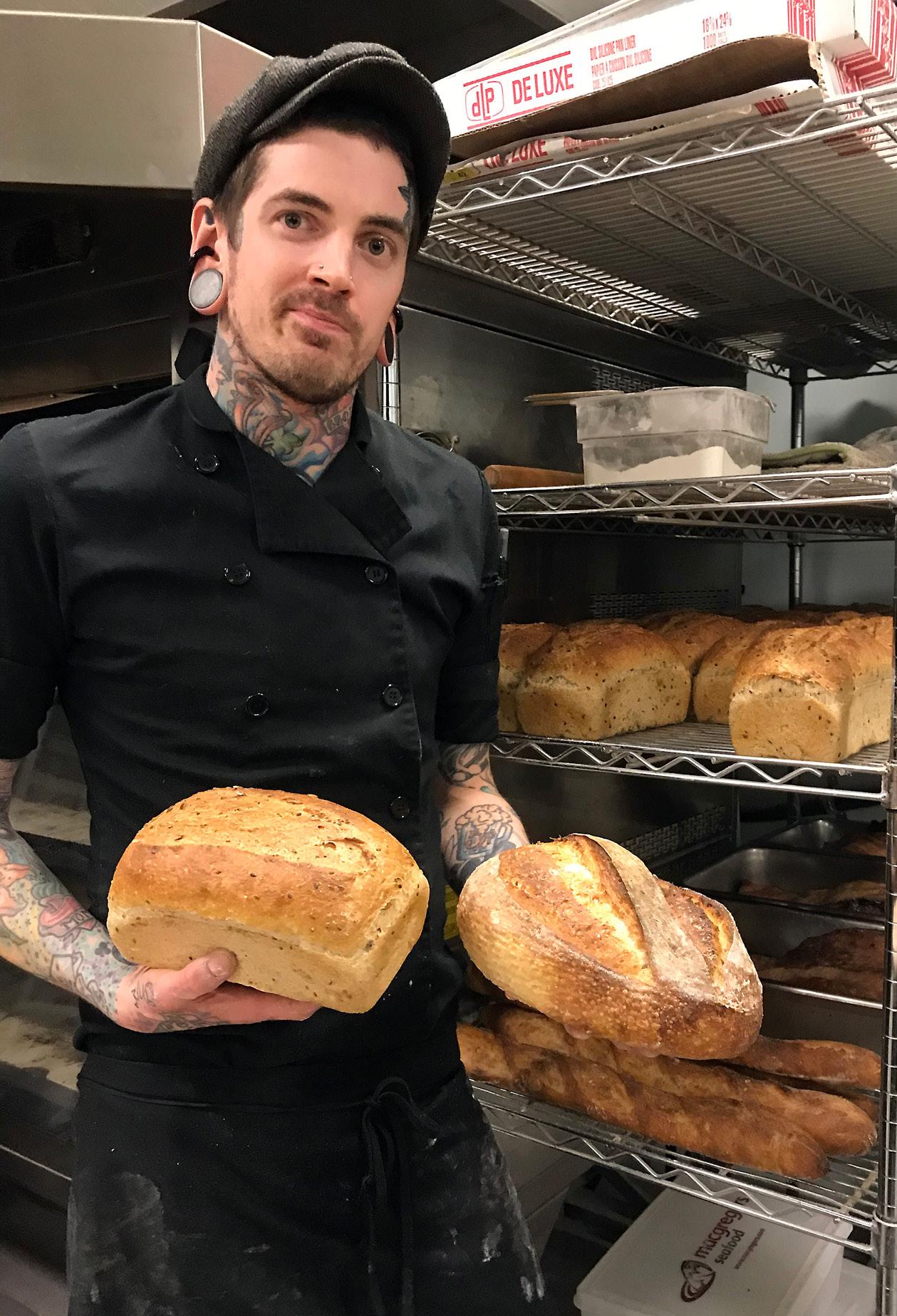

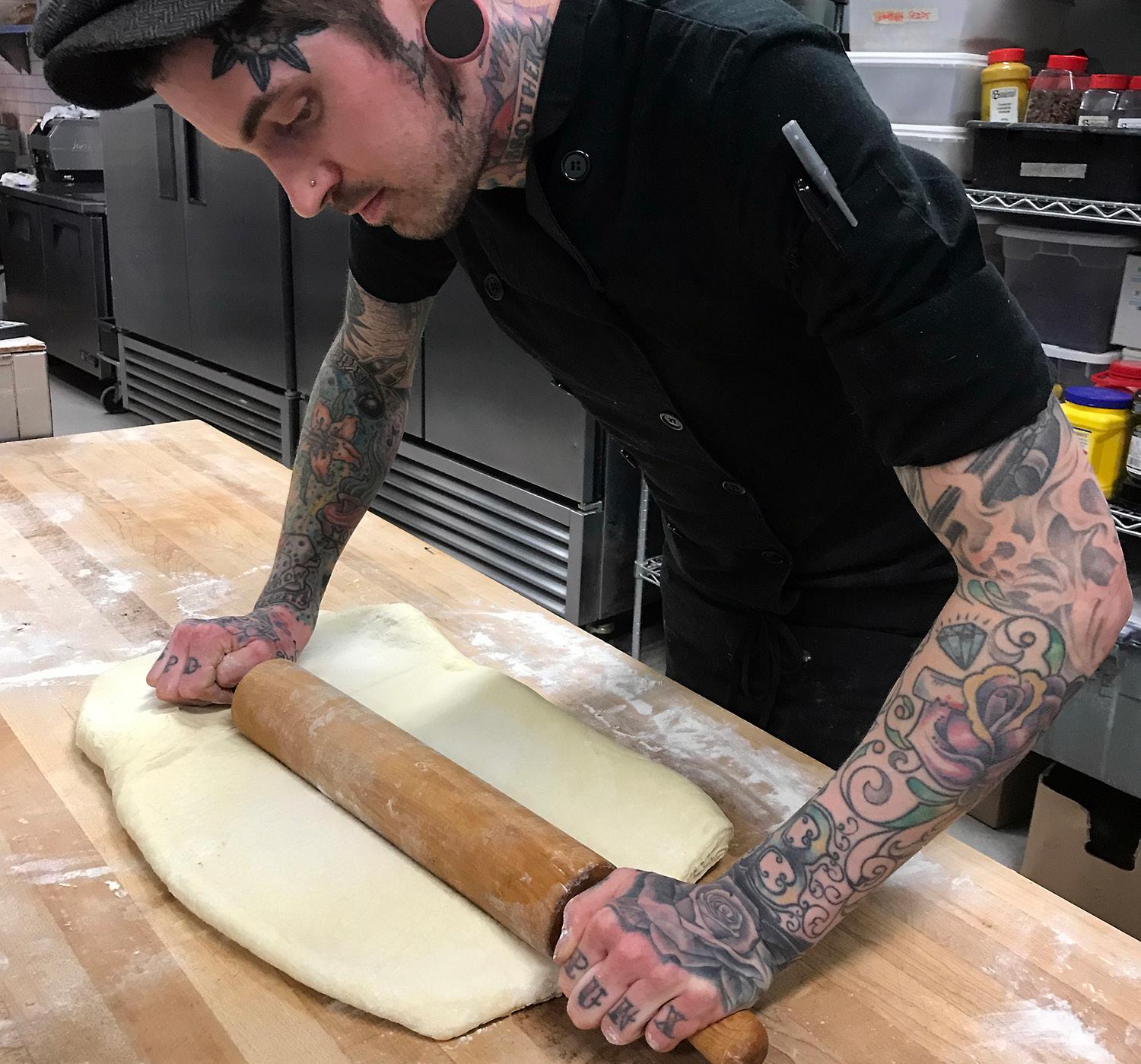
“ Peterborough seems to have a way of bringing you back. ”
Where is Andrew’s favourite place to work so far? “My favourite and most challenging would be at Electric City Bread Co. just because it has really pushed me to evolve, and very quickly as well. Everything we bring in we do ourselves. We bring in all of our animals whole. We make our own bacon. We cure it for 7 days and smoke it ourselves. We do absolutely everything – our mustards, ketchups, relish, pickling – everything is from scratch. So it’s really tested me. You always have to be thinking at least a week ahead of time. We’re not the kind of place that would just go to the store and pick some up to make due. I’ve been here for two years now. “
Chef Andrew has a say in what gets created. “Jeremy (the owner) and I work pretty close at putting things together. At the end of the day, it’s generally my vision that comes through, and I do all the recipes for it. We change our menu every 6 to 8 weeks, and that keeps it very interesting. As soon as you have it down pat and can do it with your eyes closed, you are starting all over again. So it definitely forces you to be a better Chef, and offers the opportunity to continually evolve and out
do yourself. We do a lot more seasonal menus. We get to work with the local farmers, Circle Organics for the most part, and smaller farms like Little Leaf Farms. We go organic and local as much as possible. For our produce supplier, we use The Market in Lakefield. For example, we don’t have tomatoes unless it’s tomato season. You won’t see a BLT on the menu in January.”

Baking is new for Andrew. “We do absolutely everything from scratch here. Our sourdough is a three day process. We use a variety of specialty flours in our sourdough and our bagels. It was very stressful at first. I didn’t have any interest or experience in baking at all before I started working here. But over time, I have fallen in love with the art of baking.”
Andrew is very focused.“There’s not really a lot of off time (he laughs). I have a pretty large family of dogs, so with the early mornings and late nights here, I go home to walk the dogs and hang out with the dogs. I also host cooking and dinner parties for friends and family. That’s a pretty common pass time of mine.”


M eet Scott Hudson, Head Chef at Hobart’s Steakhouse in Lindsay and Peterborough. Not only is Scott an amazing Chef, he is also very passionate about the meals they serve. Scott has been a Chef since 1989. He was born and raised in Peterborough and went to Adam Scott Collegiate School.
Scott’s career started as a dishwasher at the Holiday Inn and he just never left the kitchen. When he quit high school, did his basic apprenticeship at Georgian College in Barrie, his advanced at Algonquin College in Ottawa, and started his Economic Business Degree at Brock University.
Chef Scott relocated to Burlington for 15 years where he worked at the Pig & Whistle Inn. He also taught the apprenticeship program at Liaison College in Hamilton. After teaching, he worked at Hearthstone by the Lake, which was ironically the same location of the torn down Pig & Whistle Inn. He has traveled to Nunivak NWT as a GM Consultant to run two restaurants - Waters Edge Seafood Steakhouse and the Kicking Caribou Pub.
Scott is at Hobart’s now. He likes it there, and has decided to set his roots in Lindsay to be close to his family - his parents and youngest son live there.
So what does Scott love about being a chef?
“The guests. Bar none - the guests. When you walk in the door, I want to WOW you from the moment you get there until the time you leave. If we haven’t done that, then we haven’t done our job.”
What makes Scott tick? “Being a chef is the pride and passion of every ounce of product you put on a plate, and the WOW factor of guests enjoying a meal.” That’s what makes him get up and do it tomorrow. His advantage of understanding the numbers side of the business gives Scott an edge. And he loves doing it. It’s about coaching and development. He teaches consistency in the menu and food.
Scott feels that Lindsay’s restaurant businesses are evolving and growing. “There are more restaurants in Lindsay than there has ever been”, he says. Not only does he pride himself on teaching, but also it has to be the freshest ingredients and as local as possible.
With Scott’s gypsy-like personality, surprisingly, he never gets bored with being a Chef. “Cooking to me is like putting your shoes on in the morning”, he says, “It becomes a habit. What keeps you interested is constantly developing a new weekly feature program or making next season’s menus. And at Hobart’s there isn’t a high turn over of staff, so we become a team, and that makes it much more enjoyable. Their program is the best I’ve seen in 30 years.”

M
eet Chef Lisa Dixon, previous owner of blackhoney bakery & Coffeehouse . Lisa has lived in Peterborough for 17 years, and has owned blackhoney bakery & Coffeehouse for
Lisa moved to Peterborough after her Mom, Linda Piers, and brother, Beau Dixon, came here. “That’s the main reason for coming to the Kawarthas”, she says. Another reason is “Per capita, this is better food than anywhere else”. Prior to Peterborough, Chef Lisa lived and went to school in Ottawa, where she studied for 7 years at Ottawa University, Algonquin College for Patisserie and then at Le Cordon Bleu Ottawa Culinary Arts Institute. After finishing school, she stayed in Ottawa for 21 years.
She is a big believer of formal education for Chefs. “It gives the fundamental skills to build a sustainable business. Running a business requires writing proposals and articulating what you plan for the client, so this is important”, Lisa says. “You don’t go to school to learn, you go to re-affirm talent.” To solidify this belief, Lisa has been teaching as a Culinary Arts professor at Fleming College for 5 years. Lisa says that the students bring a new eye to the dishes, which in turn, gives her discipline and inspiration.
Lisa and her partner, Mark, met 30 years ago in London Ontario where they worked at the same restaurant. He obviously fell in love, because he followed Lisa to attend Ottawa University.
Chef Lisa opened blackhoney because she loves

what she does. The three best restauranteurs she learned from were all women, and she says they were great teachers.
Lisa feels it is helpful to have an artistic eye to be a good caterer. Having an Art Degree from University has helped her to understand the layout & design of a menu, table decor & event planning.
We discussed the business side and Lisa feels that Chefs are not valued monetarily as much as they should be. Margins are weak and when the minimum wage went up, Lisa says
“ Per capita, (Peterborough) has better food than anywhere else.”
that she lost quite a bit. If a customer winces at the prices she doesn’t feel bad because she has to pay the staff and keep her business running. She is proud of the product prepared at both the savoury & sweet kitchens, has a staff of 21 and they are all great employees.
Lisa lights up when dealing with clients for the catering. She gets to decide the menu, layout the table, and set up the event to look it’s best.
She loves baking and cooking. To entertain herself on her days off, she has started a red fife wheat sourdough with no sugar or yeast. It’s how Lisa gets her creativity flowing. She finds that she’s at a stage in business where her kitchen & bakery Managers are very strong. This allows her to play in the kitchen and wear an official chef apron less.
Her family history is very interesting. Her Mom & Dad met at Acadia University and married in the mid 60’s. Her Mother is Scottish & Irish white and her Father, Blair Dixon is black. Blair’s father, George Dixon, was in his Mother’s womb when she escaped slavery through the Underground Railroad. Living in Africville, Nova Scotia, George Dixon married a Mi’kmaq Indigenous woman, Maria White. George was a member of the first black battalion in the 2nd World War in the Canadian army. They lived in Africville, which was a small community located on the southern shore of Bedford Basin in Halifax. It was a community from the early 1800s to the 1960s, and no longer exists.
Blair is a retired Anglican minister and lives in Regina, Sask. He had a successful career of ministering to native & black communities in many churches, which installed a lasting and indelible impression on his children that humanity can only be learned by those who teach with love. Every spring and summer Blair comes to visit and you will find him on the back patio of blackhoney eating his soup and sandwich.



“I’ve always loved food, my family has always been centered around food.”
T ammy Laroche is well known in Peterborough. As the owner of the now closed Parkway Banquet Hall, I’m sure you have all, at one time, tasted her delicious dinners and sweet deserts.
What got Tammy to start cooking? Life . ‘I started cooking at 5 when mom helped me bake my first cake. My sister was sick for years and years and I had to cook meals for my family when I was nine years old. I ended up being the cook because my brother didn’t, and my dad worked 3 jobs. I’ve always loved food, my family has always been centered around food.’
Her first real job was cooking at 15. Tammy worked for the two previous owners of The Parkway Banquet Hall, and took it over in 2005. She hired an amazing cook, Alec Miliaris, and learned many of her skills from him over the years he was with her. When he retired, she found no one could do it the way he did except her, so she took over the cooking and hired soux chefs to help out.
‘I loved the Parkway. It was the best of both worlds. I’m a people person and a foodie, so what better way to do it than to help people celebrate their weddings and anniversaries.’
The Parkway was well known for the sweets that they baked. Everything was from scratch.
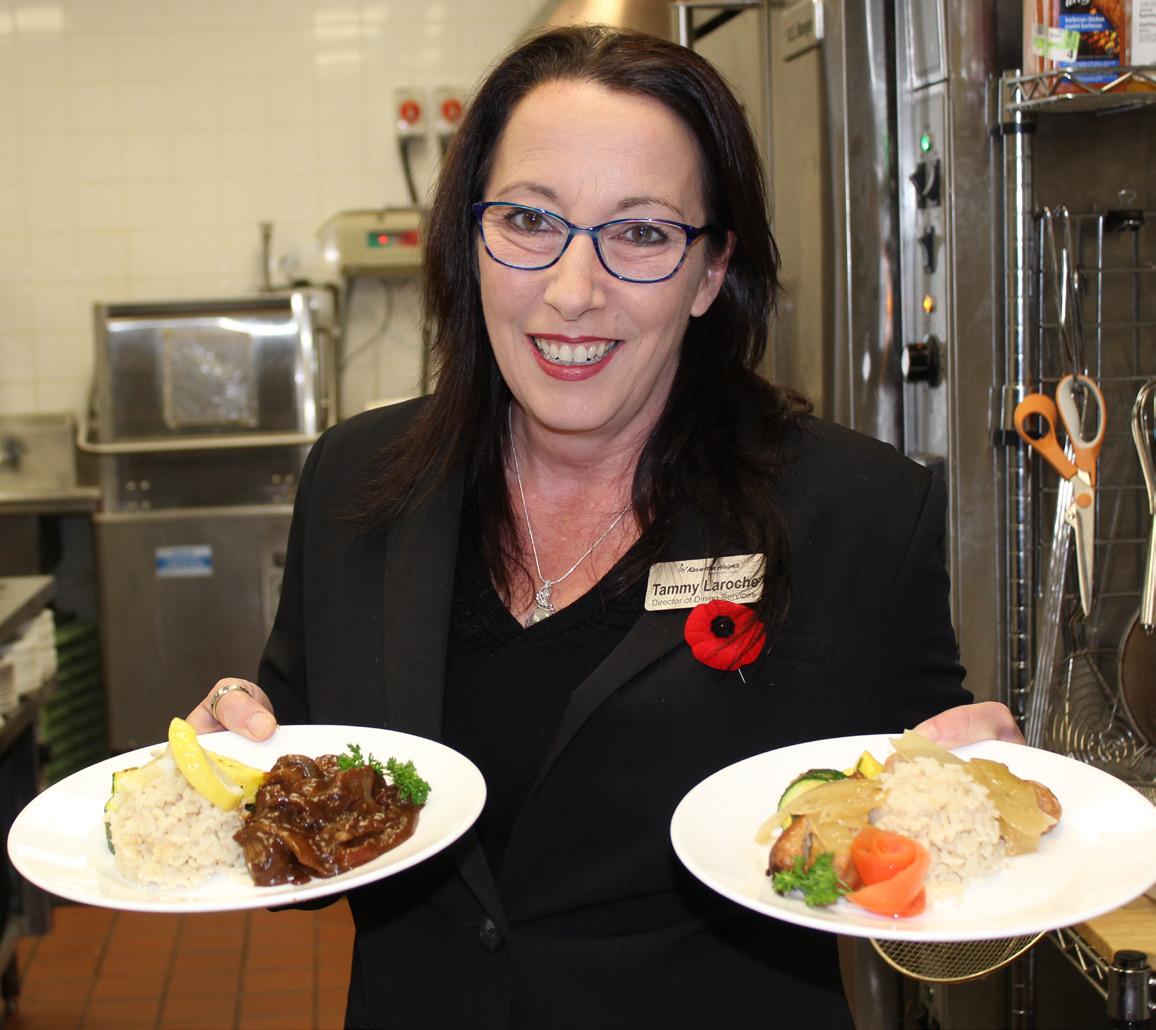
I can tell you from experience, having tasted Tammy’s meals, I would be very happy at Kawartha Heights Retirement Living knowing that she is in charge of the food program.

I met up with Junior Wray at The Cat & Fiddle in Lindsay. He is a Red Seal Chef and his enthusiasm for life is contagious.
Junior realized he wanted to be a Chef while growing up in Jamaica at the young age of 8 helping his Grandma in the kitchen.
He went to culinary school in Jamaica at the Heart Trust School for 3 ½ years, and also at Brownstown Community College.
In 2010 Junior left Jamaica. He was working at the Jamaican Grand when a guest offered him a job in the Kawarthas. He fell in love with the area. “I really like it here because it’s small, quiet towns. Where I come from in Jamaica it’s the same. So it didn’t take me long to adjust, and I love it here.” He worked at a local restaurant for 2 years. After that, Junior took a job as Head Chef at The Cat & Fiddle Lindsay. He has always wanted to work with kids with disabilities, so he took a break from that to cook at a children’s camp for 4 years. “Working at the camp was awesome. The kids would tell me how much they appreciated my cooking. It’s a good feeling.” After that, Junior went back to The Cat and Fiddle and plans to stay there for the long run.
His specialty is Jamaican and, surprisingly, Italian. “I fell in love with Italian style cooking because they cook from scratch. Italians cook with a lot of passion,” he says. Junior’s favourite meal is Jamaican seafood and curried goat. He says, “It makes me feel at home.”
Life has changed with Covid Protocols. “You can’t do as much as you’d like, but we take it one



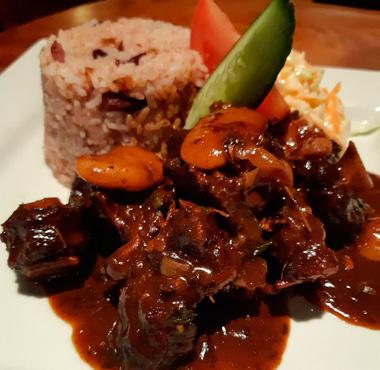
day at a time. We decided to do takeout until we could open inside”, he says. With the Stage 3 opening, Junior can once again enjoy cooking to the fullest.
Junior summed up the interview, saying, “My passion never changes, it never fades. I get excited when I get in the kitchen. I can’t stop cooking, because it’s my life, it’s what I do.”

M artin Carbajal is the owner of La Mesita Restaurant in the Café District in Peterborough. I know Martin fairly well, he is one of the stops on our walking food tours. He is always very entertaining, making the guests laugh with his funny stories.
When he was 12, in Mexico City he was hanging with the wrong crowd, so his mother put him to work selling tacos. ‘I’m still grounded today because of that’, says Martin. When he was 18, the family had a taco stand. It went so well that they opened a restaurant. ‘We started out living at my Grandma’s because we couldn’t afford our own house. 25 years later, all of my family have their own houses’, says Martin. His mother was a perfectionist. Martin says, ‘She had me make rice every single day. She would say it was too wet, too dry, too crunchy, didn’t have enough salt. There was always something. When I finally did it properly, I expected to get a pat on the back or good job or something. All she said was that it’s what you are supposed to do. It was hard, but it taught me that good actions are like a balloon and bad actions are like a needle and will break everything else. You are only as good as your last meal. (he laughs) If your last meal was good, you are perfect.’
Martin was 28 when left Mexico City. He came to Canada, found a Mexican restaurant and went to work. He says, ‘When I came to Canada the first time, I was only here for 2 months. The restaurant I worked at was in Kensington Market called El Trompo.’ He went back to Mexico and got a job working on a cruise ship in Alaska. He says, ‘The visa process was very arduous. In Mexico there are a lot of businesses

that scam you – asking for money but there is no job.’ So although it may have been a scam, he decided to try, in case it was legitimate. They told him he had to pay for his American visa and there would be an English exam and a physical. He passed all the criteria and flew to Alaska, where he was an assistant to the steward – the helper to the helper to the helper of the steward – and spent 4 years on the ship. By working hard, he had 4 promotions in his first nine months, a
“It’s great when people come in skeptical and leave with a big smile.”
process that normally took 2-3 years. There were chefs from 35 nationalities and they would have cook offs after hours. This is where Martin gained experience with international food.
He has twin boys (9 years old now) from a previous marriage. He met his current wife, Kelly, in 2015. While dating, Martin was working long hours and Kelly would come help him so they could spend time together. She is very supportive. ‘I’m the cute factor, and she’s the brains’, he laughs.
Since opening the restaurant in 2017, ‘It’s been hard because it’s a new enterprise. People don’t really know real Mexican cuisine, so they come expecting burritos and nachos. I want people to know what real Mexican is. It’s not the TexMex that most people think of. That’s why I’m really passionate. I get tired, yes. I’m human. I love it and wouldn’t change a thing. It’s great when people come in skeptical and leave with a big smile. The food we serve is Mexican 101, the basics. If people don’t know the basics they won’t understand what fancy is. It’s very unpretentious. It’s about mixtures and freshness. That’s the key - everything needs to be fresh. It’s all cooked from scratch. Kelly is as passionate about it as I am. She believes that when people find us, they will like it. When we started dating, she said I was funny, but what won her over was the food.’ (he laughs)
Martin also caters. His forte is Mexican, but it’s not all that he cooks. He got a lot of training on the cruise ship with other cuisines. If you want Greek, Italian, Indian, Filipino and more, he can do it deliciously.
La Mesita won Immigrant Entrepreneur of the Year in 2018, and is a favourite stop at the Peterborough Regional Farmers Market.
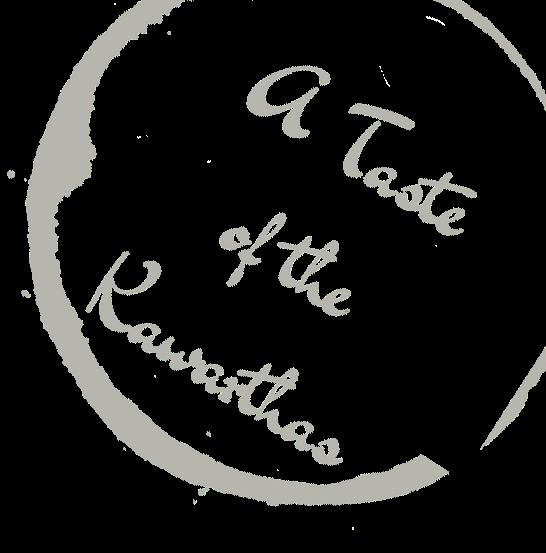



M onica is the mother of 5 children and the wife of Alvaro, her partner at Fresh Dreams.
She started cooking very early with her family in Spain where food is especially important in their household. She learned different styles of cooking from recipe books and started to experiment on her own to find something different. Monica’s sister-in-law urged to start catering in Spain. “My catering business in Spain was Con Mucho Cariño and it was fantastic,” she said. They received many accolades from their customers. She smiled and said, “To see their faces light up and enjoy my creations - I love when people tell me they love my meals.” That catering service ran for 9 years. She took cooking classes in Spain to become a Chef, which inspired her to be even more creative.
Monica and Alvaro moved to Peterborough when Spain was in an economic crisis in 2014. She says, “It’s good for everybody. My daughter Alex found Peterborough and thought it would be great. We feel more comfortable in a smaller town and love the area. I didn’t want to work for anybody because at the time my English wasn’t very good.” They were originally on Hunter St beside NaKeD Chocolate. “I would cook at home and bring the food in coolers for the customers. Everybody loved it,” she said. We wanted to grow and have longer hours, so we moved to Queen Street at the old Electric City Gardens location. I’m so happy here.”
Monica only cooks with fresh, local food. “I don’t want to cook with frozen food. I want to




pick out my tomatoes and vegetables, and use local lentils. Canada is the world’s leading producer and exporter of lentils. I don’t use added salt. I cook with fresh ingredients, like olive oil from Spain, Greece and Italy. I don’t like processed food. Our meals are not complicated – they are easy recipes. Everything I cook is what you would eat in Spain at a family restaurant,” she said.
Monica continued, “We have a lot of friends here because of food. The community supports each other. After we were first locked down, there were many new customers, friends and regulars who came out! We appreciate it very much and are growing by word of mouth. Our vision is to carry on and have the best patio.”

Fresh Dreams is a ‘must stop’ in Peterborough and is a popular stop on A Taste of the Kawarthas Walking Food Tour. Located close to Millennium Park, it’s the perfect place to spend the afternoon then head over to Fresh Dreams for a meal. When you walk in the door, you can smell the enticing aromas. The hardest part of your visit will be choosing from the vast, delicious menu. Ask Alvaro for a recommendation, and you can’t go wrong.

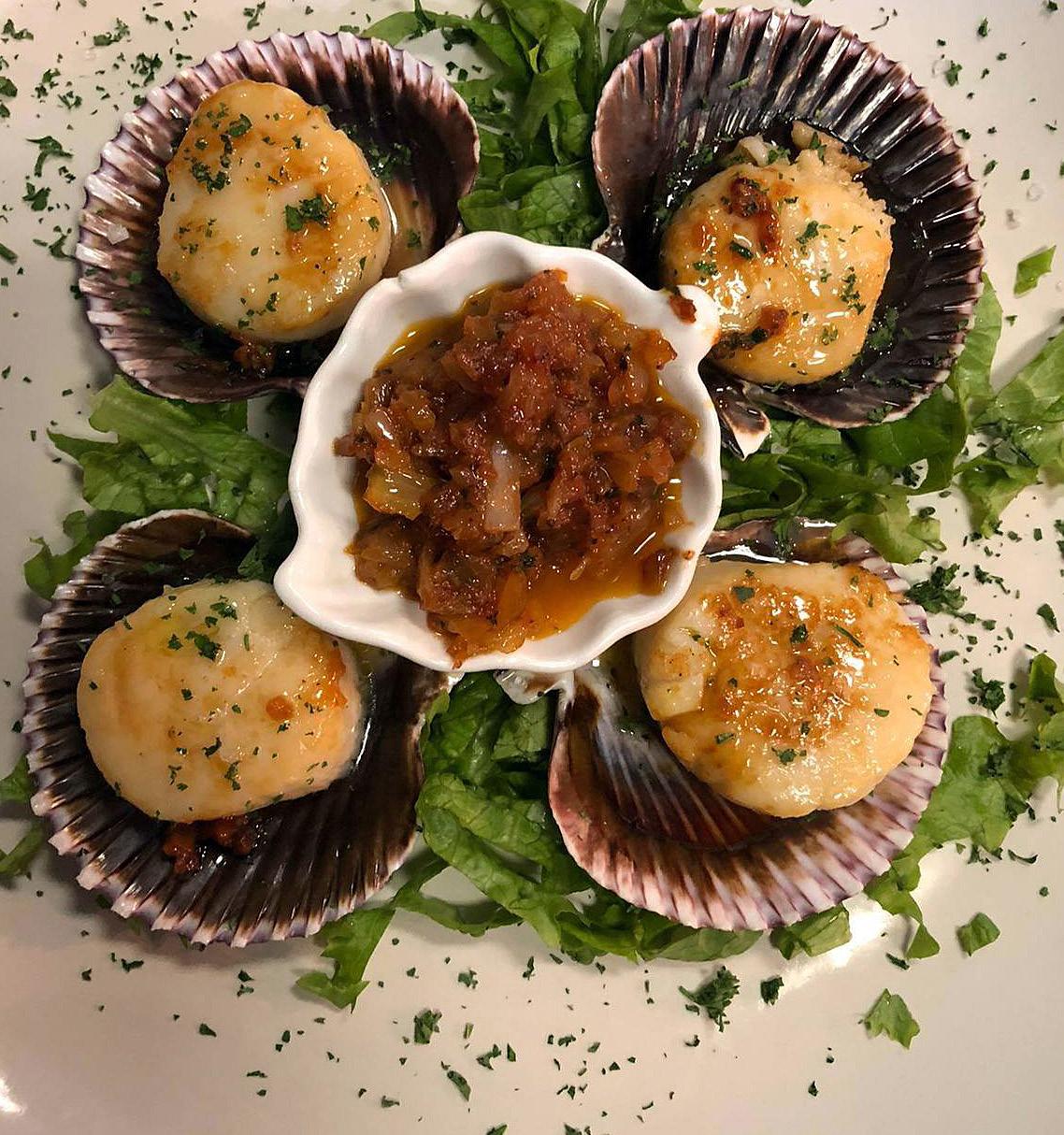


Shier
I met up with Chef Marc Shier to chat.
Marc has been at Pie Eyed Monk since the beginning in 2018. Starting there as Assistant Kitchen Manager, he stayed because he felt he could make an impact. He says, “It’s a challenge, especially in the period we are in now. I have the passion for the food, and you don’t want to lose that in this business for sure”.
Chef Marc creates the menu, “The past two menus I have created myself with some input from the General Manager. The partners look them over, but they are primarily my vision.”
He started working in bars and grills in Hamilton. He relocated to Haliburton to take his culinary skills to the next level,working at resorts.
So why did Marc become a Chef? “I went to school for computer electronics. But I worked in restaurants while I was in school. I enjoy the creativity – there’s nothing really creative about computer electronics (laughs). I enjoy the fact that you are learning all the time.”
“That’s what I like about working at the resorts. The same guests come back every year, so you really get to know them. Farm to table is one of my favourite things. I worked at Viamede Resort where they raised the chickens, turkeys and got the eggs from there.”
I asked Marc what is his favourite part of being a Chef is. “Creating dishes and being able to see the customer’s satisfaction. I enjoy

By Karen Irvine Editor, ATOTK

the interaction with them and their feedback. I love coming up with new ideas and working with other chefs, because everybody has their strengths. We bounce ideas off each other and with some really great things come from these collaborations,” he says.
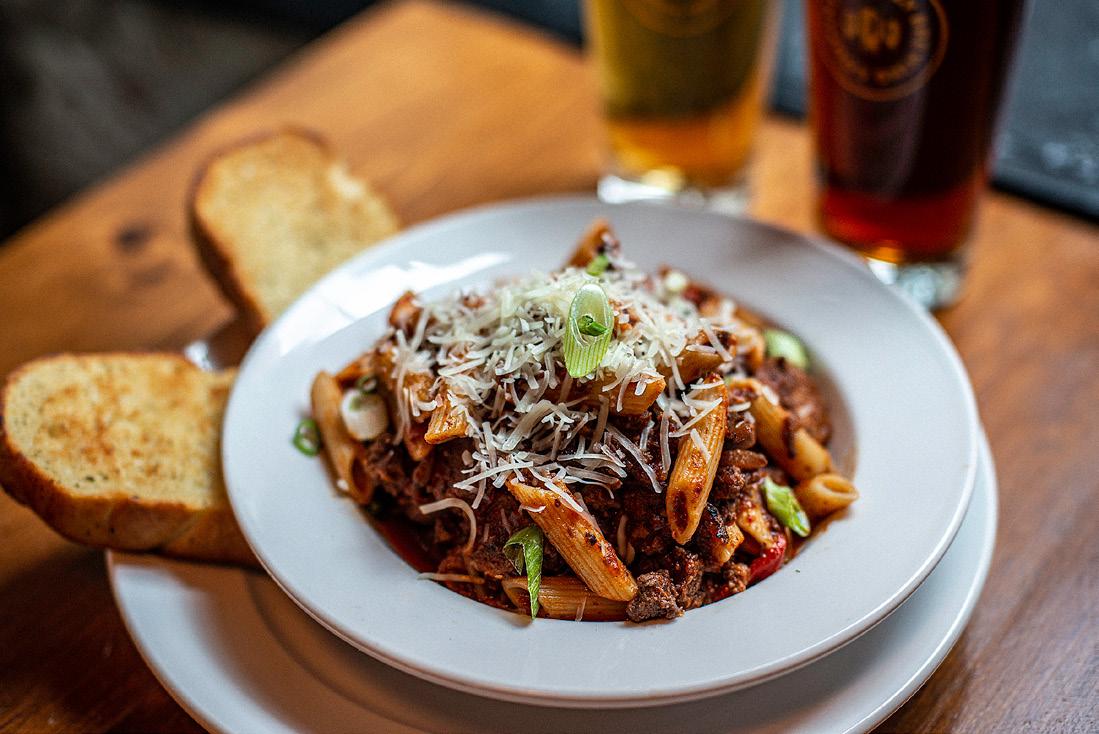

The food is a classic pub menu that compliments our in-house Lindsay Brewing Company. “We have foods that compliment the beer. One of the reasons I came here is that we smoke our pork and brisket in-house. It’s my new favourite thing.”
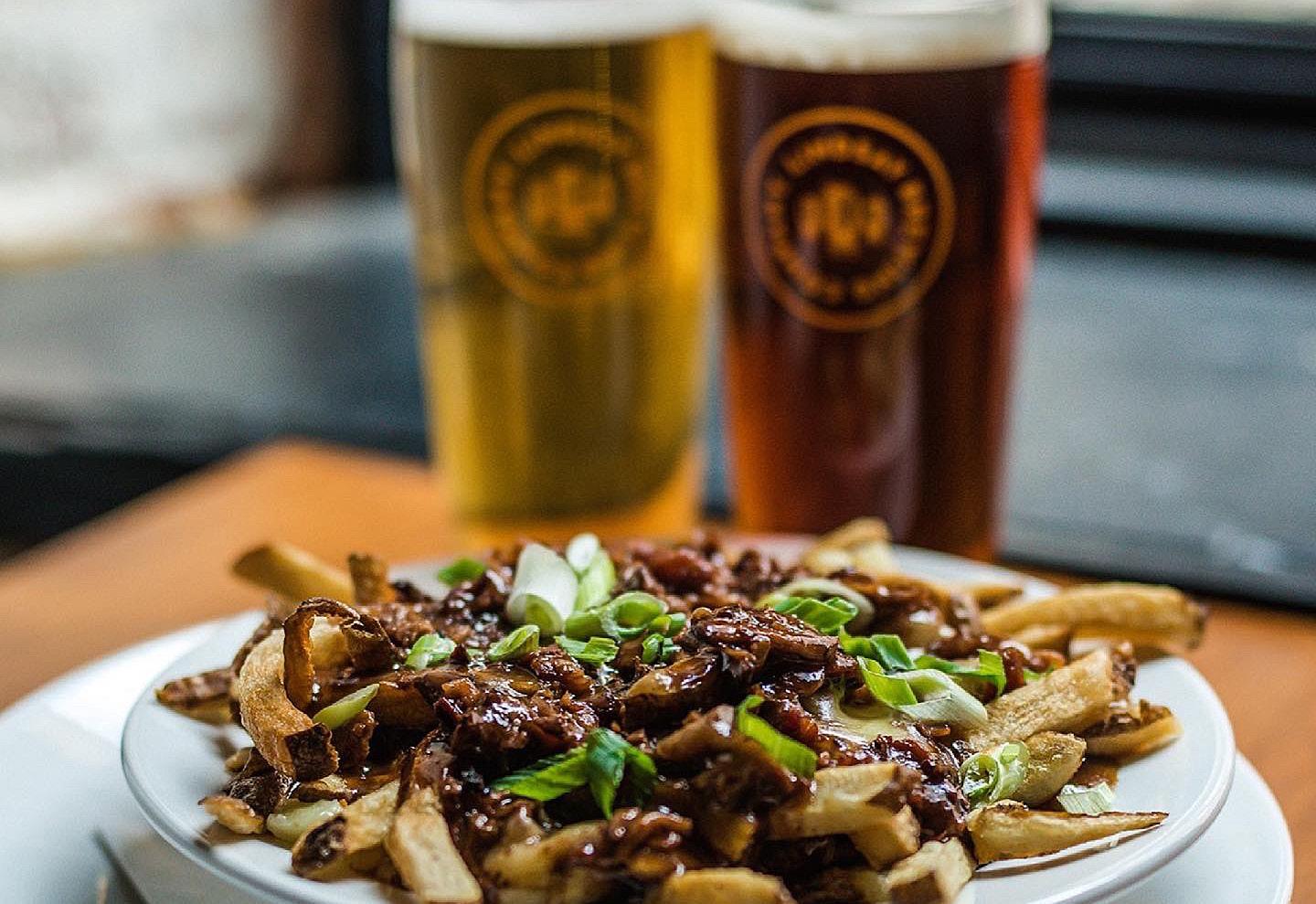
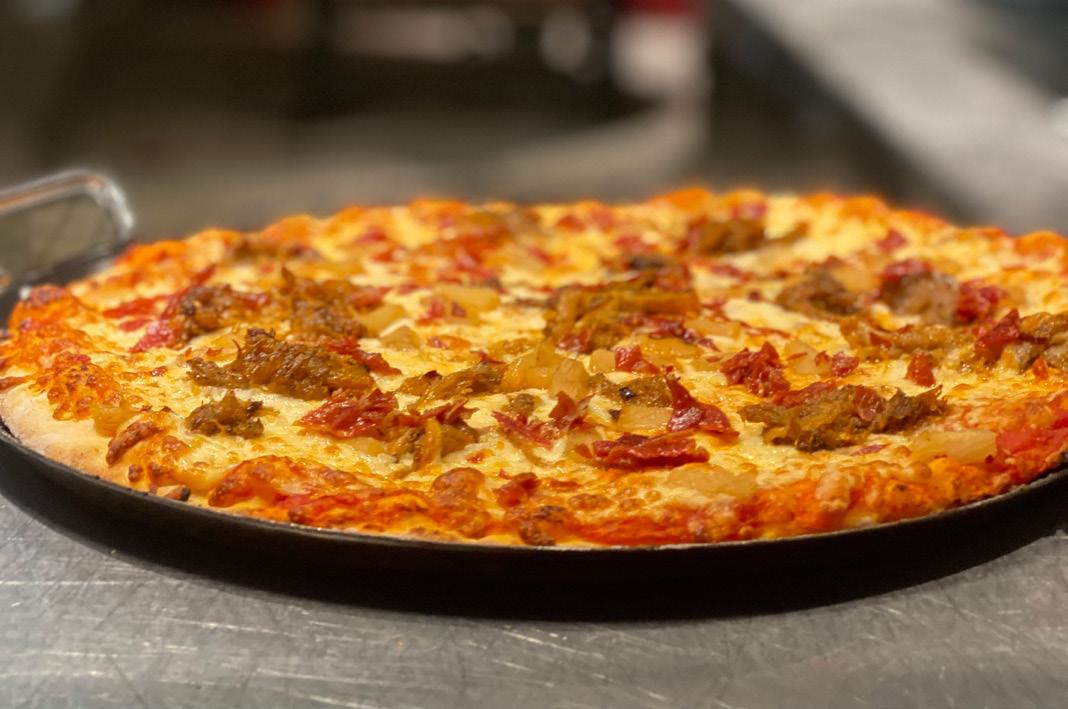
Chef Marc says, “My personal pride and joy is our pizzas. One in particular is the hawaiian smoked with house smoked pulled pork, prosciutto, pineapple, chili flakes, mozzerella and sauce”.
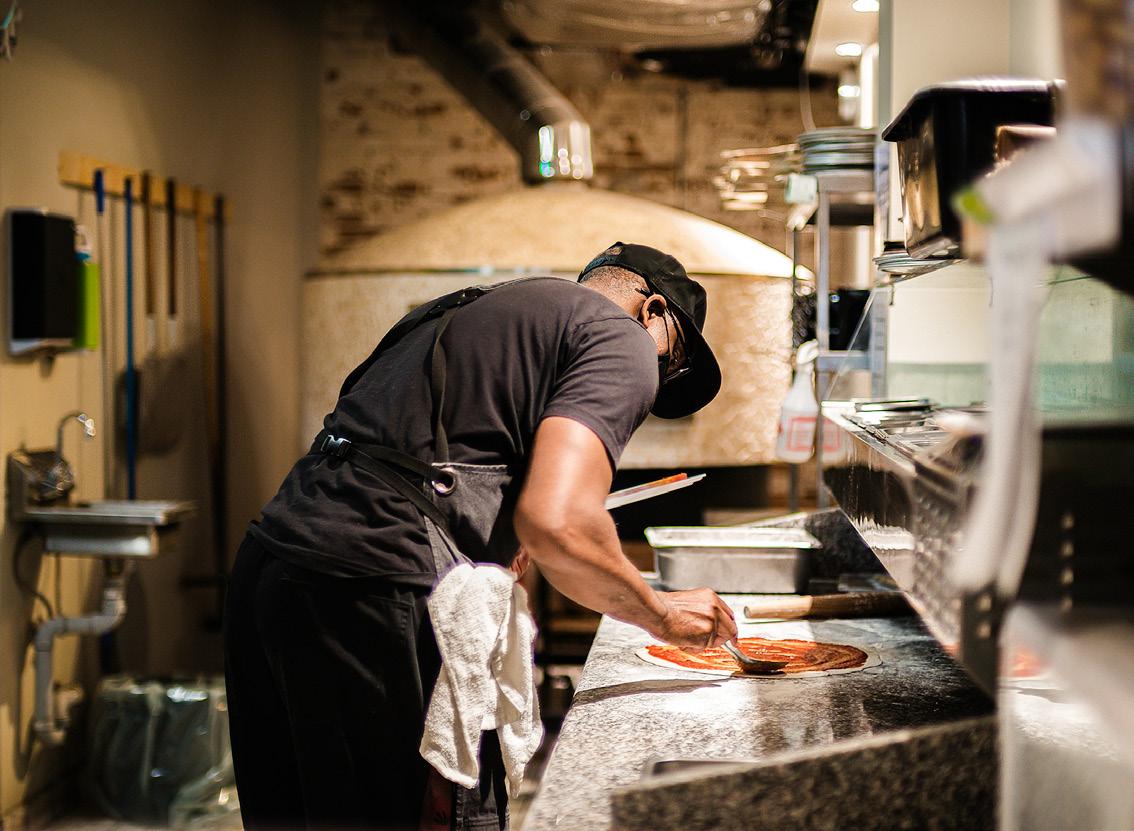

Chef Basel is the owner of Chef Basel Cuisine at 2641 Television Road in Peterborough. Our Real Estate writer, Jay Lough Hayes, introduced me to this restaurant when we met with Sylvia Sutherland for a delicious breakfast. The morning special is just $7.99 before 10am and it’s quite busy, as you would expect.
Chef Basel is no stranger to running a restaurant. He came to Canada in 1992 and started working as a dishwasher and short order cook in Scarborough. Basel moved to Winnipeg and went to Red Deer College for a culinary education. He came back to Toronto in 1995 and worked at Alice Fazoolie’s for 5 years.
Basel then ran a restaurant in Oshawa and after that, owned a restaurant with a partner. When Covid hit his restaurant in Oshawa had a tough time, as all restaurants did, so he moved to Peterborough and opened Chef Basel Cuisine in January 2020. Basel’s style is ‘fusion’. His restaurant serves a full variety on the menu - breakfast, salads, appetizers, pub fare, sandwiches & wraps, pizza, pasta and dinners. They also have a takeout menu and offer kids meals. He likes cooking all types of food. “This is my whole life. My daughter says I’m a workaholic. We love it here in Peterborough”, he says.
The fact that Basel survived Covid and is still going strong speaks for itself. Chef Basel Cuisine is licensed for beer and wine.
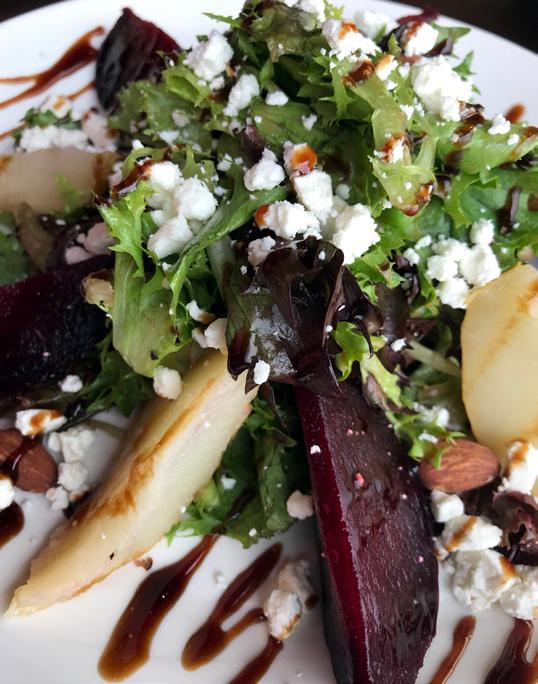

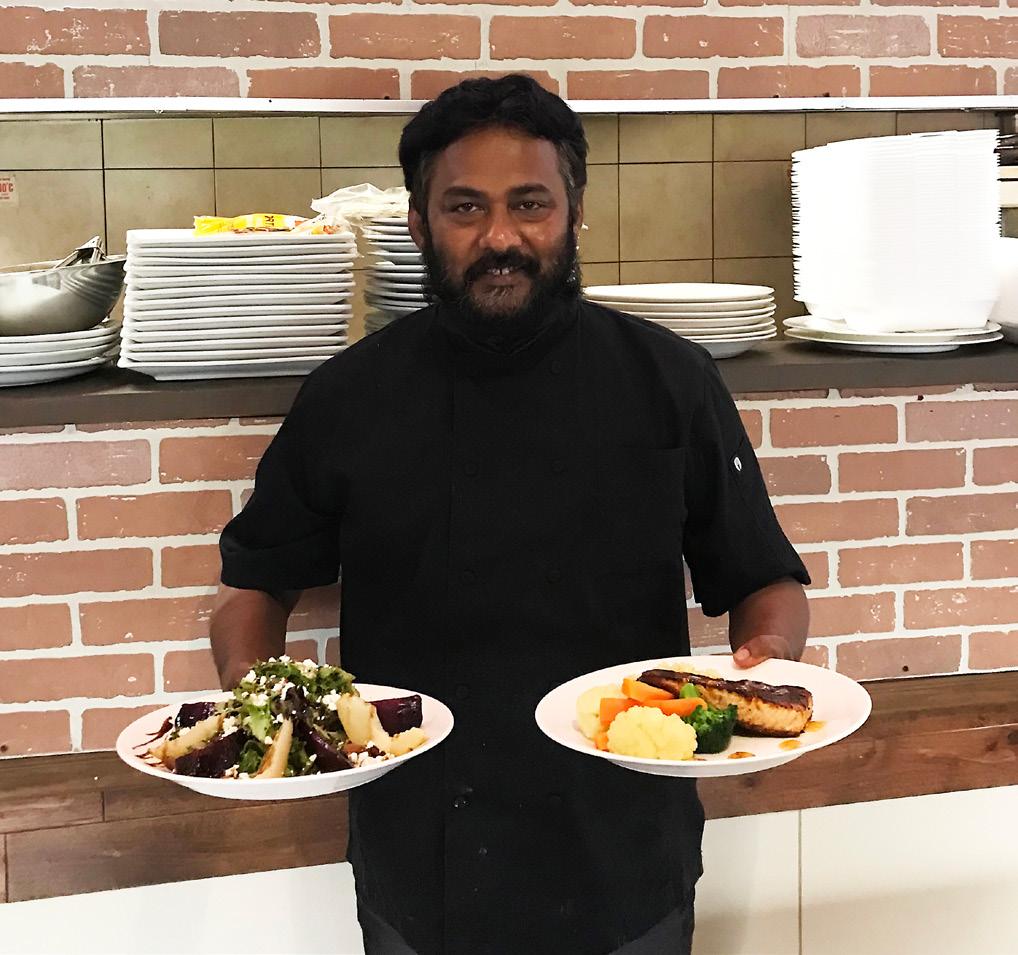
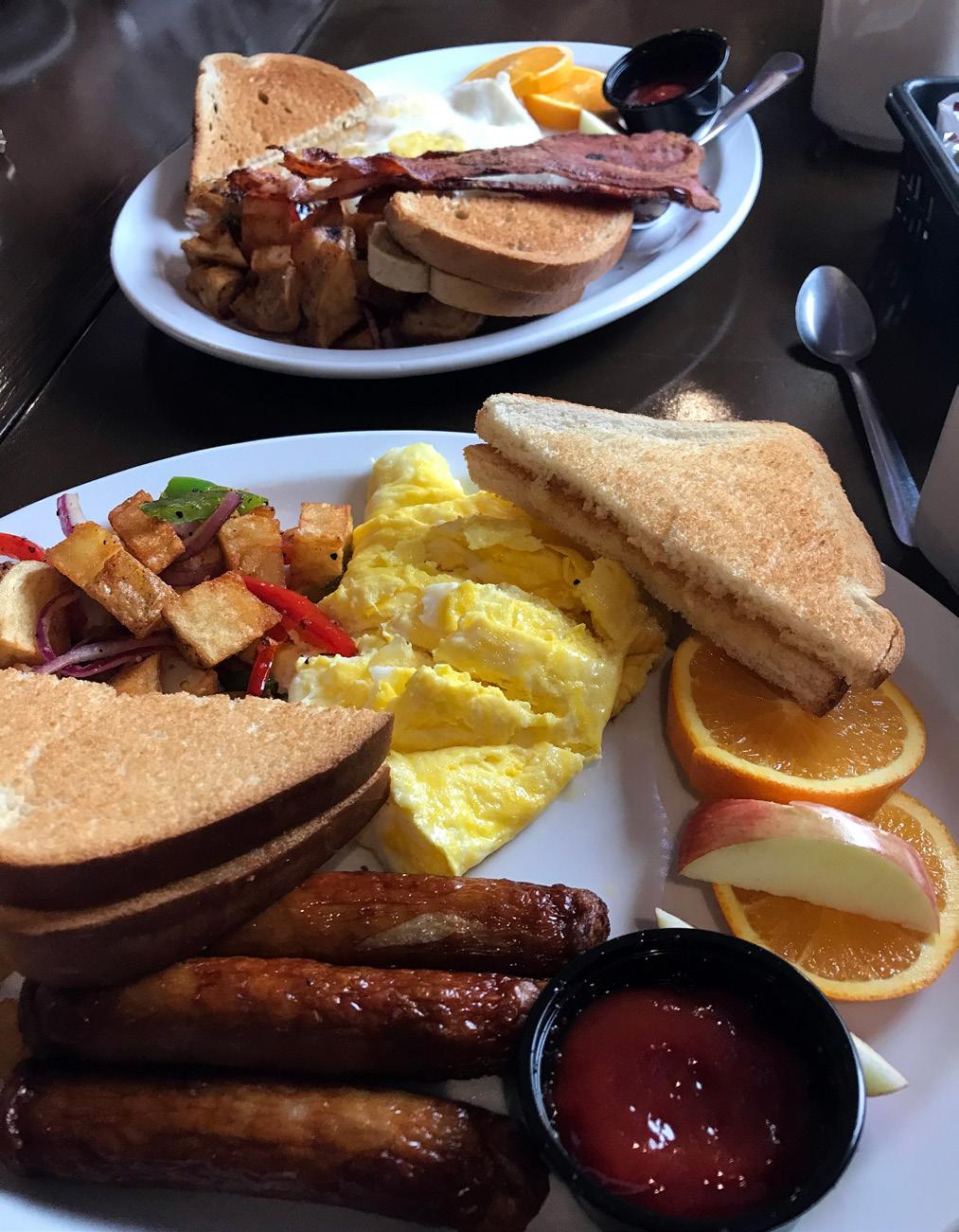
CBy Karen Irvine
hef Renato, an award-winning chef originally from Peru, has a remarkable background as both a culinary artist and a former professional swimmer. “I held the Peruvian national record for many years in the 200 and 400 medley. I swam competitively for 20 years,” he proudly shares.
Renato moved to Peterborough in 2004 and opened The Wellness Chef ten years ago. He brings a deep commitment to healthy living. “The biggest challenge when I moved here was the weather. In Lima, Peru, I lived on the coast where the sun shines every day of the year,” he recalls.
Renato’s culinary expertise shines through his fusion of South and North American cuisine, emphasizing fresh, local produce and high-quality proteins. He now resides in a tranquil home in Douro-Dummer with his partner, Shannon. “My quality of life here is much better than in Peru,” he says. His family is spread across the globe, with his brother still in Peru and his two sisters living in Germany.
Renato is passionate about integrating his love for gardening into his culinary practice. “I’m building a garden here and planning a class called ‘Make Your Meal out of the Garden.’ We’ll go out, pick fresh vegetables from the garden, and then prepare and cook a meal together,” he explains.
His goal is to collaborate with local farmers and suppliers to source the finest ingredients. “Just up the road, I get fresh eggs,” he adds, highlighting his dedication to supporting the local community.
Renato offers private cooking classes. Current offerings include “The Peruvian Experience,” “A Deluxe Taste of Peru,” “One Whole Salmon – Three Courses,” “Make Your Own Sushi,” and “Make Your Own Pasta.” His vision for the garden-to-table class is another exciting choice to his repertoire in the future.
In addition to cooking classes, you can hire Renato to cater events, private dinners or order custom meals delivered to your door. His meal plans feature healthy, flavorful dishes tailored to your personal taste and dietary needs. Renato’s passion for high-


quality, health-conscious cuisine is evident in every dish he creates. From personal experience, I can attest that his cuisine is exceptional!


The Olympia has been around since 1906, starting as an ice cream and candy shop. In 1930, it was bought by Chris Tozios and became The Olympia Tea Room. In 1980, Mrs. (Ma) Tozios sold The Olympia to Chris and Cathe Karkabasis. With a focus on honoring the enriched history of the location and their own Greek roots, while staying relevant in the community the Karkabasis consistently provided a warm, friendly place to dine.
Their daughter, Nicki Dedes, and her husband, Chef Costas Dedes, have been operating the Olympia for 27 years - and recently, their two children. Modern Mediterranean décor sets the stage for a warm atmosphere, while antique Olympia memorabilia placed throughout the restaurant lets guests remember the restaurant’s rich history with each visit.
The healthy Mediterranean menu includes classic comfort dishes. Products from Greece feature prominently on their menu (notably the Kalamata olives and olive oil) are imported from their parents’ Greek village. In the summer, the garage door front opens, welcoming everyone to alfresco patio dining. In the winter, a cozy fireplace and frequent jazz nights give locals and a warm reprieve from the cold.
I was welcomed with open arms. It was a unique interview starting with Costas very emphatically saying, “I do not take credit alone for our meals. It is due to the dedication of our team as a whole.”
Prior to living in Lindsay, Costas learned all aspects of operations at the fine dining restaurant, La Castile in Mississauga, owned by his family members. I lived in Brampton before
By Karen Irvine Editor, ATOTK
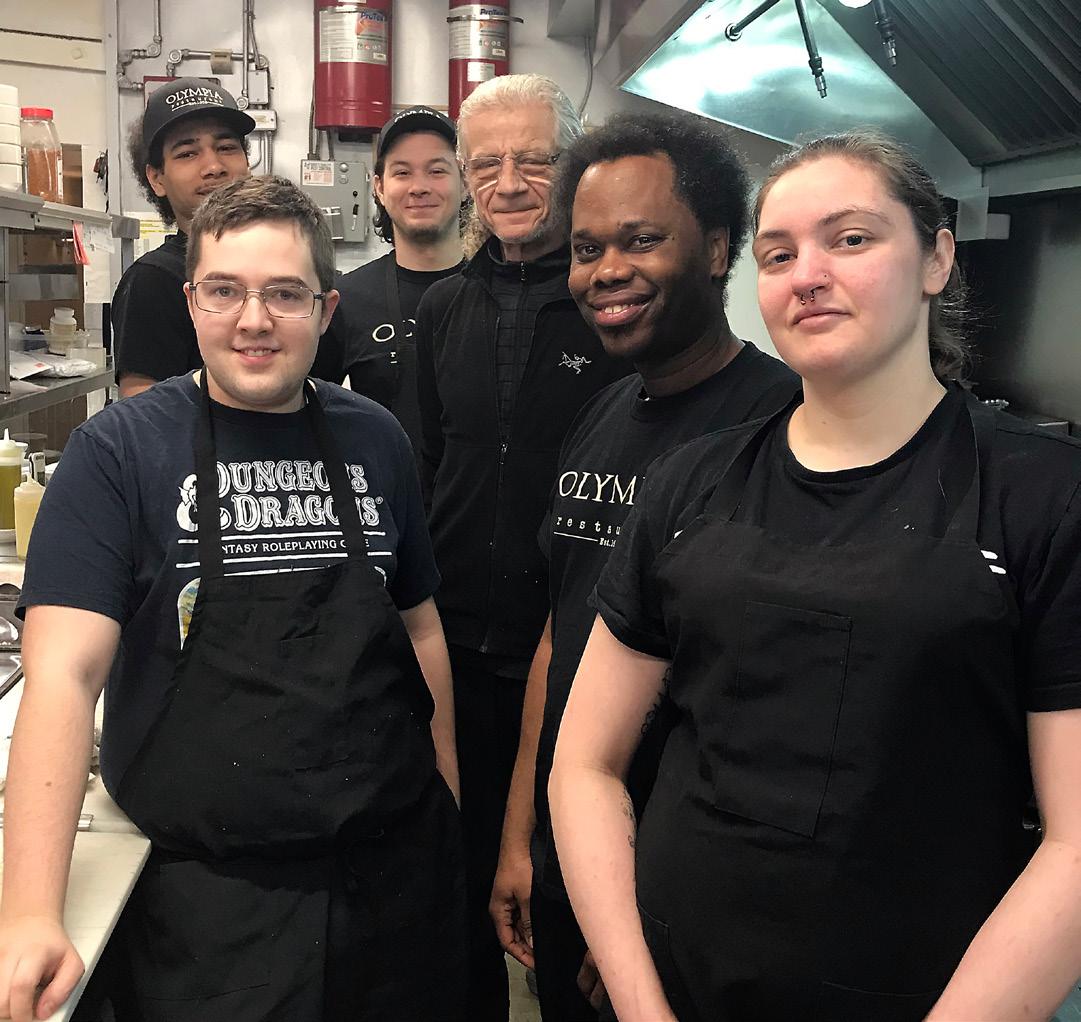
relocating to Peterborough in 2005, and I can tell you La Castile is well known as THE place to go for fine dining.
Costas says he is motivated by the textures, colours and the density of each dish. “I’m always combining different ingredients. I deconstruct the soups and reassemble them as I go. I start with something but may change it because of the colour, the texture. I’m trying to create something unique that the customer will connect to,” he says.
The tzatziki is better than I’ve ever tasted before - it’s creamier, tastier and richer. Costas says, “We make the extra effort. The most important things I’ve learned over the years is, one - you need a really good soup because that’s the first thing the customer will taste and, two - a really good coffee because that’s the last thing the customer will taste. We take the time to do it right.”
“I do not take credit alone for the meals. It is due to the dedication of our team.”

Costas says, “The goal of bringing Greek cuisine to Lindsay is to introduce the palate and the spices to our customers. We want to not just create it, but to use the best ingredients sourced from Greece along with local products. The foundation is the olive oil, which is imported from Greece.” The spanakopita, feta cheese, oregano, and lemon juice are also imported from Greece. The meat is sourced from a cattle farm near Janetville. The steaks are certified Angus steaks. Other local items are the ice cream from Kawartha Dairy and the bread from Mickael’s Bakery in Lindsay. Nicki says, “It brings joy to the heart.”
I truly enjoyed my time spent with Costas and Nicki. It’s not possible to simply talk about Costas alone in this article. They are a beautiful couple and their success is a combination of family and staff as a whole. Their love for each other is palatable and is what makes this feature so special for me.



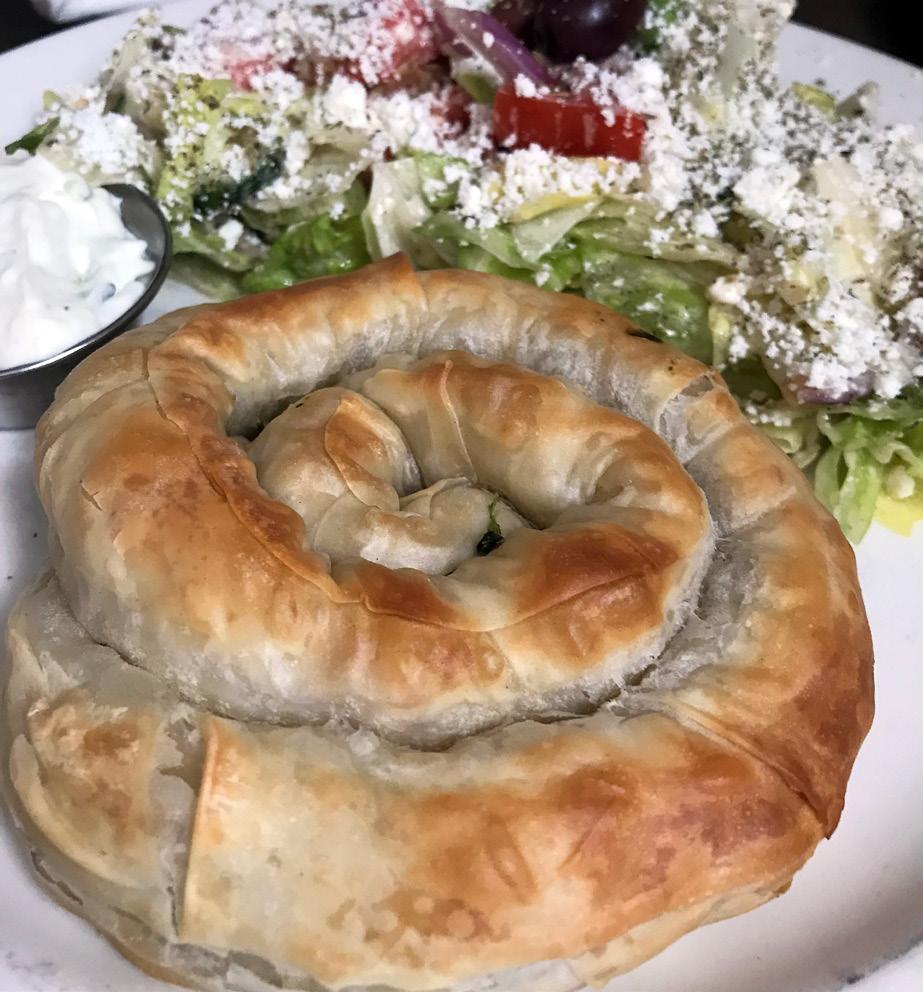

I
met up with Jeff at Elmhirst’s Resort. We had an interesting conversation and I learned a lot about what makes him tick. Chef Jeff is a Red Seal Chef who started working in the industry at a very young age. His mom got him a job at the restaurant she worked at. He has been a chef for 8 years, and has been Head Chef at Elmhirst’s Resort for the past two years overseeing 12 kitchen staff.
Jeff’s formal education is in Ancient History and Classical Literature. He laughs, “It’s easy to joke about, but I’d be lying if I said it hasn’t helped. Having formal education and being able to write well and express myself well has really helped me function in a leadership capacity.”
His favourite genre to cook is Barbeque. He says, “I Adore BBQ. We have a lovely hardwood BBQ program. We Smoke our own beef, duck, turkey and even tofu. It’s pretty spectacular. Also, charcoal is always a delight.”
There’s not much that Jeff doesn’t have a hand in, although he has specialists, such as a pastry Chef.
Guest satisfaction is his highest priority. He says, “It’s wonderful to hear from guests. You want to make sure everything is perfect. It’s connecting with people. We are on a beautiful lake and have a very specific identity, being a family business that has been here for generations. And we have food that’s grown right on the property. We have a sizable vegetable garden and a farm. What I care about is putting our best food forward.”
Elmhirst’s is a Feast On Certified property, which means we are part of the Canadian
By Karen Irvine Editor, ATOTK
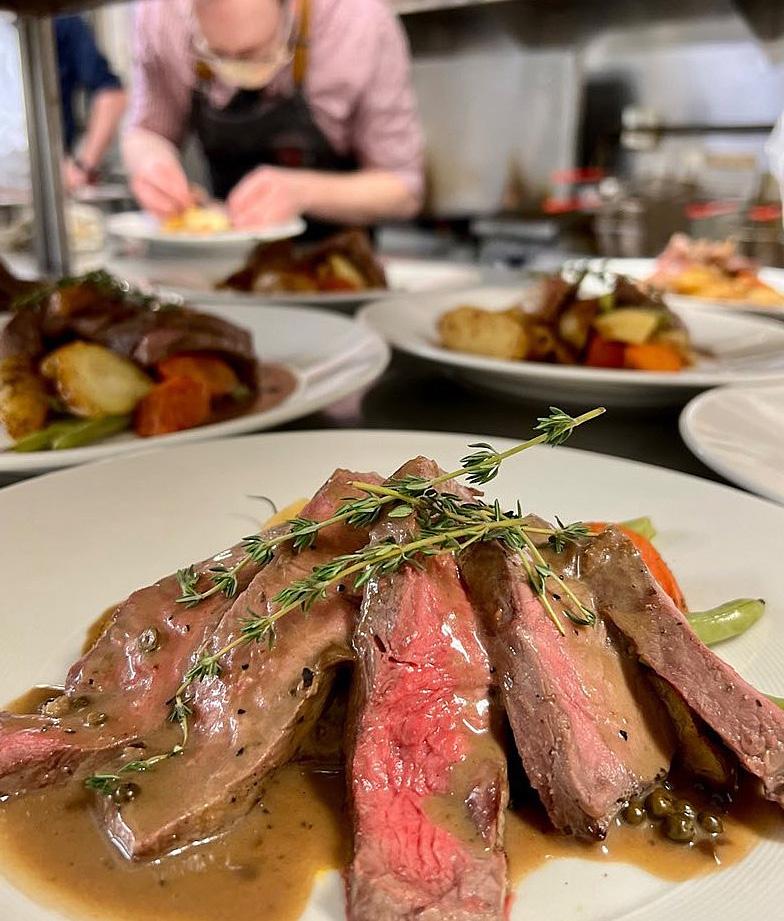
Culinary Tourism Alliance. Elmhirst dedicate themselves to representing Ontario. 49% of the food served is grown in Ontario, 25% is grown on their property and 95% of all alcohol is from Ontario. Having the farm makes it a truly organic experience. “We are very passionate

about Feast On certification. We raise our own beef, duck and turkey on the farm. It is an integral part of what happens at the resort. In the near future, the culinary team will be more involved in that, and will be involved in the cattle round up. The cattle are Angus and are very well loved and taken care of. They are finished sustainably in a local operation who have an ethanol plant and they use the spent cooked corn used to make ethanol at the cattle finishing plant. The beef is AAA and has very nice marbling. It is dry aged for three weeks, then wet aged for three weeks.
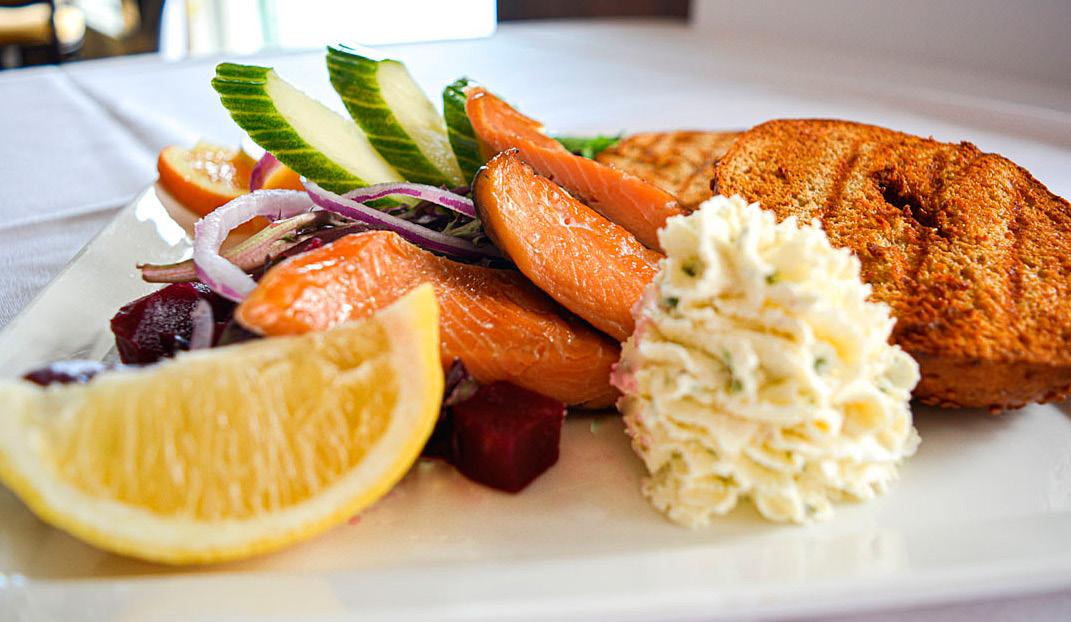

Chef Jeff is very enthusiastic about his work and says this is his dream job. He says, “Please come visit and enjoy some farm-raised beef, duck and turkey.”

It’s the perfect year to visit and use your Staycation Tax Credit that the Ontario Government is offering!
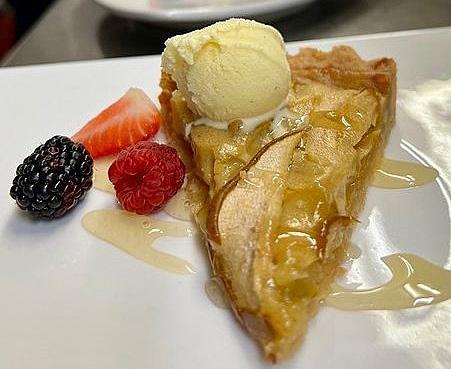


By Chef Brian Henry Food Editor, ATOTK
I recently was able to connect with Chef James Craig at Shantilly’s Place on Chandos Lake (owned by his sister, Shantelle Bisson). His culinary journey started 13 years ago when he was 35 after years of working in IT.
Chef Brian (CB): It’s a beautiful sunny weekend many are enjoying the day off. What are you doing today? Chef James (CJ): I’m working an 1pm to 11pm shift at the Chelsea Toronto.
CB: So why did you choose to be a chef?
CJ: I always enjoyed cooking so I decided to sign up for Second Careers through the province of Ontario and graduated from George Brown and am a Red Seal Chef. Due to my previous management experience I shot up the ranks pretty quickly. After school I went to the Distillery Corporation and worked at the Old Boiler House now known as El Catrine. From there I went to Scaramouche, one of the best restaurants in the city of Toronto.
CB: Is this where your career started to take off?
CJ: Yes. I learned a lot from Chef Keith Froggett and everything I learned there I have carried forward to where I am today.
CB: Is there any chef that you follow or look up to?
CJ: Not specifically. I try to every couple of months buy a cookbook on a cuisine that I haven’t worked with before. Most recently I picked up a copy of “My Korea” to explore Korean food. I don’t have a favourite cuisine. I like to dabble in all of them.
CB: It’s one of the things that pisses me off when people ask, ‘what’s your specialty or your signature dish?’ My title is Chef or Certified Cook so technically I should be able to prepare whatever is requested.
CB: So if I came by your home for dinner, what might be on the menu?
CJ: The other night I did a couple of filet mignon steaks for my wife and I with some sour cream and buttered smashed potatoes with yellow beans and a simple salad.
CB: Very simple old school food.
CJ: Exactly
CB: Got any favorite foods, cuisines or go to recipes?

CJ: I love making and I love eating food. My wife and I went to Cancun and did a Ceviche tour. We hopped on a local bus and toured around to 7 different restaurants over 7 days and tried different Ceviche. I’m really into bright citrus flavours.
CB: Ah, I do miss working in the Caribbean for those fresh flavours.
CB: Our profession’s sees the flavor of the week trends and fads that come and go, the very nature of which motivates our industry, how do you keep things real and balance it out with a contemporary approach?
CJ: There are always going to be staples. Like French Cuisine will always be a staple. I’m a fan of combining different techniques with different types of food. I almost said fusion. I really do hate that word.
CB: I was just going to say, please don’t fucking say fusion.
CJ: It’s like this is fusion or that is fusion but I just think of it as cooking and trying new things.
CB: I couldn’t agree with you more. Being of Irish
“You are never too old to follow your dreams!”
decent apparently it’s all about potatoes but potatoes originated in Peru. As people and spices were traded and sold around the world, foods naturally travelled with them. Most recipes are fusion cuisine regardless of point of origin.
CJ: Yes, a lot of Caribbean foods are west African. The dinner I did at Shantilly’s Marina was Middle Eastern, because I love their flavours. I spent some time working at Byblo’s (downtown Toronto) and a lot of that is North African.
CB: What makes being a chef worthwhile for you?
CJ: It’s the joy you bring to people. Serving amazing food that people love and is memorable. I love being a part of that. Creating memories for people.
CB: What fires you up or pisses you off in the kitchen?
CJ: Like a typical chef it’s the ridiculous mods (menu order modifications). The general public doesn’t seem to know that when they say they are allergic to something, we take this extremely seriously; we set up a separate station to ensure there is no cross-contamination. People don’t seem to know what a true allergy is versus a dislike and too many people just throw the word around.
CB: You mentioned something about leaving knives in the sink...
CJ: Oh yeah, back at George Brown people leaving knives in the bottom of soapy sink of water not realizing that someone could go into grab something and cut their hand off.

CB: Entering your career at a later age, how did you find the transition?
CJ: It wasn’t easy at first as a lot of people didn’t take me seriously because they thought I was so old. My experience managing teams before, as well as my wife and I having our boys at a younger age I coached a lot of hockey, lacrosse and baseball. Managing fifteen groups of parents will prepare you to manage anything.
(Insert lots of laughter)
CB: No doubt! That would prepare you for anything!
CJ: You know everyone’s little Johnny is the best.
(More laughter)
CB: I’ve got a soufflé in the oven, as I’m sure you do too. So what closing thoughts can you leave us with?
CJ: You are never too old to follow your dreams!



By Karen Irvine
I have been following Susan Tung since 2019 when she opened Hanoi House, a Vietnamese restaurant on Hunter Street in downtown Peterborough. I have eaten there on numerous occasions and love the fresh tastes. Oh, and the Vietnamese coffee is exceptional!
Susan Tung has been in the restaurant industry all her life - her family owned the Golden Wheel in Cavan until they retired in 2018. Thought she was only going to be back for a couple of years and go back to Toronto, but it didn’t work that way. She met her husband, who was a customer at the Golden Wheel and ended up staying. Susan felt there was a lot of opportunity in Peterborough in terms of cultural diversity in cuisine here.
During Covid, Susan opened another location for Hanoi House on Lansdowne Street and kept Hunter Street as a second restaurant called NAKA, a trendy Japanese restaurant. She says, ‘I actually had my eye on the Lansdowne Street location for a while, and when I saw the ‘for lease’ sign I jumped on it. It was very challenging during Covid to open a restaurant. The Lansdowne location is bigger with good parking and better wheelchair accessibility than the space on Hunter Street.
Morgan Bell is the Head Chef and explained the difference between Hanoi House and Naka. She said, ‘The biggest difference is the ingredients used and the flavours. Vietnamese food is very light, fresh, healthy, lots of herbs and more casual with an additional dinner menu with bigger, more entre items to appeal to the dinner crowd. Vermicelli, pho, etc.’
Naka is more Izakaya, which means gastropub in Japanese. Its heavier, deep fried, comfort foodstempura, fresh shucked oysters, karaage, udon, ramen, etc - more of a late night, cocktail vibe. Naka has a bigger cocktail menu, Japanese liquors, so it’s more of a bar vibe.’
Morgan is born and raised in Peterborough. Cooking was always a family thing for her. She learned

cooking at the George Brown Culinary program and the business side with menu building and admin at the Fleming Culinary program. Prior to Covid, Morgan worked for 7 years at Kettle Drums with the past owners, then at the Casino in the restaurant.
The atmosphere is very upbeat and the staff work well together. Morgan said, ‘My favourite part of the food industry is the comraderie you build with the people you work with – it’s amazing. It’s not an easy job, you work really hard and going through the hard parts makes you a stronger team.’
If you haven’t tried Hanoi House or Naka, I suggest you try both. You won’t be disappointed and you will keep it on your Best Restaurants list.

1. Hanoi House Fresh Shrimp Rolls with rice paper wraps, shrimp, lettuce, vermicelli noodles, pickled vegetables, cucumber, mint in a peanut dipping sauce.
2. Hanoi House Vermicelli – chicken marinated in lemon grass, mint, lettuce, bean sprouts, cucumber, pickled vegetables, peanuts and green onions with sweet fish sauce on the side.
3. Naka - Tonkotsu Ramen with pork bone broth, chashu pork, marinated egg, woodear mushrooms, green onion, bean sprouts and nori

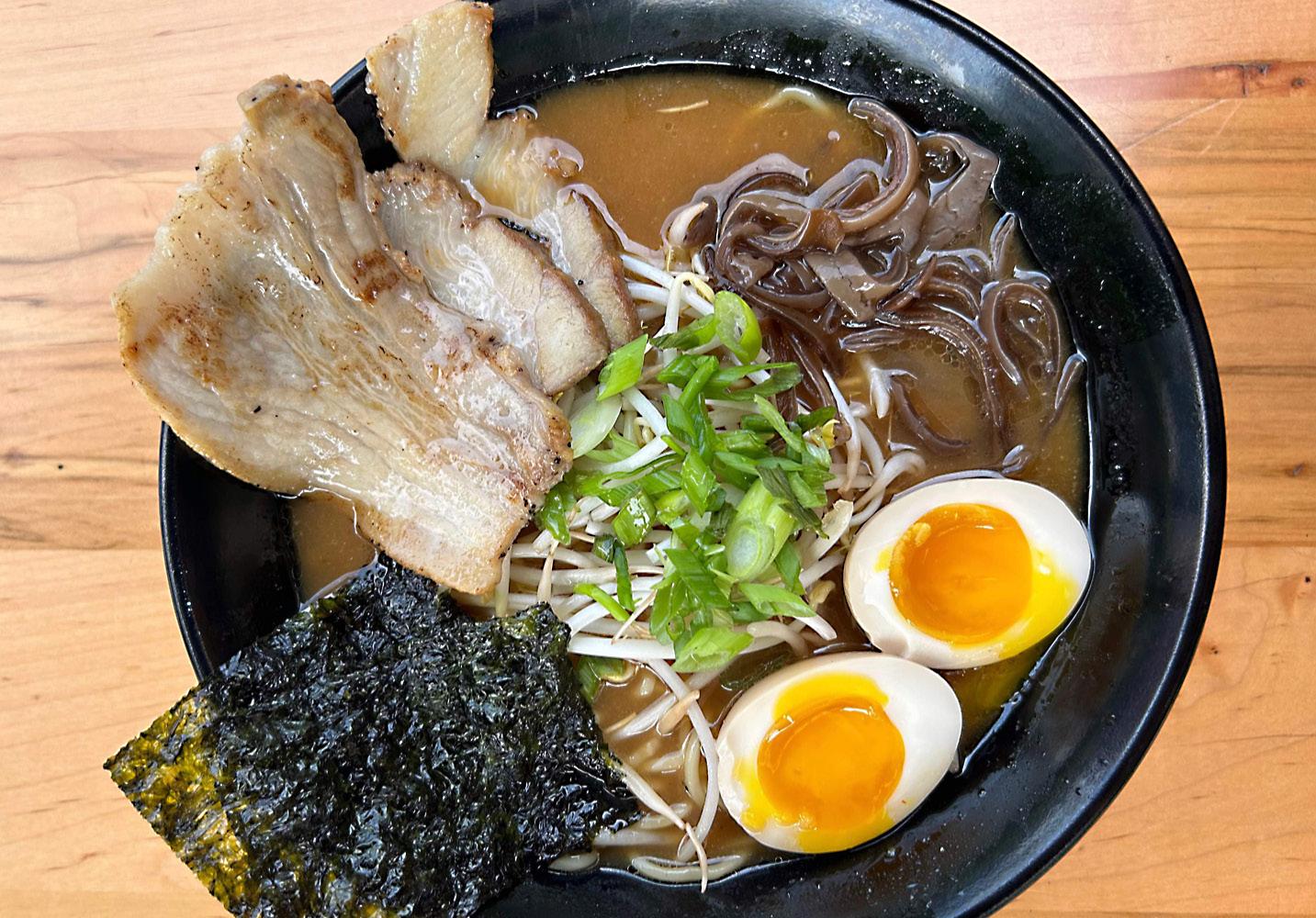


By Karen Irvine
K
evin Olinger, the talented chef behind the culinary experience at Rolling Grape Vineyard, brings a rich background in gastronomy and hotel management, shaped by his Swiss roots and international influences.
His journey from Switzerland to the Kawarthas and eventual collaboration with Jon Drew, the vineyard’s owner, reflects a deep passion for diverse flavors and experiences.
Kevin feels his worldly experience was beneficial to his becoming a chef. He says, “The more versatility you can get, whether it’s through tasting and traveling or just influences that you have along the way, the better.”
Kevin’s favorite cuisine to cook is a blend of Italian and Swiss traditions, reflecting his upbringing and culinary education. He cherishes the interconnected flavors of Italian dishes while embracing the depth and richness of Swiss cooking, instilled in him by his family. “I don’t want to discount Italian cuisine because it’s my favorite. At the hotel in Switzerland, a lot of Italian chefs and pizza chefs would come over. I learned a lot from them at a young age. There’s a lot of depth to Italian cooking, so much more that meets the eye,” he says. “Also, I still like cooking a lot of Swiss cuisine that my dad taught me and that I’ve learned over the years. I just love cooking for people.”
The vision at the vineyard is to enhance the beloved charcuterie and pizza offerings while introducing fresh ingredients, innovative specials, and lighter options. Also, adding station-oriented cooking for events and curated cheese and wine pairings showcases commitment to providing a fulfilling culinary experience for guests.
Kevin says, “People really enjoy the charcuterie and the pizza. So I’m not going to mess with that. Bring in some specials, stay really fresh, introduce some lighter fare and salads, do more specials and features. The Friday tacos are a huge seller.”

Of course, you will be able to see how their dishes pair with their delicious wines. “We want to make sure that we choose which cheeses and cured meats go with which wine, along with the accoutrements,” Kevin says.
The vineyard’s event space, designed for all events, weddings and gatherings, sets the stage for unique dining events like Harvest Dinners, where guests can enjoy carefully crafted menus in a communal setting. By focusing on creating lasting memories and meaningful experiences, Kevin and his team aim to cultivate a loyal following of guests who appreciate the fusion of exceptional cuisine and fine wines.
Kevin will be curating the Harvest Dinner, which are a long table dinner. He says, “I’ll have a hand in it, and the team, which I’m very lucky to have, will have a little bit more ownership.”
Nestled conveniently near Rice Lake and Highway 28, Rolling Grape Vineyard offers a picturesque backdrop for visitors seeking a relaxing retreat or a memorable wine and dining experience. Whether enjoying a flight of wines, joining the Wine Club for exclusive benefits, or attending one of the vineyard’s many events, guests are sure to savor the culinary delights and warm hospitality that define Chef Kevin’s culinary vision at Rolling Grape Vineyard.
The vineyard is in the perfect place to stop by while out for a drive or on the way to the cottage. Rice Lake is near and the vineyard is close to Highway 28 going to Port Hope or to Peterborough and north. www.rollinggrape.com
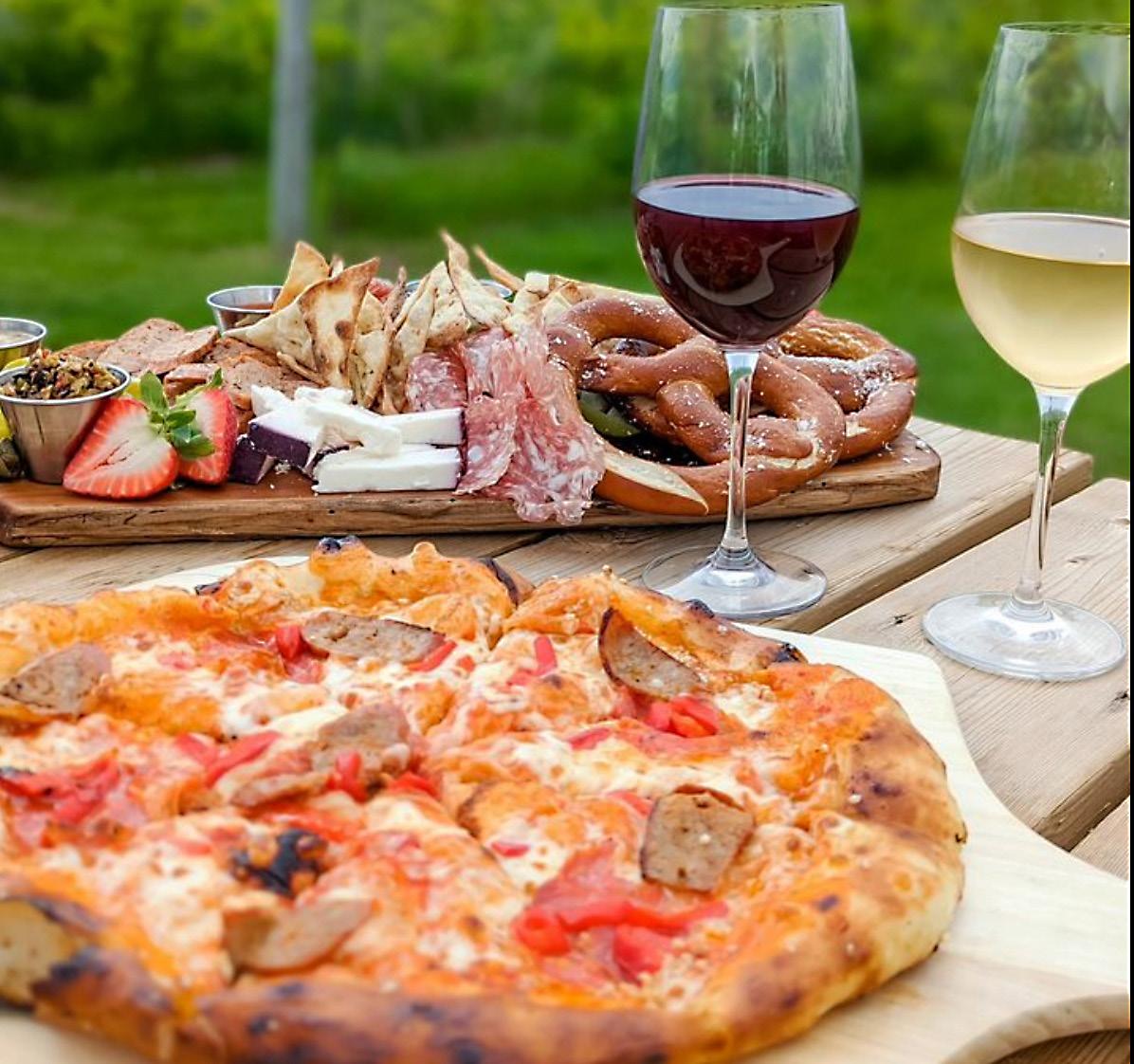


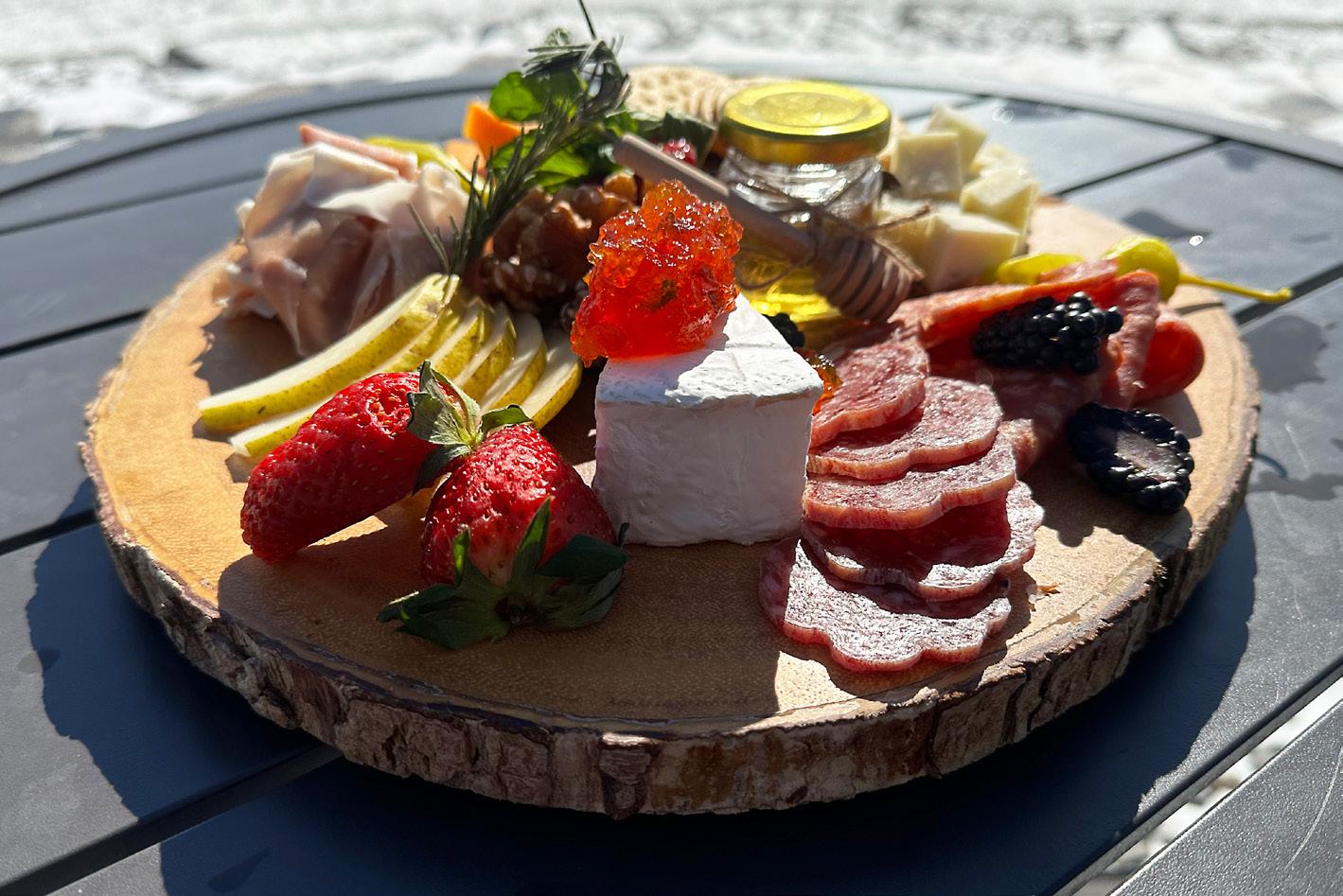

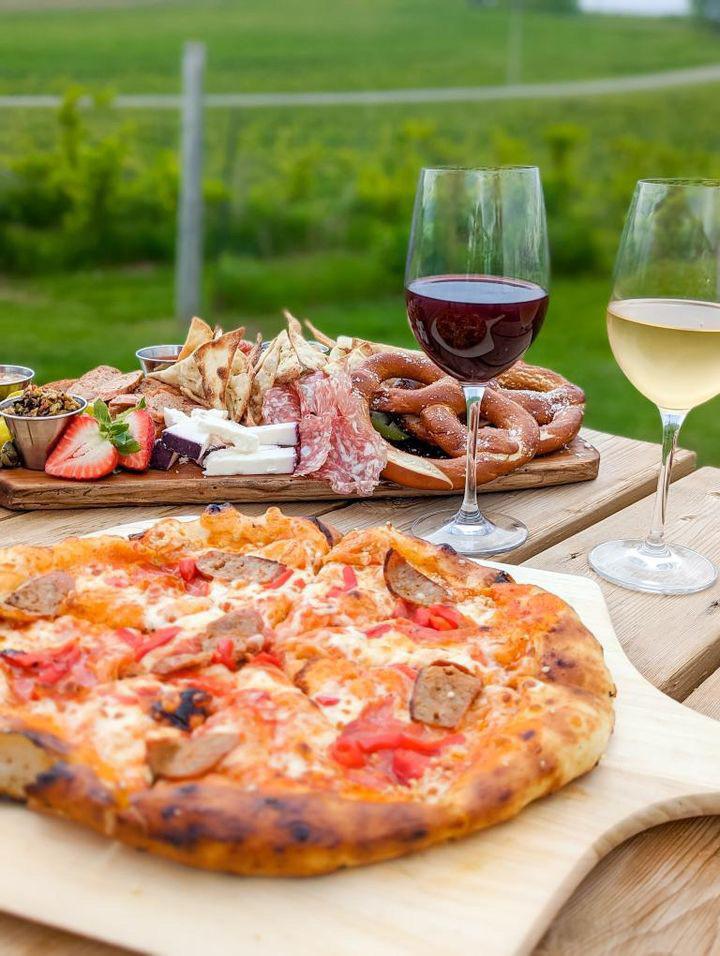
Grape Vineyard is open from March to December and is now booking weddings for

By Karen Irvine
I met up with Executive Chef Greg at Chemong Lodge. I had the best time chatting with him! We talked about his life. From Winnipeg to Toronto to Manhattan to Mexico to the Kawarthas, Greg has owned and worked in many restaurants. It’s an incredible story and includes many celebrities! He has overcome addiction and is living his best life.
Greg lived in Winnipeg in his teens. He says, “1971 was not a big time for gay people. I never gave it much thought. I left to get the fuck out. Family life wasn’t good. I reference the Menendez brothers. Jokingly, but not. And crazy.”
At 18 he moved to Toronto to work with “the fabulous Cecil Troy, who was a mad gay artist collector of Canada folkloric art in Rosedale.”
Greg lived in the1970’s scene on Queen West in Toronto, and says, “We pioneered a culture in Toronto. Not just restaurants, I’m talking Carole Pope, the punk scene. The Horseshoe Tavern really was the key to all that (and they also owned the Bamboo Club). Hanging out with Mary Margaret, Catherine O’Hara , Joni Mitchell, Gordon Lightfoot - who could forget? It was just so much fun because it was like the artists were given all the building blocks to create this scene. You know, that was us. It was not New York, yet New Yorkers fell in love with us and embraced Canadian artists. I played the clubs when I was in bands - the Time Twins and the Parachute Club). I was a minor player, like a percussionist monkey man.” (he laughs)
Greg was part owner in his first restaurant, The Parrot. He says, “Andrew (his partner) is still a fabulous friend. I learned a ton from him.”
He moved to Manhattan for two years and says, “1981 to late 1982 - the summer of my life. We had a restaurant that was disco, but also new wave. It was the start of the AIDS culture. New York was a very dark place and reckless, decadent beyond belief,” he says. “The attitude towards AIDS was really disheartening. People would actually treat it as if it’s a gay disease and it absolutely was not. And unfortunately, when we learned things, it was an experience that
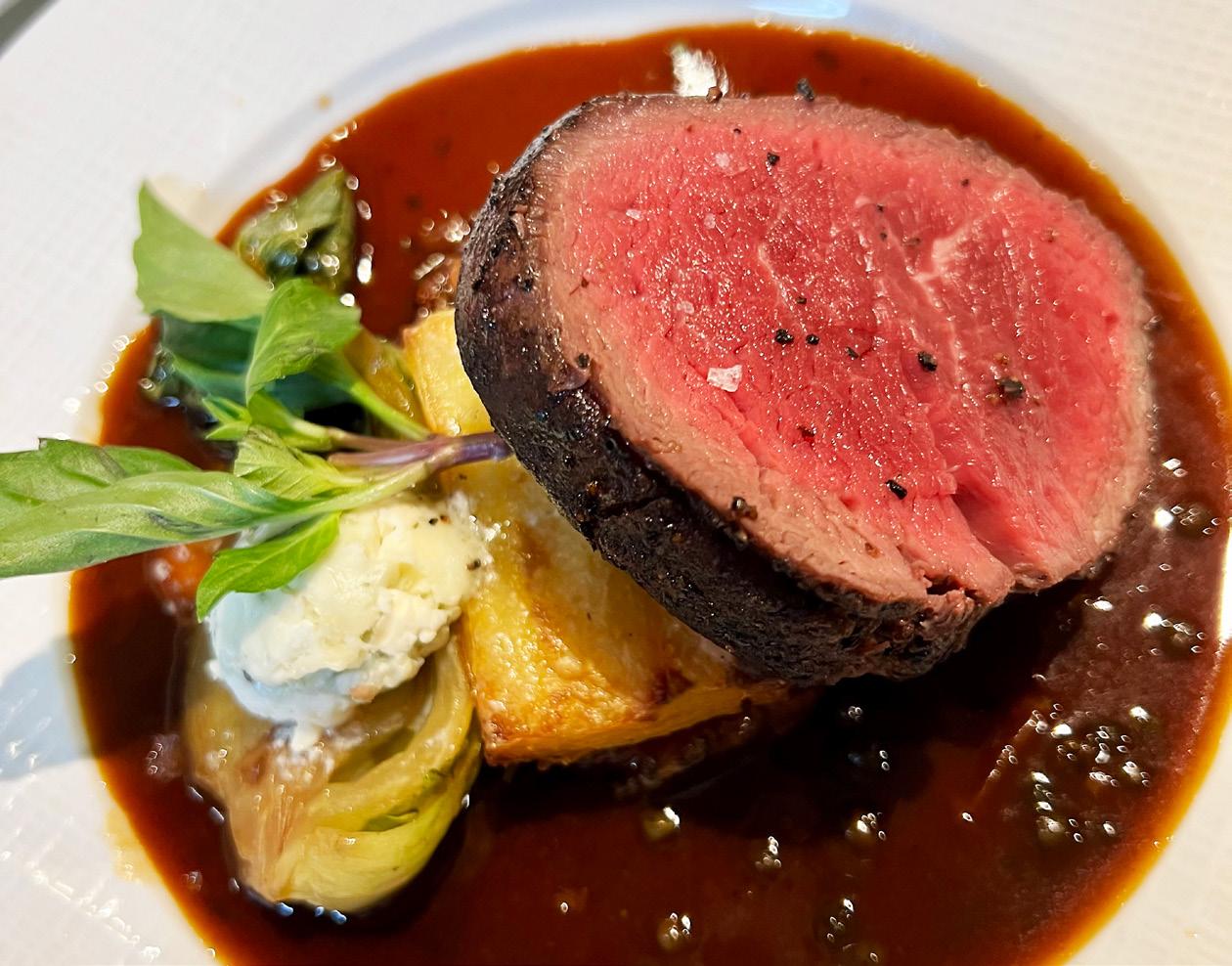
could kill us. I learned so much living in New York in my twenties - it was mind changing.”
He was a partner at, Stelle, a restaurant in Toronto in 1986. “That’s where all the movie stars came. It was 30 seats and fabulous! Very new wave, punkish, sophisticated, classy. It was kind of like being in a spaceship. The walls were padded with white upholstery and everyone wore white shoes, white pants, white runners. The stars came out - Robert DeNiro, Susan Sarandon, Jane Fonda, Lily Tomlin, Tom Cruise, the boys from Rush. And it was just beautiful and a lot of excitement for a town that was not a culinary Mecca. So, the fun part was, you never knew who was in the room. That’s because people acted normal. I remember the night Grace Jones came into my restaurant. I nearly died. Grace Jones, for me, was incredible. The Empress of Everything and so stunning! And my friend who had been part of the Queen Street scene, Jeremiah Chechik, became a big photographer for Vogue. All of these people just did magnificent things on different scales, but all beautiful.”



“The stars came out (at Stelle) - Robert DeNiro, Susan Sarandon, Jane Fonda, Lily Tomlin, Tom Cruise, the boys from Rush, Grace Jones.”
“The 1980s really changed food a lot. President’s Choice was genius on Dave Nichols part. It had not been done, that kind of branding, that vision. He had a team of scouts who sourced products for the Too Good To Be True line. My best friend and Maitre’d at Stelle told me they came in 3 times and put the sauce in a container from my Bangkok Chicken. I never thought about it again until Presidents Choice brought out Memories of Bangkok. And I got it into my head, like a buzzing bee in my bonnet. I thought, those fuckers! Then I got a call from Terry Nichols saying they wanted me on their Too Good To Be True label. They offered me $5,000 but no residuals. We ended negotiations where Nichols got the name and I got 3 cents per item. I made around $11,000, which was better than $5,000. But certainly not the hundreds of thousands I anticipated. I thought this has got to be a million seller. (laughs) But it was all fun.”
Greg later opened a restaurant, China Blues, in Toronto with his partner, Craig Howard. “It was a sensational restaurant. I cooked for Liza Minelli. She had just got out of rehab and would ask for a cranberry juice with a wink, meaning add vodka. (he laughed) Mila Mulroney and Hilary Weston would also eat there. So many stars came in!”
Why not own a restaurant now? “I’ve thrown off the shackles of being responsible for a restaurant. I can write my own ticket, and I do. I think perhaps I always have. But I’m adamant now about saving time for myself, enjoying smelling the roses, going to the little markets in Mexico and Peterborough. It’s a lot more fun now.”
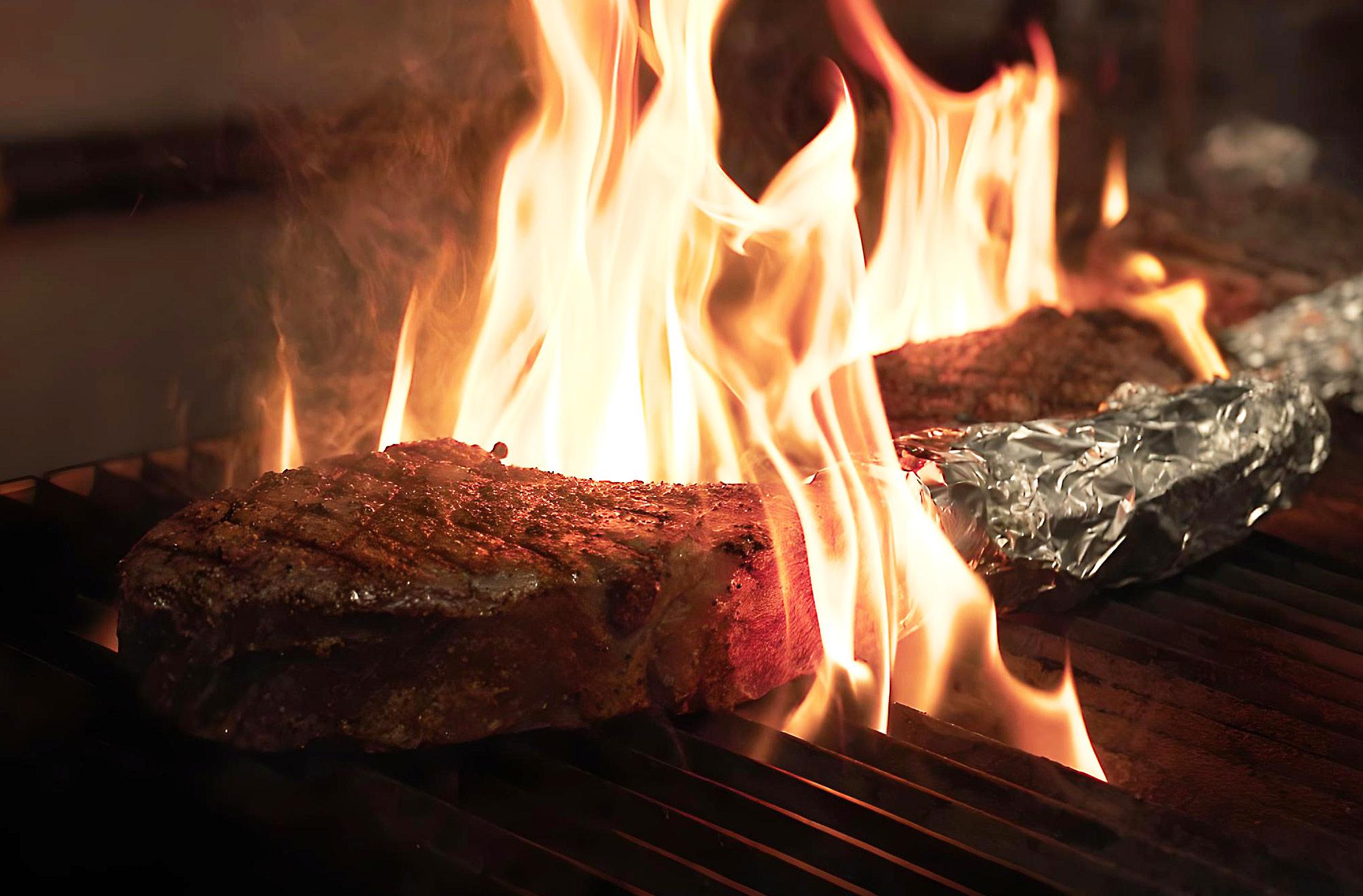
What is Chef’s favourite dish? He says, “Mother India and it’s kind of like the cuisine, very obscure, called Nonya. It’s a mix in Singapore, India, China, Burma. I love the Caribbean cuisine. I love Vietnamese. Our first dinner here was a French Vietnamese hybrid I’ve been doing for years. I was honestly probably the grandfather of fusion back then. Toronto really helped. I lived in the Spadina corridor, Kensington Market. So there were Eastern European Jews and the Chinese and the Vietnamese and then Jamaicans. Each one brought more and more.
During winter, Greg is the Chef at a boutique hotel, Chantilly Mare in Mexico. “The street food in our village, the mothers, the grandmothers hand pounding tortillas is fantastic. Oddly enough, going to Mexico sobered me up. I saw so much beauty there. It wasn’t anything that happened. It was just that life could be this much better and I don’t have to be in Toronto. No cars, no sirens and I have a little home in the jungle.”
While Greg is in Mexico, Chemong Lodge is in good hands. He said, “You know, the barbecue by Dr J’s BBQ, the smoking (which is superb), the great staff. I’ve been training them on the essentials - all the stuff I’ve picked up over five decades.”
The Supper Club. Greg said, “I have done Supper Clubs before and it suits me really well. They are 6 course menus.” It’s starts with a social - drinks and little bites in the side veranda, and then moves to the separate dining room with communal dinner tables. There is usually a cocktail, soup, appetizer, sorbet, main course, dessert, and a beautiful wine selection.
How did Greg end up at Chemong Lodge? He says, “I was born at Trenton Air Force Base. Air Force trash all the way. (he laughs) I worked with Adam, one of the Chemong owners. He was my bartender almost 20 years ago at the Spice Room and Chutney Bar in Hazleton Lanes. When he bought Chemong Lodge in 2021, I thought, this could really work. I love this area and all the little towns. And part of it is, Toronto is just massive. When you reach a certain age, a lot

of people don’t like that craziness. The big city is a young people’s game. It’s gorgeous here, very soothing, and that was part of it too.”
“When I’m in Mexico. I am remote, on an eco beach. It’s 200 miles of coast from Puerto Vallarta and is really well hidden. But the whole thing was, I discovered the peace and quiet and being able to cook.”
“I really like working. I think you need a life because work is artistic. And so I’m getting my artistic feelings out by cooking.”
“It’s just so lovely and peaceful and quiet. The way I want to live. People always ask me, are you happy? Yes. I’m making my own happiness”.

By Karen Irvine
J
ake had always been immersed in the art of cooking. It wasn’t something that simply came to him later in life—it was a family tradition. “I’ve been cooking since I was a child. It’s just been in our family forever,” he reminisced about how it all began.
His passion for cooking had deep roots, thanks to his grandfather, who was of Mennonite descent. “My grandfather taught me a lot about smoking meats and food preservation. Sundays were spent making sausage, borscht, and preserving food. The whole family would gather, and we’d use whatever was leftover from the week,” Jake recalled. The kitchen, with its constant hum of activity, was where he learned the old-world skills that had been passed down through generations. “Nothing went to waste. The fridge would get cleaned out, and my grandfather would boil a pork hock all day long, turning whatever was left into a hearty borscht. That was dinner for the week.”
Jake’s connection to food and the memories it brought was as much a part of him as the flavors he crafted in the kitchen. “Yeah, it’s like feeling memories come alive when I cook,” he said. “You can even feel when you’re about to cut corners or make a mistake. It’s all those lessons my grandfather taught me.”
With no siblings to carry on the family name, Jake became the last to hold the torch for the Friesen family’s cooking legacy. “We’re the only Friesen’s here in Ontario who will continue this tradition. My grandfather didn’t get to see the business take off, but I know he would have been proud.”
In 2018, Jake turned his love for cooking into a business, starting with a small shop in town. But it wasn’t long before it outgrew that space. “At first, it was part-time. But then the business took off, especially after we moved to Campbellford during the height of COVID,” Jake said. The catering side of things exploded, and soon he was juggling weddings, corporate events, and community meals. “We started doing catering in 2021, and it really gave us the freedom to expand without the constraints of a store -

front. We could cook on-site for weddings and special events, using a smoker and grills to create that live-fire experience.”
Jake’s catering business specialized in southern barbecue, with staples like brisket, pork, and ribs. He also catered to more casual wedding budgets, offering smoked beef and chicken for the majority
“My grandfather (who was of Mennonite descent) taught me a lot about smoking meats and preserving food.”
of events. “The whole point is to make everything fresh, hot, and cooked over an open flame,” he emphasized. The personal touch was essential. Jake’s kids were involved too. “My youngest is the face of the business at events. He’s only 16, but he’s grown up with it all and knows exactly what to do. And my wife’s kids help.”
Despite his growing success, Jake kept things simple. “We don’t need anything flashy. It’s all about the quality, the food, and the people. We’re fortunate to be able to work with great clients, and we always strive to use local ingredients.” Local meats, cheese from nearby dairies, and bread from a local bakery were staples in every dish he served. “The best bread comes from Doohers in Campbellford. And I wouldn’t dream of using cheese that didn’t come from Empire. It’s all about supporting the community.”
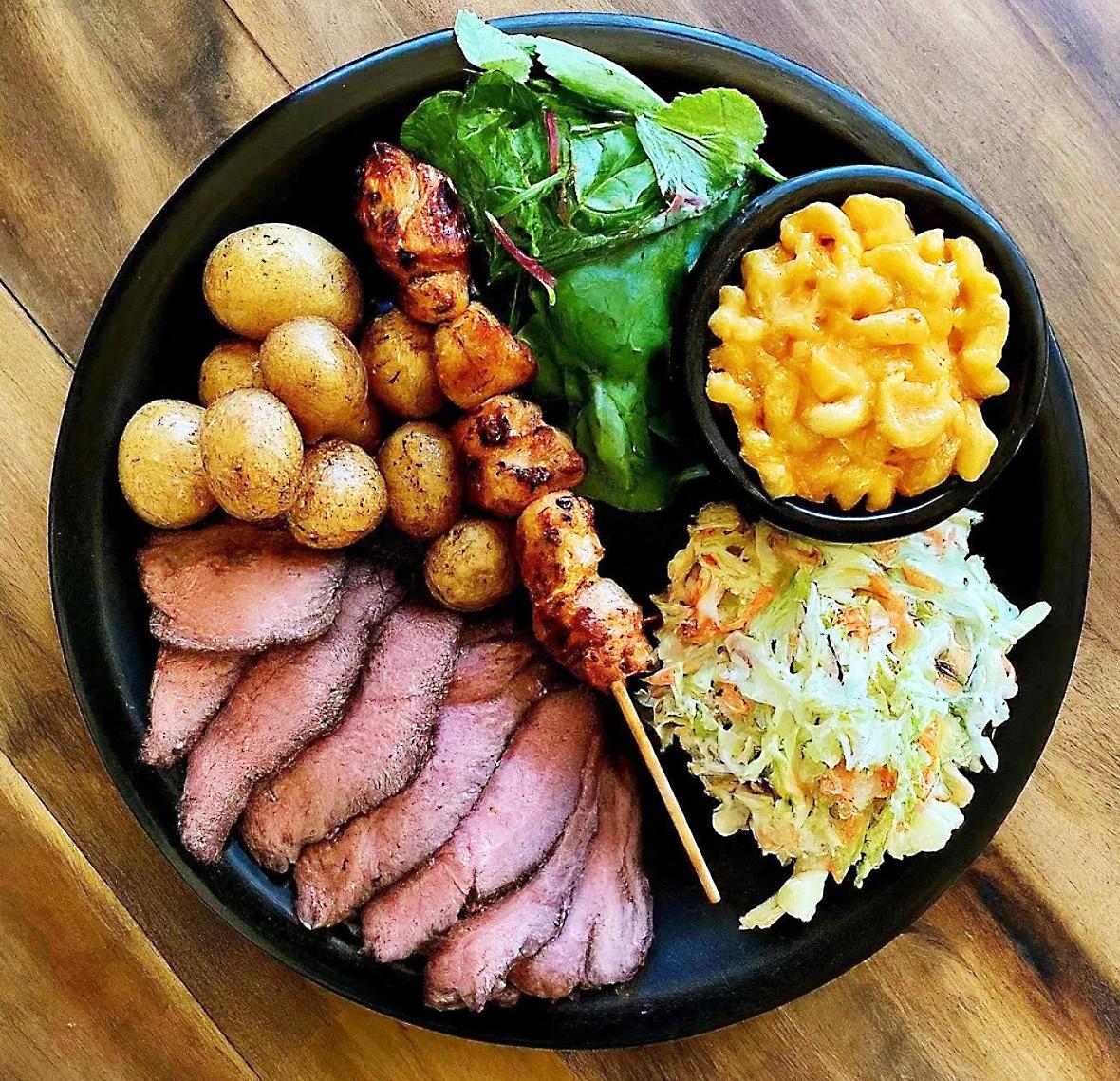
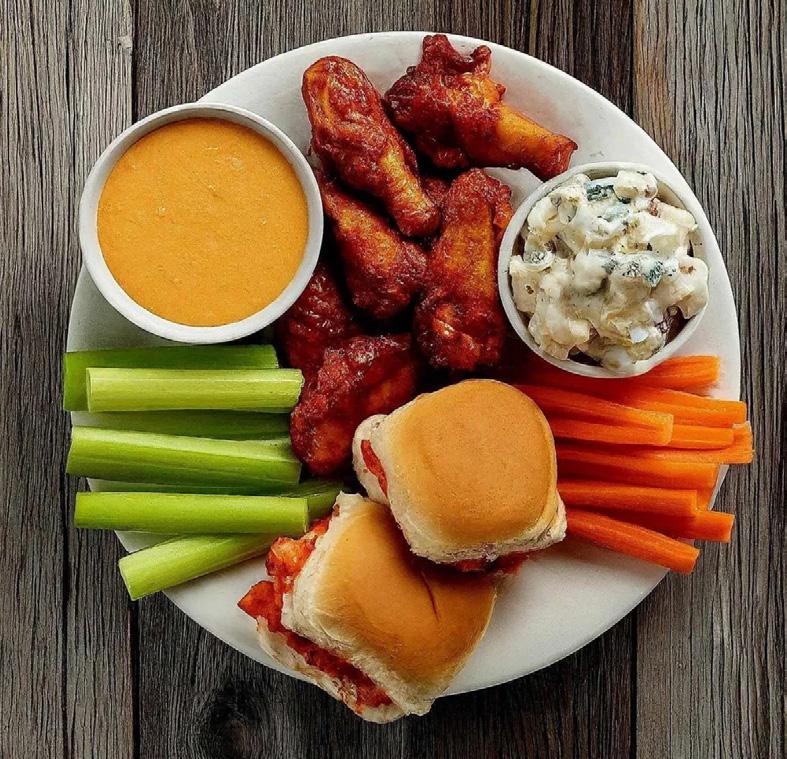
But it wasn’t just about the food. The catering business allowed Jake more time for his personal life. He could explore his creativity with corporate lunches or organize community meals. “It’s fun because I can get creative with those. Every week, I cook something new for schools, and it’s a chance to experiment,” Jake said, his passion evident in every word. “It’s all about keeping it fresh and making people feel like they’re part of something special.”
Looking ahead, Jake was proud of the legacy he was carrying forward—a legacy founded in family, tradition, and love for food. As he cooked, the memories of his grandfather stood by him, a reminder of where it all began. “It’s more than just a business for me. It’s a way to honor my family’s history and to share that with the people we serve.”
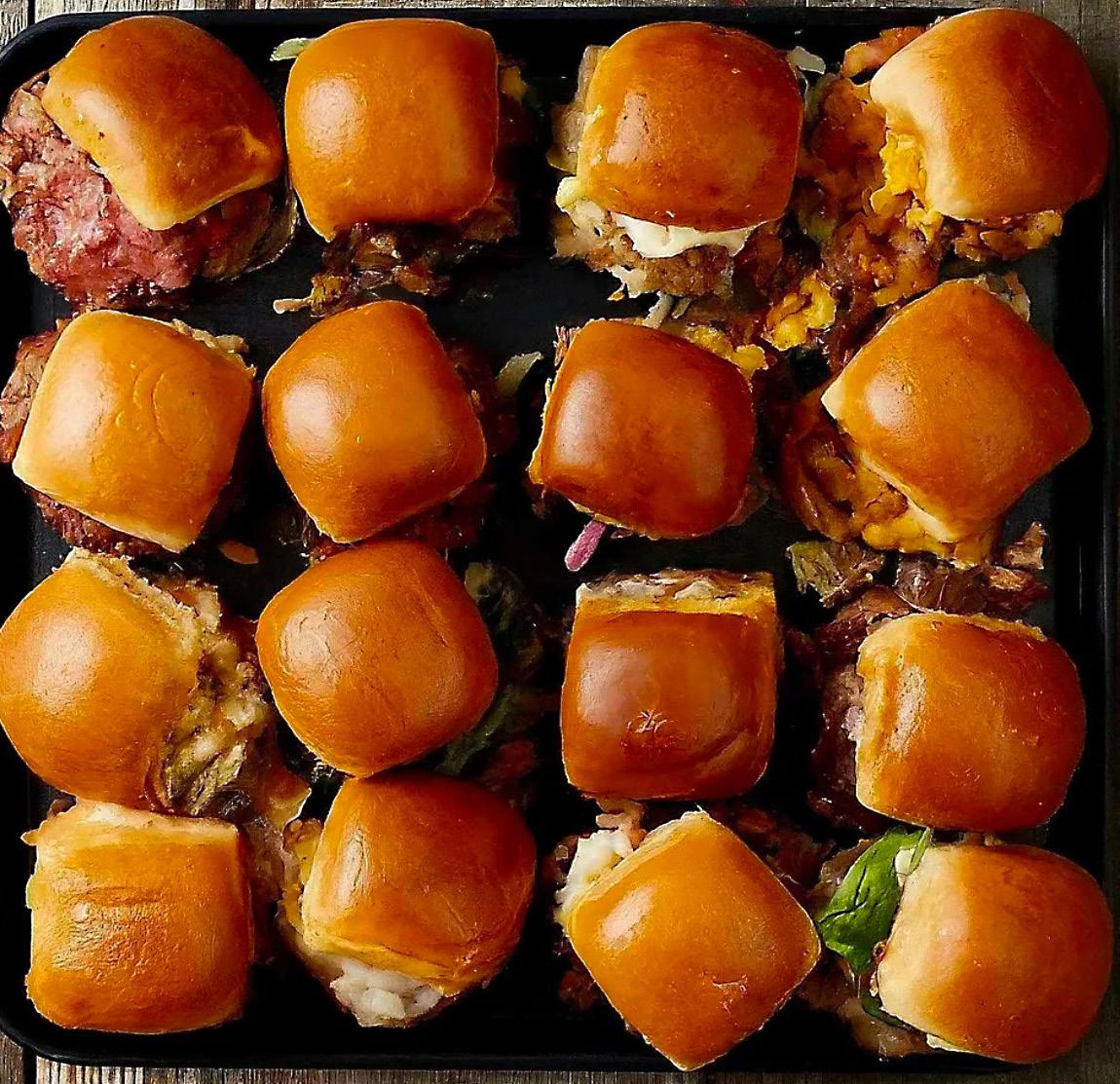




CBy Karen Irvine
atching up with Glenn Ford, the head chef at Island Cream Caribbean Cuisine in Peterborough, was a delight. Glenn and his wife, Saburah, were among my favorite stops on the now-disbanded A Taste of the Kawarthas food tours. Their kindness, warmth, and community spirit are truly inspiring. Originally from Trinidad, Saburah met Glenn in Canada in 1972, and they have enjoyed 55 years of marriage.
Glenn’s culinary journey began as a bush cook in the Caribbean. “We would buy a chicken leg and cook in the bushes. I learned by trial and error,” he recalls. “Food to me is about taste. As long as you make it taste good, that’s it. Any food can taste good.”
A love for roti since childhood fueled Glenn’s passion for perfecting the dish. He explains, “I always loved roti as a little kid, so I learned to make it. That’s what made me a great roti maker. We keep learning and improving. When I first opened the restaurant, a customer asked why the food was nice but different each time. That’s when I realized consistency was key. We started focusing on perfecting one recipe.” He adds with a laugh, “When Saburah cooked, it tasted one way, and when I cooked, it tasted a bit different. We just had to ensure we had one recipe.”
Island Cream is renowned for its rotis, a staple in Caribbean cuisine, while Jamaican cuisine is famous for jerk chicken and ackee. Glenn highlights the use of Madras yellow curry in their dishes, differentiating it from the red curry used in Pakistani cuisine.
Despite many years in the business, Glenn’s passion for cooking remains undiminished. “I love cooking! You know your food is good when people want to take leftovers home. We serve the best quality food with fresh ingredients like coriander and onions.”
Generosity is a hallmark of their service. “People often say they get two or three meals from our

portions. Our policy is to provide a full serving to every customer.”
Glenn and Saburah deeply appreciate their customers. “We could never have done this without people continuing to come in. We treat people the way we want to be treated.” Before COVID-19, they operated as a cash-only business. Glenn recalls, “The first time I went there, I didn’t have any cash. Saburah simply told me to pay later. It builds trust and respect. Very few people would do that.”
Reflecting on life, Glenn shares, “Money is not life. Most people are honest. I come from the streets of the 60s. I’ve changed my life, and it’s a
good thing. I hope people recognize our honesty, sincerity, and good quality food. Life is getting harder, and we all need enjoyment and a good plate of food.”
During COVID-19, their front window was smashed. A GoFundMe campaign covered the repair costs, and the surplus was donated to the food bank. About a year ago, a young man damaged their door, and a good Samaritan paid the repair bill anonymously. “We didn’t ask for anything. I had my own money, and someone paid for it. It made me so happy. When you live with goodness, it breeds goodness. We feel a sense of community here.”
Their reputation extends far and wide, attracting customers from Montreal, Ottawa, and Toronto. Glenn fondly recalls, “One lady, a teacher, used to come here before moving to Hong Kong. Her first stop from the airport was Island Cream Caribbean Cuisine. It’s a beautiful thing. The vibe is wonderful.”
Glenn and Saburah’s story is a testament to the power of good food, community spirit, and genuine kindness. Their commitment to quality and their customers has created a beloved culinary haven in Peterborough.

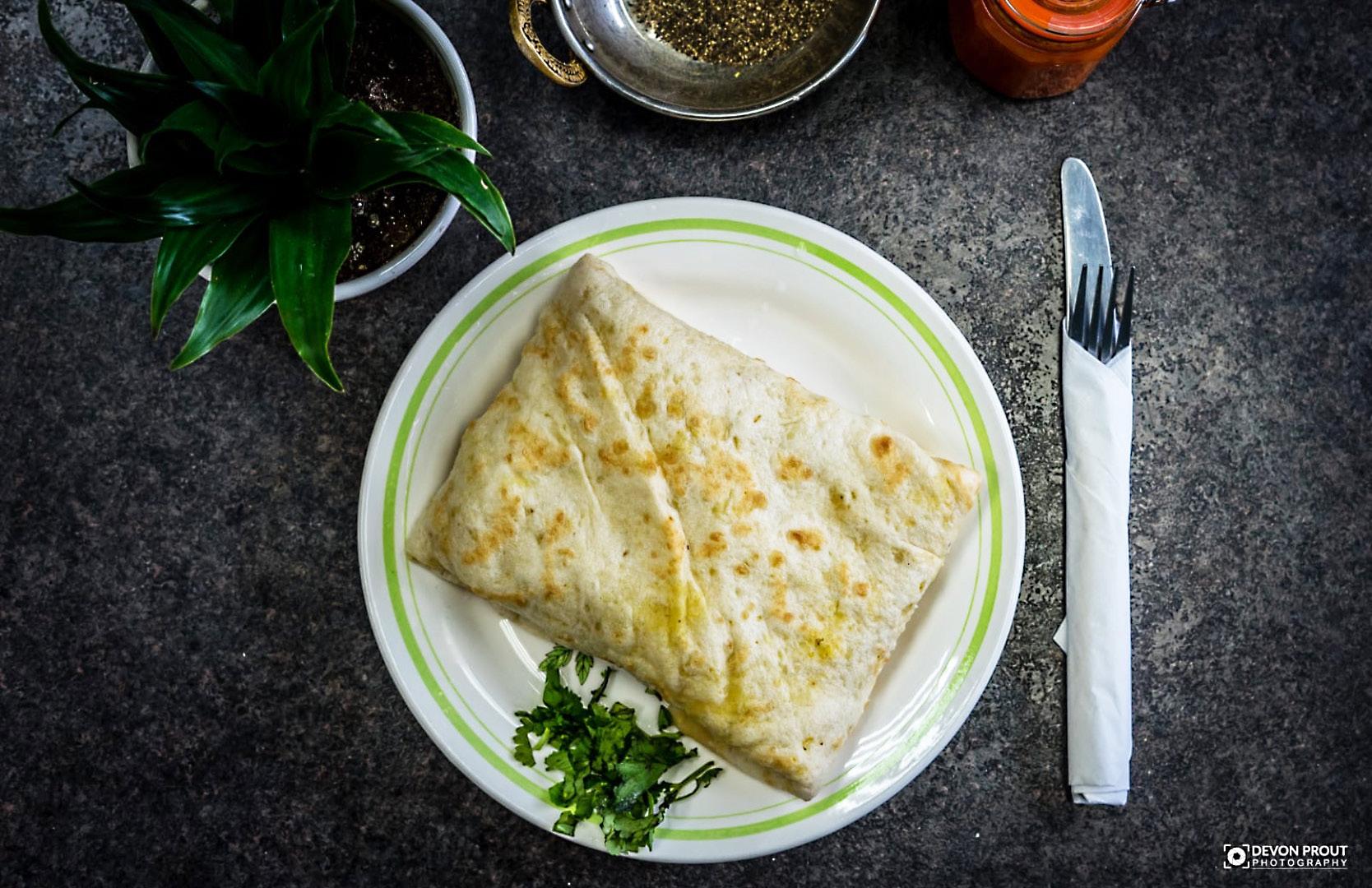


ABy Karen Irvine
t Cheeky Duck Vineyards, sustainability isn’t just a practice — it’s a guiding philosophy that shapes every decision. Located on a picturesque five-acre vineyard in the Kawarthas, this eco-friendly, carbon-neutral destination offers more than wine and fine food. It’s a living, breathing ecosystem where culinary excellence, regenerative farming, and community come together. Along side Cheeky Duck is Kitchen Farmacy, their gourmet catering and events company.
Founded by Michelin-trained chef Josh Keepfer and his wife, Chas, Cheeky Duck’s story began in a surprising place: the Peterborough Farmers’ Market. “We had this beautiful potato tortilla we’d sell as a brunch concept,” Josh recalls, “but people wanted a peameal bacon sandwich. So we started baking fresh buns and sourcing premium peameal — and people lined up.” That direct connection with the community sparked a deeper vision. As interest grew, Josh and his wife sought a space that could support a full-scale kitchen, and eventually found their dream property.
Transforming an old green building into a state-ofthe-art commercial kitchen, Josh built a team of 10 chefs — many from Fleming College and George Brown — to bring his vision to life. Over the years, Cheeky Duck has evolved into a sought-after venue, hosting up to 30 weddings annually, as well as private dinners and events.
But Cheeky Duck is far more than a restaurant or event space. The land itself is an active part of the operation. The vineyard is home to vibrant varietals like Vidal, Pinot Gris, Chardonnay, Baco Noir, and Marquette. It’s also home to South Down sheep and a charismatic flock of runner ducks, who naturally graze and provide pest control — eliminating the need for pesticides. “We want nothing to do with chemicals,” says Josh. Even the vegetable gardens and landscaping are managed without synthetic inputs.
In the colder months, vine prunings are transformed into renewable energy, reinforcing Cheeky Duck’s zero-waste commitment. Kitchen scraps
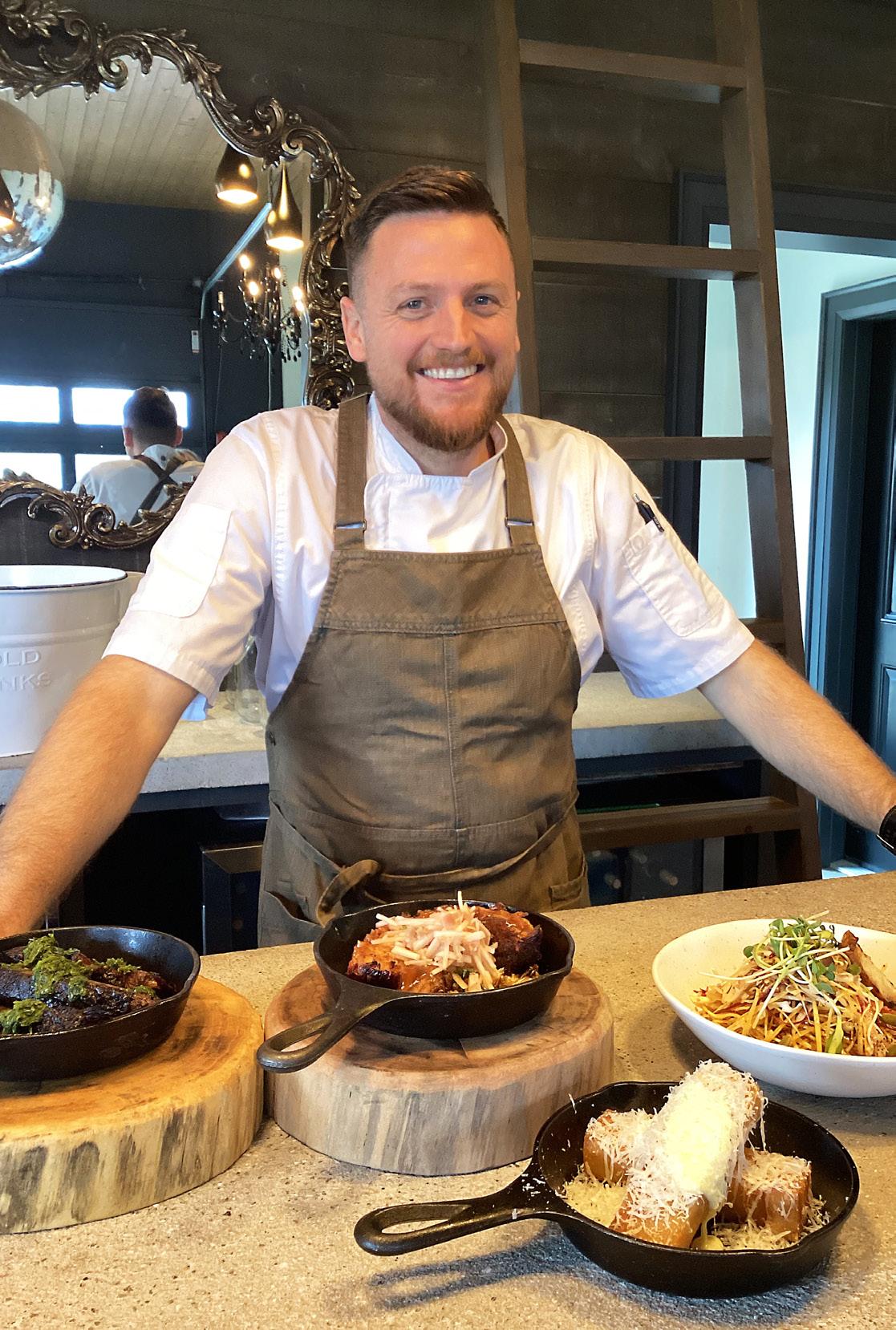
feed the ducks, chickens, and pigs, while even vegetable peels are repurposed. “There’s always soup,” Josh jokes.
The menu is hyper-seasonal and changes weekly, blending global influences with local ingredients. Much of the produce is sourced from Lunar Rhythm Organics, while meat comes from trusted local sup -
pliers in Keene. With seating for 60 outdoors and limited indoor space, reservations are strongly recommended — the place is often full.
When COVID-19 hit, Cheeky Duck pivoted quickly with a “Meals to Go” service, employing three delivery drivers at peak demand. That success allowed them to purchase surrounding land, and eventually plant the vineyard — an ambitious move that’s now central to their identity.
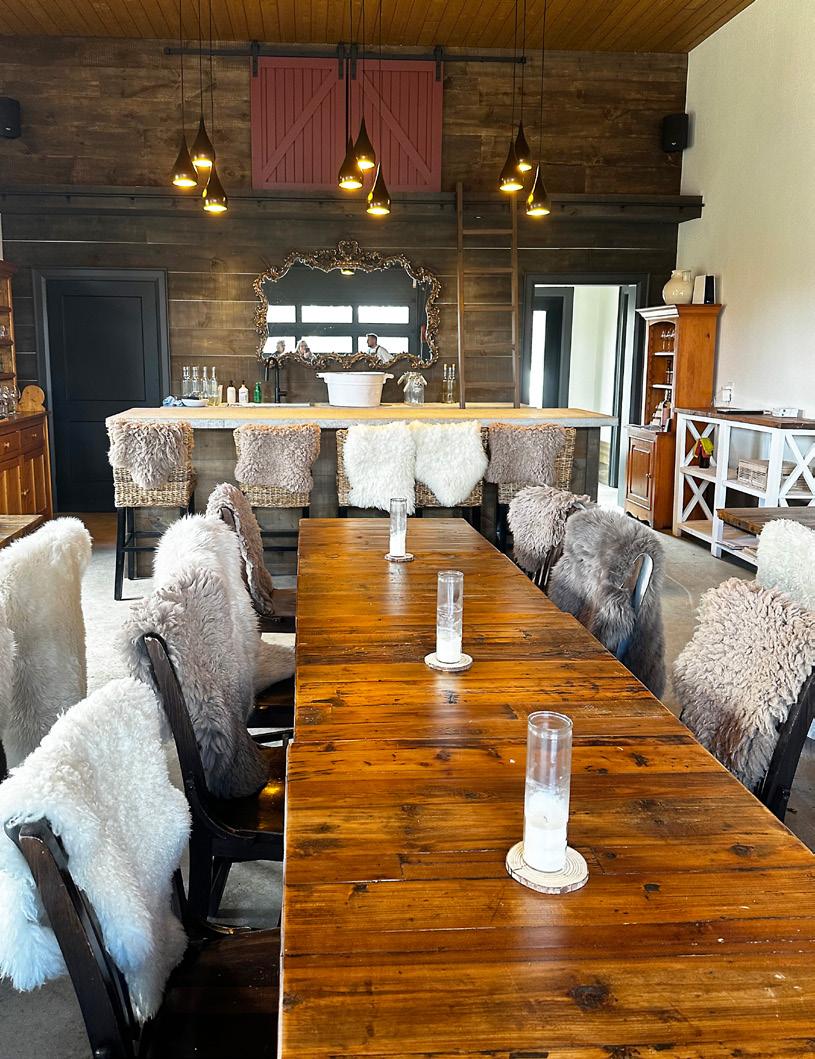
Josh, originally from Wales, moved to the Kawarthas to be closer to his wife’s family. Just minutes from Buckhorn and Stony Lake, the location offers both peace and proximity. The family spends winters in Europe — part vacation, part inspiration — where Josh stages in Michelin-starred kitchens.
At Cheeky Duck, food isn’t an afterthought — it’s the foundation. “Most vineyards are wine-first. We’re food-first,” says Josh. “That’s how we’re different. And people appreciate it.”
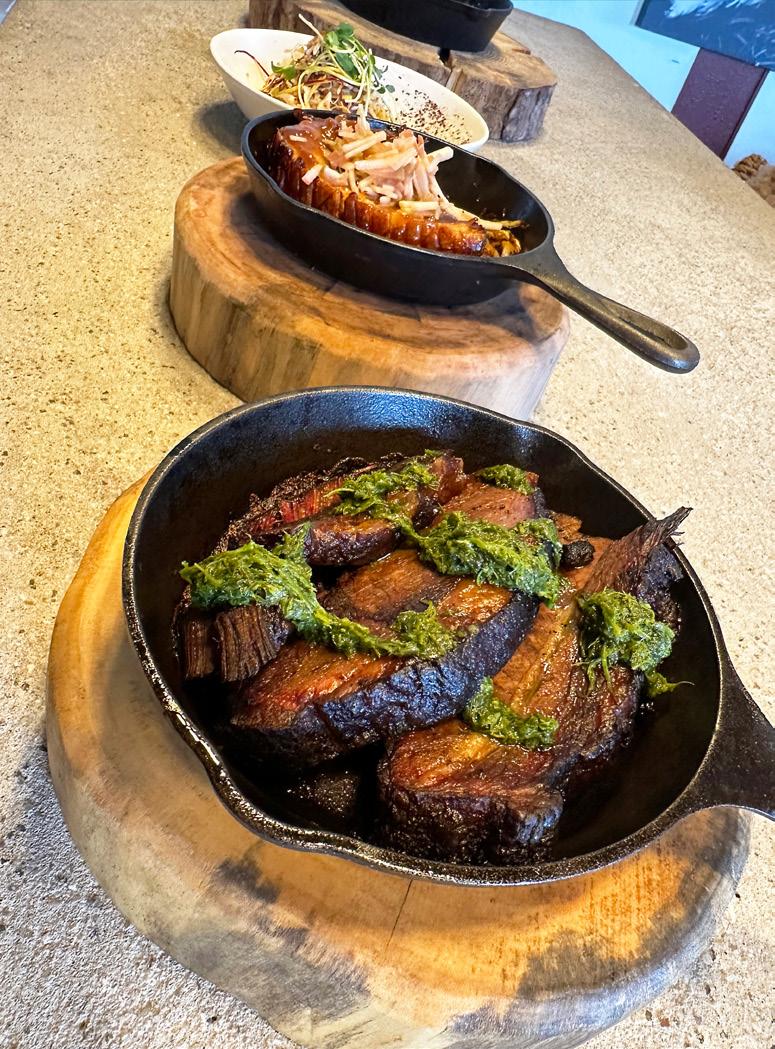


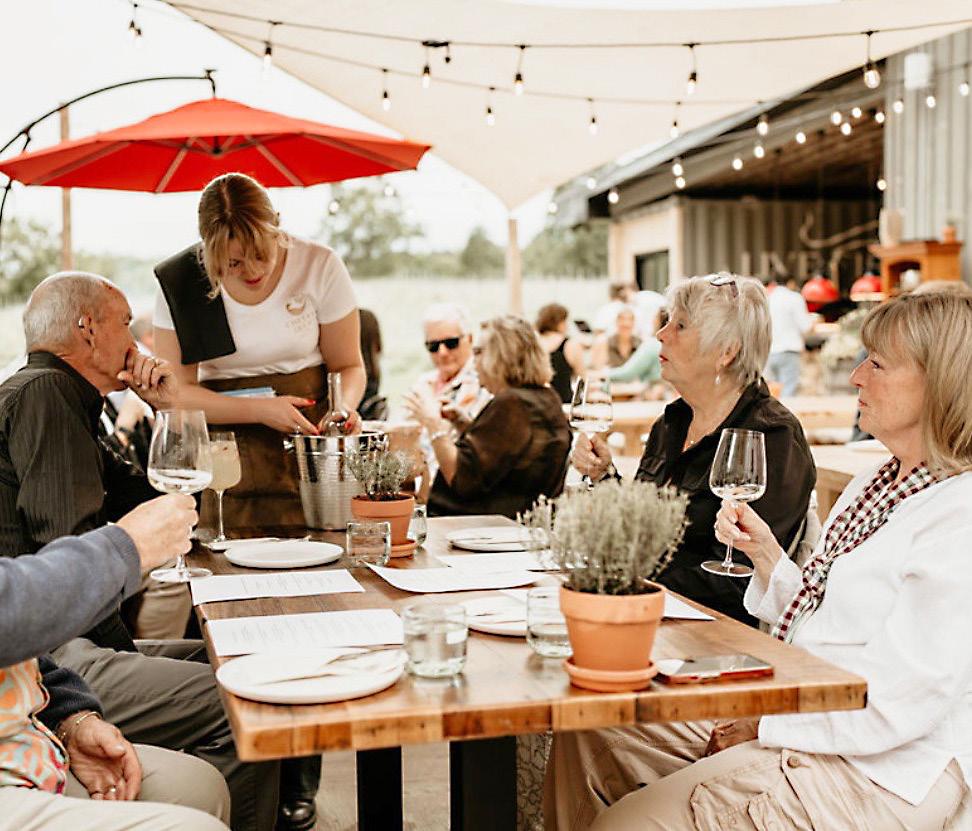

T racey is an fun, upbeat woman. I’ve had the pleasure of sitting beside her and her husband at a birthday party for a mutual friend. But I had no idea she had been a long haul truck driver!
Tracey was 4 when she started cooking and says, “Watching my mom and Grandma cook was where it started. My mom was a great cook and could throw a meal together with nothing. We didn’t have a lot of money, but we always ate well. Sunday dinners were meat, potatoes and vegetables. As a kid I didn’t love vegetables (she laughs). The smells coming home from school! That was home to me.“
With both parents working today, there’s a big gap of memories that families are missing out on. “Eating out has a domino effect. My family works less with Covid, so it means we are home together for dinner. I make a bigger effort than when it’s just myself and my husband. My family sits together at the table and we reverted back to a family meal, passing the food and talking about our day.”
Tracey is not a classically trained Chef, although she has worked under several Red Seal Chefs. “I’ve been in the food business, with the exception of my career as a long haul truck driver for 30 years (she laughs).” Ok, so I never knew!
“I took a long haul truck driving job to make more money. I wasn’t eating well, and would literally be holding a burrito in my mouth while shifting gears and steering (she laughs). But I don’t condone that behaviour.“ When she quit truck driving, That’s A Wrap was conceived.
Since Covid, a lot of the meals are takeout, catering, daily specials and deliveries for seniors. Everything is home cooked - meat, potatoes and vegetables. Tracey says, “The takeout business began because of Covid. I was guilty of getting takeout myself, so my family can still have great home cooking but I don’t have to cleanup at home.”
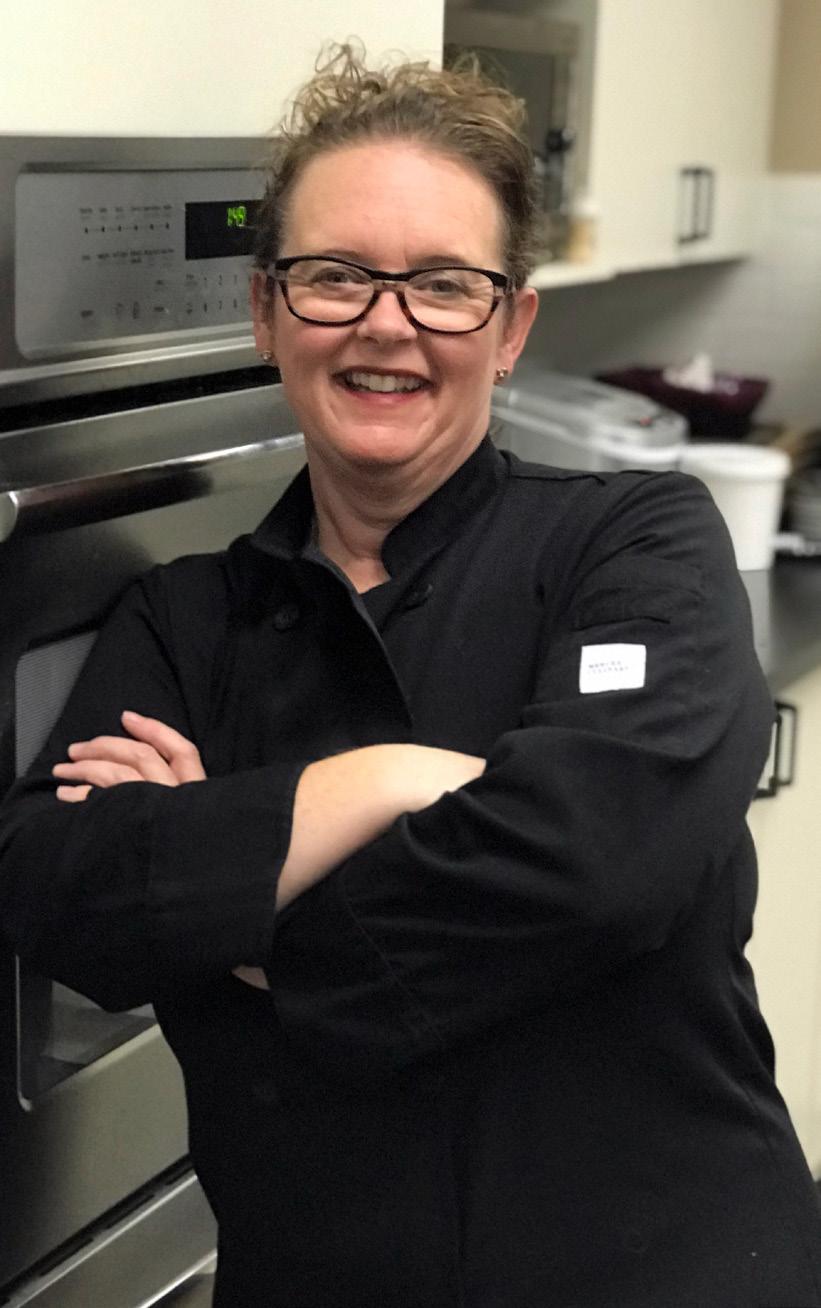
At That’s a Wrap, “Our business was 75% corporate, but Covid stopped that,” she says. “Now, it’s more individual meals. It’s fun to change up the meals for different seasons.”
“I love food, I love cooking, and I love providing nourishment for people. It’s just a feel good thing. I am definitely a Sunday dinner, knife and fork, meat and potatoes Chef.














By Karen Irvine
F or Chef Matt Chi, food has always been more than sustenance — it’s an art form, a craft, and a way of connecting with people. With 13 years in the kitchen and a passion for exploring global cuisines, he has carved out a career defined not by culinary school, but by hands-on experience, curiosity, and creativity.
“I feel like every chef should know a different kind of cuisine,” Chi explains. “It shouldn’t just be one. You learn the history, the background of the food — that’s what makes it great.”
Chi has cooked his way through a remarkable range of kitchens: Caribbean Trinidadian, Thai, Italian, and even Grenadian. One of his early posts was at Capers in Campbellford, a restaurant fondly remembered for its inventive dishes. Each stop, he says, has added a new layer to his repertoire.
Unlike many in his field, Chi never attended culinary school. Instead, he credits his formative years at the now-closed Woodlawn Inn in Cobourg, where Red Seal chefs took him under their wing. “They just showed me everything for three years,” he recalls. “I felt like I didn’t need to go to school — I already had that knowledge.”
That foundation gave him not just the technical know-how, but an appreciation for the science behind the stove. “They’ll teach you all the chemistry,” he says. “But cooking — that’s more art. If you mess something up, you can fix it. Baking, though, that’s pure science. You mess up, you start over.”
Chi’s passion lies in experimentation — taking dishes he’s seen elsewhere and giving them a personal twist. “You add one ingredient and suddenly it’s something new,” he says. “Even different spices — you can just create something of your own.”
For him, plating is as important as taste. “The way the dish looks is just art right there,” he says with a smile. “That’s what makes it so worthy of giving to customers — they look at it and say, ‘Wow, this is amazing.’”

That approach earned him recognition at Campbellford’s Chef and Doctor’s Cookoff, where he and his team took home plaques for “Most Innovative.” Their winning dish: a Thai-inspired sticky coconut rice with mango slices and coconut syrup.
Cooking isn’t Chi’s only passion. Away from the stove, he’s equally committed to fitness, studying to become a certified personal trainer and training in Muay Thai. “I’ve done martial arts all my life,” he says. “This is just something new I wanted to look into — it’s more combat, more hands-on than karate. And the people at the gym are great.”
Recently, he’s even picked up a guitar, exploring
“The way the dish looks is just art right there.”
music through hip hop and R&B. “It opens up more opportunities for creativity,” he says. “Kind of like cooking — it’s another art form.”
Roots and Family
Chi’s story began in Windsor, before his family moved to Toronto, then Oshawa, and finally Campbellford when his father joined the OPP. The transition from city life to a small town was an adjustment. “I didn’t like it at first,” he admits. “But once I met the community, it was great.”
Today, he lives in Durham Region, commuting to Port Hope, where he cooks at Gusto, an Italian restaurant known for homemade dishes and a lively summer patio scene. “This place gets packed,” he says. “Tourists come down for the fishing, then stop in to eat. Everything’s made from scratch here — nothing frozen, lots of local produce. It’s very home-cooked food.”
Family remains central to his life. Chi is the proud father of a 17-year-old son who lives in Waterloo. “We were very young when we had him,” he says. “But he’s an amazing boy. We keep a close connection — he comes down often, and we hang out.”
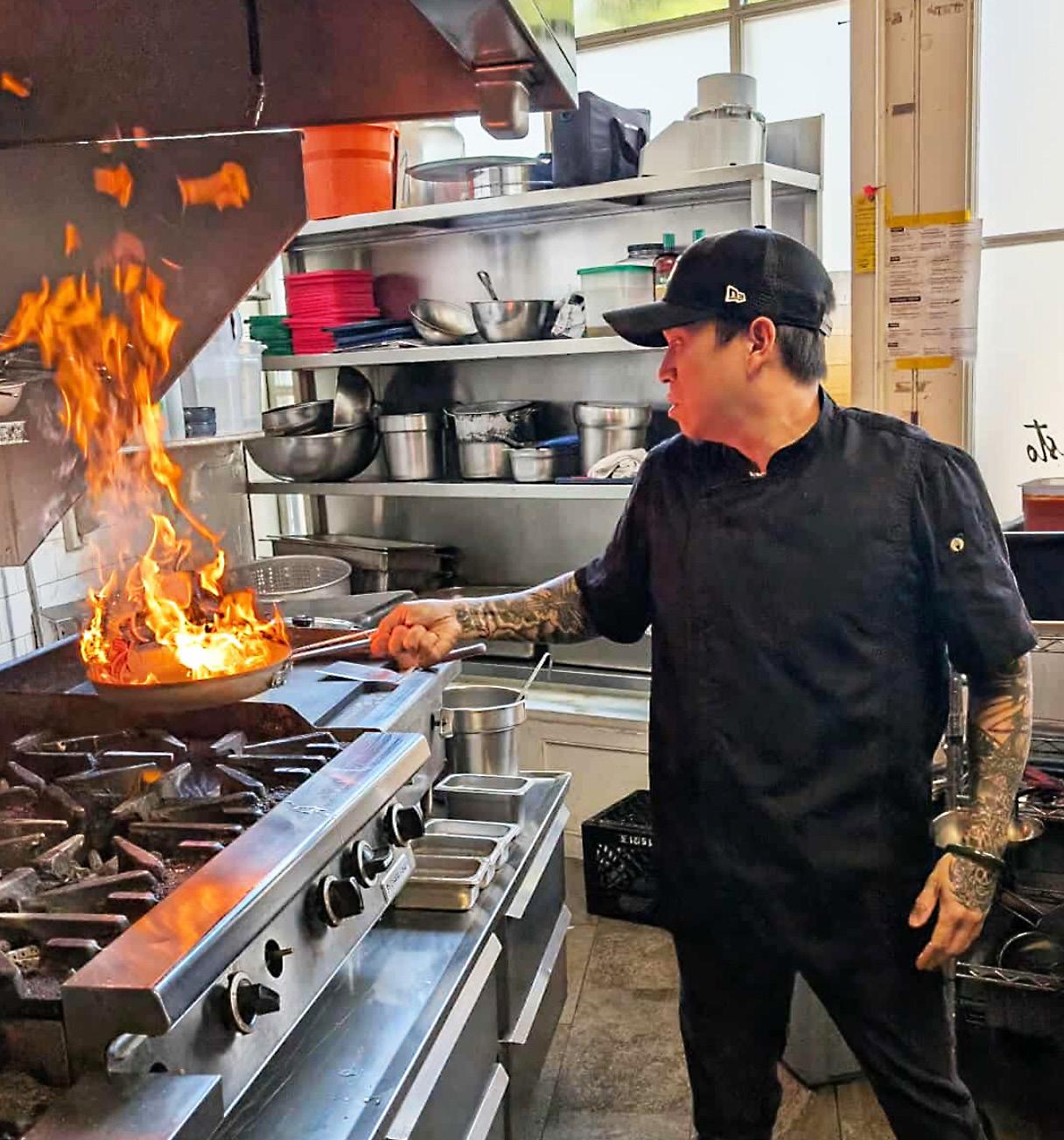
At 35, Chi still looks boyish — something he laughs about when people guess his age. “Everyone thinks I’m 24 or 25,” he says. “I used to get ID’d all the time. Not anymore.”
With his energy, passion, and drive, Chi is focused on building his skills both in and out of the kitchen. Whether experimenting with spices, mastering Muay Thai, or strumming a guitar, he approaches life much the same way he approaches cooking: with creativity, discipline, and a willingness to keep learning.
“Cooking is art,” he says simply. “It’s passion. And it’s something everyone can enjoy.”





B
efore Kawartha Country Wines, John Rufa made wine at home. “After making lots of bad wine, I started to make good wine”, he laughs. After getting many compliments on his wine, he decided to open Kawartha Country Winery 15 years ago.
John loves making fruit wine. “If you don’t have a passion for it, you won’t do well. You have to want to create a good, quality product that people will enjoy. And the gratification is when people come in to sample the wine and really like it. Anybody can make wine. Making wine that people want to pay money for is the trick,” he laughs. John’s father was a great wine maker who forced John to help. John wanted nothing to do with it. He says “I wish I’d paid attention.” (he laughs)
The building is a historic log cabin built in 1866. It was owned by the Shannon family, and Sister Margaret (the last person to be born in the building) would visit, until she passed a few years ago. The Shannon family had their reunion at the cabin.
“We specialize in making unique wines and ciders that nobody else makes. People always look forward to our newest blends”, says John.
Rhubarb is their number one seller. A few of their other types of wine and cider are apple, pear, blueberry, black currant, elderberry, peach, plum, nectarine, cranberry, strawberry, pumpkin, raspberry and cherry. “At any given time, we have forty-five to fifty different wines and ciders,” says John.
“We are selling the wine, the experience and the story that goes behind the wine as well,” John says. They also specialize in fruit vinegars, grilling sauces, jams and wine jellies. Does the fruit wine-making process differ from

making grape wine? John says, “We get this question all the time. It’s essentially the same as for grape wines. You crush the fruit, ferment the juice and the skins. The grape thinks it’s special. (he laughs) None of the other berries think it’s special.”
Kawartha Country Wines is open year round 7 days a week because they make wine 12 months a year. By staying open, they are able to keep their staff full time. Tours are available, and the property has plenty of scenery for photos.
They have a complimentary sampling bar. “We are confident that when people taste our wines, they
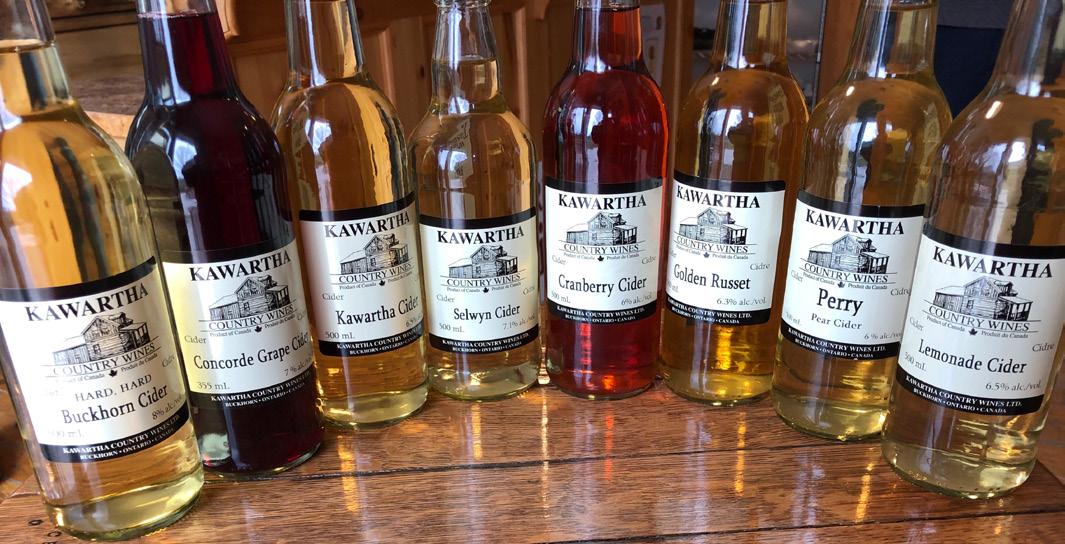
will like some of them. You don’t have to like all our wines, you just have to like one of them.” (he laughs)
The gift shop has hot sauces, BBQ sauces, giftwares plus much more.
They grow cider apples, pears, red and black currents, rhubarb and some grapes. The bears love the grapes, so they usually end up as bear food.
Cider is about 25% of their business. The main difference between cider and wine is the amount of alcohol and that ciders are carbonated. Wines are 12% alcohol, while cider is around 5-6%. Ciders have become very popular over last 4 years. John took a cider making course in England. “The English make cider very different than here. The taste is qualitatively better. If Robin Hood were alive today,
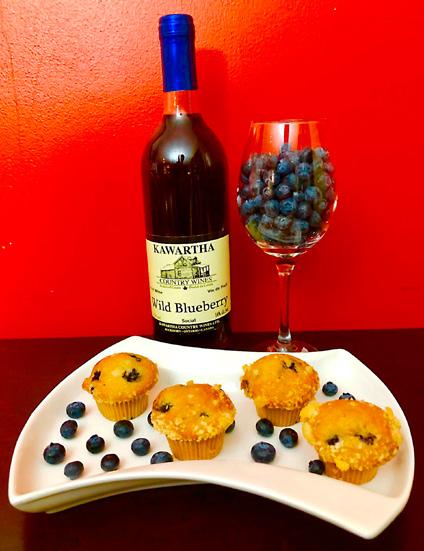

he’d be making cider the same way. It hasn’t changed in 1000 years, and that’s the way that we do it. It’s as authentic an English cider as you can get”, says John. Their cider products are available in varying sweetness and include flavours such as cranberry, perry, lemonade and their newest addition, concorde grape cider.
Stop by for a complimentary tasting. I can’t think of a better way to spend the afternoon.


T he Kawarthas are fast becoming a wine destination. Jonathan Drew and Katie Dickson have created a beautiful winery where you can taste excellent wine. The atmosphere is relaxing on the patio where the scenery is breathtaking. Located just outside of Bailieboro it is close to surrounding towns.
Jon is a second generation farmer and he and his partner Katie run the winery together. “We started planting 8 years ago, and opened the winery on June 1st 2018”, says Jon.
After working in wineries in Prince Edward County (PEC), Jon wondered why there wasn’t anything like it here. ‘“I thought why not start one. I wouldn’t say it was a plan, it was more of an idea. We first started test plots of vines and they did well, so we added some more, and the next year we added some more. All of a sudden we were getting really close to getting a lot of grapes and volume, so it started to become a more feasible plan.”
Jon continued, “I’ve always liked wine and the business, but I’ve always loved the agricultural side. I was in the food industry in Toronto, and I wanted to get back to the farm and grow something, but I didn’t feel the connection with cash crop. After working in PEC I started thinking can I translate that here. We have different soil, lots of minerality, but the biggest thing for us here is drainage. The grapes don’t like to sit in water, so everything is tile drained.”
They grow Frontenc and Marquette (their signature) grapes. Jon explains, “It’s a really nice red that is relative to a Pino Noir and you get a medium body wine (their signature red). We are still looking for that signature white that really produces well for us, and it might be the Vidal. For us, it was picking the right varieties that are going to suit this grow climate. We have already started planting Vidal, Petite Pearl and Cab Franc grapes.”
“We have just added food, and hired a graduate Chef from Sir Sanford College. We have a pizza oven and also offer charcuterie boards. And we have added more wines as well. Last year we did really well. When we first opened, we had an unfinished building, wine and a gravel parking lot!”, laughs Jon.
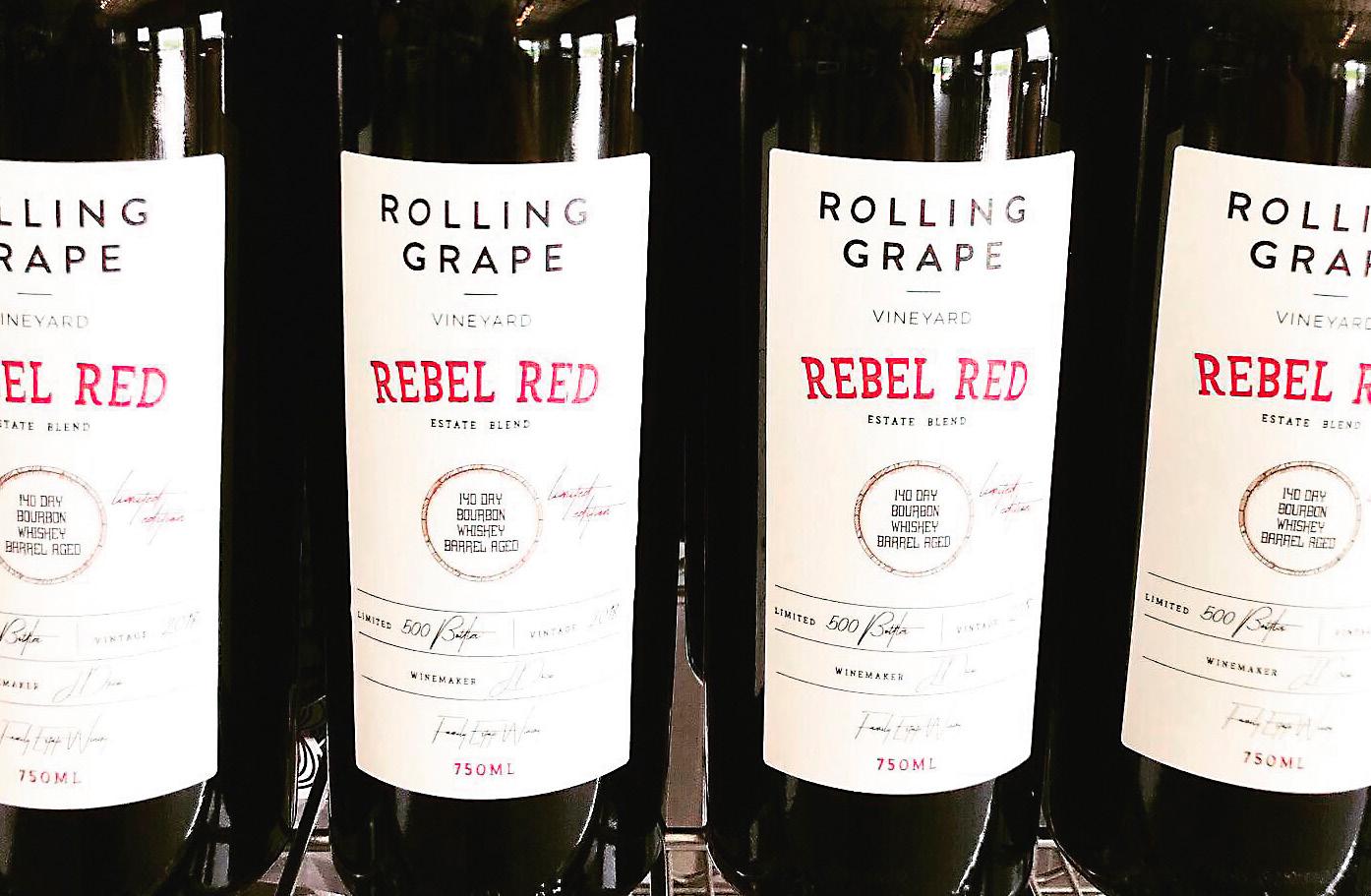
www.rollinggrape.com
Instagram & Twitter @rollinggrape
FaceBook Rolling Grape Vineyard 260 County Rd 2, Bailieboro, Keene, Ontario (705) 741-9758









By Jay Cooper
Sandor Johnson is one of the most interesting men I have ever met. I took a trip down to Potter Settlement Winery, in Tweed ON, to meet the man behind the success. Margret Swain gave us a wonderful insight into the winery, Sandor and the history, but I wanted the backstory.
Congratulations on the multiple new awards. Must make heads turn when you say it’s in Tweed Ontario? Sandor replies “Thank you, we are very proud on the continued achievements. It’s a small family farm and winery, which is one of the most northerly wineries on the continent”.
Were you raised on the farm? “The farm has been a part of the family for 4 generations. My mother took a teaching job in northern Ontario when I was an infant and I was raised there in a little place called Hornepayne. We still have the family cottage up there”.
What was your first career move after university? “I got my Masters in Journalism at Carlton and I did the classic move when you’re a kid, I called CNN and asked them if there was any openings (Laughs). I called from Ottawa and they said there is a position in Tokyo, so then I phoned Japan and talked with the bureau chief and said I was referred to them from CNN. The response was ‘Ok when are you coming?’ (Laughs). I went there in July and started working right out of school.”
So how did you get into modeling from CNN? “One of my friends was a fashion model and said ‘If your interested in making some money on the side you should try it out’, so I did and found I made more money in a day modeling and acting than I would in a month. I then took a break from journalism and never went back and it’s been 30 years now”.
Acting on a soap opera is fast paced and challenging? “Yes it’s the catalogue of acting where you throw a suit on and bang out 20 shots a
day as fast as you can go. I played Chance Heaton on All My Children. You get your script, there are 8 sets shooting at the same time and they just pull you from one set to the next. You get one chance so don’t screw it up, or it will be, ‘Today the role of Chance will be played by Ryan Lavery or whomever. You have to know your lines and it’s absolutely fast paced. The money is great but it was a side gig as the fashion paid all the bills”.
You run your career much like a brand? “I’ve always treated it like I was my own multi-national corporation, where my product is a look. Right now in Demark there could be a casting for a bank or car company that looks like me. I had 46 agencies around the world and they kept calling New York. I thought I could base myself here to work the winery or Toronto. TO is a B or C market and the A markets are Manhattan, London or Paris so I based myself out

“Barrack Obama sampled his wine, and he loved it.”
of New York and they phone the Ford Agency. I had a very successful career and still doing fine to this day.
You have met Barrack Obama whom sampled your wine and loved it. Are there others that you would like to meet and try it? “Yes I did and that’s an excellent question. I have a lot of respect for President Biden so he would be one and this one will sound crazy but Jim Carey, as I find him very funny. For me the tri-factor of having the Canadian Prime Minister, President of the USA and Royalty would be the ultimate. I think the Royal family does owe a visit to Hastings County as back in the 1800’s Prince Albert was on a ship making stops in Toronto, Cobourg and scheduled for Belleville but he was too hung over to get off the boat. The entire city was standing waiting on the dock to greet him but he wouldn’t do it. The ship then just sailed away and that was it “(Laughs).
Sandor’s favourite acting gig was for L’Oreal lipstick commercial with Beyoncé and Milla Jovovich. “It was 3 days of them kissing me. You can you tube it called Beyoncé L’Oreal Commercial lnfallible Lips from 2007 (laughs).”
Potter Settlement hires locally. Sandor says, “There are people right here that need a job. It brings local pride to the town as we are winning medals and we did this together.”
Future plans for the winery? “I want to put on an event I would call the The Eastern Ontario Wine Festival. Have all of them come to the property, set up a booth, sell your wine, with food trucks and when you come here you are only getting the best wine eastern Ontario has to offer. My good friend John from Kawartha Country Wines would be here to, so it would be the wine community coming together from every direction,” he says.
We look forward to seeing that plan come to fruition. Pun intended.
To see what all the buzz is about with Potter Settlement, head over for a tasting and tour. He’s very entertaining and you will learn a lot. Along with all the history of the farm, you will see the beautiful vineyards and what a special ambiance Sandor as created.

And tell Sandor that Jay Cooper says Hi!

Potter Settlement Artisan Wines

